ICOM orporated 306600 VHF/UHF Digital Transceiver User Manual IC 92A AD indd
ICOM Incorporated VHF/UHF Digital Transceiver IC 92A AD indd
user manual
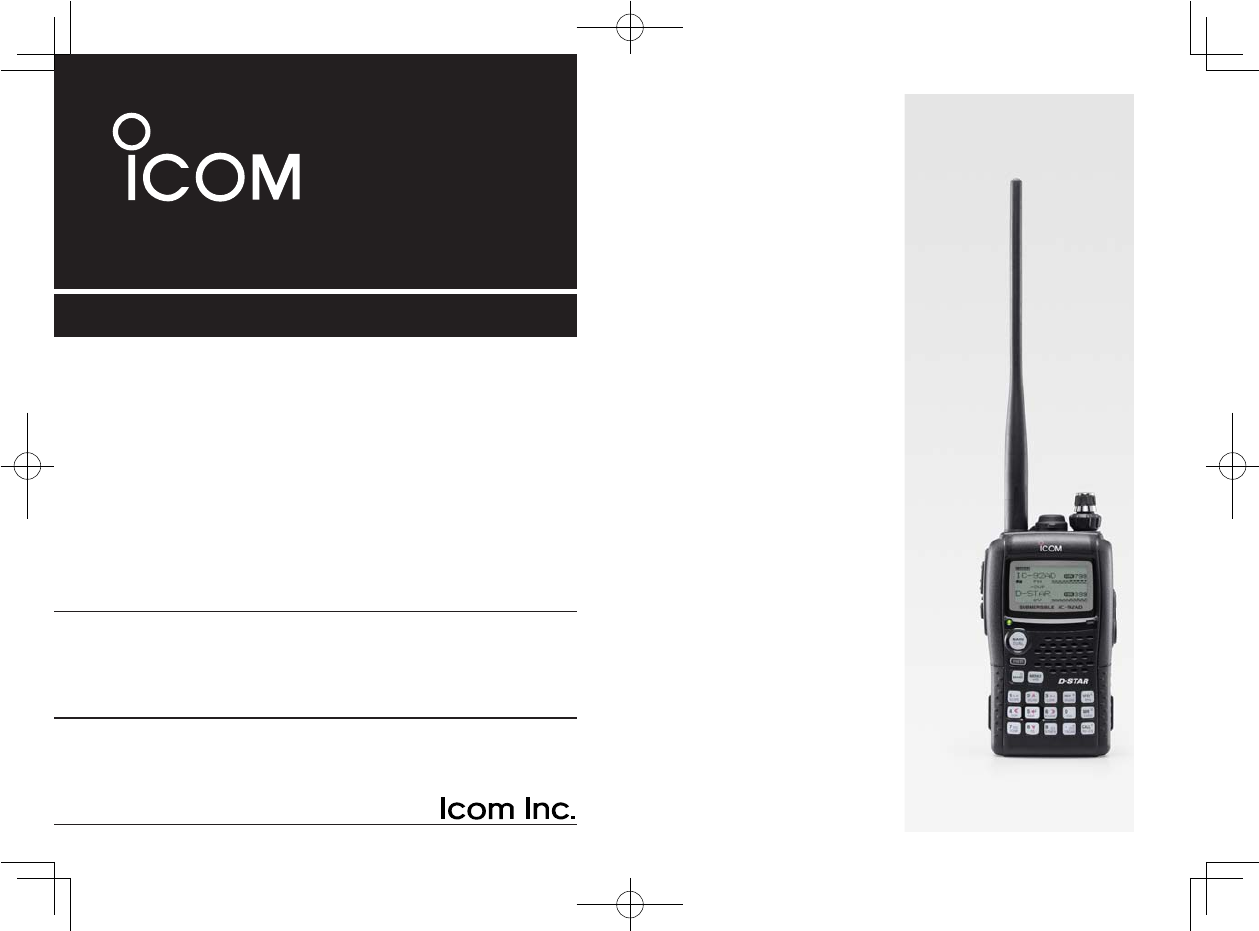
This device complies with Part 15 of the FCC Rules. Operation
is subject to the following two conditions: (1) this device may
not cause harmful interference, and (2) this device must accept
any interference received, including interference that may cause
undesired operation.
WARNING: MODIFICATION OF THIS DEVICE TO RECEIVE CEL-
LULAR RADIOTELEPHONE SERVICE SIGNALS IS PROHIBITED
UNDER FCC RULES AND FEDERAL LAW.
INSTRUCTION MANUAL
New2001
Y- The above photo
shows IC-92AD.
i92A
VHF/UHF FM TRANSCEIVER
i92AD
VHF/UHF DIGITAL TRANSCEIVER
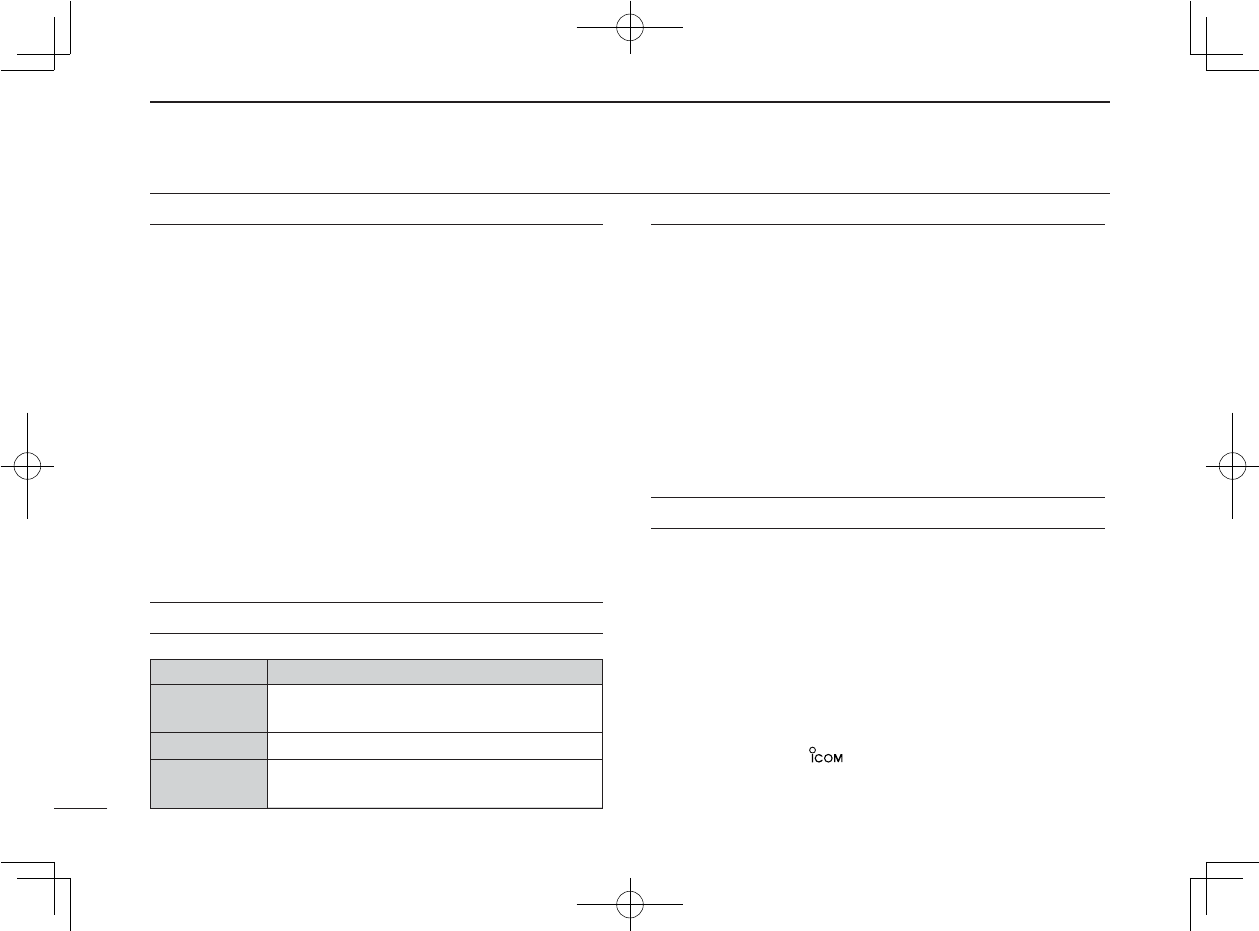
i
New2001
FOREWORD
Thank you for purchase of this fine Icom product. We un-
derstand you have a choice of many different radios in the
market place. Many hours of research and development
went into the design of your IC-92A/92AD, following Icom’s
philosophy of “technology fi rst.”
The IC-92A/92AD VHF
/
UHF FM TRANSCEIVER is designed with
Icom’s superior technology and craftsmanship combining
traditional analog technologies with the new digital D-STAR
technologies for a balanced packaged.
With proper care, this product should provide you with years
of trouble-free operation. We want to take a couple of mo-
ments of your time to thank you for making your IC-92A/
92AD your radio of choice, and hope you agree with Icom’s
philosophy of “technology fi rst.”
EXPLICIT DEFINITIONS
FEATURES
❍ DV mode (Digital voice + Low-speed data
communication) operation is ready
– GPS receiver connection
– Text message and call sign exchange
(Optional UT-121 DIGITAL UNIT is required for IC-92A.)
❍ Simple band scope
❍ Dualwatch operation
❍ Optional PC remote control
IMPORTANT
READ ALL INSTRUCTIONS carefully and completely
before using the transceiver.
SAVE THIS INSTRUCTION MANUAL— This in-
struction manual contains important operating instructions
for the IC-92A/92AD.
WORD DEFINITION
R-WARNING!
CAUTION
NOTE
Personal injury, fire hazard or electric
shock may occur.
Equipment damage may occur.
Recommended for optimum use. No risk of
personal injury, fi re or electric shock.
Icom, Icom Inc. and the logo are registered trademarks of Icom
Incorporated (Japan) in the United States, the United Kingdom,
Germany, France, Spain, Russia and/or other countries.
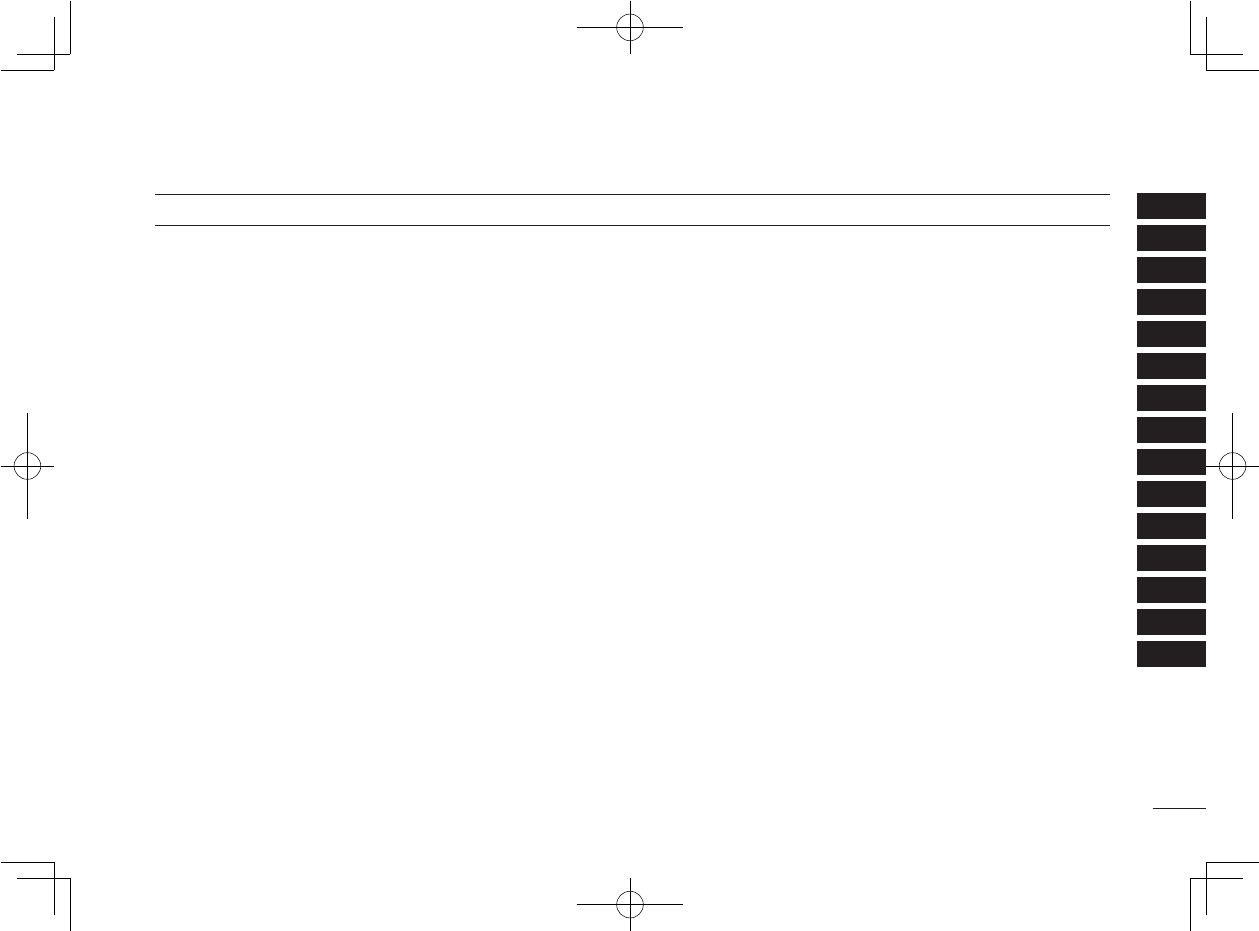
1
2
3
4
5
6
7
8
9
10
11
12
13
14
15
16
RWARNING RF EXPOSURE! This device emits
Radio Frequency (RF) energy. Caution should be observed
when operating this device. If you have any questions re-
garding RF exposure and safety standards please refer to
the Federal Communications Commission Office of Engi-
neering and Technology’s report on Evaluating Compliance
with FCC Guidelines for Human Radio Frequency Electro-
magnetic Fields (OET Bulletin 65)
RWARNING!
NEVER hold the transceiver so that
the antenna is very close to, or touching exposed parts of
the body, especially the face or eyes, while transmitting. The
transceiver will perform best if the microphone is 5 to 10 cm
(2 to 4-inches) away from the lips and the transceiver is verti-
cal.
RWARNING! NEVER operate the transceiver with
a earphone, headphones or other audio accessories at high
volume levels. Hearing experts advise against continuous
high volume operation. If you experience a ringing in your
ears, reduce the volume level or discontinue use.
RWARNING! NEVER operate the transceiver while
driving a vehicle. Safe driving requires your full attention—
anything less may result in an accident.
NEVER connect the transceiver to a power source of
more than 16 V DC. This will ruin the transceiver.
NEVER connect the transceiver to a power source using
reverse polarity. This will ruin the transceiver.
NEVER expose the transceiver to rain, snow or any liq-
uids. The transceiver may be damaged.
NEVER operate or touch the transceiver with wet hands.
This may result in an electric shock or damage the trans-
ceiver.
DO NOT operate the transceiver near unshielded electri-
cal blasting caps or in an explosive atmosphere.
DO NOT
push the PTT when not actually desiring to trans-
mit.
BE CAREFUL! The transceiver will become hot when
operating it continuously for long periods.
DO NOT use or place the transceiver in direct sunlight or
in areas with temperatures below –20°C (–4˚F) or above +60
°C (+140˚F).
Place the unit in a secure place to avoid inadvertent use by
children.
DO NOT use of chemical agents such as benzine or al-
cohol when cleaning, as they can damage the transceiver’s
surfaces.
For U.S.A. only
CAUTION!: Changes or modifications to this device, not
expressly approved by Icom Inc., could void your authority to
operate this device under FCC regulations.
17
18
19
ii
PRECAUTIONS

Ne
iii
New2001
FOREWORD i
EXPLICIT DEFINITIONS i
FEATURES i
IMPORTANT i
PRECAUTIONS ii
TABLE OF CONTENTS iii
SUPPLIED ACCESSORIES v
1 ACCESSORY ATTACHMENT 1
■ Antenna 1
■ Belt clip 1
■ Handstrap 1
■ Battery pack 1
2 PANEL DESCRIPTION 2–7
■ Front, top and side panels 2
■ Function display 6
3 BATTERY CHARGING 8–13
■ Caution 8
■ Regular charging 10
■ Rapid charging 11
■ Optional battery case 12
■ Battery information 12
■ External DC power operation 13
4 FREQUENCY AND CHANNEL SETTING 14–19
■ Main band selection 14
■ Mode selection 15
■ Operating band selection 16
■ Setting a tuning step 18
■ Setting a frequency 18
5 BASIC OPERATION 20–28
■ Receiving 20
■ Setting audio volume 20
■ Setting squelch level 21
■ Operating mode selection 21
■ Monitor function 22
■ Attenuator function 22
■ Band scope 23
■ Transmitting 24
■ Transmit power selection 24
■ Lock function 25
■ Dualwatch operation 25
■ TV channel operation 28
6 REPEATER AND DUPLEX OPERATIONS 29–33
■ Repeater operation 29
■ Duplex operation 31
■ Auto repeater function 32
■ 1750 Hz tone 33
7 DV MODE OPERATION
(Optional UT-121 is required for IC-92A) 34–63
■ Digital mode operation 34
■ Call sign programming 34
■ Digital voice mode operation 38
■ About D-STAR system 40
■ Digital repeater operation 41
■ Received call sign 46
■ Copying the call sign 48
■ Break-in communication 51
■ Message operation 52
■ Automatic reply function 54
TABLE OF CONTENTS

iv
New2001
■ EMR communication 56
■ Low-speed data communication 56
■ GPS operation 58
■ Other functions for DV mode operation 62
8 MEMORY/CALL CHANNELS 64–73
■ General description 64
■ Selecting a memory channel 64
■ Selecting a call channel 65
■ Memory channel programming 66
■ Memory bank setting 67
■ Memory bank selection 68
■ Programming memory/bank/scan name 69
■ Selecting memory/bank name indication 70
■ Copying memory/call contents 71
■ Memory clearing 72
■ Erasing/transferring bank contents 73
9 SCAN OPERATION 74–81
■ Scan types 74
■ Full/band/programmed scan 75
■ Scan edges programming 76
■ Memory scan 77
■ Memory bank scan 78
■ Skip channel/frequency setting 79
■ Scan resume condition 81
10 PRIORITY WATCH 82–84
■ Priority watch types 82
■ Priority watch operation 83
11 MENU SCREEN OPERATION 85–102
■ General 85
■ MENU screen indication for B band 86
■ Menu list 86
■ Items list 86
■ Set mode items 88
■ DV set mode items 92
■ Scan set mode items 96
■ DUP/TONE set mode items 97
■ Display set mode items 99
■ Sounds set mode items 102
12 OTHER FUNCTIONS 103–118
■ Programming a DTMF code 103
■ Transmitting a DTMF code 104
■ Clearing a DTMF memory 105
■ Confi rming a DTMF memory 105
■ Setting DTMF transfer speed 106
■ Tone frequency and DTCS code 106
■ Digital code and digital call sign setting 108
■ Tone/DTCS squelch 110
■ Digital code/digital call sign squelch 110
■ Pocket beep function 111
■ DTCS polarity setting 111
■ Tone scan 112
■ Beep tones 113
■ Dial speed acceleration 113
■ Key lock effect 113
■ Weather channel operation 114
■ Power save 115
■ Auto power OFF 116
■ Auto power ON 116
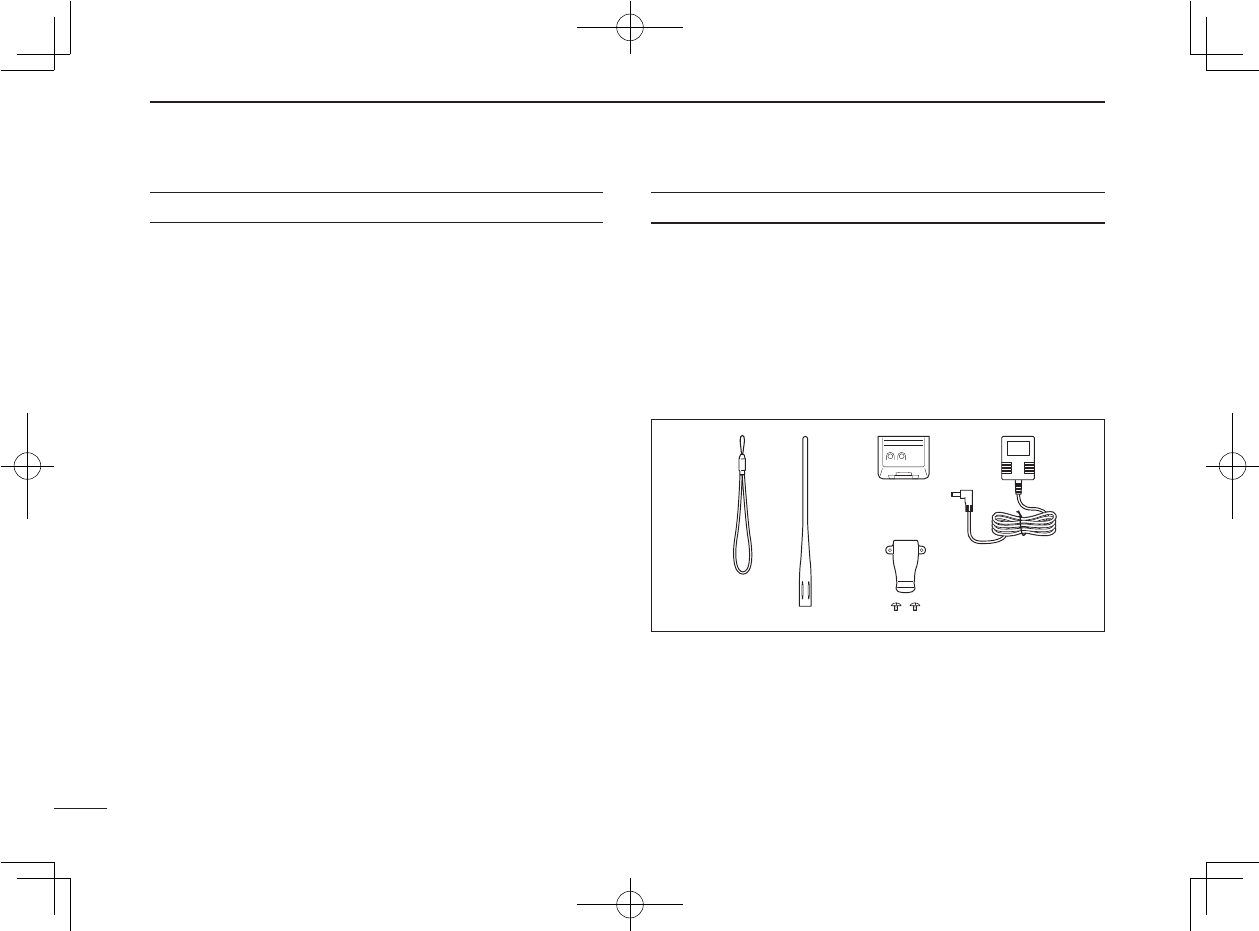
■ Time-out timer 116
■ PTT lock 116
■ Cloning function 117
■ [MIC/SP] jacks 117
■ Resetting 118
13 TROUBLESHOOTING 119
14 SPECIFICATIONS 120–121
15 OPTIONS 122–124
■ Optional UT-121 installation 123
■ Optional HM-75A REMOTE CONTROL MICROPHONE 124
SUPPLIED ACCESSORIES
The following accessories are supplied with the transceiver.
q Hand strap 1
w Antenna 1
e Battery pack* 1
r Battery charger* 1
t Belt clip (with screws) 1 set
*Not supplied with some versions.
v
New2001
re
q
t
w
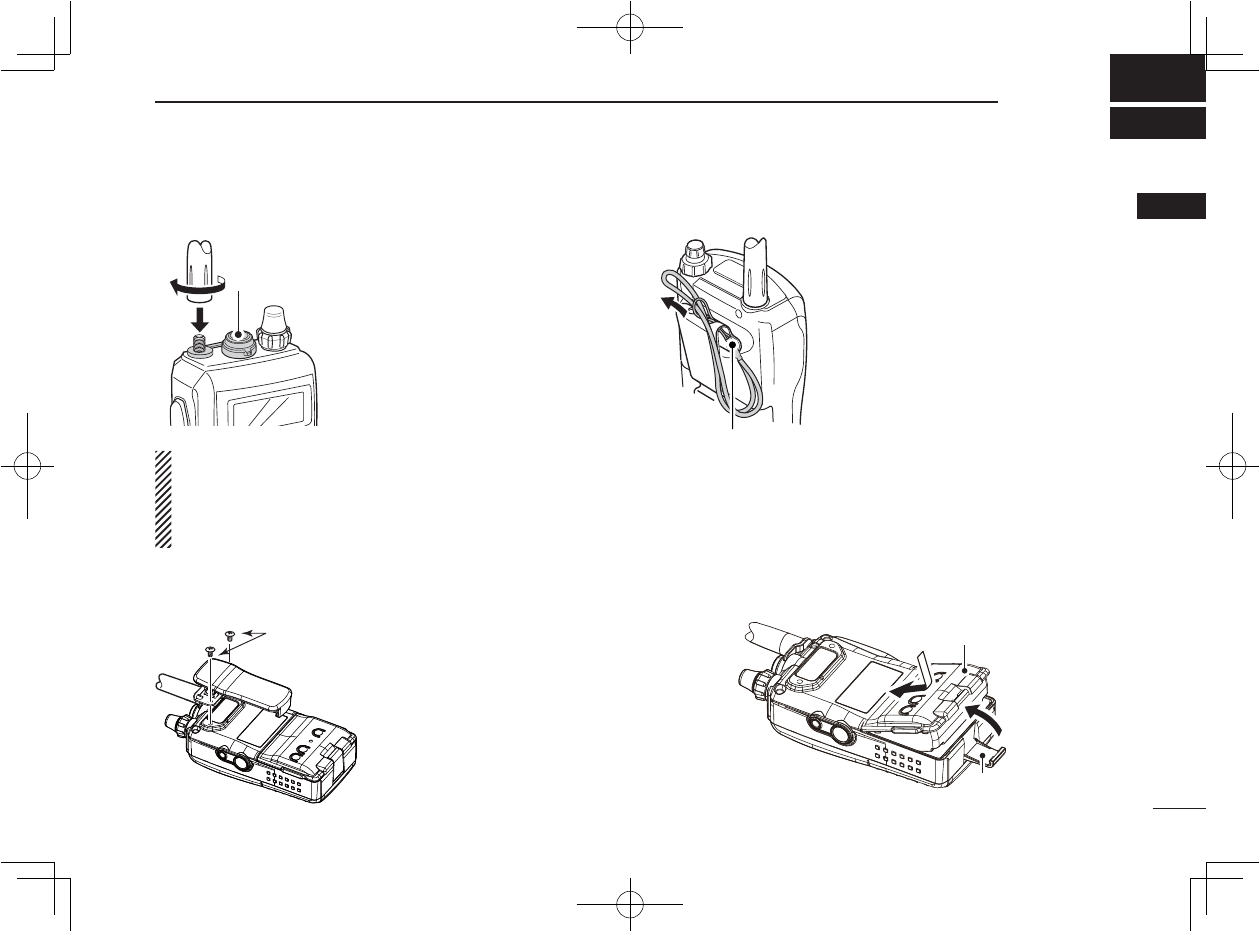
1
1
ACCESSORY ATTACHMENT
1
■ Antenna
Insert the supplied antenna into the
antenna connector and screw down
the antenna as shown at left.
NEVER carry the transceiver by
holding the antenna.
KEEP the jack cover attached when
jack is not in use to protect the con-
nector from dust and moisture.
✔ For your information
Third-party antennas may increase transceiver perform-
ance. An optional AD-92SMA ANTENNA CONNECTOR
ADAPTER is available to connect an antenna with a BNC
connector.
■ Belt clip
■ Handstrap
Slide the handstrap through the
loop on the top of the belt clip as
illustrated at left to facilitate carrying
the transceiver.
■ Battery pack
Attach the Li-Ion battery pack (BP-217) or battery case
(BP-216) as illustrated below.
• Charge the Li-Ion battery pack before use. (pgs. 10, 11)
Jack cover
Handstrap
Supplied screws*
*NOTE:
USE the supplied screws
only. Using screws
longer than specified
could damage the
q
w
Battery pack
/
Battery case
Latch
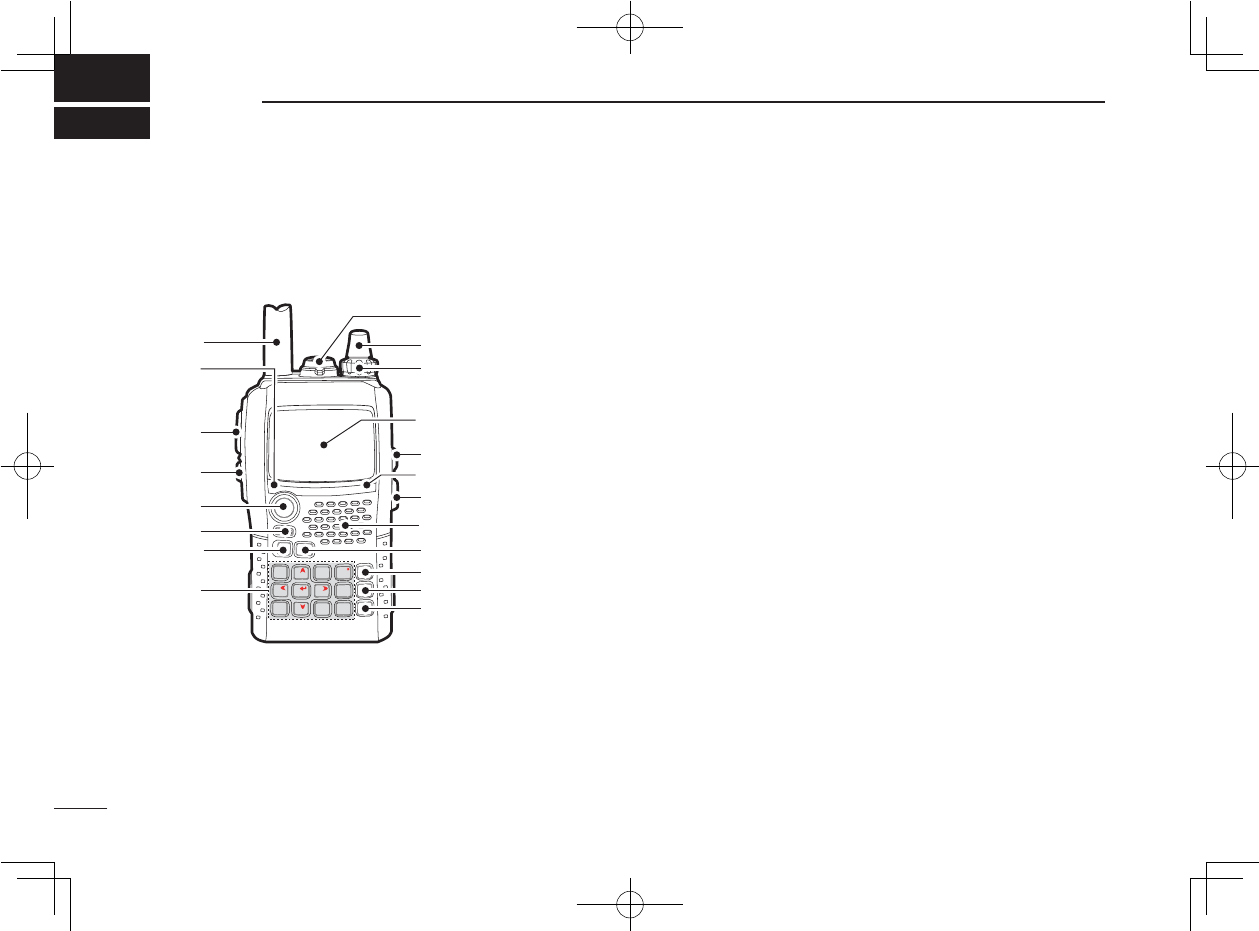
2
NeNew2001
PANEL DESCRIPTION
2
■ Front, top and side panels
q ANTENNA CONNECTOR (p. 1)
Connects the supplied antenna.
• An optional AD-92SMA adapter (p. 122) is available for con-
necting an antenna with a BNC connector.
w TX/RX INDICATOR [TX/RX] (p. 24)
Lights green while receiving a signal or when the squelch
is open; lights red while transmitting.
e PTT SWITCH [PTT] (p. 24)
Push and hold to transmit, release to receive.
r SQUELCH KEY [SQL]
➥ Push and hold to open the squelch temporarily and
monitor the operating frequency. (p. 22)
➥ While pushing and holding this key, rotate [DIAL] to
adjust the squelch level. (p. 21)
t MAIN/DUAL KEY [MAIN/DUAL]
➥ Push to select the main band between A and B bands.
(p. 26)
➥ Push and hold for 1 sec. to toggle the dualwatch func-
tion ON and OFF. (p. 25)
y POWER KEY [PWR]
Push and hold for 1 sec. to turn the transceiver power ON
and OFF.
u BAND KEY [BAND]
➥ During VFO mode operation, push to select an operat-
ing frequency band. (pgs. 16, 17)
➥ During memory bank mode, push to select a memory
bank. (p. 68)
➥ Enters or sends the DTMF code “D.” (pgs. 103, 104)
MAIN
BAND
REC
MENU
VFO
MR
CALL
123
456
789 .
0
DUAL
SCOPE
SCAN
LOW MODE MHz
S.MW
RX
CS
CQ
M.NAME
SKIP
DUP
TONE TS
DTMF
.
M
T.SCAN
DSQ
CS CD
#
C
B
A
CLR
A/a
D
PWR
q
Speaker
u
Function display
Internal microphone
i
y
t
r
e
w
!3
!4
!0
o
!1
!2
!5
!6
!7
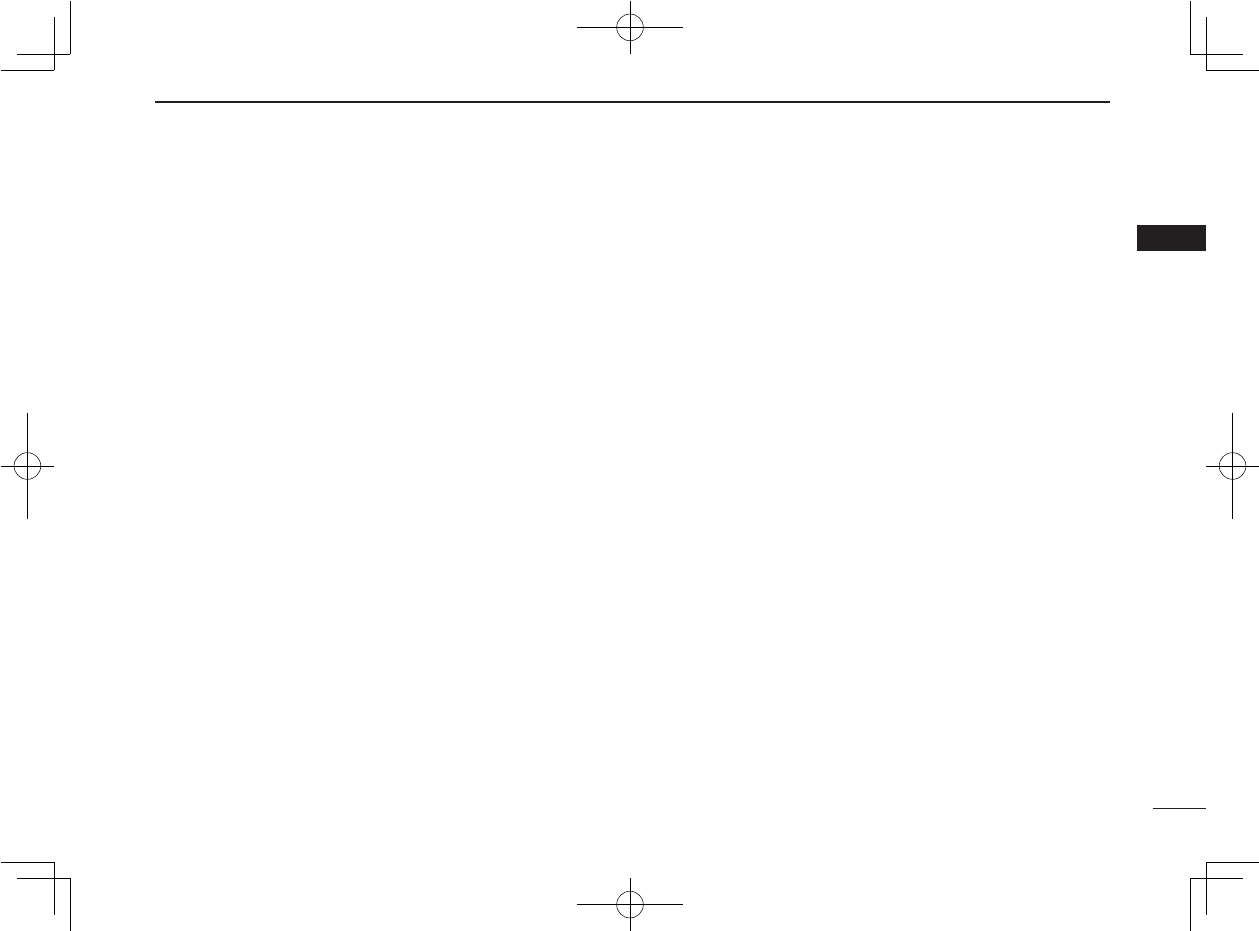
New2001
3
2
PANEL DESCRIPTION
2
i KEYPAD (pgs. 4, 5)
o CALL/RX➝CS KEY [CALL]/[RX➝CS](CALL)
➥ Push to select the call channel/TV channel/weather
channel. (p. 16)
➥ During DV mode operation, push and hold for 1 sec. to
set the received call signs (station and repeaters) for
operation. (p. 47)
➥ Enters or sends the DTMF code “C.” (pgs. 103, 104)
!0 MEMORY/SELECT MEMORY WRITE KEY [MR]/[S.
MW](MR)
➥ Push to select memory mode. (p. 15)
➥ During memory mode operation, push to toggle be-
tween memory and memory bank mode. (p. 68)
➥ Push and hold for 1 sec. to enter select memory write
mode. (p. 64)
➥ Enters or sends the DTMF code “B.” (pgs. 103, 104)
!1 VFO/MHz KEY [VFO]/[MHz](VFO)
➥ Push to toggle select VFO mode. (p. 15)
➥ During VFO mode operation, push and hold for 1 sec.
to select and toggle 1 MHz and 10 MHz tuning steps
(p. 18)
➥ Enters or sends the DTMF code “A.” (pgs. 103, 104)
!2 MENU/LOCK KEY [MENU/LOCK]
➥ Push to toggle menu screen indication ON and OFF.
(p. 85)
➥ Push and hold for 1 sec. to toggle the lock function ON
and OFF. (p. 25)
!3 EXTERNAL DC IN JACK [DC IN]
➥ Connects the supplied wall charger, BC-167, to charge
the attached battery pack. (p. 10)
➥ Connect an external DC power supply through the op-
tional CP-12L, CP-19R or OPC-254L for external DC
operation. (p. 13)
!4 DATA JACK [DATA]
Connects a PC through the optional data communication
cable, OPC-1529R, for low-speed data communication or
control the transceiver remotely using the optional RS-91
(OPC-1529R is supplied). (p. 56)
!5 VOLUME CONTROL [VOL]
Rotate to adjust the audio output level. (p. 20)
!6 CONTROL DIAL [DIAL]
➥ Rotate to tune the operating frequency. (p. 18)
➥ During memory mode, rotate to select the memory
channel. (pgs. 15, 64)
➥ While pushing and holding [BAND], selects the operat-
ing band in VFO mode. (p. 18)
➥
While scanning, changes the scanning direction. (p. 75)
➥ While pushing and holding [SQL], sets the squelch
level. (p. 21)
➥ While pushing and holding [BAND], selects the pro-
grammed bank in memory mode. (p. 68)
!7 EXTERNAL SPEAKER/MICROPHONE JACK [MIC/SP]
Connect an optional speaker-microphone or headset, if
desired.
See page 122 for a list of available options.
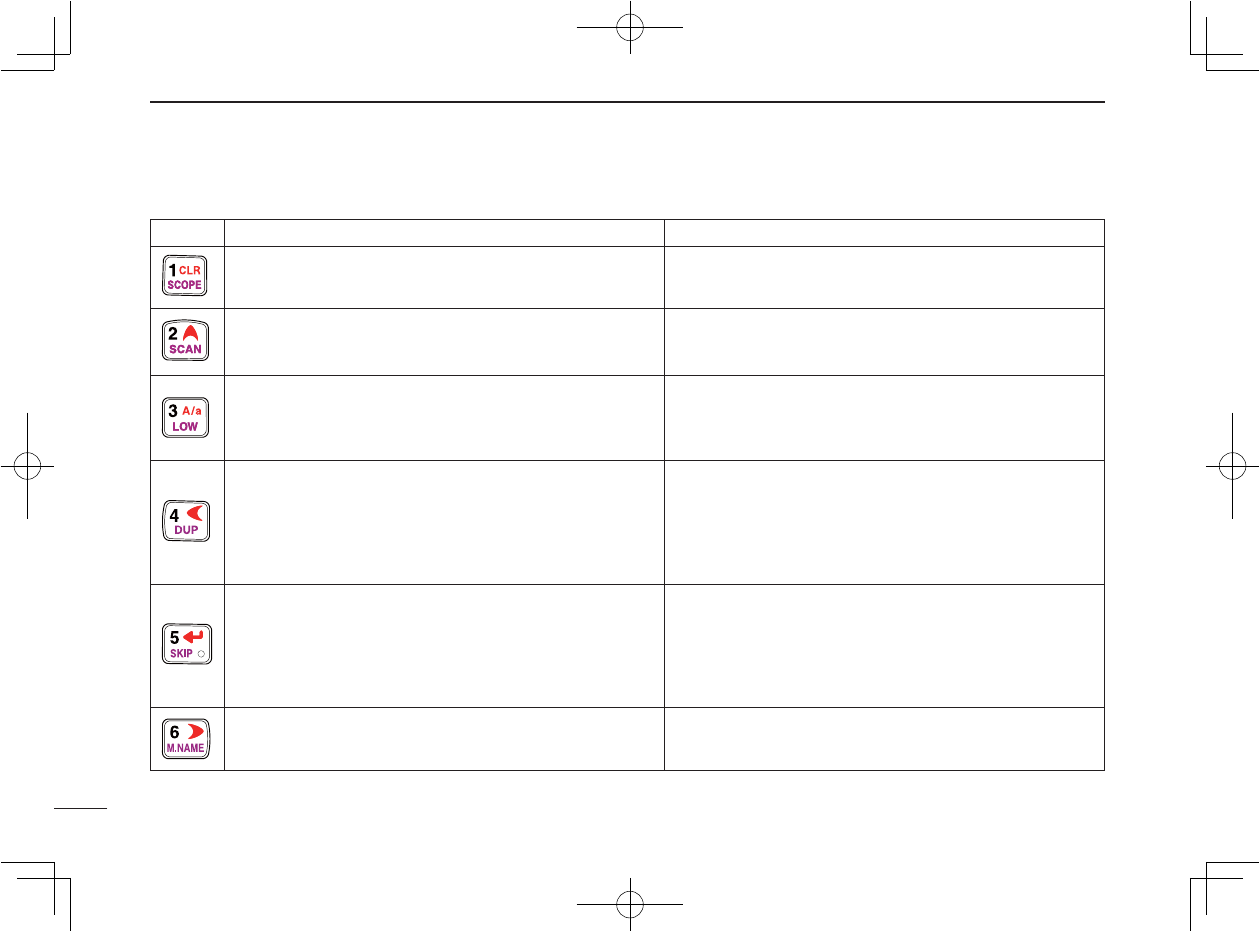
Ne
4
2PANEL DESCRIPTION
New2001
D KEYPAD
1
SCOPE
CLR
2
SCAN
KEY Pushed momentarily
3
LOW
A/a
4
DUP
5
SKIP
6
M.NAME
Pushed and held for 1 sec.
• Inputs digit ‘1’ for frequency input, memory channel selection,
etc.
• While pushing [PTT], this key sends the DTMF code “1.”
• Inputs digit ‘2’ for frequency input, memory channel selection,
etc.
• While pushing [PTT], this key sends the DTMF code “2.”
• Inputs digit ‘3’ for frequency input, memory channel selection,
etc.
• While pushing [PTT], this key sends the DTMF code “3.”
• Inputs digit ‘4’ for frequency input, memory channel selection,
etc.
• While pushing [PTT], this key sends the DTMF code “4.”
• Inputs digit ‘5’ for frequency input, memory channel selection,
etc.
• While pushing [PTT], this key sends the DTMF code “5.”
• Inputs digit ‘6’ for frequency input, memory channel selection,
etc.
• While pushing [PTT], this key sends the DTMF code “6.”
• Displays the simple band scope for a single sweep. (p. 23)
• Starts a scan. (p. 75)
• Toggles the transmit output power between high and low (p. 24).
- “LOW” appears when low power is selected.
- While pushing and holding this key, with [DIAL] rotation se-
lects the output power.
• Activates the following duplex functions in order.
- Minus duplex operation— “–DUP” appears.
- Plus duplex operation— “+DUP” appears.
- Simplex operation— no duplex indicator appears.
- While pushing and holding this key, with [DIAL] rotation se-
lects the duplex function.
• Turn the frequency skip function ON and OFF in VFO mode, or
set the memory channel as the following skip channel in mem-
ory mode in order (p. 79).
- Skip channel— “SKIP” appears.
- Frequency skip channel— “PSKIP” appears.
- Non-skip channel— no skip indicator appears.
• Turn the memory name or bank name indication ON and OFF.
(p. 70)
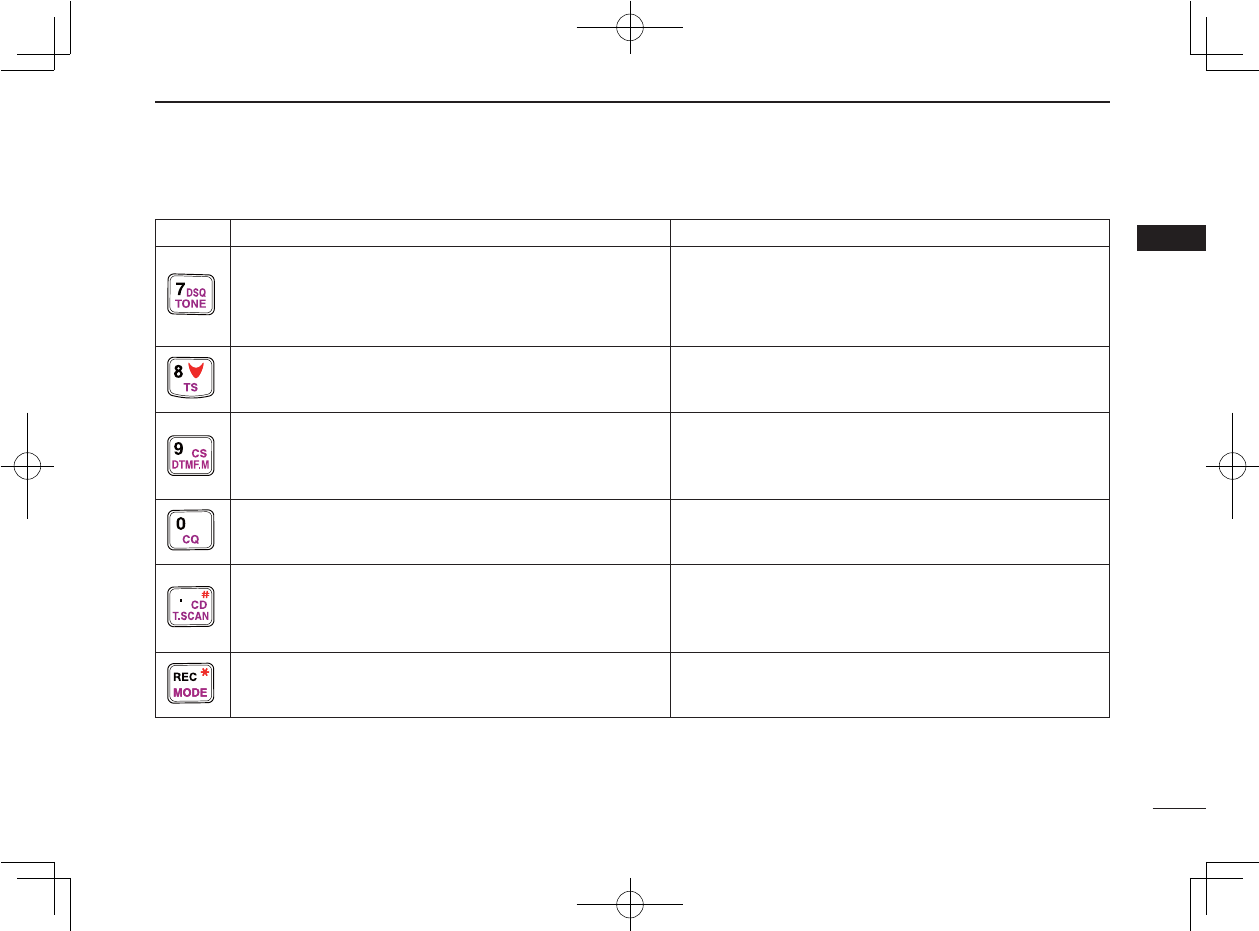
5
2
PANEL DESCRIPTION
New2001
2
9
DTMF
.
M
CS
0
CQ
.
T.SCAN
CD
#
REC
MODE
KEY Pushed momentarily Pushed and held for 1 sec.
• Inputs digit ‘7’ for frequency input, memory channel selection,
etc.
• While pushing [PTT], this key sends the DTMF code “7.”
• Inputs digit ‘8’ for frequency input, memory channel selection,
etc.
• While pushing [PTT], this key sends the DTMF code “8.”
• Inputs digit ‘9’ for frequency input, memory channel selection,
etc.
• While pushing [PTT], this key sends the DTMF code “9.”
• Inputs digit ‘0’ for frequency input, memory channel selection,
etc.
• While pushing [PTT], this key sends the DTMF code “0.”
• Inputs MHz digit for frequency input.
• While pushing [PTT], this key sends the DTMF code “F (#).”
• During DV mode operation, selects the record track for voice
memory. (p. 62)
• While pushing [PTT], this key sends the DTMF code “E (✱).”
• During FM/FM-N mode operation, selects repeater tone, tone
squelch, DTCS squelch and no tone operation in sequence.
(p. 110)
• During DV mode operation, selects digital call sign, digital code
and no tone operation in sequence. (p. 110)
• Selects tuning step selection. (p. 18)
• Select DTMF memory mode. (p. 103)
• During DV mode operation, CALL SIGN setting mode is dis-
played. (p. 51)
• During DV mode operation, set “CQCQCQ” for station’s call
sign for operation.
• During FM/FM-N mode operation, starts tone scan function.
(p. 112)
• During DV mode operation, RX CALL SIGN is displayed. (p. 56)
• Selects the operating mode.
7
TONE
DSQ
8
TS
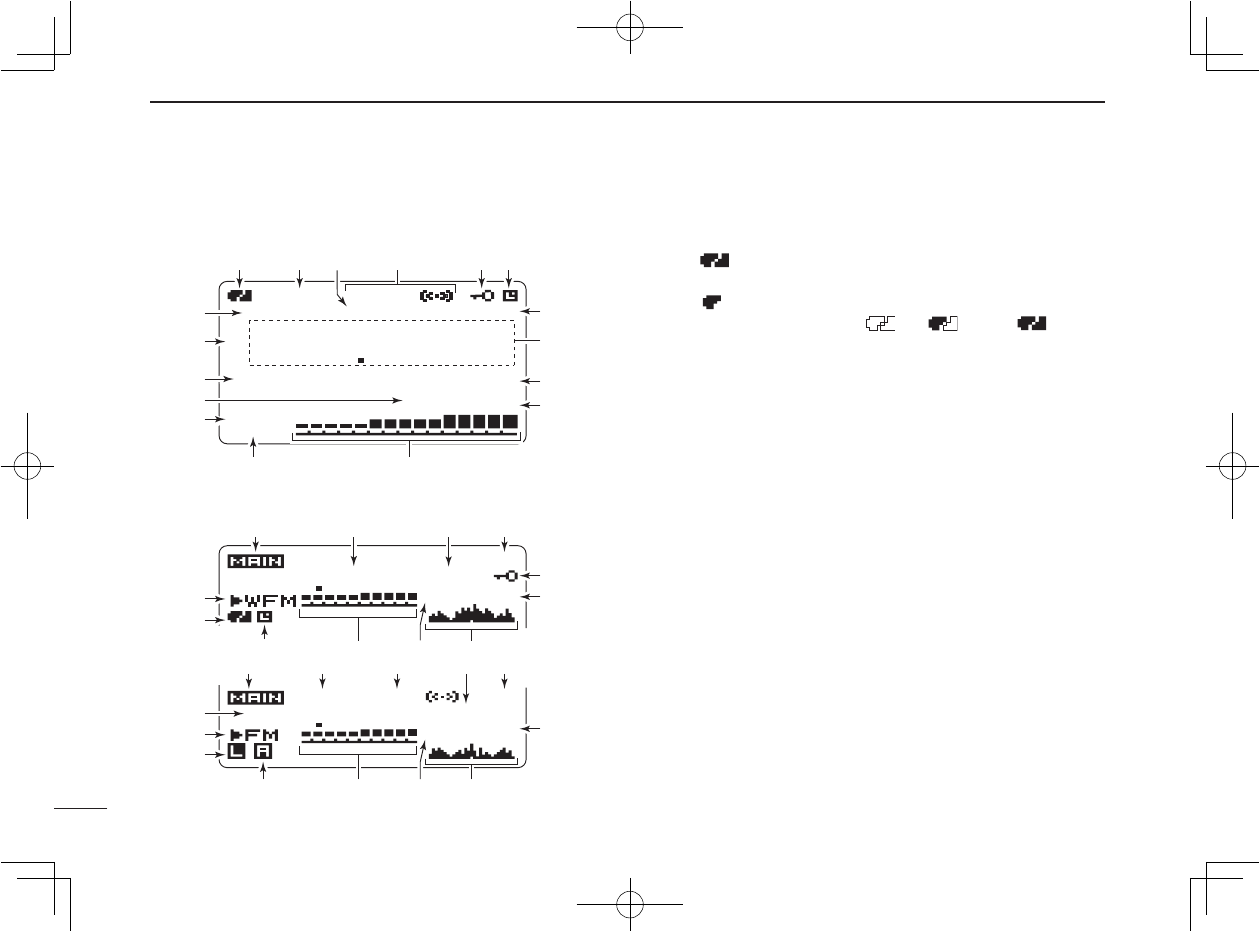
6
2PANEL DESCRIPTION
New2001 Ne
■ Function display
q BATTERY INDICATOR (pgs. 10, 12)
➥ “ ” (battery indicators) appear when the Li-Ion bat-
tery pack is attached.
➥ “ ” appears when the battery pack must be charged.
➥ The indicators show “ ,” “ ” and “ ” in se-
quence while charging the attached battery pack.
w DUPLEX INDICATORS (p. 29)
“ +DUP” appears when plus duplex, “–DUP” appears when
minus duplex is selected.
e PRIORITY WATCH INDICATOR (p. 83)
Appears when priority watch is in use.
r TONE INDICATORS
• While operating in FM mode;
➥ “ TONE” appears while the subaudible tone encoder is
in use. (pgs. 29, 106)
➥ “ TSQL” appears while the tone squelch function is in
use. (p. 110)
➥ “ DTCS” appears while the DTCS squelch function is in
use. (p. 110)
➥ “ S” appears with the “TSQL” or “DTCS” indicator
while the pocket beep function (with CTCSS or DTCS) is
in use. (p. 111)
• While operating in DV mode;
➥ “ DSQL” appears while the call sign squelch function is
in use. (p. 110)
➥ “ CSQL” appears while the digital code squelch function
is in use. (p. 110)
• Dualwatch indication
• Single band indication
MemoName
μ
PRIO
PRIO EMR
DSQL
DSQL
DV
B
LOW
ATT
439706
PSKIP
-DUP
-DUP
25
25
000
PS
PS
PRIO
PRIO
25
μ
000
000
88 100
DTCS
PS
PS
PRIO
PRIO
-DUP
-DUP
75
μ
000
000
439706
q
!6 i e o
we r ty
!1
!8!1y !4
!2
!3
!7
q
!4
!5
!6
!7 u
t
!0
!6 w r e o
!8!1!2 !4
!7
i
!3
!0
i
o
!0
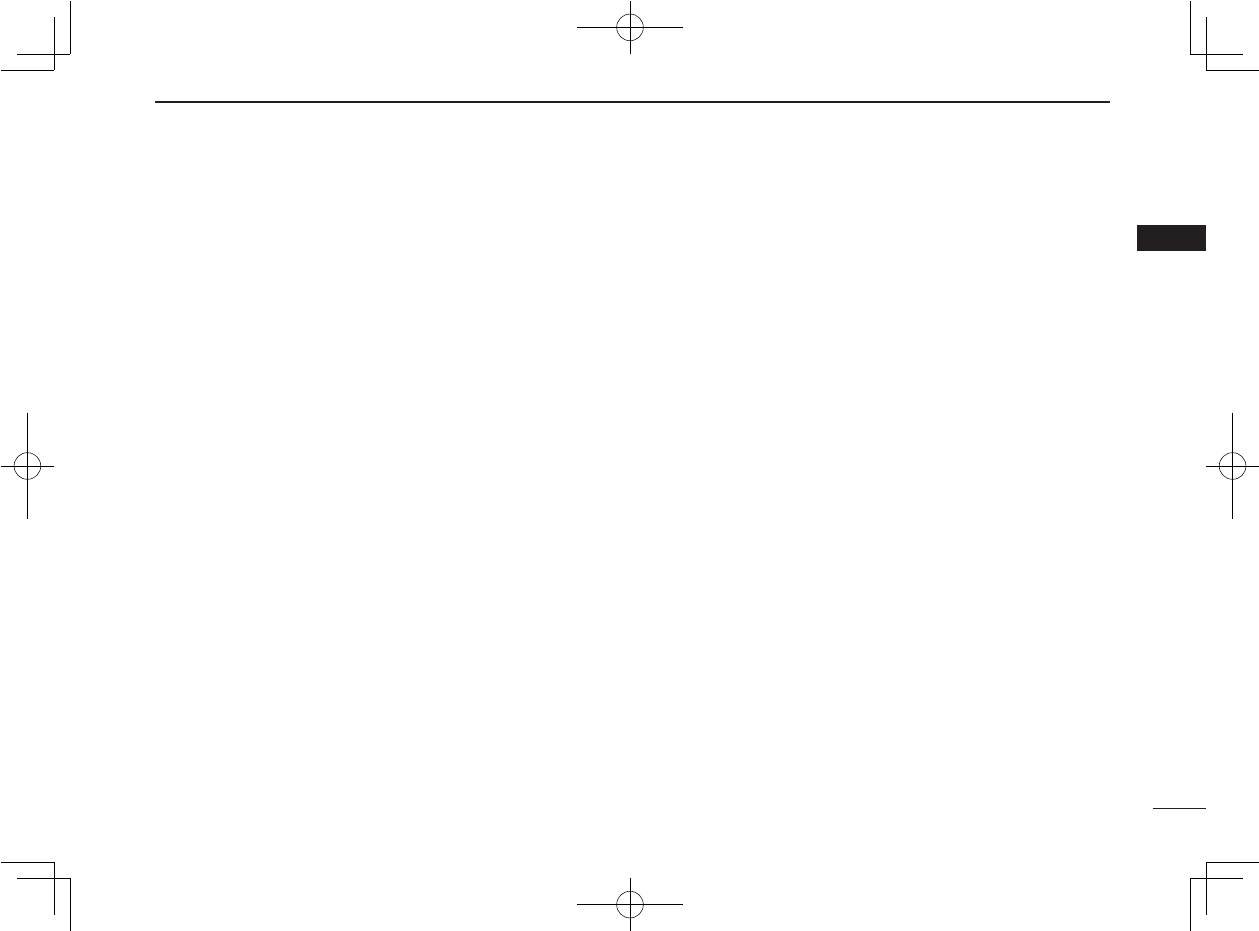
7
2
PANEL DESCRIPTION
New2001
2
➥ “ S” appears with the “DSQL” or “CSQL” indicator
while the pocket beep function (with digital call sign or
digital code squelch) is in use. (p. 111)
t KEY LOCK INDICATOR (pgs. 25, 113)
Appears when the key lock function is activated.
y AUTO POWER OFF INDICATOR (p. 88)
Appears when the auto power OFF function is in use.
u EMR MODE INDICATOR (p. 56)
Appears when the EMR mode operation is selected.
i FREQUENCY READOUT
Displays a variety of information, such as operating fre-
quency, set mode contents, memory names.
• The decimal point blinks during scan.
o SKIP INDICATORS (pgs. 79, 80)
➥ “ SKIP” appears when the selected memory channel is
set as a skip channel.
➥ “ P-SKIP” appears when the displayed frequency is set
as a skip frequency.
!0 MEMORY CHANNEL NUMBER INDICATOR
➥ Shows the selected memory channel number. (pgs. 64,
65)
➥ “C” appears when the call channel is selected. (pgs. 16,
65)
➥ “WX” appears when the weather channel is selected.
(pgs. 16, 114)
➥ “TV” appears when the TV channel is selected.
(pgs. 16, 28)
!1 S/RF METER
➥ Shows the relative signal strength while receiving sig-
nals.
➥ Shows the output power level while transmitting. (p. 24)
!2 ATTENUATOR INDICATOR (p. 22)
Appears when the RF attenuator is in use.
!3 LOW POWER INDICATOR (p. 24)
➥ “ LOW” appears when low power is selected.
➥ No indicator appears when high power is selected.
!4 MEMORY INDICATOR (p. 64)
Appears when memory mode is selected.
!5 NAME INDICATOR (p. 70)
During memory mode operation, the programmed mem-
ory or memory bank name is displayed.
!6 MAIN BAND INDICATOR (p. 14)
Shows which operating band, “A” or “B,” is selected for the
main band.
!7 OPERATING MODE INDICATOR (p. 21)
Shows the selected operating mode.
• DV, FM, FM-N, WFM and AM are available, depending on oper-
ating band.
!8 SIMPLE BAND SCOPE INDICATOR (p. 23)
When the simple band scope function is in use, shows
the band conditions.
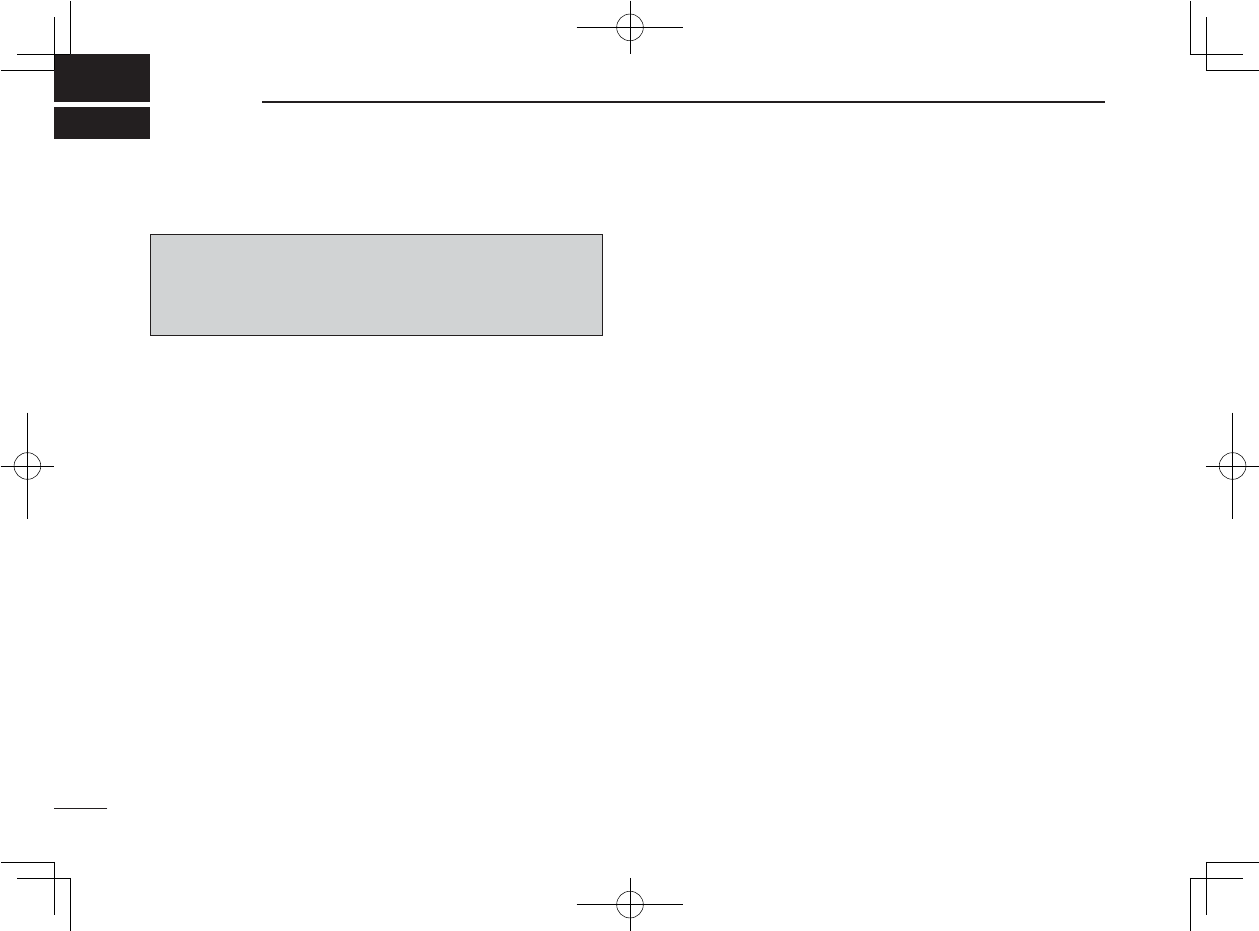
8
NeNew2001
BATTERY CHARGING
3
■ Caution
• R DANGER! Use and charge only specifi ed Icom battery
packs with Icom radios. Only Icom battery packs are tested
and approved for use with Icom radios. Using third-party or
counterfeit battery packs may cause smoke, fi re, or cause
the battery to burst.
D Battery caution
• R DANGER! DO NOT hammer or otherwise impact the
battery. Do not use the battery if it has been severely im-
pacted or dropped, or if the battery has been subjected to
heavy pressure. Battery damage may not be visible on the
outside of the case. Even if the surface of the battery does
not show cracks or any other damage, the cells inside the
battery may rupture or catch fi re.
• R DANGER! NEVER use or leave battery pack in areas
with temperatures above +60˚C (+140˚F). High tempera-
ture buildup in the battery, such as could occur near fires
or stoves, inside a sun heated car, or in direct sunlight
may cause the battery to rupture or catch fire. Excessive
temperatures may also degrade battery performance or
shorten battery life.
• R DANGER! DO NOT expose the battery to rain, snow,
seawater, or any other liquids. Do not charge or use a wet
battery. If the battery gets wet, be sure to wipe it dry before
using. The battery is not waterproof.
• R DANGER! NEVER incinerate an used battery pack
since internal battery gas may cause it to rupture, or may
cause an explosion.
• R DANGER! NEVER solder the battery terminals, or
NEVER modify the battery pack. This may cause heat gen-
eration, and the battery may burst, emit smoke or catch
fi re.
• R DANGER! Use the battery only with the transceiver for
which it is specified. Never use a battery with any other
equipment, or for any purpose that is not specified in this
instruction manual.
• R DANGER! If fluid from inside the battery gets in your
eyes, blindness can result. Rinse your eyes with clean
water, without rubbing them, and see a doctor immediately.
• WARNING! Immediately stop using the battery if it emits
an abnormal odor, heats up, or is discolored or deformed. If
any of these conditions occur, contact your Icom dealer or
distributor.
• WARNING! Immediately wash, using clean water, any part
of the body that comes into contact with fluid from inside
the battery.
Misuse of Lithium-Ion batteries may result in the fol-
lowing hazards: smoke, fi re, or the battery may rupture.
Misuse can also cause damage to the battery or degra-
dation of battery performance.
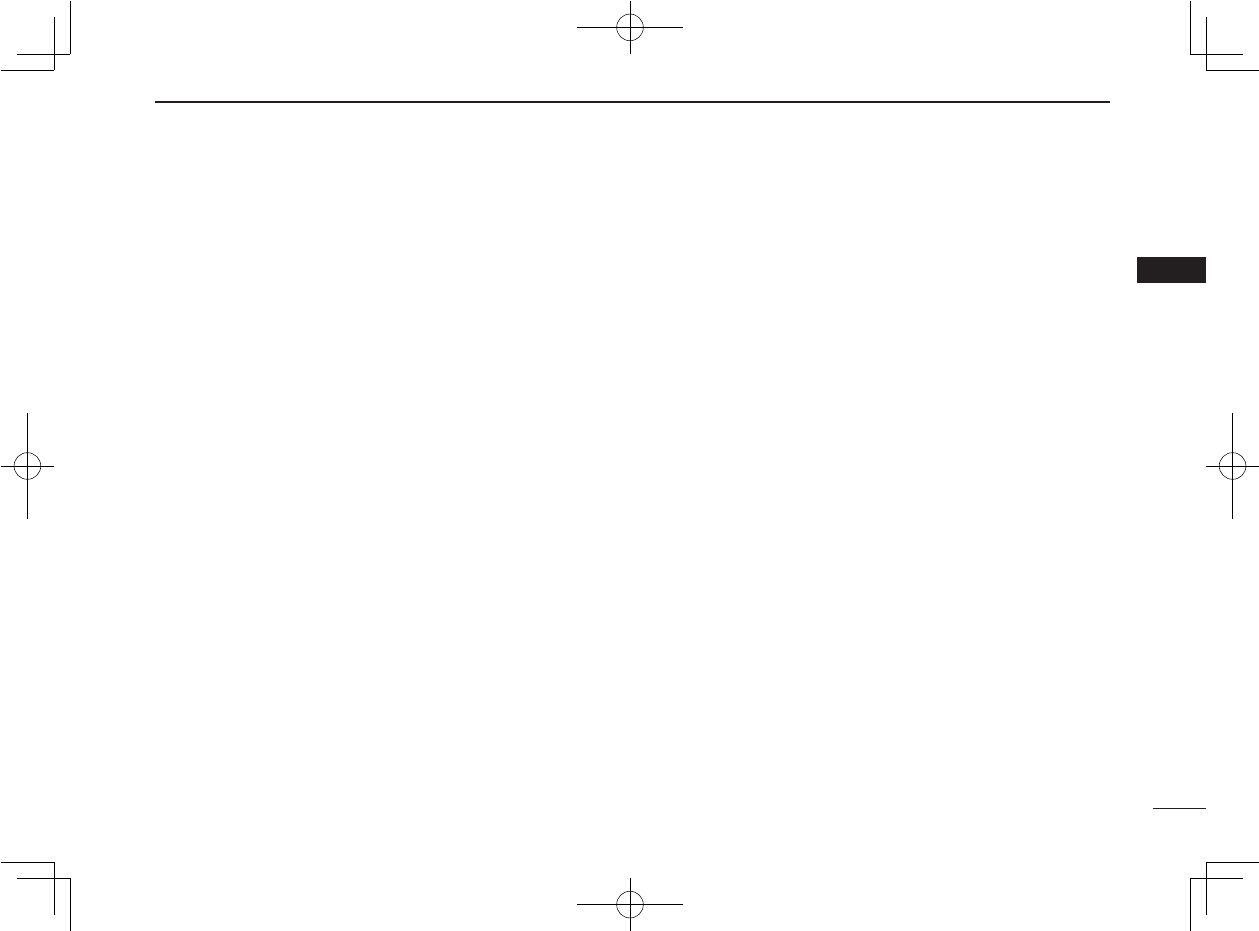
New2001
9
3
BATTERY CHARGING
3
• WARNING! NEVER put the battery in a microwave oven,
high-pressure container, or in an induction heating cooker.
This could cause a fire, overheating, or cause the battery
to rupture.
• CAUTION! Always use the battery within the specifi ed tem-
perature range, –20˚C to +60˚C (–4˚F to +140˚F). Using the
battery out of its specified temperature range will reduce
the battery’s performance and battery life.
• CAUTION! Shorter battery life could occur if the battery
is left fully charged, completely discharged, or in an ex-
cessive temperature environment (above +50˚C; +122˚F)
for an extended period of time. If the battery must be left
unused for a long time, it must be detached from the radio
after discharging. You may use the battery until the battery
indicator shows half-capacity, then keep it safely in a cool
dry place with the temperature between –20˚C to +20˚C (–
4˚F to +68˚F).
D Charging caution
• R DANGER! NEVER charge the battery pack in areas with
extremely high temperatures, such as near fi res or stoves,
inside a sun heated car, or in direct sunlight. In such en-
vironments, the safety/protection circuit in the battery will
activate, causing the battery to stop charging.
• WARNING! DO NOT charge or leave the battery in the
battery charger beyond the specified time for charging. If
the battery is not completely charged by the specifi ed time,
stop charging and remove the battery from the battery
charger. Continuing to charge the battery beyond the speci-
fi ed time limit may cause a fi re, overheating, or the battery
may rupture.
• WARNING! NEVER insert the transceiver (battery attached
to the transceiver) into the charger if it is wet or soiled. This
could corrode the battery charger terminals or damage the
charger. The charger is not waterproof.
• CAUTION! DO NOT charge the battery outside of the
specifi ed temperature range: 0˚C to +35˚C (+32˚F to +95˚
F). Icom recommends charging the battery at +20˚C (+68˚
F). The battery may heat up or rupture if charged out of the
specifi ed temperature range. Additionally, battery perform-
ance or battery life may be reduced.
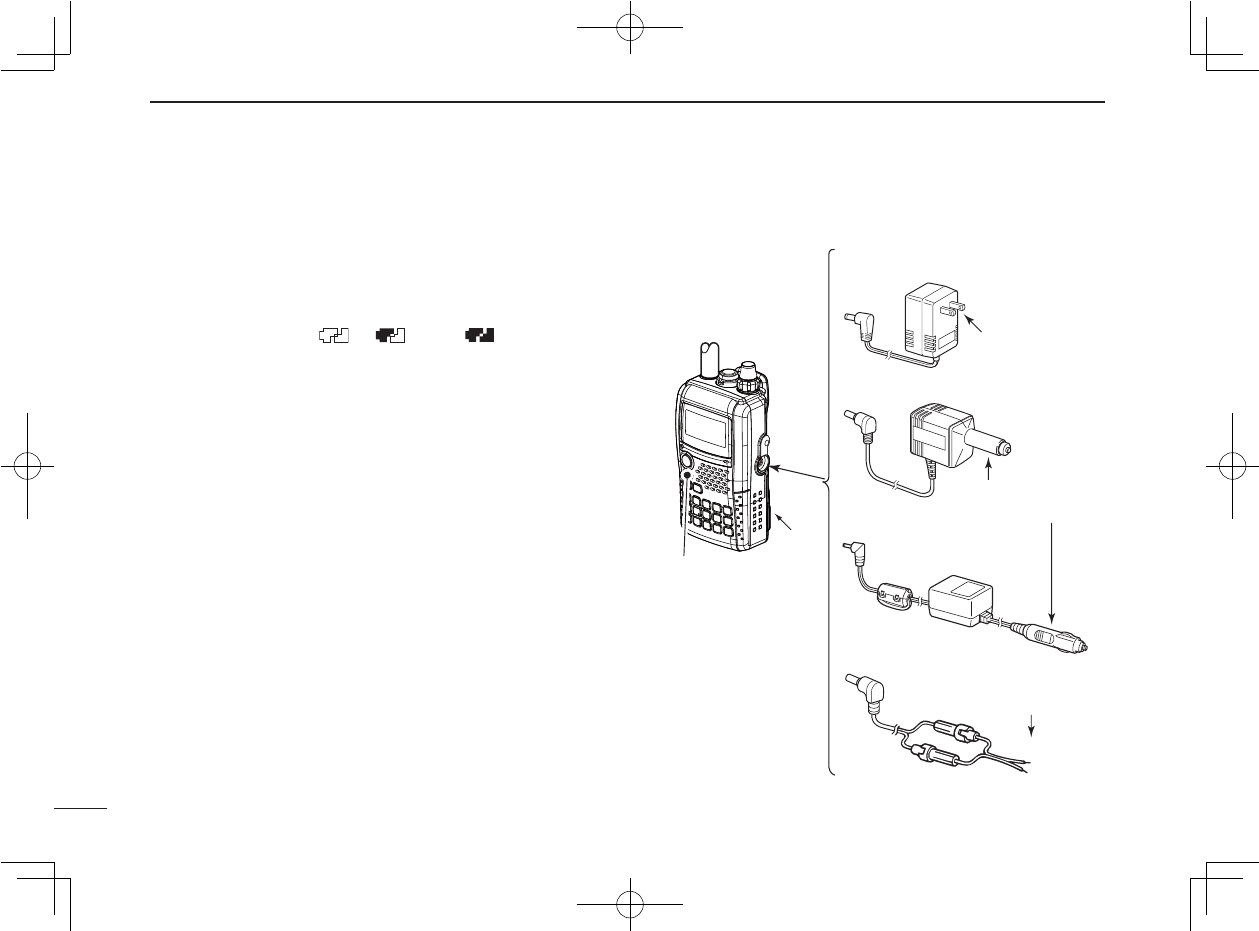
Ne
10
3BATTERY CHARGING
New2001
■ Regular charging
Prior to using the transceiver for the first time, the battery
pack must be fully charged for optimum life and operation.
D Battery indicators
The indicators show “ ,” “ ” and “ ” in sequence
while charging, and both indicators disappear when com-
pletely charged.
D Charging note
• Be sure to turn the transceiver power OFF.
Otherwise the battery pack will not be charged completely or takes
longer charging time periods.
• External DC power operation becomes possible when
using an optional CP-12L, CP-19R or OPC-254L. The at-
tached battery pack is also charged simultaneously, except
during transmit. (see p. 11 for more details)
• The external DC power supply voltage must be within 10–
16 V to charge the battery pack and operation when using
an optional OPC-254L.
• BC-167A/D
• CP-12L (Optional)
• OPC-254L (Optional)
to AC outlet
to cigarette lighter
socket (12 V DC)
to 12 V DC
(power supply)
White: +
Black: _
Transceiver
to
[DC IN]
Turn power OFF while
charging the battery
pack.
• Charging time period:
Approx. 6 hours
BP-256 • CP-19R (Optional)
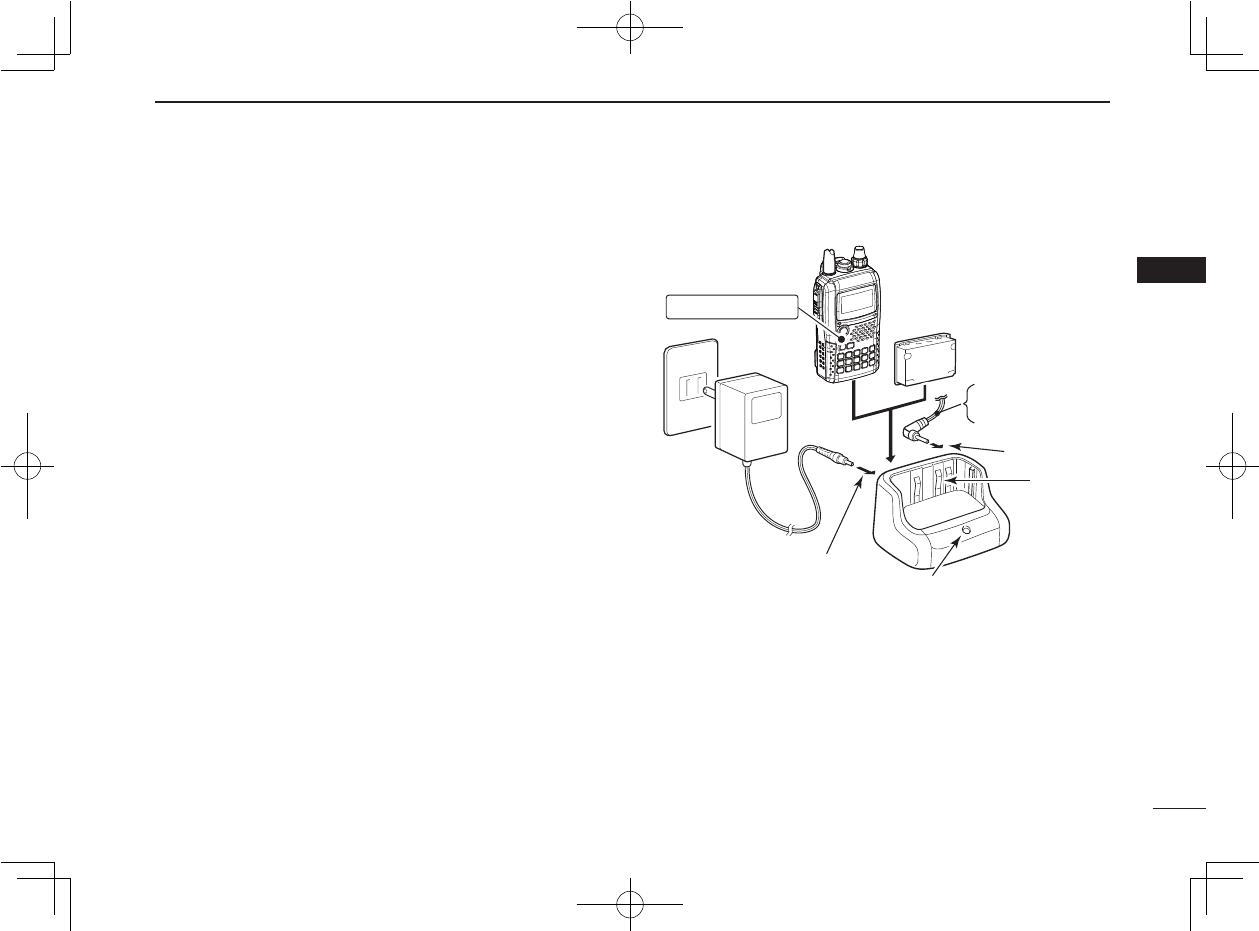
11
3
BATTERY CHARGING
New2001
3
■ Rapid charging
The optional BC-177 provides rapid charging of the battery
pack.
• Charging period: approx. 2.5 hours (with BP-256)
D Charging note
• Be sure to turn the transceiver power OFF.
Detach the battery pack from the transceiver then charge
the battery pack by itself, or charge the battery with regu-
lar charging when the transceiver power cannot be turned
OFF.
Otherwise the battery pack will not be charged (charging in-
dicator on the BC-177 blinks orange about 10 sec. after the battery
pack is installed in BC-177).
• The desktop charger, BC-177, can only be charged
BP-256. Other types of rechargeable battery, Ni-Cd or
Ni-MH, cannot be charged.
• If the charging indicator blinks orange, there may be a
problem with the battery pack (or charger). Reinsert the bat-
tery pack or contact your dealer.
• The optional CP-12L and OPC-254L can be used instead
of the supplied AC adapter (BC-123A/E). Connect one of
these to the [DC 13.5V] jack in this case.
Transceiver
(with battery pack)
Turn power OFF. Battery pack
to AC outlet
BC-177 (optional)
Desktop charger
to [AC ADAPTER]
to [DC 13.5V]
CP-12L
OPC-254L
Charging indicator
Charging : Orange
Finished : Green
Charging
terminal
AC adapter
(supplied
with BC-177)
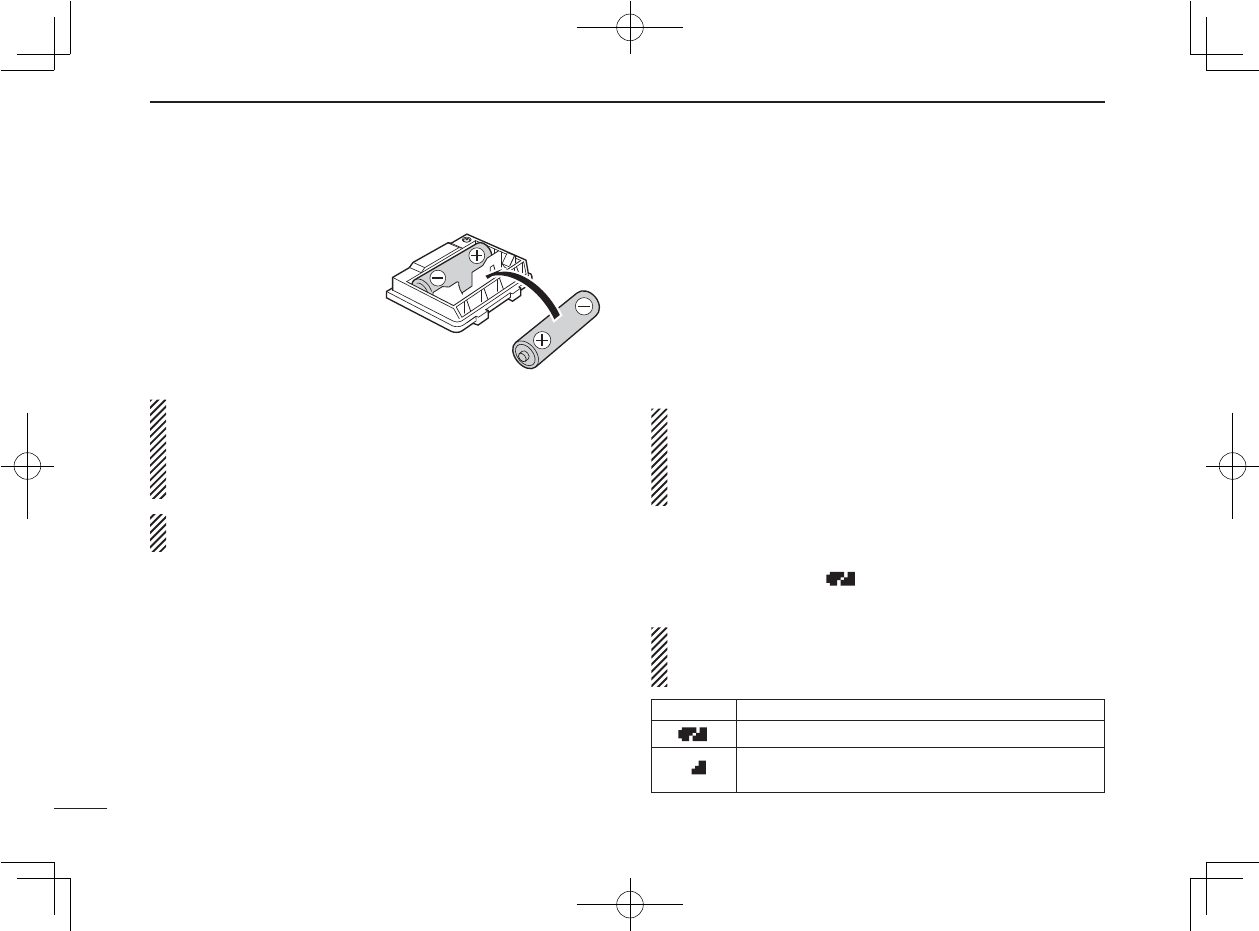
Ne
12
3BATTERY CHARGING
New2001
■ Optional battery case
➥ Install 2 u LR6 (AA) size
alkaline batteries into the
optional BP-257 BATTERY
CASE.
• Be sure to observe the cor-
rect polarity.
A built-in step-up convertor in the BP-257 increases the
voltage to 5 V DC.
Approx. 100 mW of output power is possible with the
BP-257 operation. Also, no transmit output power selec-
tion is available.
Keep battery contacts clean. It’s a good idea to clean bat-
tery terminals once a week.
D Battery information
The batteries may seem to have low capacity when used in
low temperatures such as –10°C (+14°F) or below. Keep the
battery case or pack warm in this case.
D Battery replacement
When the batteries become exhausted, the function display
may blink or have a lower contrast. In these cases, replace
all batteries with new, same brand, alkaline batteries.
■ Battery information
D Battery life
The transceiver operates with the BP-256 as follows.
However, when operating in DV mode, operating time may
be shortened by one-half hour.
• VHF band : Approx. 5 hours
• UHF band : Approx. 4.5 hours
(Tx: Rx: Stand-by=1: 1: 8)
Even when the transceiver power is OFF, a slight current
still fl ows in the circuits. Remove the battery pack or case
from the transceiver when not using it for a long time. Oth-
erwise, the battery pack or installed batteries will become
exhausted.
D Battery indicator
The battery indicator, “ ,” appears only when the BP-256
is attached to the transceiver.
The battery indicator does not appear when turning power
ON after the charging is completed without disconnecting
the battery charger or external DC power.
Indication Battery condition
The battery has ample capacity.
The battery is nearing exhaustion. Charging is neces-
sary.
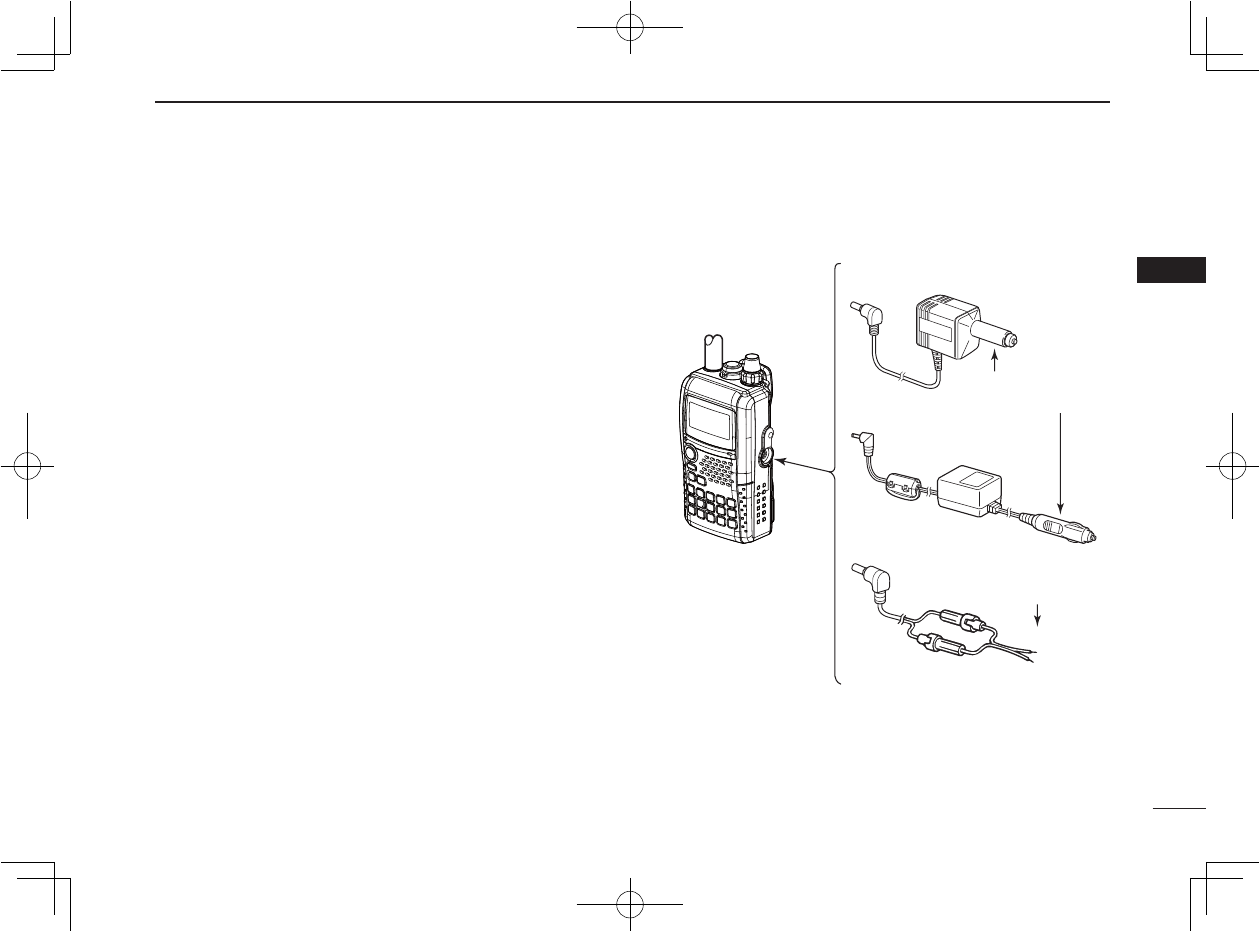
13
3
BATTERY CHARGING
New2001
3
■ External DC power operation
An optional cigarette lighter cable (CP-12L or CP-19R; for 12 V
cigarette lighter socket) or external DC power cable (OPC-254L)
can be used for external power operation.
D Operating note
• Power supply range is between 10.0–16.0 V DC.
NEVER CONNECT OVER 16 V DC directly into the [DC IN]
jack of the transceiver.
• BE SURE to use CP-12L,CP-19R or OPC-254L when con-
necting a regulated 12 V DC power supply.
Use an external DC-DC converter to connect the trans-
ceiver through optional CP-12L, CP-19R or OPC-254L to a
24 V DC power source.
• The voltage of the external power supply must be within
10–16 V DC when using either CP-12L, CP-19R or OPC-
254L, otherwise, use the battery pack.
• Up to 5 W (approx.) of maximum output power is provided
with the external DC power operation, however, when the
supplied voltage exceeds 14 V, the built-in protection circuit
activates to reduce the transmit output power to 0.5 W (ap-
prox.).
• Disconnect the power cables from the transceiver when
not using it. Otherwise, the vehicle battery will become ex-
hausted.
• The power save function is deactivated automatically dur-
ing external DC power operation.
Transceiver
• CP-12L (Optional)
• CP-19R (Optional)
• OPC-254L (Optional)
to cigarette lighter
socket (12 V DC)
to 12 V DC
(power supply)
White: +
Black: _
to
[DC IN]
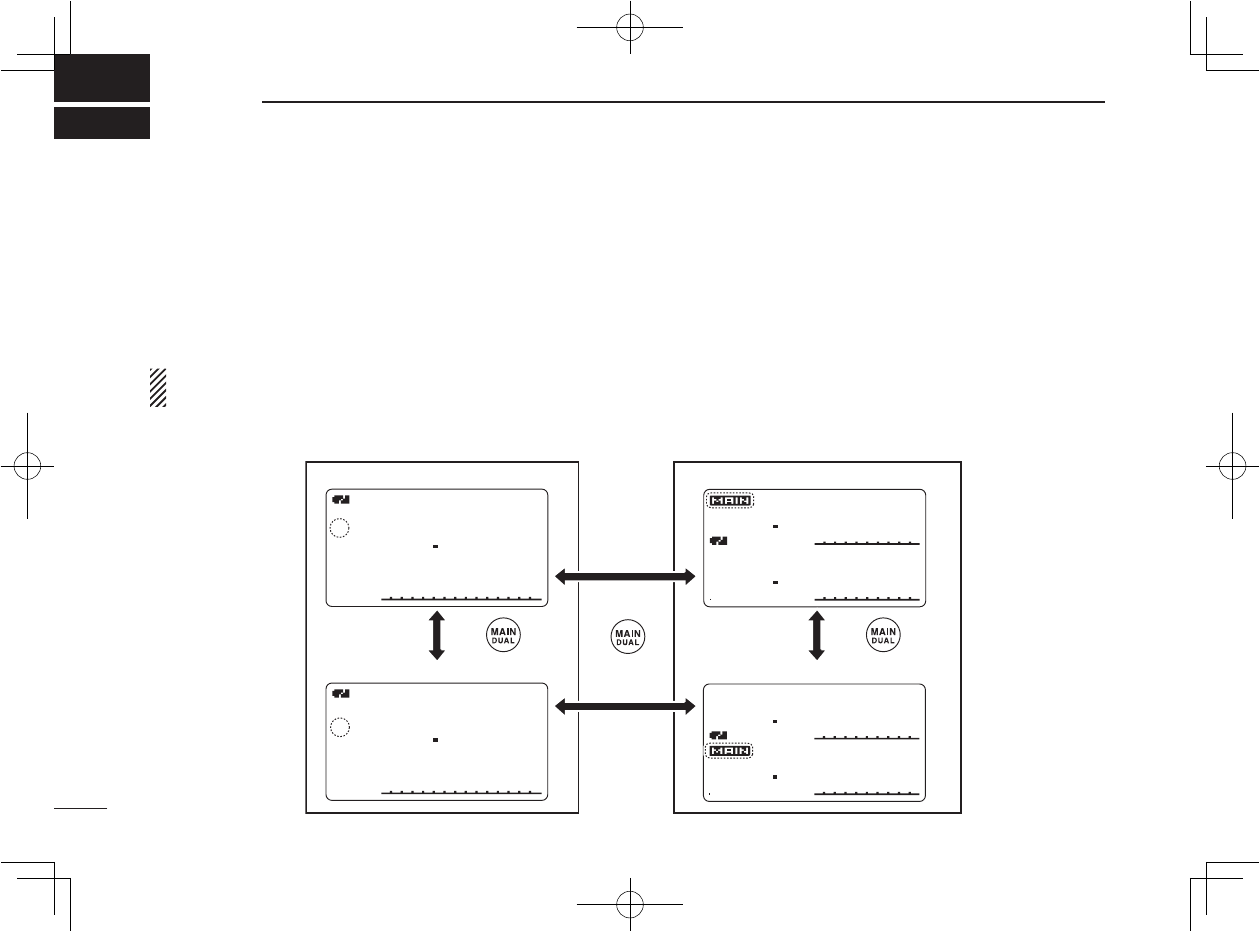
14
NeNew2001
FREQUENCY AND CHANNEL SETTING
4
■ Main band selection
The IC-92A/92AD has two independent operating bands; A
band (VFO A) and B band (VFO B). A band (VFO A) can oper-
ate 0.495 MHz to 999.990 MHz*, and B band (VFO B) can
operate 118 MHz to 174 MHz and 350 MHz to 470 MHz.
* Some frequency ranges are blocked for the USA version by regula-
tion.
NOTE: When in dualwatch mode, transmission is avail-
able from the MAIN band only.
D How to change the main band
➥ Push [MAIN/DUAL] to toggle between A and B band.
➥ Push and hold [MAIN/DUAL] for 1 sec. to turn the dual-
watch operation ON and OFF.
• While in dualwatch operation, the display indicates A band in
the upper half and B band in the lower half.
➥ During dualwatch operation, push [MAIN/DUAL] to select
A band or B band as the main operating band alternately.
DTCS
DTCS
W
PS
EMEM
W
PS
FMFM
PRIOPRIO
PRIOPRIO
+DUP+DUP
+DUP+DUP
FM
146010
440000000
25
50
μ
000000
μ
000000
DTCS
DTCS
W
PS
EMEM
W
PS
FMFM
PRIOPRIO
PRIOPRIO
+DUP+DUP
+DUP+DUP
FM
146010
440000
25
50
μ
000000
μ
000000
A
MemoNameMemoName
μ
PRIO WX EMR
DTCS
FM
LOW
ATT
146010
PSKIPSKIP
+DUP
2525
000000
MemoName
μ
PRIOPRIO WXWX EMREMR
DTCSDTCS
FMFM
B
LOW
ATT
440000
PSKIPSKIP
+DUP+DUP
2525
000
Push Push
• Selecting A band • Selecting upper side as main band
• Selecting lower side as main band
• Selecting B band
Push
DTCS
DTCS
W
PS
EM
W
PS
FM
PRIO
PRIO
+DUP
+DUP
FM
146 010
440 000
25
50
μ
000
μ
000
DTCS
DTCS
W
PS
EM
W
PS
FM
PRIO
PRIO
+DUP
+DUP
FM
146 010
440 000
25
50
μ
000
μ
000
A
MemoName
μ
PRIO WX EMR
DTCS
FM
LOW
ATT
146010
P SKIP
+DUP
25
000
MemoName
μ
PRIO WX EMR
DTCS
FM
B
LOW
ATT
440000
P SKIP
+DUP
25
000
Single band operation Dualwatch operation
for 1 sec.
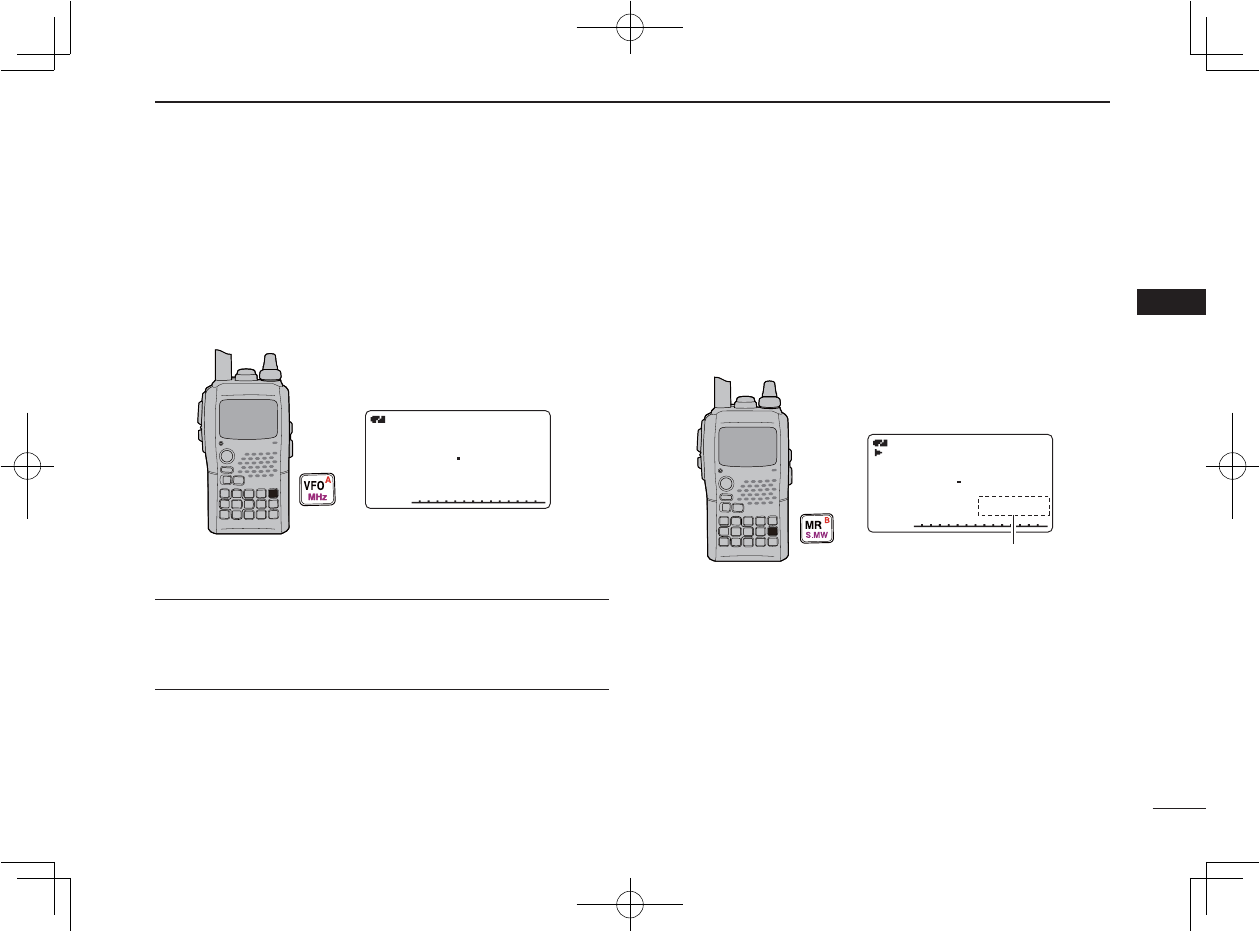
New2001
15
4
FREQUENCY AND CHANNEL SETTING
4
■ Mode selection
D VFO mode
VFO mode is used to set the desired frequency.
➥ Push [VFO] to select VFO mode.
What is VFO?
VFO is an abbreviation of Variable Frequency Oscillator. Fre-
quencies for both transmitting and receiving are generated
and controlled by the VFO.
D Memory mode
Memory mode is used for operation on memory channels
which store programmed frequencies.
q Push [MR] to select memory mode.
• “μ ” appears when memory mode is selected.
w Rotate [DIAL] to select the desired memory channel.
• Only programmed memory channels can be selected.
• Enter the memory channel directly to select the desired memory
channel. (p. 64)
• See p. 66 for memory programming details.
A
Mem oName
MemoName
µ
PRIO
PRIO
WX
WX
EMR
EM R
DTCS
DTCS
FM
LOW
LO W
AT T
ATT
146010
PSKIP
+DUP
+DUP
25
25
000
000
• VFO mode indication
VFO
MHz
A
MR
S.MW
B
A
MemoName
MemoName
μ
PRIO
PRIO WX
EMR
EMR
DTCS
DTCS
FM
FM
LOW
LOW
ATT
ATT
433000
PSKIP
+DUP
+DUP
25
25
001
001
• Memory mode indication
Appear
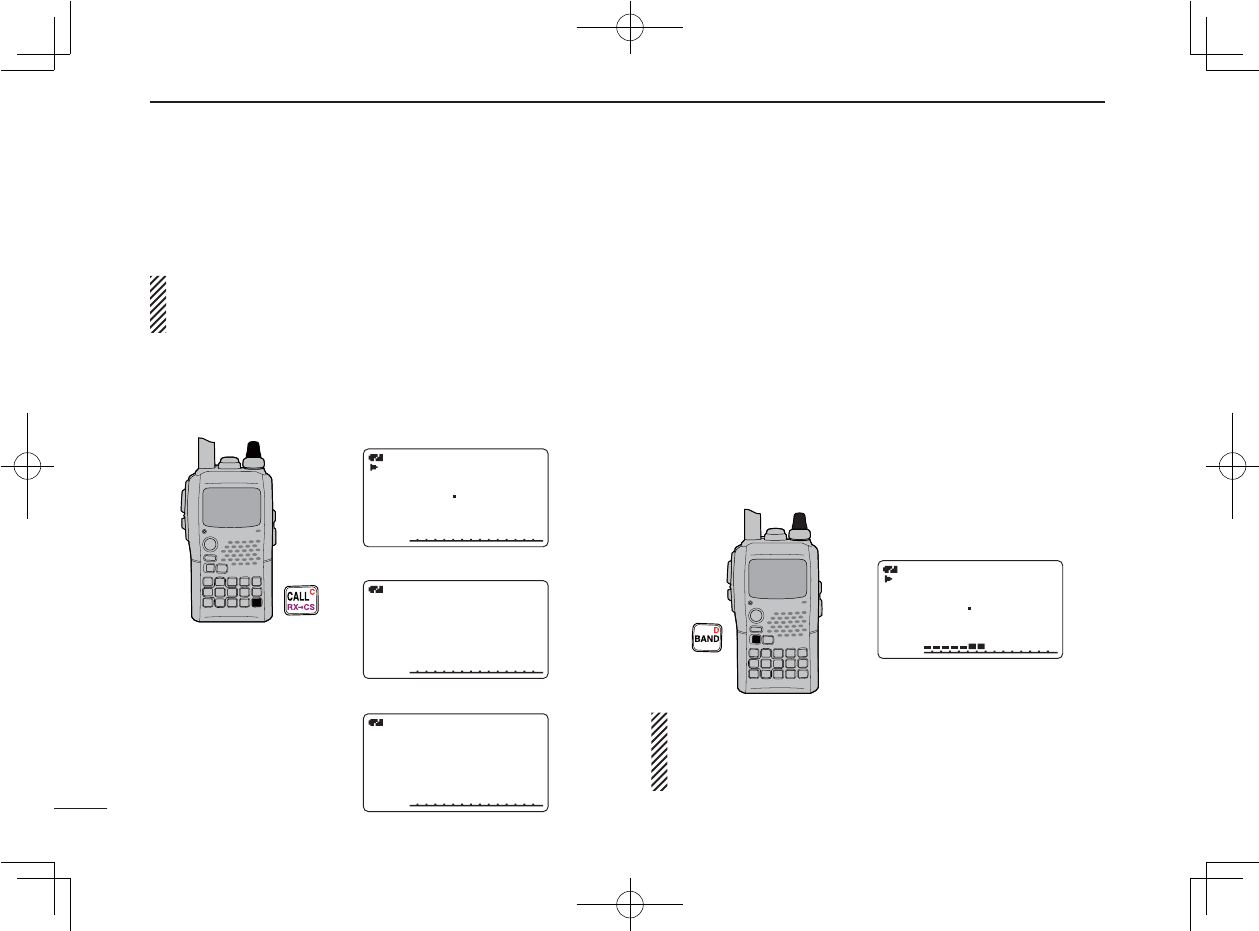
Ne
16
4FREQUENCY AND CHANNEL SETTING
New2001
D Call/TV*/Weather† channels
Call channels are used for quick recall of most-often used
frequencies.
* Appears only when TV channels are programmed via the
optional RS-91. Also available for A band operation only.
†
Available for the USA version only.
q Push [CALL] several times to select call channels/TV
channels (A band only)/Weather channels.
•- Call/TV/Weather channels can be selected in sequence.
w Rotate [DIAL] to select the desired channel.
■ Operating band selection
The transceiver can receive the AM broadcast, HF bands,
50 MHz, FM broadcast, VHF air, 144 MHz, 300 MHz, 400
MHz or 800 MHz* bands. (Some bands are not selectable for B
band operation. See next page for details.)
➥ In VFO mode, push [BAND] several times to select the
desired frequency band.
•- If the other than VFO mode is selected, such as a memory
channel/call channel/TV channel/Weather channel, push [VFO]
to select VFO mode first, then push [BAND] to select the de-
sired band.
➥ While pushing and holding [BAND], rotating [DIAL] also
selects frequency band.
Available frequency bands are different depending on ver-
sion. See the specifi cation for details. (pgs. 120, 121)
* Some frequency ranges are blocked for the USA version
by regulation.
[DIAL]
CALL
RX
CS
C
A
MemoName
MemoName
μ
PRIO
PRIO
WX
WX
EMR
EMR
DTCS
DTCS
FM
LOW
ATT
145000
P
SKIP
SKIP
+DUP
+DUP
25
C0
TV
A
MemoName
MemoName
μ
PRIO
PRIO
WX
WX
EMR
EMR
DTCS
DTCS
WFM
WFM
LOW
ATT
10 ch
P
SKIP
SKIP
+DUP
+DUP
25
WX
WX
A
MemoName
MemoName
μ
PRIO
PRIO
WX
WX
EMR
EMR
DTCS
DTCS
LOW
ATT
1ch
P
SKIP
SKIP
+DUP
+DUP
25
• Call channel indication
• TV channel indication
• Weather channel indication
BAND
D
[DIAL]
A
MemoNameMemoName
μ
PRIOPRIO WX EMREMR
DTCSDTCS
FM
LOWLOW
ATTATT
145000
PSKIP
+DUP+DUP
25
000000
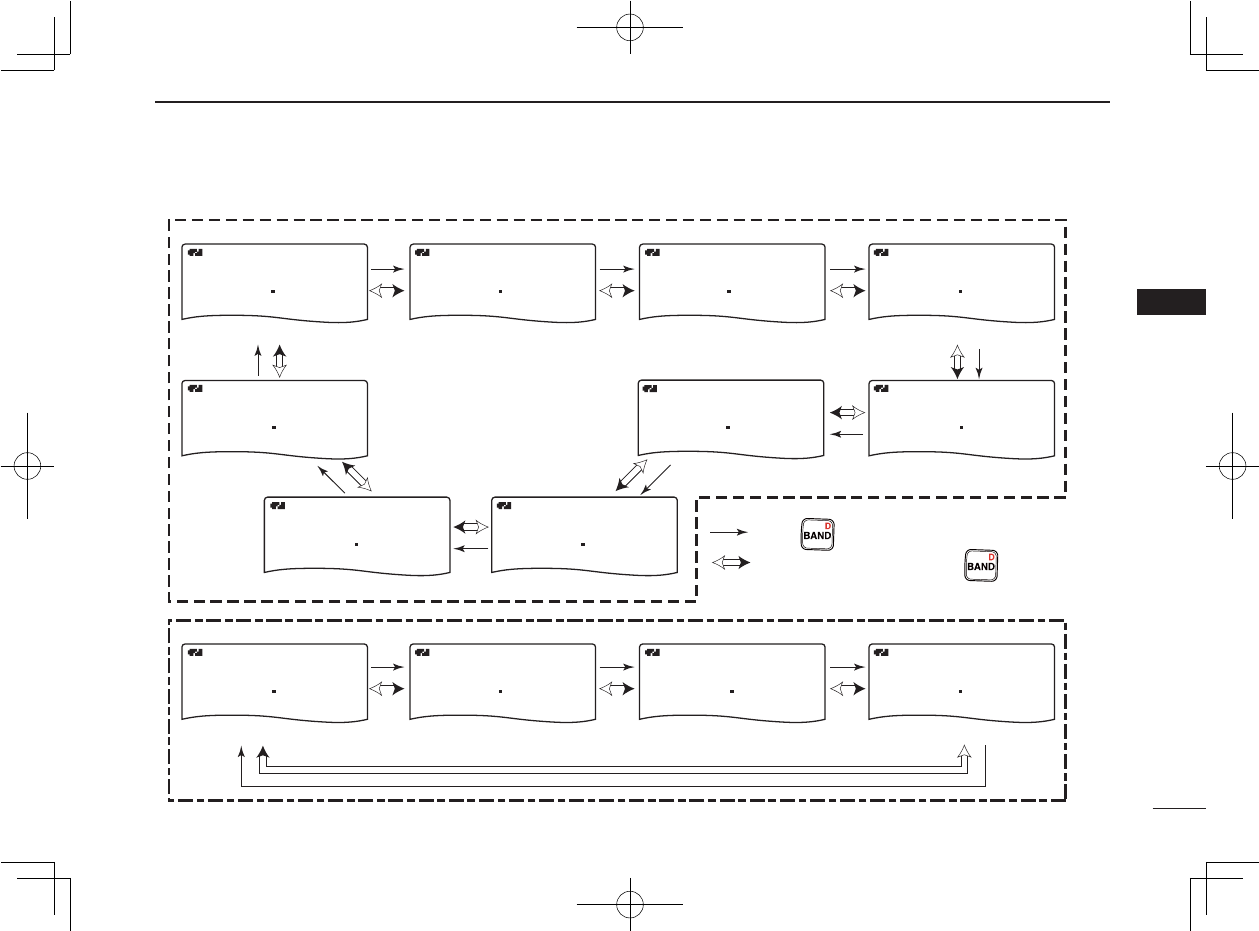
17
4
FREQUENCY AND CHANNEL SETTING
New2001
1
2
3
4
5
6
7
8
9
10
11
12
13
14
15
16
17
18
19
• Available frequency bands
A
Mem oName
MemoName
PRIO
PRIO
WX
WX
EMR
EM R
DTCS
DTCS
AM
AM
118000
PSKIP
+DUP
+DUP
25
25
A
Mem oName
MemoName
PRIO
PRIO
WX
WX
EMR
EM R
DTCS
DTCS
AM
B
118000
PSKIP
+DUP
+DUP
25
25
A
Mem oName
MemoName
PRIO
PRIO
WX
WX
EMR
EM R
DTCS
DTCS
FM
FM
B
146010
PSKIP
+DUP
+DUP
25
25
A
Mem oName
MemoName
PRIO
PRIO
WX
WX
EMR
EM R
DTCS
DTCS
FM
FM
B
370000
P
SKIP
SKIP
+DUP
+DUP
25
25
A
Mem oName
MemoName
PRIO
PRIO
WX
WX
EMR
EM R
DTCS
DTCS
FM
FM
B
440000
PSKIP
+DUP
+DUP
25
25
A
Mem oName
MemoName
PRIO
PRIO
WX
WX
EMR
EM R
DTCS
DTCS
FM
FM
850000
PSKIP
+DUP
+DUP
25
25
A
Mem oName
MemoName
PRIO
PRIO
WX
WX
EMR
EM R
DTCS
DTCS
FM
440000
PSKIP
+DUP
+DUP
25
25
A
Mem oName
MemoName
PRIO
PRIO
WX
WX
EMR
EM R
DTCS
DTCS
AM
370000
PSKIP
+DUP
+DUP
25
25
A
Mem oName
MemoName
PRIO
PRIO
WX
WX
EMR
EM R
DTCS
DTCS
FM
FM
146010
P
SKIP
SKIP
+DUP
+DUP
25
25
A
Mem oName
MemoName
PRIO
PRIO
WX
WX
EMR
EM R
DTCS
DTCS
AM
001620
PSKIP
+DUP
+DUP
25
25
A
Mem oName
MemoName
PRIO
PRIO
WX
WX
EMR
EM R
DTCS
DTCS
AM
005000
PSKIP
+DUP
+DUP
25
25
A
Mem oName
MemoName
PRIO
PRIO
WX
WX
EMR
EM R
DTCS
DTCS
FM
FM
051 000
P
SKIP
SKIP
+DUP
+DUP
25
25
A
Mem oName
MemoName
PRIO
PRIO
WX
WX
EMR
EM R
DTCS
DTCS
WFM
WFM
076 000
PSKIP
+DUP
+DUP
25
25
AM broadcast band HF band
• A band
• B band
50 MHz band
800 MHz band
400 MHz band
400 MHz band
FM broadcast band
VHF air band
VHF air band
144 MHz band
144 MHz band
300 MHz band
300 MHz band
: Push
: Rotating [DIAL] while pushing
Initial frequencies shown differ according to version.
BAND
D
BAND
D
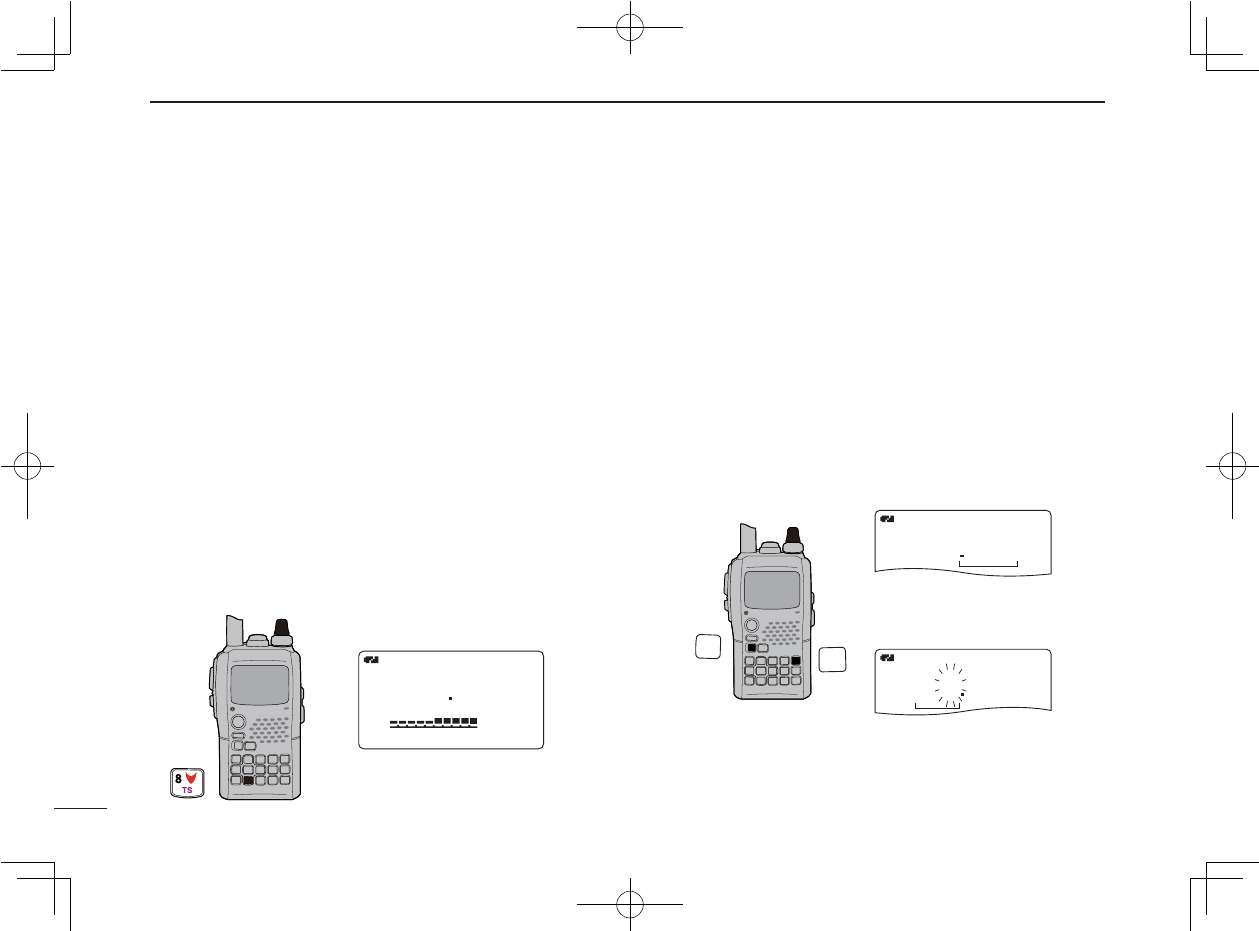
Ne
18
4FREQUENCY AND CHANNEL SETTING
New2001
■ Setting a tuning step
The tuning step can be selected for each frequency band.
The following tuning steps are available for the IC-92A/92AD.
• 5.0 kHz* • 6.25 kHz* • 8.33 kHz† • 9.0 kHz‡ • 10.0 kHz
• 12.5 kHz • 15.0 kHz • 20.0 kHz • 25.0 kHz • 30.0 kHz
• 50.0 kHz • 100.0 kHz • 125.0 kHz • 200.0 kHz
* Appears for below the 600 MHz bands only.
† Appears for the VHF air band only.
‡ Appears for the AM broadcast band only.
D Tuning step selection
q Push [VFO] to select VFO mode, if necessary.
w Push [BAND] to select the desired frequency band.
• Or, while pushing and holding [BAND], rotate [DIAL] to select
the desired frequency band.
e
Push and hold [TS](8) for 1 sec. to enter tuning step set
mode.
r Rotate [DIAL] to select the desired tuning step.
t Push [TS](8) (or [VFO]) to return to VFO mode.
■ Setting a frequency
D Using the dial
q Push [VFO] to select VFO mode, if necessary.
w Select the desired frequency band with [BAND].
• Or, while pushing and holding [BAND], rotate [DIAL] to select
the desired frequency band.
e Rotate [DIAL] to select the desired frequency.
• The frequency changes according to the preset tuning steps.
See the left-hand side of the page to set the tuning step.
• Push and hold [MHz](VFO) for 1 sec. then rotate [DIAL] to
change the frequency in 1 MHz steps, or push and hold for 1
sec. again then rotate [DIAL] to change the frequency in 10
MHz steps. (Each pushing and holding for 1 sec. toggles 1 MHz
or 10 MHz tuning steps. Push [MHz](VFO) to cancel it.)
A
PRIO
PRIO WX
EMR
EMR
DTCS
DTCS
FM
FM
146010
P
+DUP
+DUP
25
25
SET
SET-
TS:5.0kHz
TS:5.0kHz
μ
000
SKIP
5 kHz tuning step
[DIAL]
8
TS
A
PRIO
PRIO WX
EMR
EMR
DTCS
DTCS
FM
146010
+DUP
+DUP
25
A
PRIO
PRIO WX
EMR
EMR
DTCS
DTCS
FM
146010
+DUP
+DUP
25
[DIAL] changes the
frequency according to the
selected tuning step.
After pushing and holding
[MHz](VFO) for 1 sec.,
[DIAL] changes the
frequency in 1 MHz/10 MHz
steps.
BAND
VFO
MHz
A
D
[DIAL]
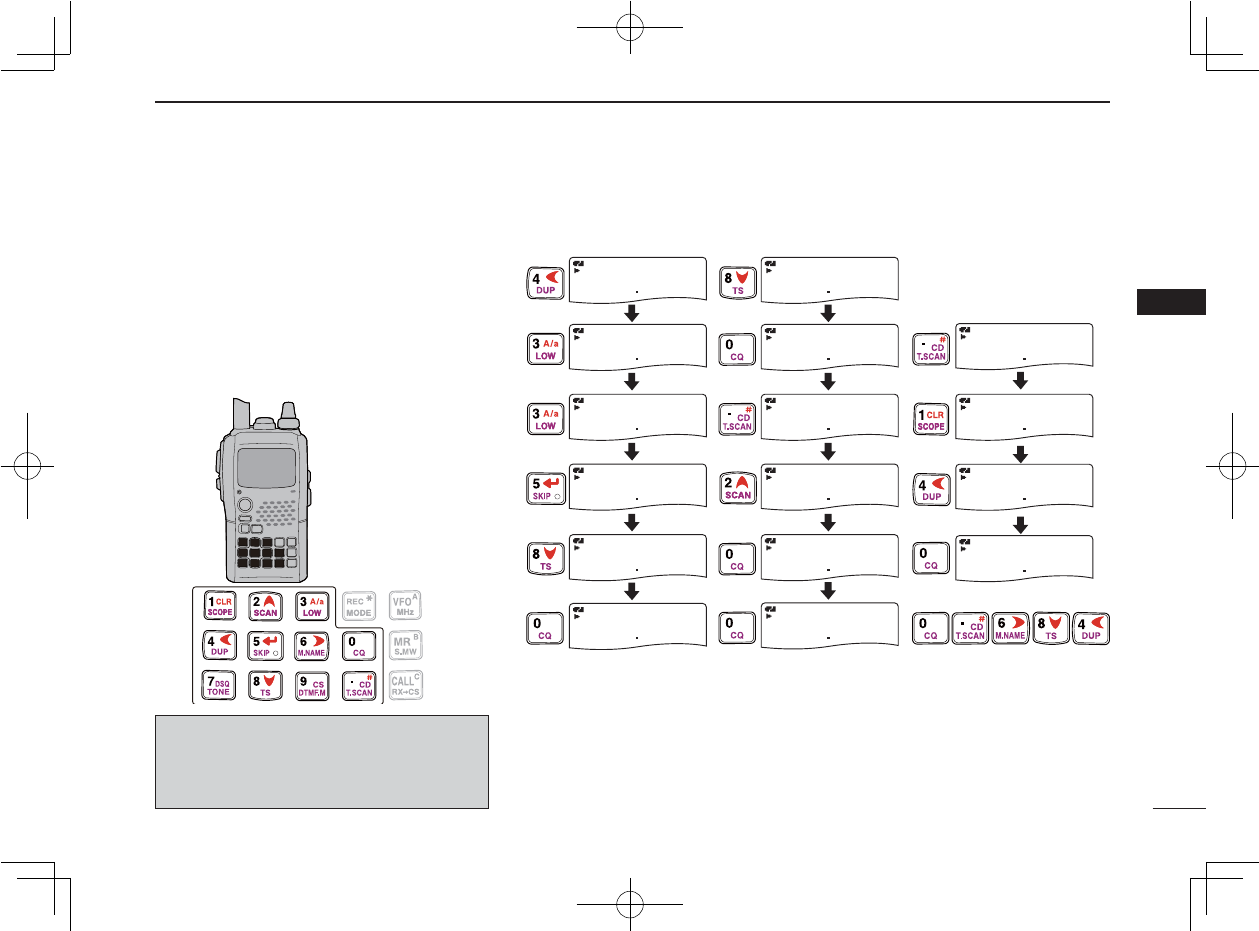
19
4
FREQUENCY AND CHANNEL SETTING
New2001
1
2
3
4
5
6
7
8
9
10
11
12
13
14
15
16
17
18
19
D Using the keypad
The frequency can be directly set via nu-
meric keys.
• If a frequency outside the frequency range is
entered, the previously displayed frequency is
automatically recalled after editing last digit.
q Push [VFO] to select VFO mode, if neces-
sary.
w Enter the desired frequency via the keypad.
Depending on the tuning step setting, the
1 kHz digit may not acceptable as input.
In this case, enter “0” as 1 kHz digit, then
rotate [DIAL] to set the desired frequency.
REC
VFO
MR
CALL
23
456
789 .
0
SCAN
LOW MODE MHz
S.MW
RX
CS
CQ
M.NAME
SKIP
DUP
TONE TS
DTMF
.
M
T. S C A N
DSQ
CS CD
#
C
B
A
A/a
1
SCOPE
CLR
• Entering 146.520 MHz
•
Entering
79.3 MHz
• Editting to 684 kHz
• Changing 100 kHz
and below.
Editting
146.520 MHz
to 146.240 MHz
A
PRIO
PRIO
WX
WX
DTCS
DTCS
FM
FM
830 000
+DUP
+DUP
25
A
PRIO
PRIO
WX
WX
DTCS
DTCS
FM
FM
800000
+DUP
+DUP
25
A
PRIO
PRIO
WX
WX
DTCS
DTCS
FM
FM
080 200
+DUP
+DUP
25
A
PRIO
PRIO
WX
WX
DTCS
DTCS
FM
FM
080200
+DUP
+DUP
25
A
PRIO
PRIO
WX
WX
DTCS
DTCS
FM
FM
080 200
+DUP
+DUP
25
A
PRIO
PRIO
WX
WX
DTCS
DTCS
FM
FM
080 200
+DUP
+DUP
25
A
PRIO
PRIO
WX
WX
DTCS
DTCS
FM
FM
430 000
+DUP
+DUP
25
25
A
PRIO
PRIO
WX
WX
DTCS
DTCS
FM
FM
430000
+DUP
+DUP
25
25
A
PRIO
PRIO
WX
WX
DTCS
DTCS
FM
FM
433580
+DUP
+DUP
25
25
A
PRIO
PRIO
WX
WX
DTCS
DTCS
FM
FM
433 580
+DUP
+DUP
25
25
A
PRIO
PRIO
WX
WX
DTCS
DTCS
FM
FM
433580
+DUP
+DUP
25
25
A
PRIO
PRIO
WX
WX
DTCS
DTCS
FM
FM
433580
+DUP
+DUP
25
A
PRIO
PRIO
WX
WX
DTCS
DTCS
FM
FM
433140
+DUP
+DUP
25
25
A
PRIO
PRIO
WX
WX
DTCS
DTCS
FM
FM
433140
+DUP
+DUP
25
25
A
PRIO
PRIO
WX
WX
DTCS
DTCS
FM
FM
433 140
+DUP
+DUP
25
25
A
PRIO
PRIO
WX
WX
DTCS
DTCS
FM
FM
43
433
140
+DUP
+DUP
25
25
0
CQ
0
CQ
0
CQ
0
CQ
0
CQ
.
T.SCAN
CD
#
.
T.SCAN
CD
#
.
T.SCAN
CD
#
1
SCOPE
CLR
3
LOW
A/a
3
LOW
A/a
2
SCAN
8
TS
8
TS
4
DUP
4
DUP
4
DUP
6
M.NAME
0
CQ
8
TS
5
SKIP
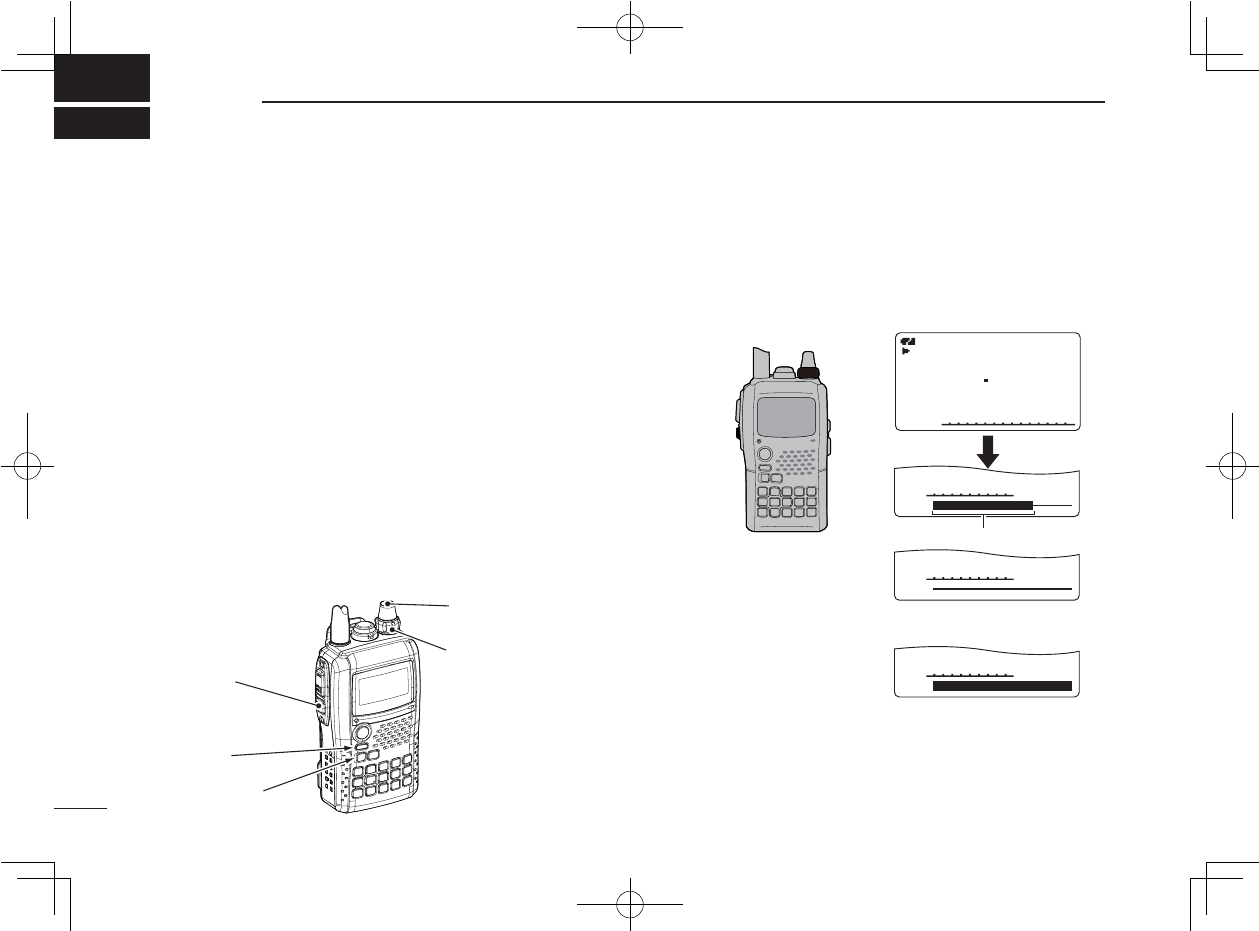
20
NeNew2001
BASIC OPERATION
5
■ Receiving
Make sure charged battery pack (BP-256) or brand new al-
kaline batteries (BP-257) are installed (pgs. 1, 12).
q Push and hold [PWR] for 1 sec. to turn power ON.
w Rotate [VOL] to set the desired audio level.
• The frequency display shows the volume level while setting.
See the section at right for details.
e Set the receiving frequency. (p. 18)
r Set the squelch level. (p. 21)
• While pushing and holding [SQL], rotate [DIAL].
• The fi rst click of [DIAL] indicates the current squelch level.
• “ LEVEL 1” is loose squelch (for weak signals) and “LEVEL 9” is
tight squelch (for strong signals).
• “ AUTO” indicates automatic level adjustment by a noise pulse
counting system.
• Push and hold [SQL] to open the squelch manually.
t When a signal is received:
• Squelch opens and audio is output.
• The S/RF-meter shows the relative signal strength level.
■ Setting audio volume
➥ Rotate [VOL]
to adjust the audio level.
• If squelch is closed, push and hold [SQL] to verify the audio
level.
• The display shows the volume level while setting.
q [PWR]
e Set frequency
r Set squelch level
w Set audio level
e Select band
r Push for setting
the squelch
(Push to monitor)
μ
000
000
VOL
VOL
μ
000
000
VOL
VOL
μ
000
000
VOL
VOL
A
MemoName
MemoName
μ
PRIO
PRIO WX
EMR
EMR
DTCS
DTCS
FM
LOW
LOW
ATT
ATT
14
145
000
PSKIP
PSKIP
PSKIP
PSKIP
+DUP
+DUP
25
25
000
000
Minimum setting
(no audio)
Volume level indicator
Maximum setting
[VOL]
[SQL]
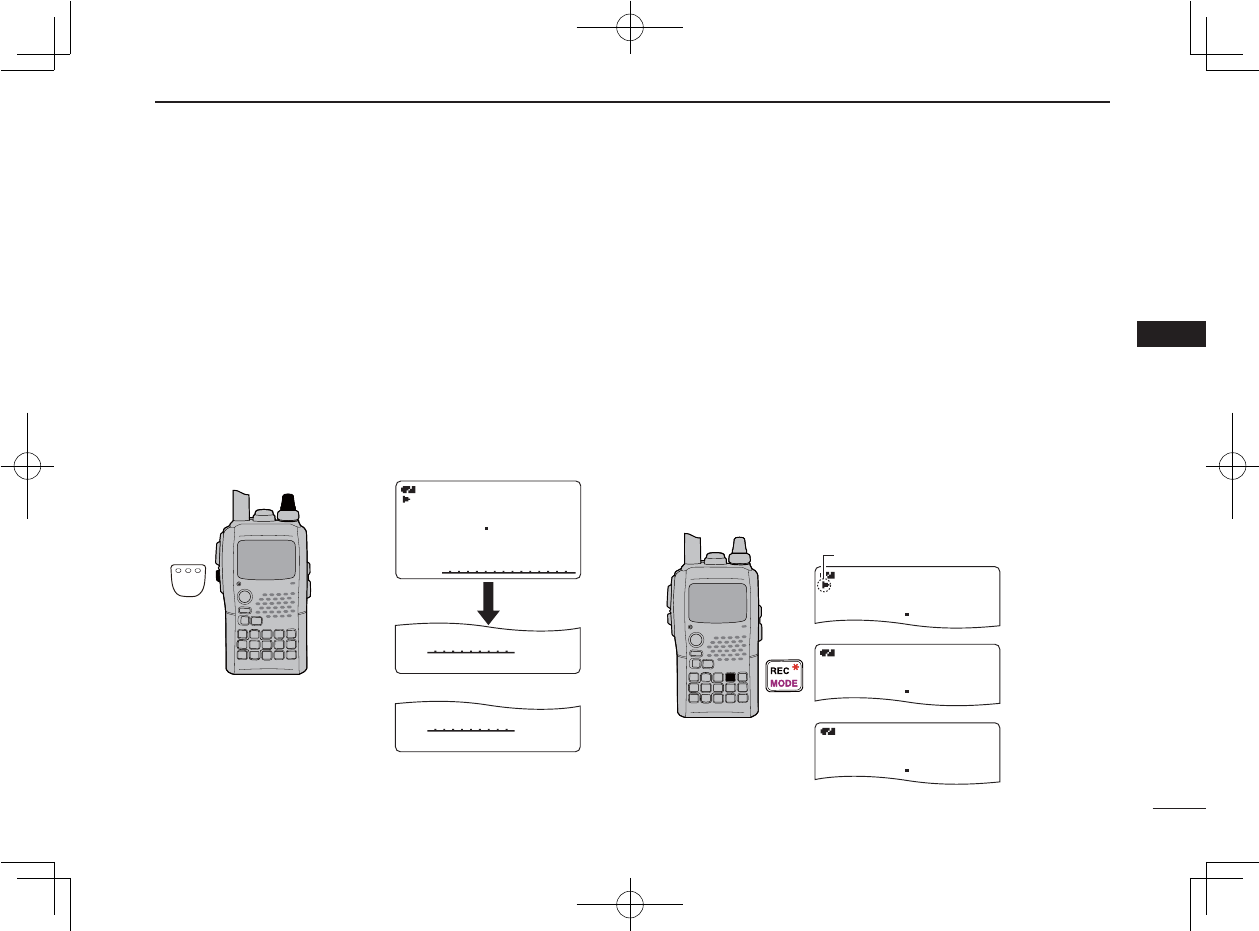
New2001
21
5
BASIC OPERATION
1
2
3
4
5
6
7
8
9
10
11
12
13
14
15
16
17
18
19
■ Setting squelch level
The squelch circuit mutes the received audio signal depend-
ing on the signal strength. The receiver has 9 squelch levels,
a continuously open setting and an automatic squelch set-
ting.
➥ While pushing and holding [SQL], rotate [DIAL] to select
the squelch level.
• “ LEVEL 1” is loose squelch (for weak signals) and “LEVEL 9” is
tight squelch (for strong signals).
• “ AUTO” indicates automatic level adjustment by a noise pulse
counting system.
• “OPEN” indicates continuously open setting.
■ Operating mode selection
Operating modes are determined by the modulation of the
radio signals. The transceiver has total 5 operating modes (A
band: FM, WFM and AM modes, B band FM, FM-N, AM and
DV modes). The mode selection is stored independently for
each band and memory channel.
Typically, AM mode is used for the AM broadcast stations
(0.495–1.620 MHz) and air band (118–136.995 MHz), and
WFM is used for FM broadcast stations (76–107.9 MHz).
WFM mode cannot be selected above 810 MHz for USA ver-
sion.
➥ Push and hold [MODE](REC) for 1 sec. several times to
select the desired operating mode.
[DIAL]
[SQL]
A
MemoName
MemoName
μ
PRIO
PRIO WX
EMR
EMR
DTCS
DTCS
FM
LOW
LOW
ATT
ATT
145000
PSKIP
PSKIP
+DUP
+DUP
25
25
000
000
SQUELCH:LEVEL9
SQUELCH:LEVEL9
μ
000
000
PSKIP
SQUELCH:AUTO
SQUELCH:AUTO
μ
000
000
PSKIP
Automatic squelch
Maximum level
A
FM
FM
145000
25
A
WFM
WFM
145000
25
25
A
AM
AM
145000
25
PSKIP
PSKIP
PSKIP
WFM mode
Indicates while selecting AUTO MODE.
AM mode
• Display example
REC
MODE
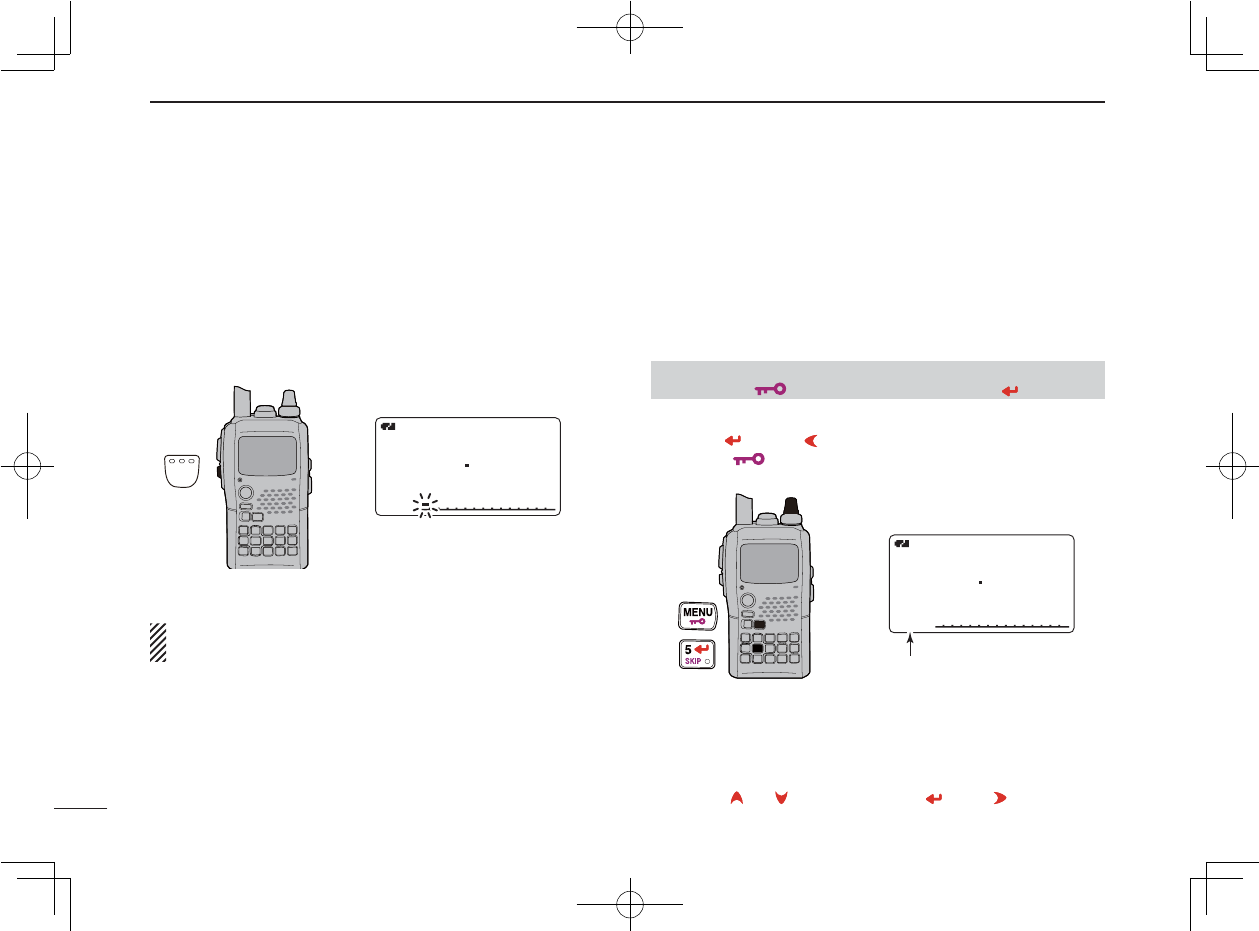
Ne
22
5BASIC OPERATION
New2001
■ Monitor function
This function is used to listen to weak signals without dis-
turbing the squelch setting or to open the squelch manually
even when mute functions such as the tone squelch are in
use.
➥ Push and hold [SQL] to monitor the operating frequency.
• The 1st segment of the S-meter blinks.
The [SQL] key can be set to ‘sticky’ operation in set mode.
See page 89 for details.
■ Attenuator function
The attenuator prevents a desired signal from distortion by
very strong signals near the desired frequency or when very
strong electric fi elds, such as from a broadcasting station, are
near your location. The attenuation is about 10 dB.
q Enter “ATTENUATOR” in set mode. (p. 88)
w Rotate [DIAL]† to select “ON” or “OFF.”
e Push [](5) (or [](4)) to return to set mode, and push
[MENU/ ] to return to frequency indication.
• “ATT” appears on the function display when “ON” is selected.
†[DIAL] ↔ [ ](2)/[](8) [ ](5) ↔ [ ](6)
[SQL]
A
MemoNameMemoName
μ
PRIOPRIO WXWX EMREMR
DTCSDTCS
FM
LOWLOW
ATTATT
146010
PSKIP
+DUP+DUP
2525
000000
The 1st segment blinks
MENU
5
SKIP
[DIAL]
A
MemoName
MemoName
μ
PRIO
PRIO
WX
WX
EMR
EMR
DTCS
DTCS
FM
FM
LOW
LOW
ATT
ATT
146010
PSKIP
+DUP
+DUP
25
25
000
000
Appears.
❮MENU screen❯ ➪ ❮SET MODE❯ ➪ ❮ATTENUATOR❯
(Push [MENU/ ]) (Rotate [DIAL]†, then push [ ](5)†.)
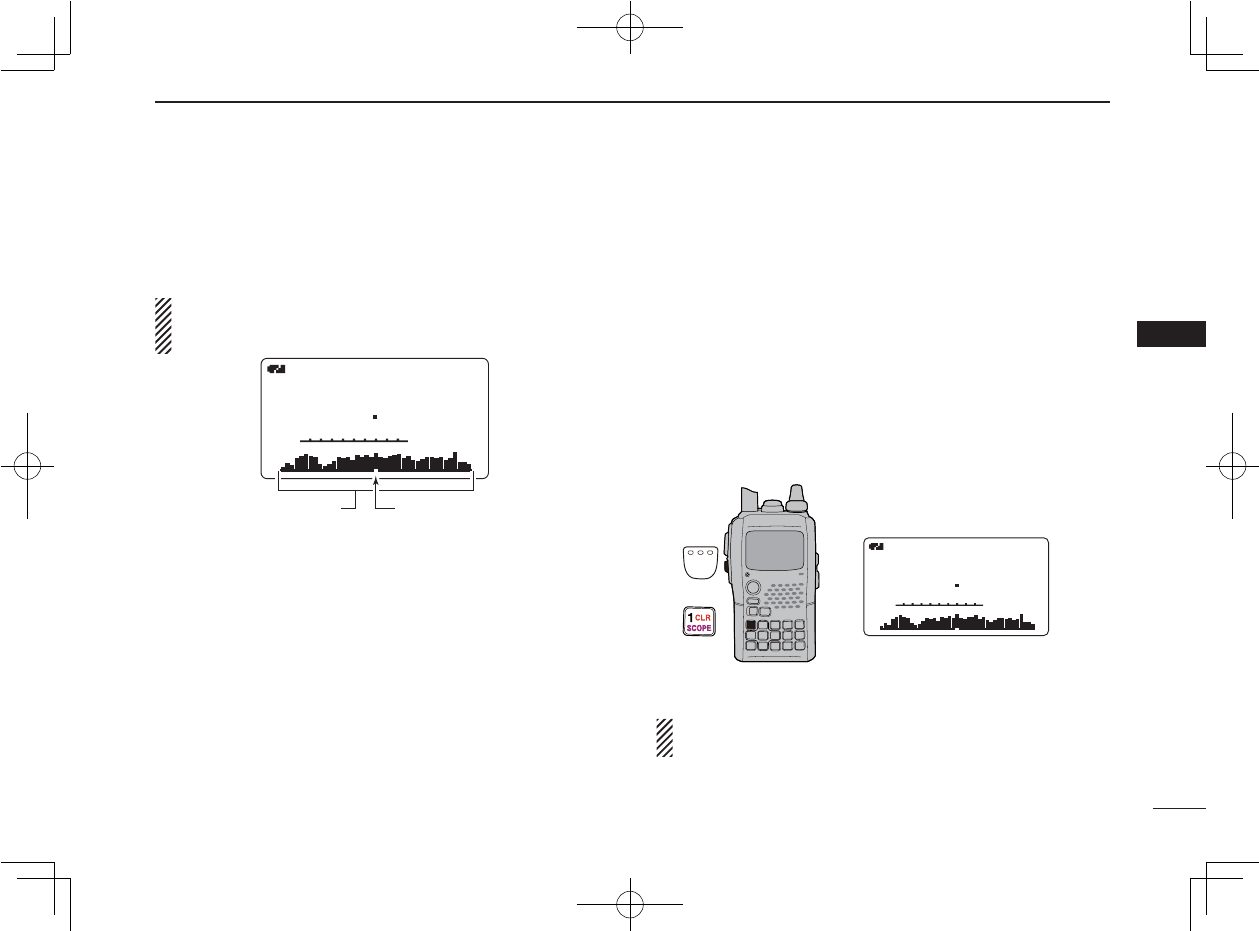
23
5
BASIC OPERATION
New2001
1
2
3
4
5
6
7
8
9
10
11
12
13
14
15
16
17
18
19
■ Band scope
The band scope function allows you to visually check a
specifi ed frequency range around the center frequency.
About the sweep steps: The specified tuning step in
each frequency band (in VFO mode) or programmed tuning
step (in memory mode) is used during sweep.
D Single sweep
q Set the desired frequency as band scope center fre-
quency.
w Push and hold [SCOPE](1) for 1 sec. to start a single
sweep.
• 1 short and 1 long beeps sound.
• Signal conditions (strengths) appear starting from the center of
the range.
e Rotate [DIAL] to set the highlighted cursor to the desired
signal and set the frequency of the signal.
r Push [VFO] to return to normal operation.
D Continuous sweep
q Set the desired frequency as band scope center fre-
quency.
w Push and hold [SCOPE](1) for 3 sec. to start continuous
sweep.
• 2 short beeps sound after 1 short and 1 long beeps.
• Signal conditions (strengths) appear starting from the center of
the range.
e Push and hold [SCOPE](1) for 1 sec. to cancel sweep.
• Pushing [SQL] also cancels sweep.
r Push [VFO] to return to normal operation.
The receive audio during sweeping can be muted in
sounds set mode. See p. 102 for details.
PRIO
PRIO WX
EMR
EMR
DTCS
DTCS
FM
FM
B
A
145780
P SKIP
P SKIP
+DUP
+DUP
25
μ
000
000
Sweep markerBand scope indication
1
SCOPE
CLR
[SQL]
PRIO
PRIO
WX
WX
EMR
EMR
DTCS
DTCS
FM
FM
B
A
145780
P SKIP
P SKIP
+DUP
+DUP
25
25
μ
000
000
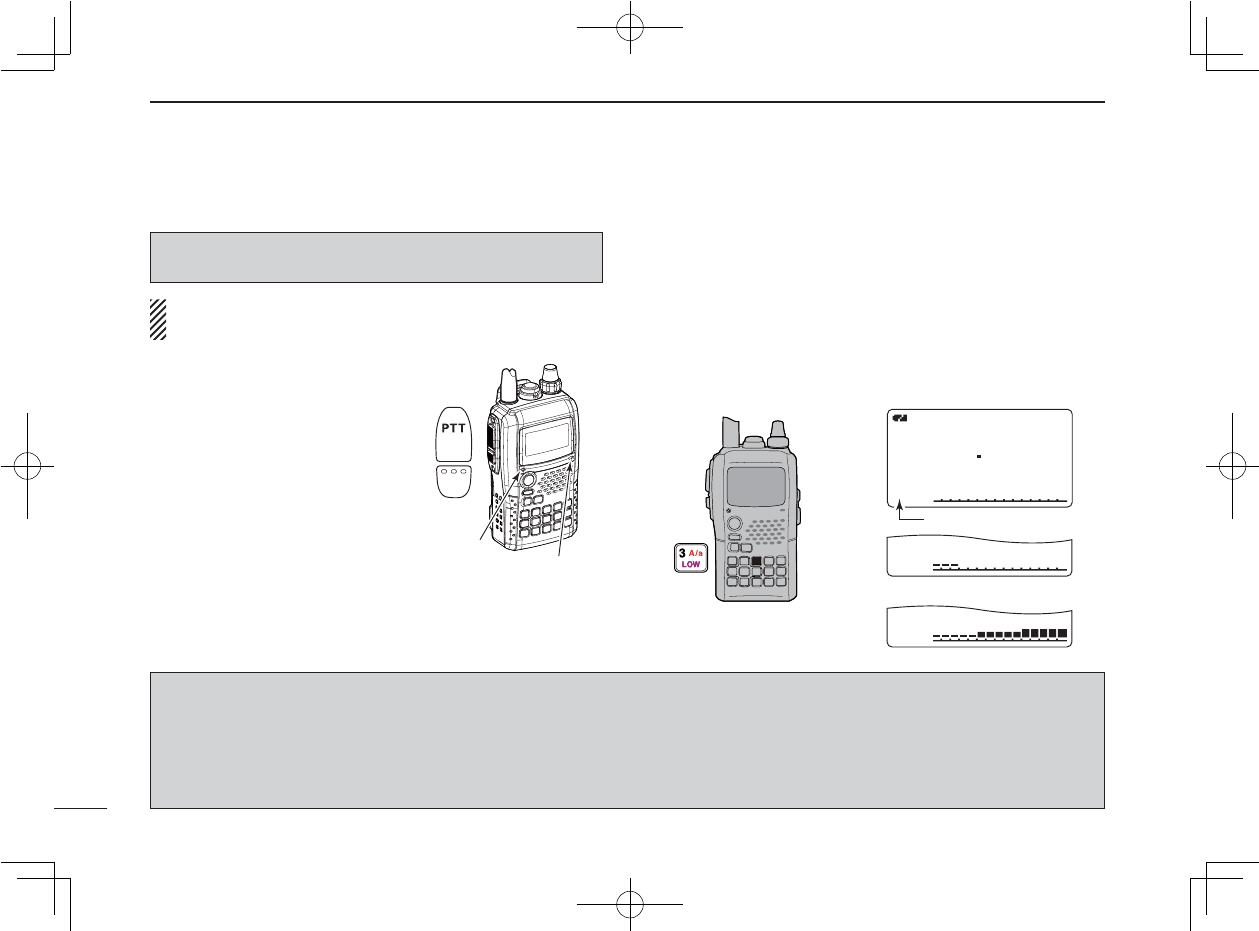
Ne
24
5BASIC OPERATION
New2001
■ Transmitting
✍ NOTE: To prevent interference, listen on the channel be-
fore transmitting by pushing and holding [SQL]
qSet the operating frequency.
(pgs. 18, 19)
• Transmission is available on the 144
MHz/440 MHz amateur bands only.
• Select output power if desired. See
the section at right for details.
w Push and hold [PTT] to transmit.
• Tx/Rx indicator lights red.
• S/RF meter shows the output
power level.
e Speak into the microphone
using your normal voice level.
• DO NOT hold the transceiver too close to your mouth or speak
too loudly. This may distort your speech.
r Release [PTT] to return to receive.
■ Transmit power selection
The transceiver has two output power levels to suit your op-
erating requirements. Low output power during short-range
communications may reduce the possibility of interference to
other stations and will reduce current consumption.
➥
Push and hold [LOW](3) for 1 sec. to toggle the transmit
output power between High and Low.
• “LOW” appears when the low power is selected.
WARNING! NEVER continuously transmit the transceiver for long periods of time. When the transceiver is used for continuous
prolonged transmission at high power, the transceiver radiates heat to protect itself from overheating and transceiver’s chassis
will become hot. This may cause a burn.
AVOID operating the transceiver in a situation that will obstruct heat dissipation, especially if the transceiver is operated with
an external power supply. Heat dissipation may be affected, and it may cause a burn, warp the casing or damage the trans-
ceiver.
Tx/Rx
Microphone
indicator
[SQL]
3
LOW
A/a
A
MemoName
MemoName
μ
PRIO
PRIO
WX
WX
EMR
EMR
DTCS
DTCS
FM
FM
LOW
LOW
LOW
LOW
LOW
LOW
ATT
ATT
146010
PSKIP
+DUP
+DUP
25
25
000
000
Appears
Low power transmission
High power transmission
CAUTION:- Transmitting without an antenna will damage
the transceiver.
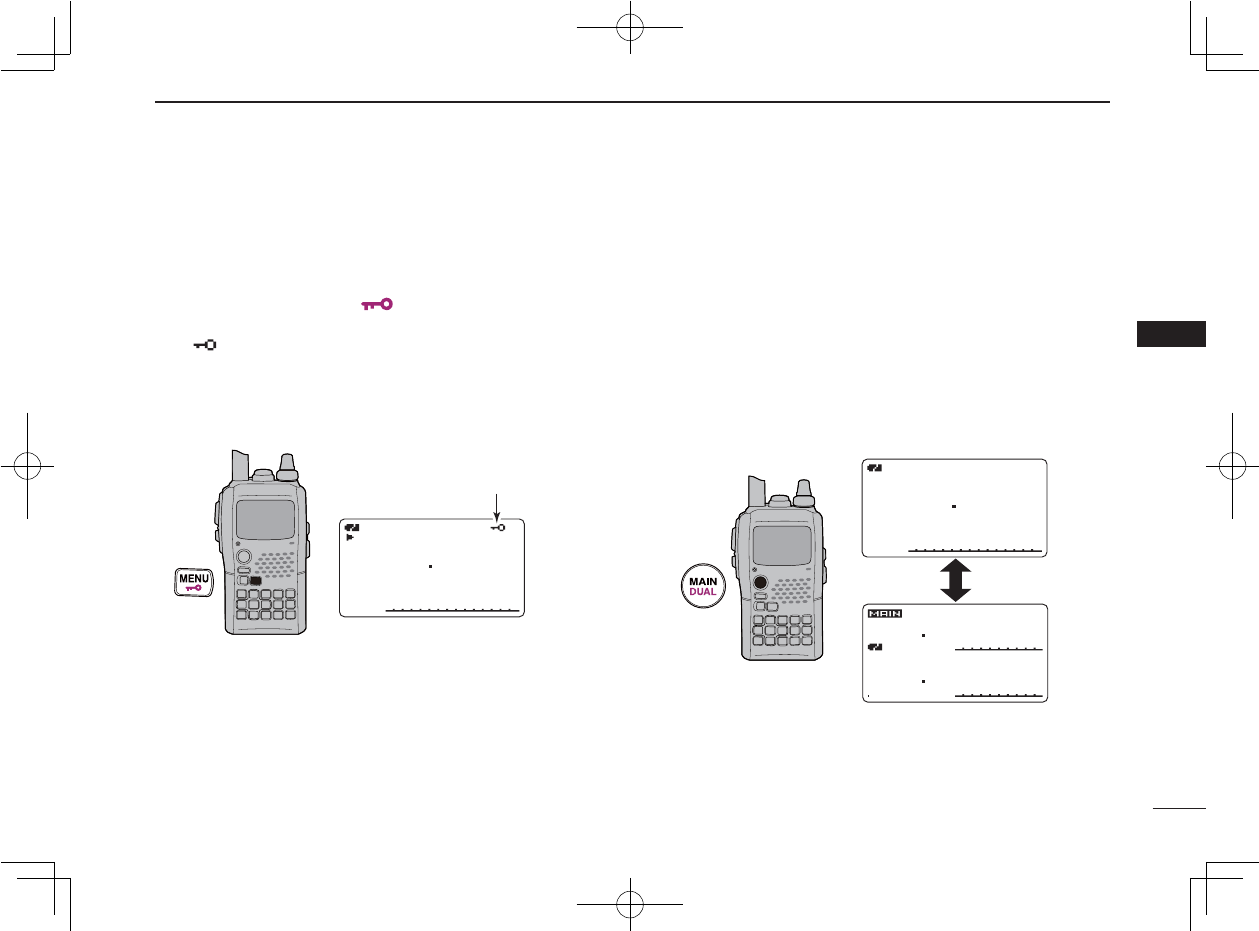
25
5
BASIC OPERATION
New2001
1
2
3
4
5
6
7
8
9
10
11
12
13
14
15
16
17
18
19
■ Lock function
To prevent accidental frequency changes and unnecessary
function access, use the lock function.
➥ Push and hold [MENU/ ] for 1 sec. to turn the lock
function ON and OFF.
• “ ” appears while the lock function is activated.
• The squelch control and volume control can be used while the
lock function is in use with default setting. Either or both the
squelch control and volume control can also be locked in set
mode. (p. 90)
■ Dualwatch operation
Dualwatch operation monitors two frequencies simultane-
ously. The IC-92A/92AD has two independent receiver
circuits as A band and B band (available frequency bands and
operating mode are different depending on bands).
D Dualwatch operation
➥ Push and hold [MAIN/DUAL] for 1 sec. to turn the dual-
watch operation ON and OFF.
• While in dualwatch operation, the display indicates A band in
the upper half and B band in the lower half.
MENU
A
MemoName
MemoName
μ
PRIO
PRIO
WX
WX
EMR
EMR
DTCS
DTCS
FM
FM
LOW
LOW
ATT
ATT
145000
PSKIP
PSKIP
+DUP
+DUP
25
25
000
000
Appears
MAIN
DUAL
DTCS
DTCS
DTCS
DTCS
W
PS
PS
EM
EM
W
PS
PS
FM
PRIO
PRIO
PRIO
PRIO
+DUP
+DUP
+DUP
+DUP
FM
FM
146010
44
440000
25
25
50
50
μ
000
000
μ
000
000
A
MemoName
MemoName
μ
PRIO
PRIO
WX
WX
EMR
EMR
DTCS
DTCS
FM
LOW
LOW
ATT
ATT
146010
P
SKIP
SKIP
+DUP
+DUP
25
000
000
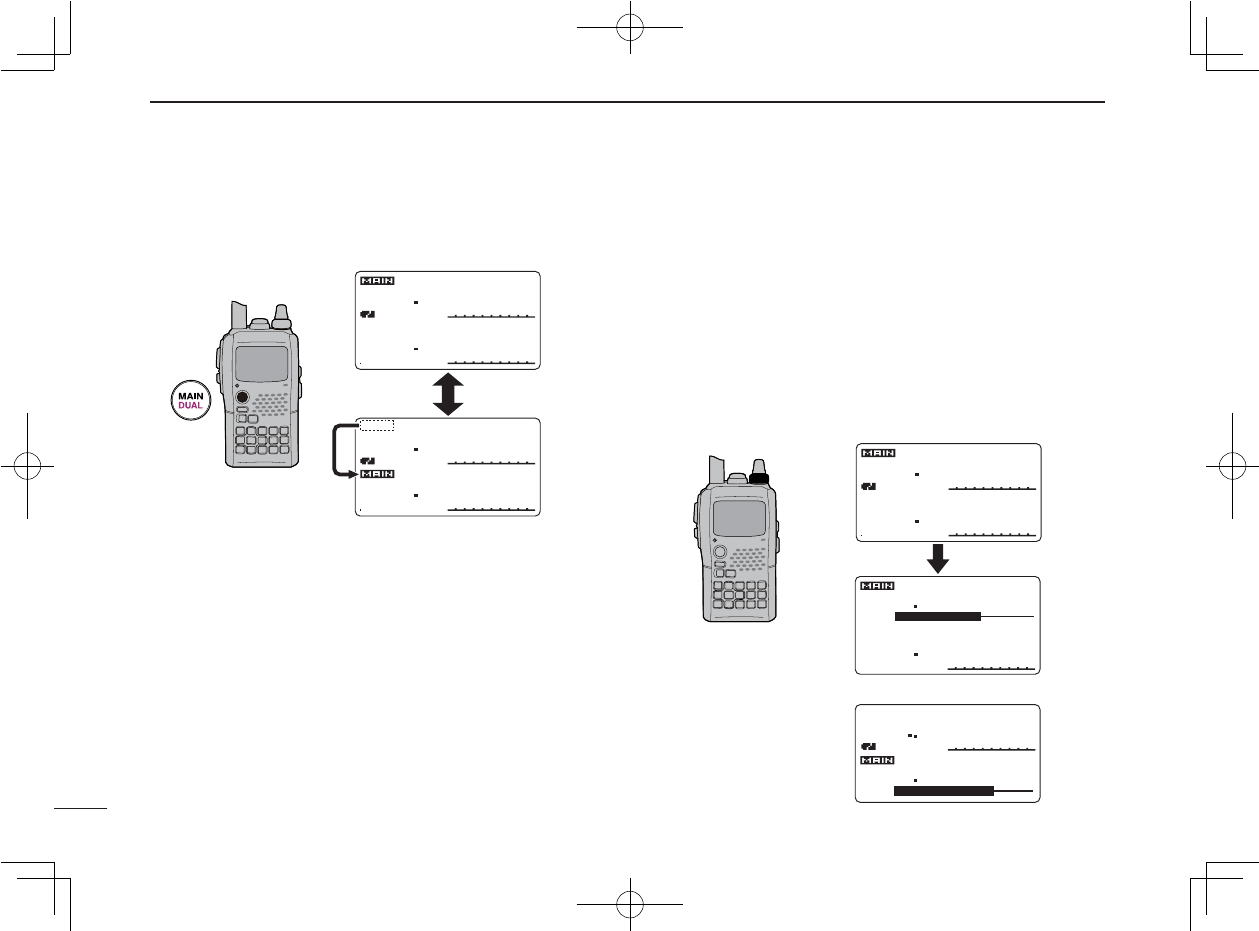
Ne
26
5BASIC OPERATION
New2001
D Main band selection
➥ Push [MAIN/DUAL] to select A band or B band as the
main operating band alternately.
D Setting audio volume
The audio level for dualwatch operation can be adjusted
both on A band and B band simultaneously (default).
This setting can be set separately for each band in sounds
set mode.
q Push and hold [MAIN/DUAL] for 1 sec. to enter the dual-
watch operation, if necessary.
w Rotate
[VOL] to adjust the audio level for the main band.
• If squelch is closed, push and hold [SQL] to verify the audio
level.
• The display shows the volume level while setting.
MAIN
DUAL
DTCS
DTCS
DTCS
DTCS
W
PS
PS
EM
EM
W
PS
PS
FM
PRIO
PRIO
PRIO
PRIO
+DUP
+DUP
+DUP
+DUP
FM
FM
146010
440000
μ
000
000
μ
000
000
DTCS
DTCS
DTCS
DTCS
W
PS
PS
EM
EM
W
PS
PS
FM
PRIO
PRIO
PRIO
PRIO
+DUP
+DUP
+DUP
+DUP
FM
FM
14
146
010
440000
μ
000
000
μ
000
000
DTCS
DTCS
DTCS
DTCS
W
PS
PS
EM
EM
W
PS
PS
FM
PRIO
PRIO
PRIO
PRIO
+DUP
+DUP
+DUP
+DUP
FM
FM
146
010
010
440000
μ
000
000
μ
000
000
DTCS
DTCS
DTCS
DTCS
W
PS
EM
EM
W
PS
PRIO
PRIO
PRIO
PRIO
+DUP
+DUP
+DUP
+DUP
25
75
μ
000
000
μ
000
000
146
010
010
DTCS
DTCS
DTCS
DTCS
W
EM
EM
W
PS
PRIO
PRIO
PRIO
PRIO
+DUP
+DUP
+DUP
+DUP
25
75
μ
000
000
μ
000
000
440000
FM
FM
440000
PS
PS
FM
146010
VOL
VOL
VOL
VOL
[VOL]
Setting for A band (upper side)
Setting for B band (lower side)
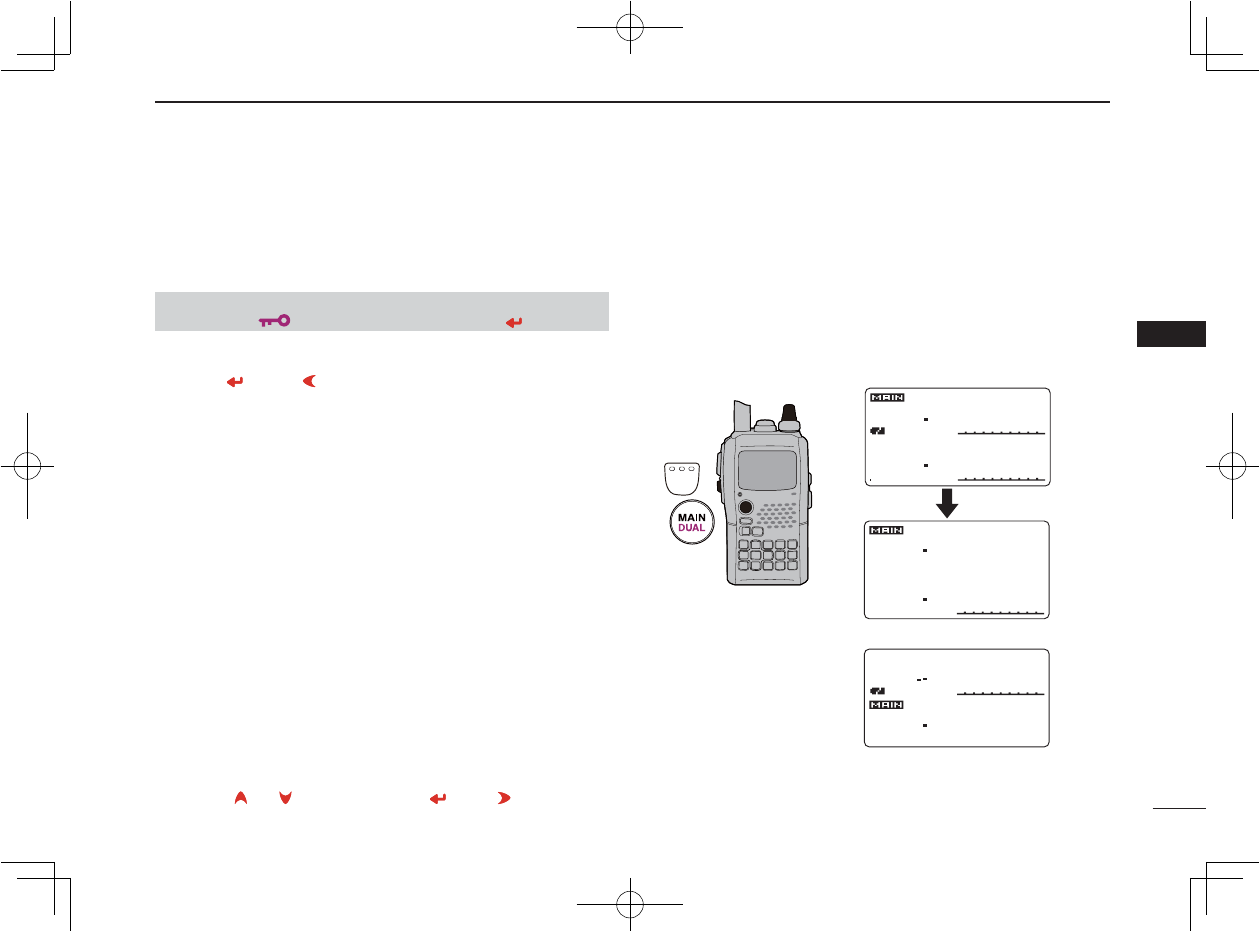
27
5
BASIC OPERATION
New2001
1
2
3
4
5
6
7
8
9
10
11
12
13
14
15
16
17
18
19
D Volume setting for dualwatch
The volume setting for dualwatch can be set for both bands
simultaneously or for each band separately in set mode.
q Enter “VOLUME SELECT” in sounds set mode. (p. 102)
w Rotate [DIAL]† to select “BOTH” or “SEPARATE.”
e Push [](5) (or [ ](4)) to return to sounds set mode, and
push [MENU/LOCK] to return to frequency indication.
D Setting squelch level
q Push and hold [MAIN/DUAL] for 1 sec. to enter the dual-
watch operation, if necessary
w While pushing and holding [SQL], rotate [DIAL] to adjust
the main band’s squelch level.
• “LEVEL 1” is loose squelch and “LEVEL 9” is tight squelch.
• “ AUTO” indicates automatic level adjustment with a noise pulse
count system.
• “OPEN” indicates continuously open setting.
†[DIAL] ↔ [ ](2)/[](8) [ ](5) ↔ [ ](6)
[DIAL]
MAIN
DUAL
[SQL]
DTCS
DTCS
DTCS
DTCS
W
PS
EM
EM
W
PS
PRIO
PRIO
PRIO
PRIO
+DUP
+DUP
+DUP
+DUP
25
75
μ
000
000
μ
000
000
SQUELCH:AUTO
SQUELCH:AUTO
146
010
010
DTCS
DTCS
DTCS
DTCS
W
EM
EM
W
PS
PRIO
PRIO
PRIO
PRIO
+DUP
+DUP
+DUP
+DUP
25
75
μ
000
000
μ
000
000
SQUELCH:LEVEL6
SQUELCH:LEVEL6
440000
FM
FM
440000
PS
PS
FM
146010
DTCS
DTCS
DTCS
DTCS
W
PS
PS
EM
EM
W
PS
PS
FM
PRIO
PRIO
PRIO
PRIO
+DUP
+DUP
+DUP
+DUP
FM
FM
146010
440000
μ
000
000
μ
000
000
Setting for A band (Upper)
Setting for B band (Lower)
❮MENU screen❯ ➪ ❮SOUNDS❯ ➪ ❮VOLUME SELECT❯
(Push [MENU/ ]) (Rotate [DIAL]†, then push [ ](5)†.)
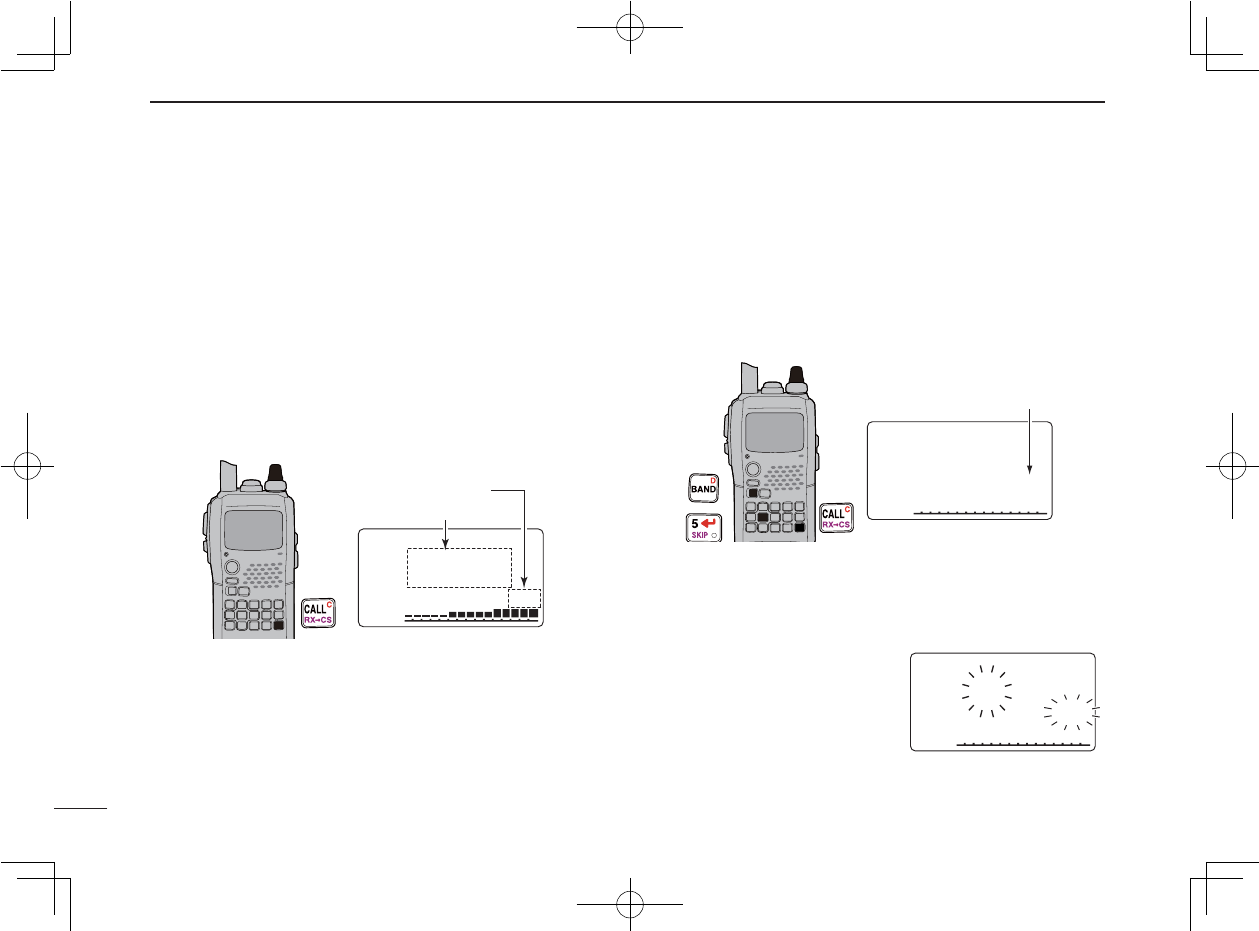
28
5BASIC OPERATION
New2001
■ TV channel operation
TV channel operation is available only when TV channels
are programmed using the optional RS-91. (p. 122) Also
available for A band operation only.
D TV channel receiving
q Push [CALL] several times to select TV channels.
• “ TV” and channel number appear.
w Rotate [DIAL] to select the desired channel.
• While pushing and holding [BAND], rotating [DIAL] selects the
all channels including skip channel.
D Skip channel setting
Unwanted channels can be skipped for rapid selection, etc.
q Push [CALL] several times to select TV channels.
• “TV” and channel number appear.
w Rotate [DIAL] to select the channel to be skipped.
• To clear the skip setting, rotate [DIAL] while pushing and hold-
ing [BAND] to select a skip channel.
e Push and hold [SKIP](5) for 1 sec. to toggle the skip set-
ting ON and OFF.
• “SKIP” appears when the channel is set as skip channel.
D Automatic TV channel programming
TV channels can be programmed automatically.
q Push [CALL] several times
to select TV channels.
• “ TV” and channel number ap-
pear.
w Push [SCAN](2) to start TV
channel programming.
• The programming will automatically stop after scanning all
channels.
[DIAL]
CALL
RX
CS
C
TVTV
A
MemoNameMemoName
μ
PRIOPRIO WXWX EMREMR
DTCSDTCS
WFM
LOWLOW
ATTATT
10
CHCH
PSKIP
+DUP+DUP
2525
TV mode indication
Channel indication
[DIAL]
BAND
D
5
SKIP
CALL
RX
CS
C
TVTV
A
Mem oNameMemoName
µ
PRIOPRIOWXWXEMREM R
DTCSDTCS
WFMWFM
LOWLO W
AT TATT
12 ch
PSKIP
+DUP+DU P
2525
Appears
TV
TV
A
Mem oName
MemoName
µ
PRIO
PRIO
WX
WX
EMR
EM R
DTCS
DTCS
WFM
WFM
LOW
LO W
AT T
ATT
2ch
PSKIP
+DUP
+DUP
25
25
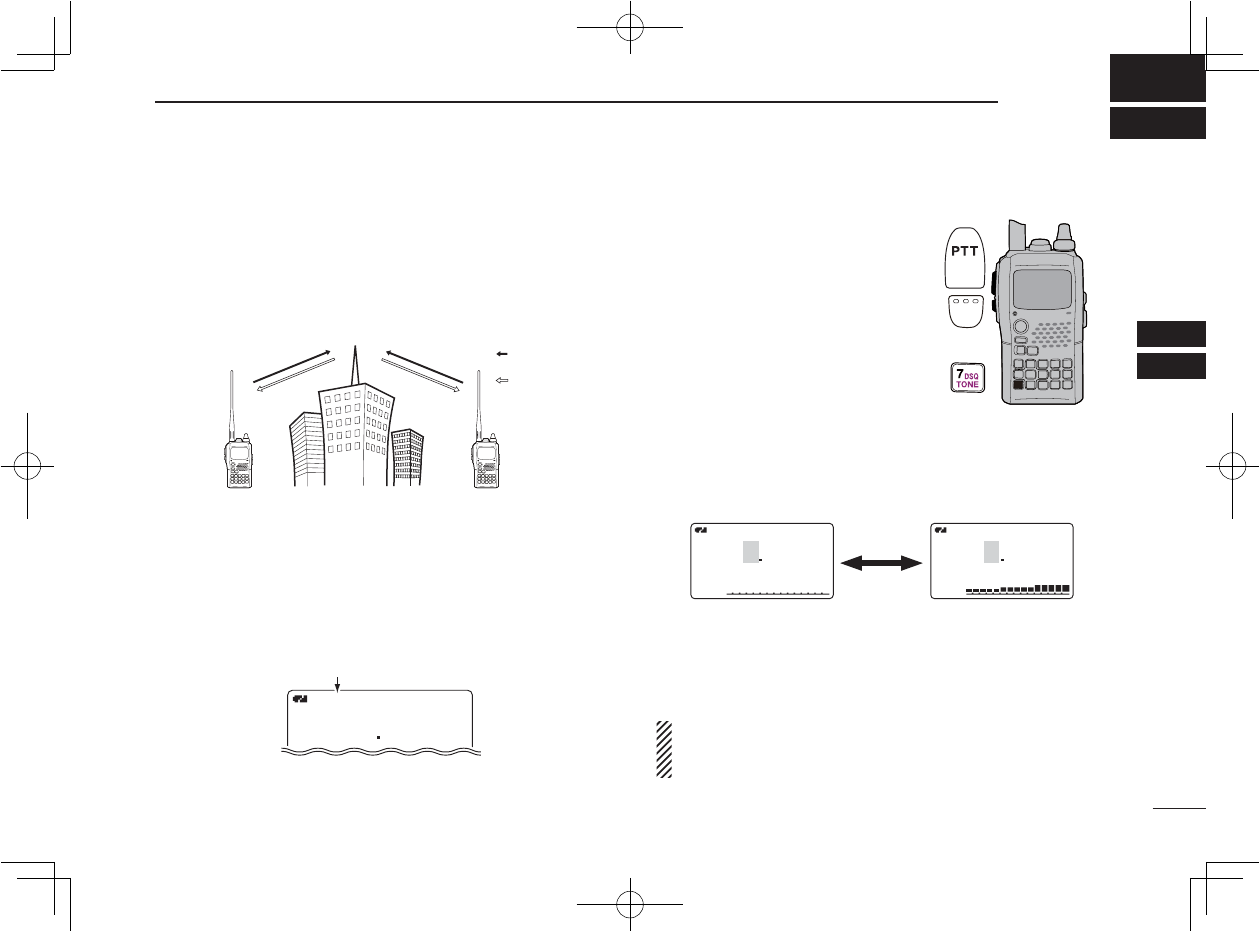
29
6
REPEATER AND DUPLEX OPERATIONS
1
2
3
4
5
6
7
8
9
10
11
12
13
14
15
16
17
18
19
■ Repeater operation
When using a repeater, the transmit frequency is shifted
from the receive frequency by the offset frequency. (p. 97) It
is convenient to program repeater information into memory
channels. (p. 66)
q Set the receive frequency (repeater output frequency).
w Set the shift direction of the transmit frequency. (–DUP or
+DUP; see p. 31 for details.)
• When the auto repeater function is in use (U.S.A. and Korean
versions only), this selection and step e are not necessary.
(p. 32)
e Push and hold [TONE](7) for 1
sec. to activate the subaudible
tone encoder, according to re-
peater requirements.
•-“TONE” appears.
Refer to p. 107 for tone frequency
settings.
r Push and hold [PTT] to transmit.
•- The displayed frequency automati-
cally changes to the transmit frequency (repeater input fre-
quency).
•- If “OFF” appears, check the offset frequency or shift direction.
(p. 30)
t Release [PTT] to receive.
y Push and hold [SQL] to check whether the other station’s
transmit signal can be directly received or not.
U.S.A. and Korean versions:
Auto repeater function uses standard values of the re-
peater tone frequency and offset frequency.
Station A Station B
Repeater
145.300 MHz
144.700 MHz 144.700 MHz
145.300 MHz
Uplink
Downlink
(transmitting freq.)
(receiving freq.)
A
TONE
TONE
FM
145300
-DUP
-DUP
“–DUP”or “+DUP” appears.
7
TONE
DSQ
[SQL]
While receiving While transmitting
A
A
TONE
TONE
FM
PSKI
PSKIP
-DUP
A
TONE
FM
144700
PSKIP
-DUP
145300
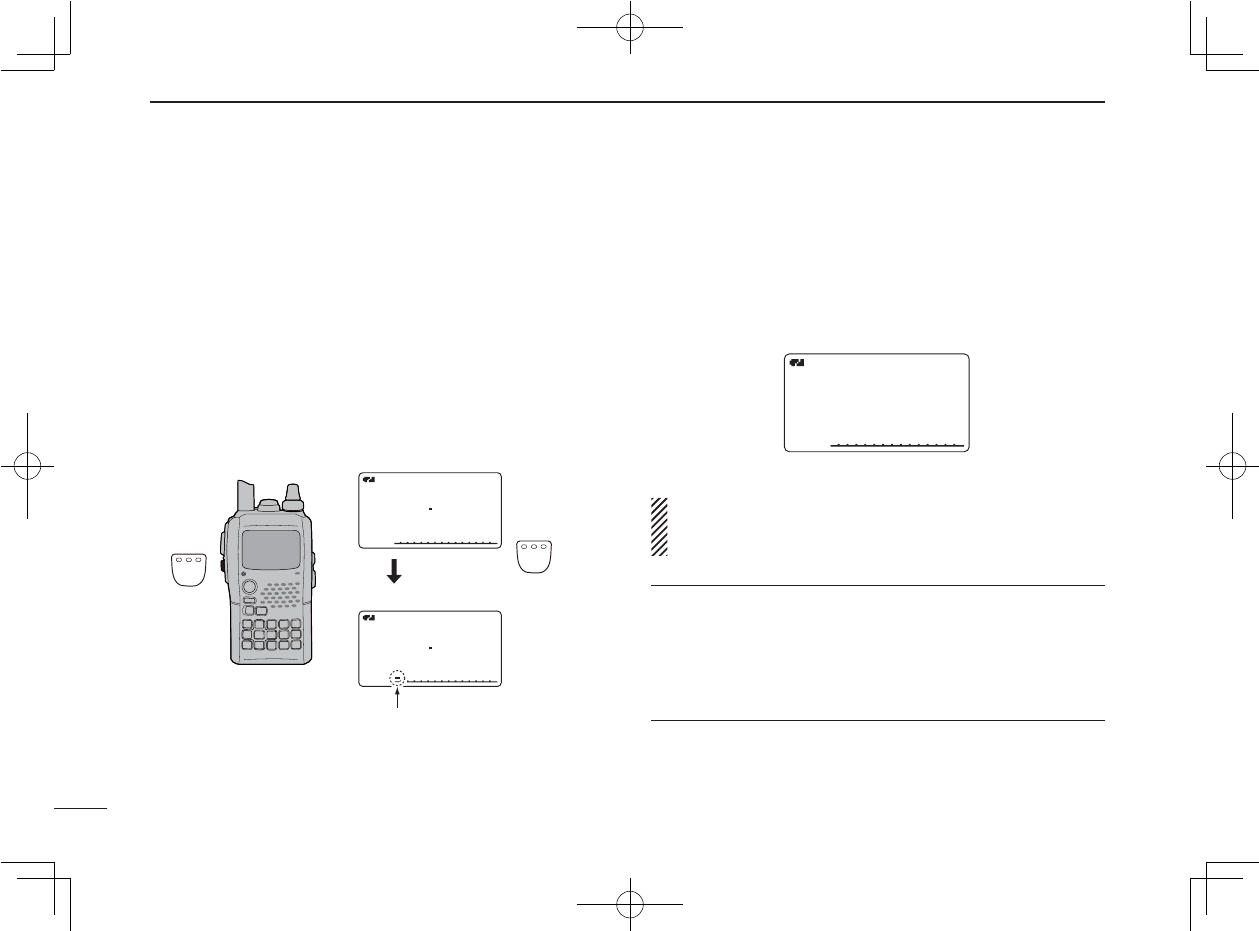
Ne
30
6REPEATER AND DUPLEX OPERATIONS
New2001
D Checking the repeater input signal
The transceiver can check whether the other station’s trans-
mit signal can be received directly or not, by listening on the
repeater input frequency.
➥ Push and hold [SQL] to check whether the other station’s
transmit signal can be directly received or not.
• When the other station’s signal can be directly received, move
to a non-repeater frequency to use simplex. (duplex OFF)
D Off band indication
If the transmit frequency is out of the amateur band, the off
band indication, “OFF,” appears on the display when [PTT]
is pushed. Check the offset frequency or duplex direction in
this case. (p. 31)
U.S.A. and Korean versions:
Auto repeater function uses standard values of the offset
frequency.
✔-CONVENIENT!
Tone scan function: When you don’t know the subaudible
tone used for a repeater, the tone scan is convenient for de-
tecting the tone frequency.
➥ Push and hold [T.SCAN](.) for 1 sec. to start the tone
scan. See p. 112 for more information.
Indication while receiving.
Receives –0.6 MHz shift frequency.
Blinks while pushing and holding [SQL].
A
TONE
TONE
FM
145300
145300
PSKI
PSKIP
-DUP
-DUP
A
TONE
FM
144700
PSKIP
-DUP
Push and hold
[SQL]
[SQL]
A
OFF
OFF
TONE
TONE
FM
PSKI
PSKIP
-DUP
-DUP
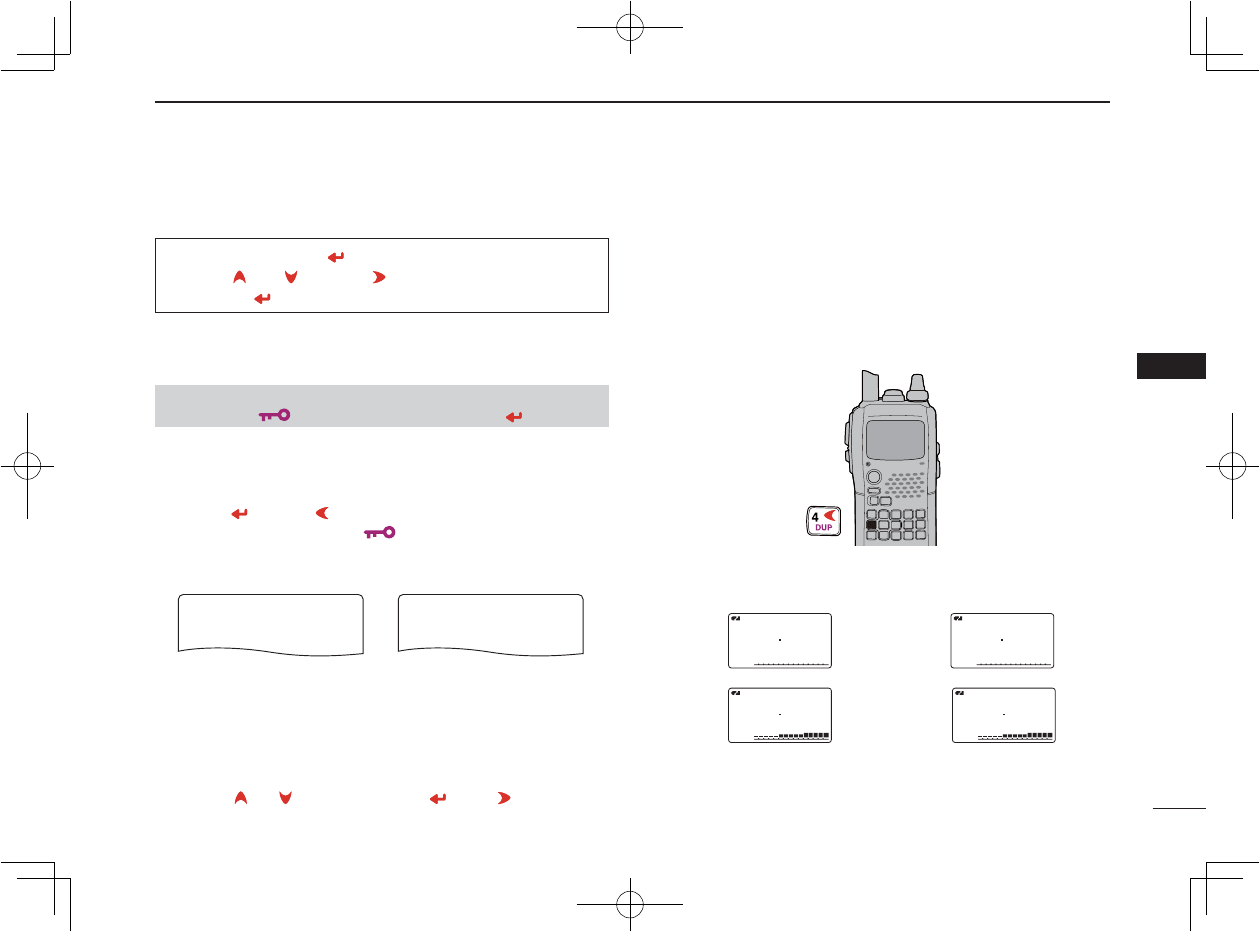
31
6
REPEATER AND DUPLEX OPERATIONS
New2001
1
2
3
4
5
6
7
8
9
10
11
12
13
14
15
16
17
18
19
■ Duplex operation
Although [DIAL] and [ ](5) are used for description in this
section, [](2)/[](8) and [](6) are available instead of
[DIAL] and [](5).
D Setting offset frequency
q Enter “OFFSET FREQ” in DUP/TONE… set mode. (p. 97)
w Rotate [DIAL]† to set offset frequency.
• 1 MHz and 10 MHz tuning steps are available by pushing and
holding [MHz](VFO) for 1 sec.: push [MHz](VFO) to cancel it.
e Push [](5) (or [](4)) to return to DUP/TONE… set
mode, and push [MENU/ ] to return to frequency indi-
cation.
D Setting duplex direction
➥ Push and hold [DUP](4) for 1 sec. to select “–DUP” or
“+DUP”.
• “–DUP” or “+DUP” indicates the transmit frequency for minus
shift or plus shift, respectively.
• When offset frequency is 0.6 MHz.
U.S.A. and Korean versions:
Auto repeater function has priority over the manual duplex
setting. If the frequency changes after setting, the auto re-
peater function may have changed the duplex setting.
†[DIAL] ↔ [ ](2)/[](8) [ ](5) ↔ [ ](6)
5.0 MHz offset
No offset frequency
5.000.00
5.000.00
OFFSET FREQ
OFFSET FREQ
0.000.00
0.000.00
OFFSET FREQ
OFFSET FREQ
4
DUP
–Duplex example +Duplex example
Receiving
Transmitting
A
TONE
TONE
FM
FM
145300
145300
PSKI
PSKIP
-DUP
-DUP
A
TONE
TONE
FM
FM
144700
144700
PSKI
PSKIP
-DUP
-DUP
Receiving
Transmitting
A
TONE
TONE
FM
145300
145300
PSKI
PSKIP
+DUP
+DUP
A
TONE
TONE
FM
FM
145900
145900
PSKI
PSKIP
+DUP
+DU P
❮MENU screen❯ ➪ ❮DUP/TONE…❯ ➪ ❮OFFSET FREQ❯
(Push [MENU/ ]) (Rotate [DIAL]†, then push [ ](5)†.)
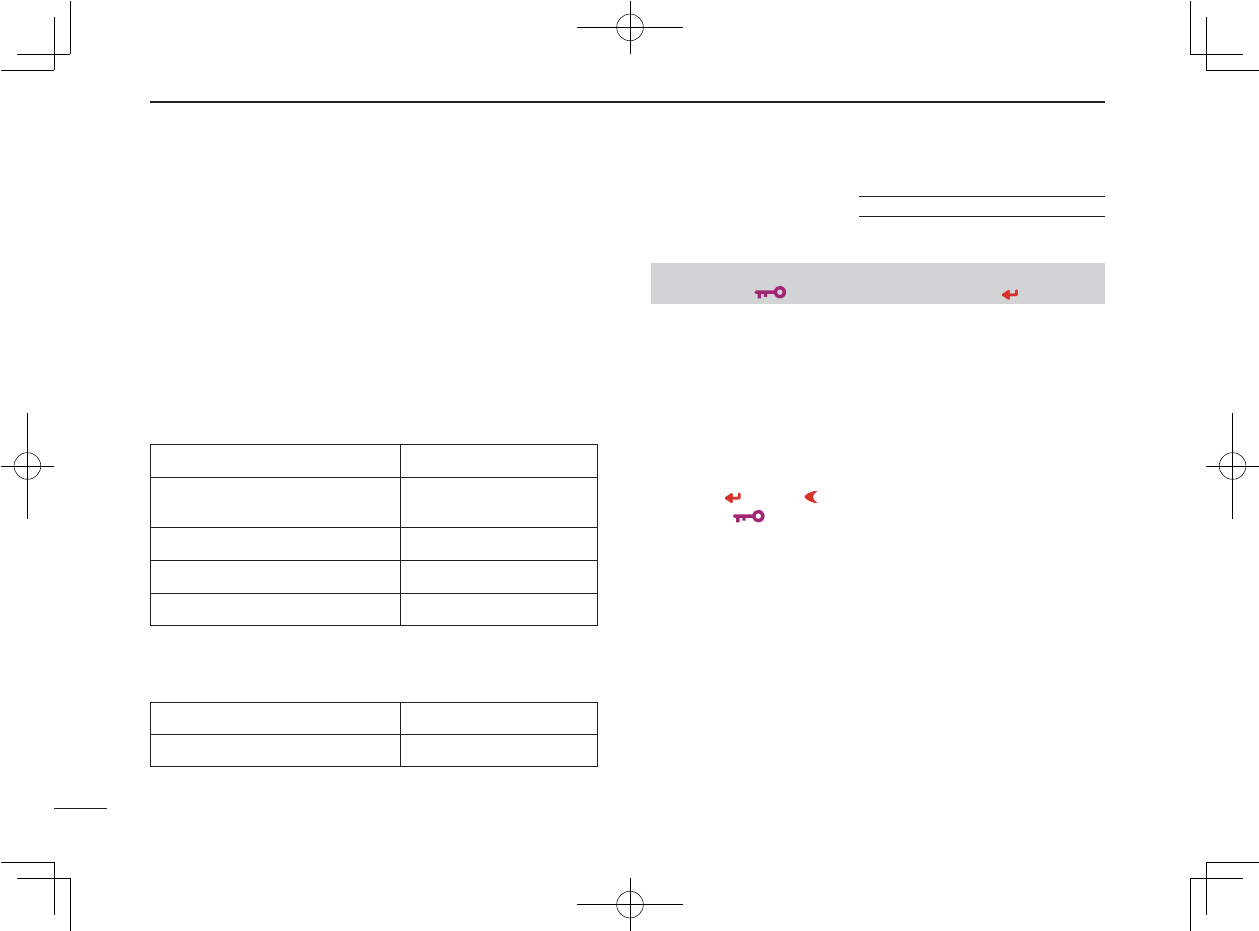
Ne
32
6REPEATER AND DUPLEX OPERATIONS
New2001
■ Auto repeater function
The U.S.A. and Korean versions automatically use standard
repeater settings (duplex ON/OFF, duplex direction, tone encoder
ON/OFF) when the operating frequency falls within or outside
of the general repeater output frequency range. The offset
and repeater tone frequencies are not changed by the auto
repeater function, reset these frequencies, if necessary.
D Frequency range and offset direction
• U.S.A. version
• Korean version
q Enter “AUTO RPT” in set mode. (p. 89)
w Rotate [DIAL]† to select the auto repeater setting.
[U.S.A. version]:
• “RPT1” : Activates duplex only. (default)
• “RPT2” : Activates duplex and tone.
• “OFF” : Auto repeater function is turned OFF.
[Korean version]:
• “ON” : Activates duplex and tone. (default)
• “OFF” : Auto repeater function is turned OFF.
e Push [](5) (or [](4)) to return to set mode, and push
[MENU/ ] to return to frequency indication.
FREQUENCY RANGE SHIFT DIRECTION
147.000–147.395 MHz “+DUP” appears
442.000–444.995 MHz “+DUP” appears
447.000–449.995 MHz “–DUP” appears
145.200–145.495 MHz
146.610–146.995 MHz “–DUP” appears
FREQUENCY RANGE SHIFT DIRECTION
439.000–440.000 MHz “–DUP” appears
❮MENU screen❯ ➪ ❮SET MODE❯ ➪ ❮AUTO RPT❯
(Push [MENU/ ]) (Rotate [DIAL]†, then push [ ](5)†.)
U.S.A./KOREAN versions only
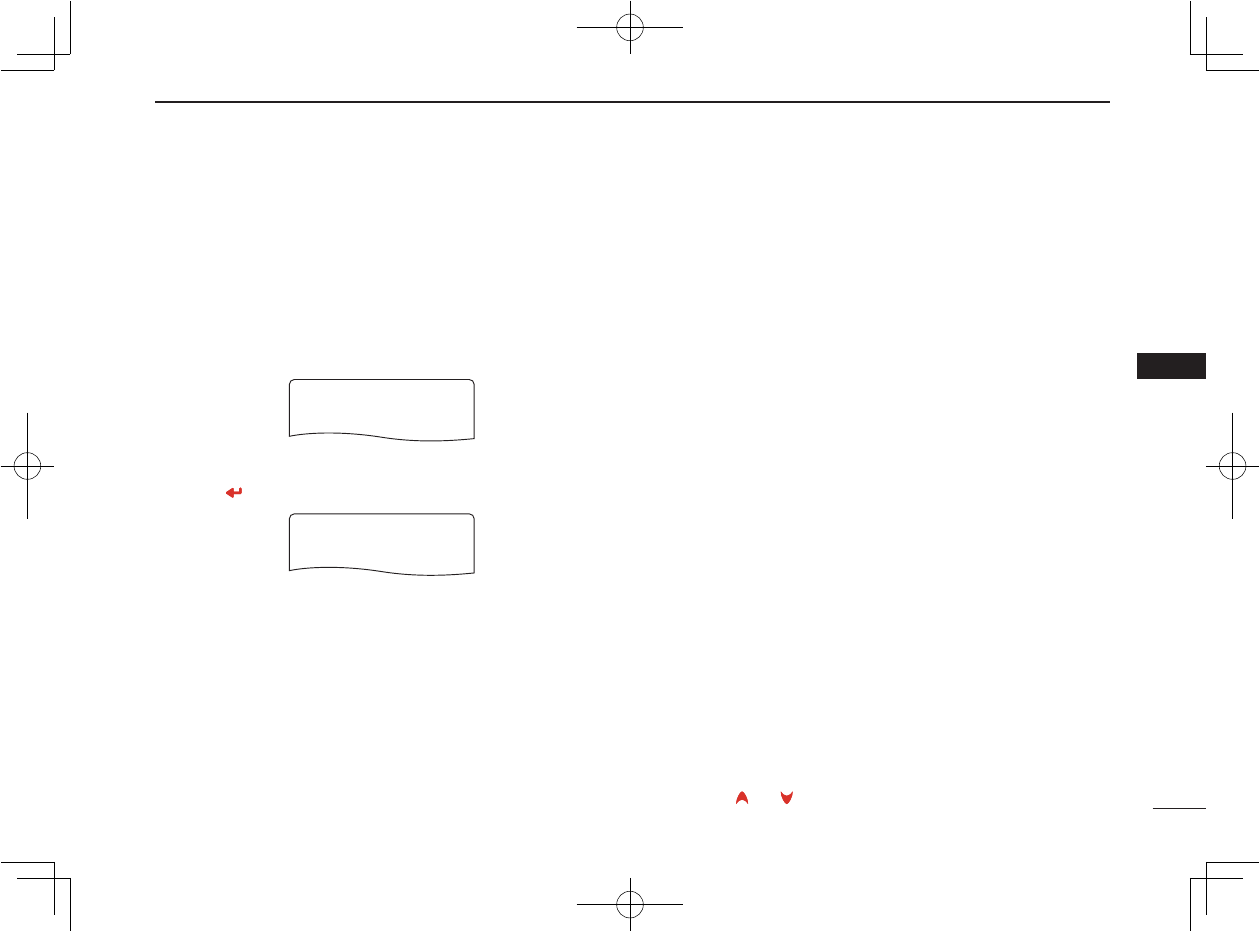
33
6
REPEATER AND DUPLEX OPERATIONS
New2001
1
2
3
4
5
6
7
8
9
10
11
12
13
14
15
16
17
18
19
■ 1750 Hz tone
Some European repeaters require a 1750 Hz tone burst to
be accessed. For such European repeaters, perform the fol-
lowing.
• This tone can be use as a ‘Call signal’ in countries out of Europe.
q Push and hold [DTMF.M](.) for 1 sec. to select DTMF
memory.
w Rotate [DIAL]† counter-clockwise until “T-CALL” appears.
e Push [](5) to set.
r Push [VFO] to exit DTMF memory.
t Set the receive frequency (repeater output frequency).
y Set the shift direction of the transmit frequency. (–DUP or
+DUP; see p. 31 for details.)
u While pushing [PTT], push [SQL] to transmit a 1750 Hz
tone burst signal.
• If “OFF” appears, check the offset frequency or shift direction.
(p. 97)
• The displayed frequency automatically changes to the transmit
frequency (repeater input frequency).
i Push and hold [PTT] to transmit.
o Release [PTT] to receive.
!0 Push and hold [SQL] to check whether the other station’s
transmit signal can be received directly or not, by listening
on the repeater input frequency.
†[DIAL] ↔ [ ](2)/[ ](8)
r
Ch01
DTMF MEMORY
DTMF MEMORY
r
T-CALL
DTMF MEMORY
DTMF MEMORY
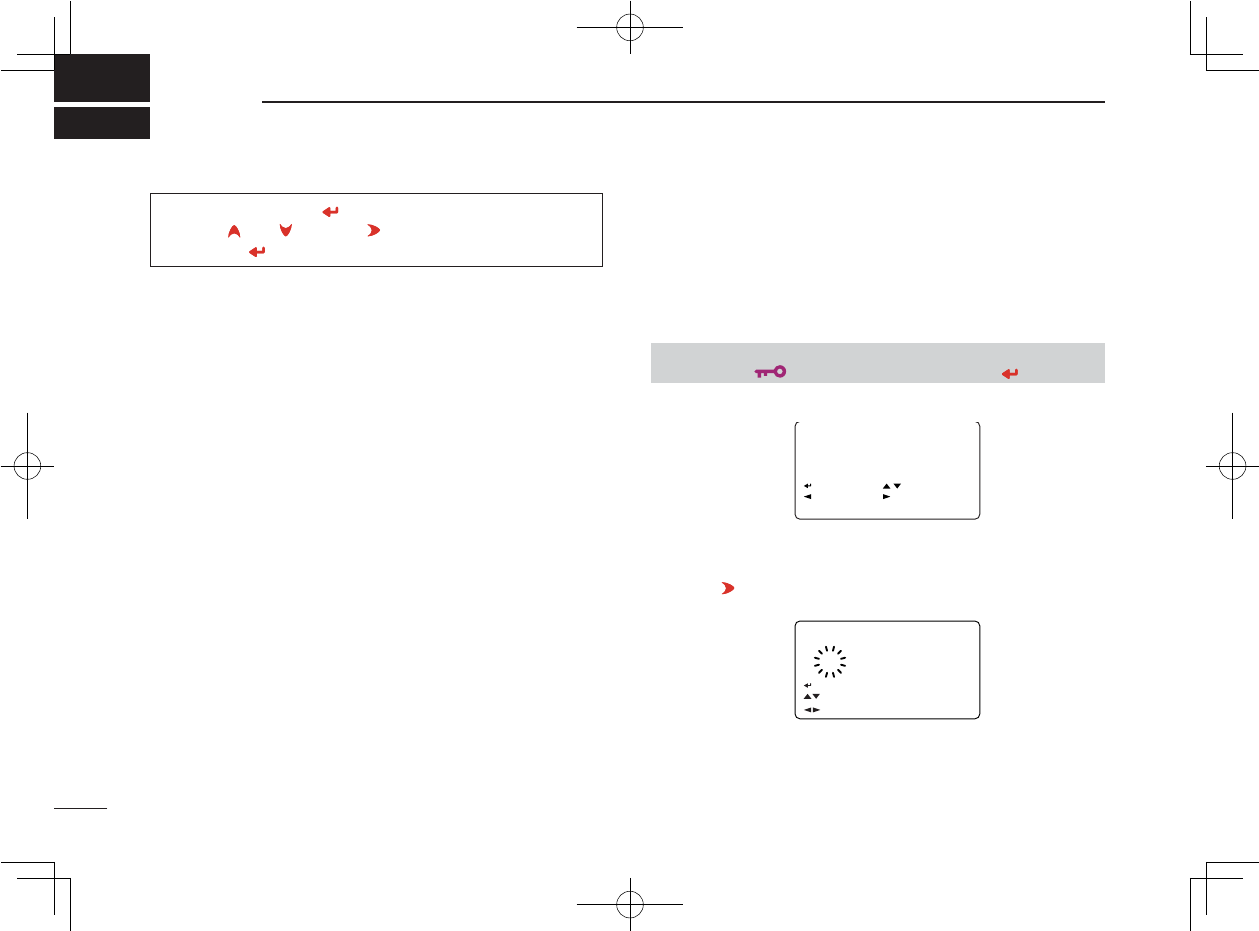
Ne
34
New2001
DV MODE OPERATION (Optional UT-121 is required for IC-92A)
7
Although [DIAL] and [ ](5) are used for description in this
section, [](2)/[](8) and [](6) are available instead of
[DIAL] and [](5).
■ Digital mode operation
The IC-92A*/92AD can be operated in digital voice mode
and low-speed data operation for both transmit and receive.
It can also be connected to a GPS receiver (compatible with
an RS-232 output/NMEA format/4800 bps) and transmit/receive
position data.
*The optional UT-121 is required for the IC-92A.
■ Call sign programming
Four types of call sign memories are available; your own
call sign “MY CALL SIGN,” other station call sign “YOUR
CALL SIGN,” repeater call sign “RPT1 CALL SIGN” and
“RPT2 CALL SIGN.” “MY CALL SIGN” can store up to 6 call
signs, “YOUR CALL SIGN” can store up to 60 call signs and
“RPT1/2 CALL SIGN” can store up to 60 call signs, and each
call sign can be programmed with up to 8 characters.
D Your own call sign programming
Your own call sign must be programmed for both digital voice
and low-speed data communications (including GPS transmis-
sion).
q Select B band as the main band. (p. 14)
w Enter “MY” in call sign set mode.
• MY CALL SIGN screen is displayed.
e Rotate [DIAL]† to select the desired call sign memory,
“M01” to “M06.”
r Push [](6) to enter call sign programming mode.
• The 1st digit blinks.
t Rotate [DIAL]† to select the desired character or code.
• Push [A/a](3) to change the character group from “AB” (alpha-
betical characters; capital letters), “12” (numbers) and “/” (sym-
bols) in sequence.
M01
/
:SET
:BACK
:SEL
:EDIT
CLR:CLR
MY CALL SIGN
r
M01
†
/
MY CALL SIGN
r
:SET
:SEL
:CUR
CLR:CLR
A/a:CHAR
AB
❮MENU screen❯ ➪ ❮CALL SIGN❯ ➪ ❮MY❯
(Push [MENU/ ]) (Rotate [DIAL]†, then push [ ](5)†.)
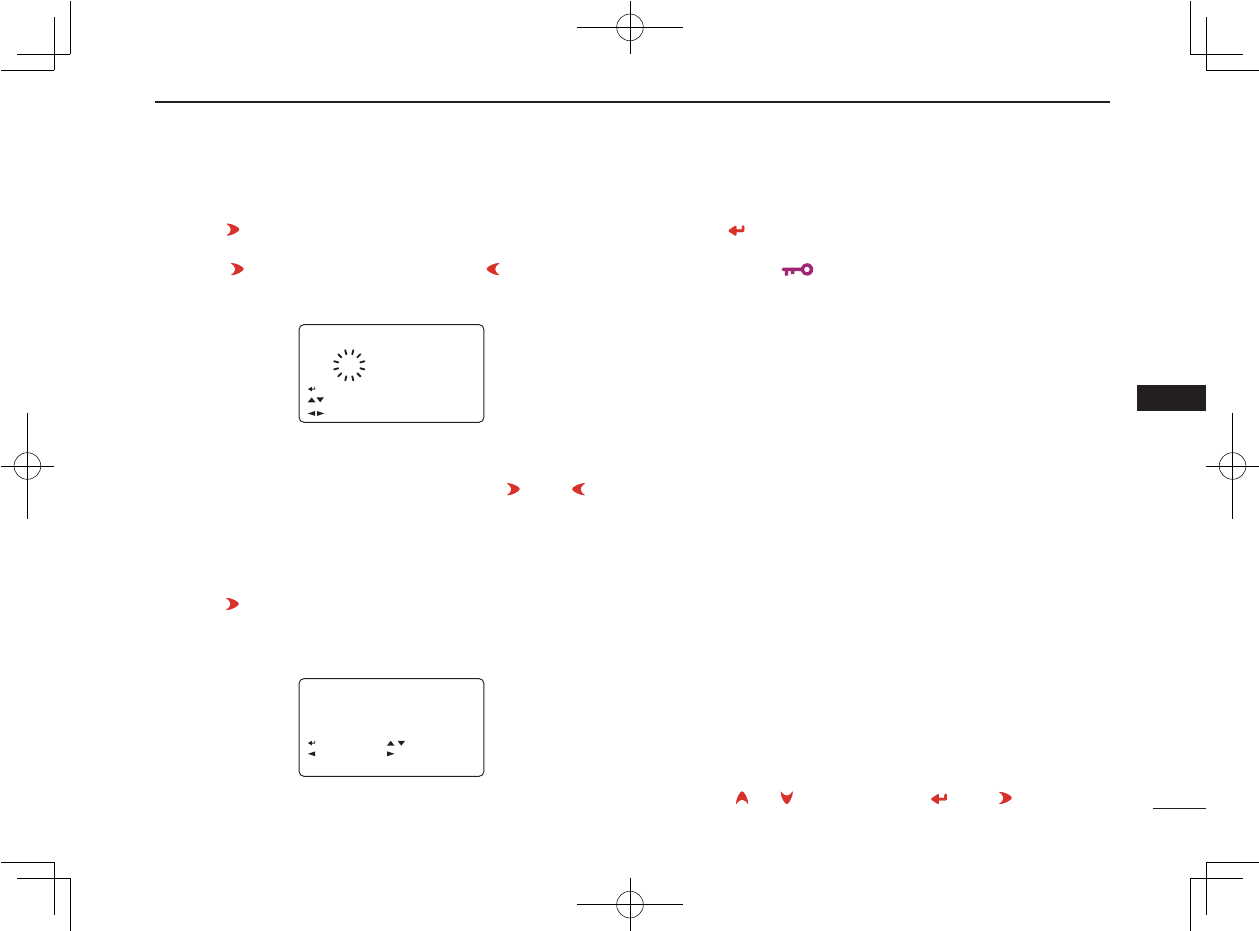
35
7
DV MODE OPERATION (Optional UT-121 is required for IC-92A)
New2001
7
y Push [ ](6) to select 2nd digit, then rotate [DIAL]† to se-
lect the desired character or code.
• Push [](6) to move the cursor right; push [](4) to move the
cursor left.
• 2nd digit blinks (1st digit stops blinking).
u Repeat the steps t and y to enter your own call sign.
• Up to a 8-digit of call sign can be set.
• If an un-necessary character is entered, push [](6) or [](4)
to select the character, then push [CLR](1) to erase the se-
lected character, or push and hold [CLR](1) for 1 sec. to erase
all characters following the cursor.
• When programming a note (Up to a 4-digit for operating radio
type or area, etc.), go to step i, otherwise go to step !0.
i Push [ ](6) several times to set the cursor beside “/” indi-
cation.
o Repeat steps t to y to program the desired 4-character
note.
!0 Push [](5) to store the programmed call sign with note
and returns to MY CALL SIGN screen.
!1 Push [MENU/ ] to return to frequency indication.
†[DIAL] ↔ [ ](2)/[](8) [ ](5) ↔ [ ](6)
1
2
3
4
5
6
8
9
10
11
12
13
14
15
16
17
18
19
M01
M†
/
MY CALL SIGN
MY CALL SIGN
r
:SET
:SET
:SEL
:SEL
:CUR
:CUR
CLR:CLR
CLR:CLR
A/a:CHAR
A/a:CHAR
AB
M01
MYCALL
/IC91
:SET
:BACK
:BACK
:SEL
:SEL
:EDIT
:EDIT
CLR:CLR
CLR:CLR
MY CALL SIGN
MY CALL SIGN
r
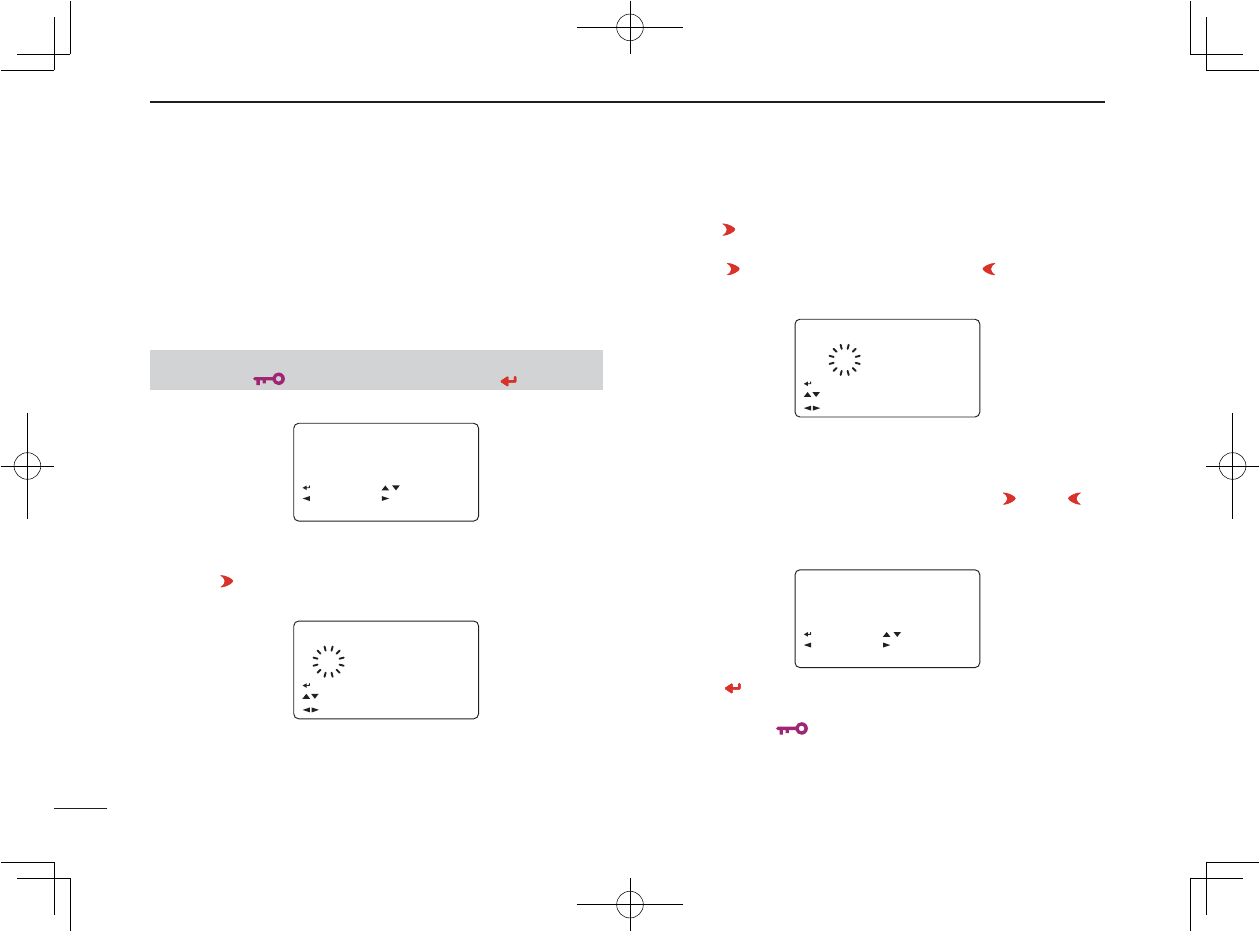
Ne
36
7DV MODE OPERATION (Optional UT-121 is required for IC-92A)
New2001
D Station call sign programming
Station call sign must be programmed for the specifi ed sta-
tion call as well as repeater operation in both digital voice
and low-speed data communications.
q Select B band as the main band. (p. 14)
w Enter “UR” in call sign set mode.
• YOUR CALL SIGN screen is displayed.
e Rotate [DIAL]† to select the desired call sign memory,
“U01” to “U60.”
r Push [](6) to enter call sign programming mode.
• The 1st digit blinks.
t Rotate [DIAL]† to select the desired character or code.
• Push [A/a](3) to change the character group from “AB” (alpha-
betical characters; capital letters), “12” (numbers) and “/” (sym-
bols) in sequence.
y Push [ ](6) to select 2nd digit, then rotate [DIAL]† to se-
lect the desired character or code.
• Push [](6) to move the cursor right; push [](4) to move the
cursor left.
• 2nd digit blinks (1st digit stops blinking).
u Repeat the steps t and y to enter the desired station
call sign.
• Up to an 8-digit of call sign can be set.
• If an un-necessary character is entered, push [](6) or [](4)
to select the character, then push [CLR](1) to erase the se-
lected character, or push and hold [CLR](1) for 1 sec. to erase
all characters following the cursor.
i Push [](5) to store the programmed call sign and re-
turns to YOUR CALL SIGN screen.
o Push [MENU/ ] to return to frequency indication.
U
CQCQCQ
:SET
:BACK
:BACK
:SEL
:SEL
:EDIT
:EDIT
CLR:CLR
CLR:CLR
YOUR CALL SIGN
YOUR CALL SIGN
r
U01
AB
AB
†
:SET
:SEL
:SEL
:CUR
CLR:CLR
CLR:CLR
A/a:CHAR
A/a:CHAR
0:CQ
YOUR CALL SIGN
r
U01 AB
S†
:SET
:SEL
:SEL
:CUR
CLR:CLR
A/a:CHAR
A/a:CHAR
0:CQ
YOUR CALL SIGN
r
U01
STATION1
:SET
:SET
:BACK
:BACK
:SEL
:SEL
:EDIT
:EDIT
CLR:CLR
CLR:CLR
YOUR CALL SIGN
YOUR CALL SIGN
r
❮MENU screen❯ ➪ ❮CALL SIGN❯ ➪ ❮UR❯
(Push [MENU/ ]) (Rotate [DIAL]†, then push [ ](5)†.)
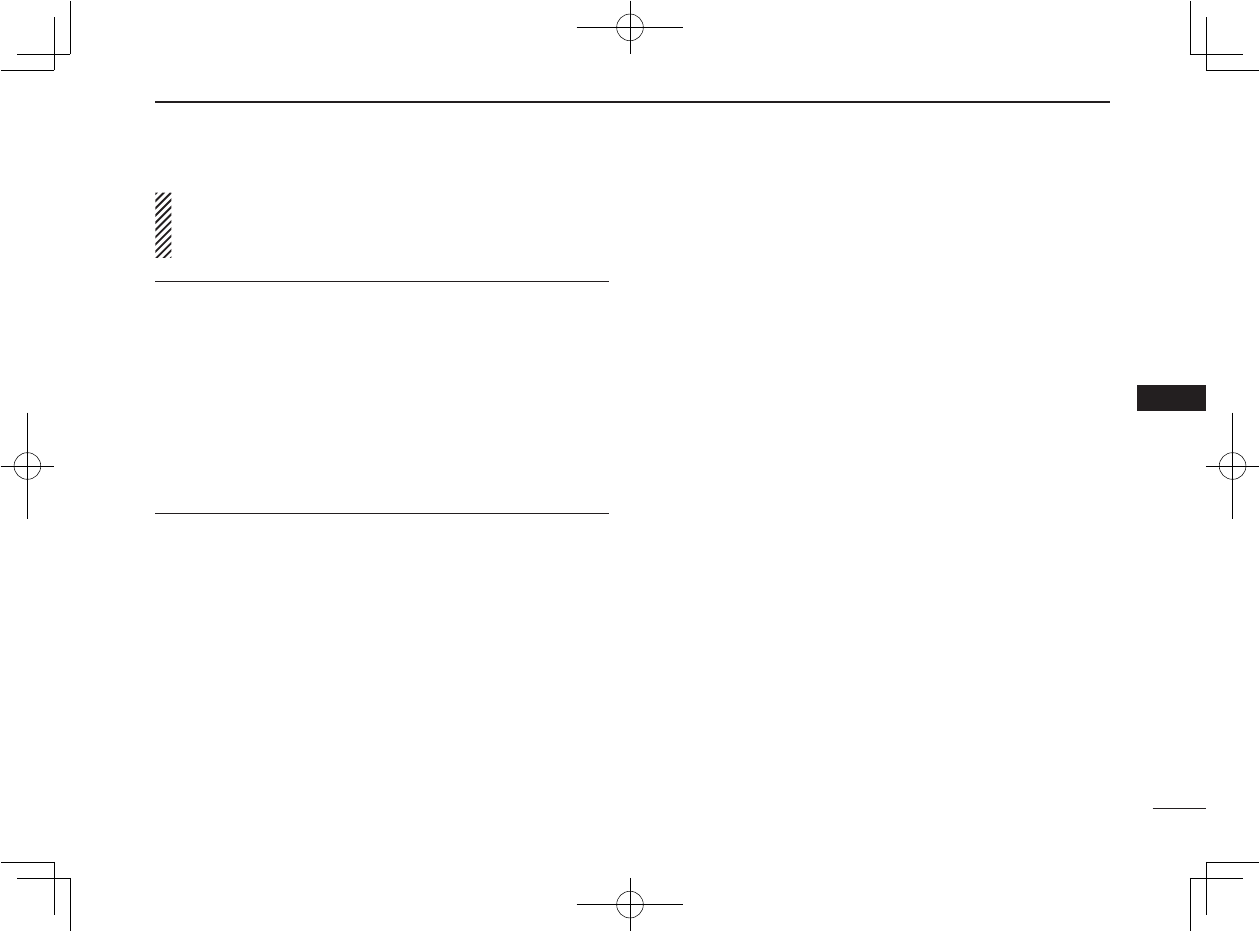
37
7
DV MODE OPERATION (Optional UT-121 is required for IC-92A)
New2001
7
NOTE: During the call sign programming mode (r to u),
push [CQ](0) to set “CQCQCQ,” and push [CQ](0)
again to return to the previously stored call sign.
✔ For your information
The IC-92A/92AD has call sign edit record function.
When editing a call sign stored in a call sign memory, regu-
lar memory or call channel, the default setting is to store the
edited call sign into a blank channel automatically. (“FULL” is
displayed when all call sign memory is programmed.)
The edited call sign can be over-written when the setting of
the EDIT RECORD is set to OFF or SELECT. (p. 95)
However, you must manually over-write a programmed call
sign in regular memory and call channels. (Temporary op-
eration without over-writing is possible.)
†[DIAL] ↔ [∫](2)/[√](8) [ï](5) ↔ [≈](6)
1
2
3
4
5
6
8
9
10
11
12
13
14
15
16
17
18
19
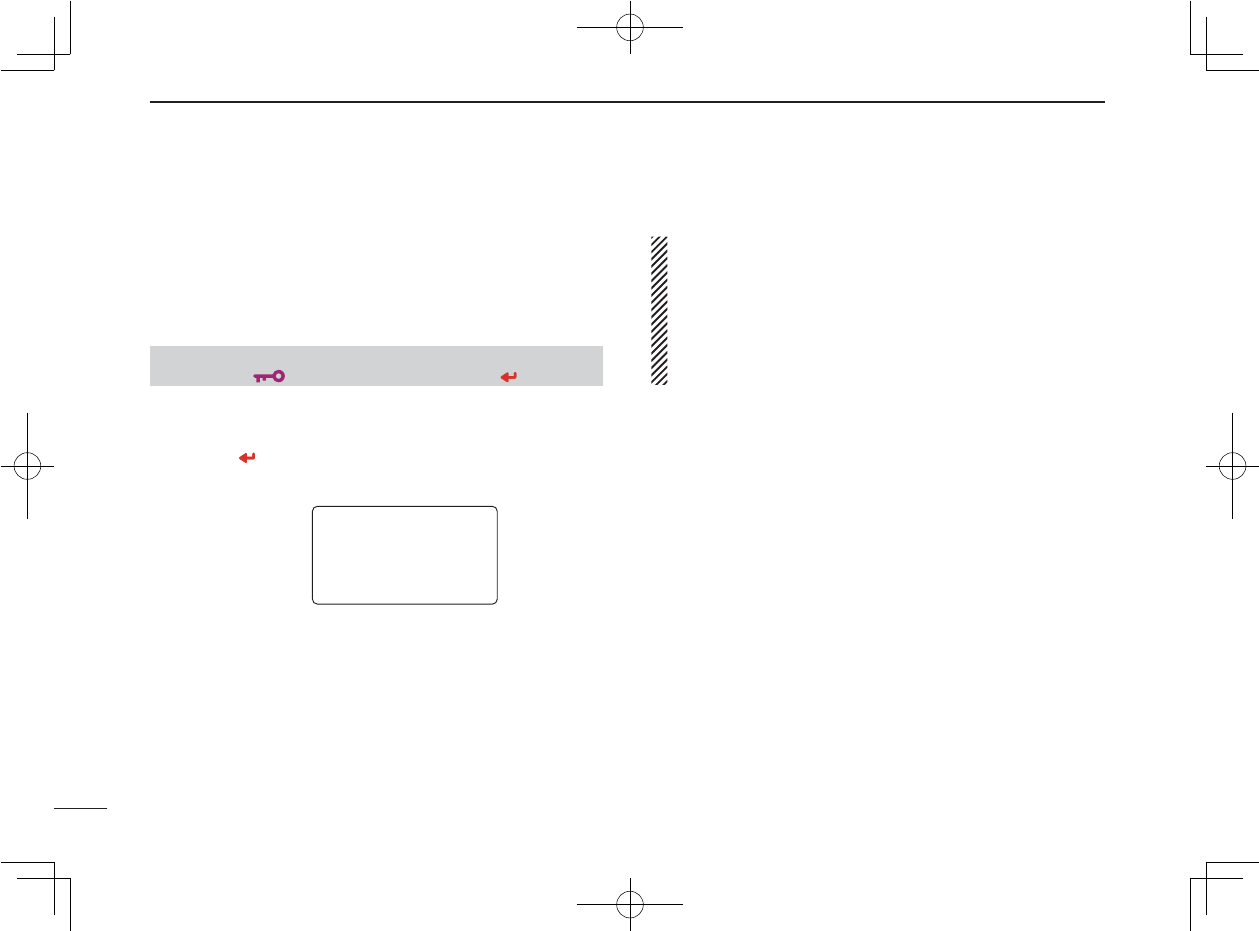
Ne
38
7DV MODE OPERATION (Optional UT-121 is required for IC-92A)
New2001
■ Digital voice mode operation
q Set the desired frequency in B band. (pgs. 14, 18)
• Select output power, if desired. (p. 24)
w Select DV mode. (p. 21)
e Set your own call sign for DV operation as follows.
z Enter “MY” in call sign set mode.
x Rotate [DIAL]† to select the desired your own call sign
channel (if you have programmed several call signs) then
push [](5) to set the call sign and return to CALL
SIGN screen.
• See page 34 for your own call sign programming details.
r Set the desired call sign as described in “When calling the
desired station (p. 39)” or “When sending a CQ (p. 39).”
t Push and hold [PTT] to transmit and speak into the micro-
phone at normal voice level.
• Tx/Rx indicator lights red and the RF meter shows the output
power.
y Release [PTT] to return to receive.
• The other station call sign will be received.
• Received call signs can be stored into the received call record
automatically. See page 93 for details.
NOTE: The digital mode operation is vastly different from
FM mode. One of the differences is in digital mode the
squelch does not function as in FM mode. Changing the
squelch setting will not open it to hear the hiss of “White
Noise.” It only activates for digital squelch functions such
as CSQL (Digital code squelch) or DSQL (Digital call sign
squelch).
UR:
R1:
R2:NOT USE*
MY:MYCALL
/IC92
/IC92
CALL SIGN
CALL SIGN
r
❮MENU screen❯ ➪ ❮CALL SIGN❯ ➪ ❮MY❯
(Push [MENU/ ]) (Rotate [DIAL]†, then push [ ](5)†.)
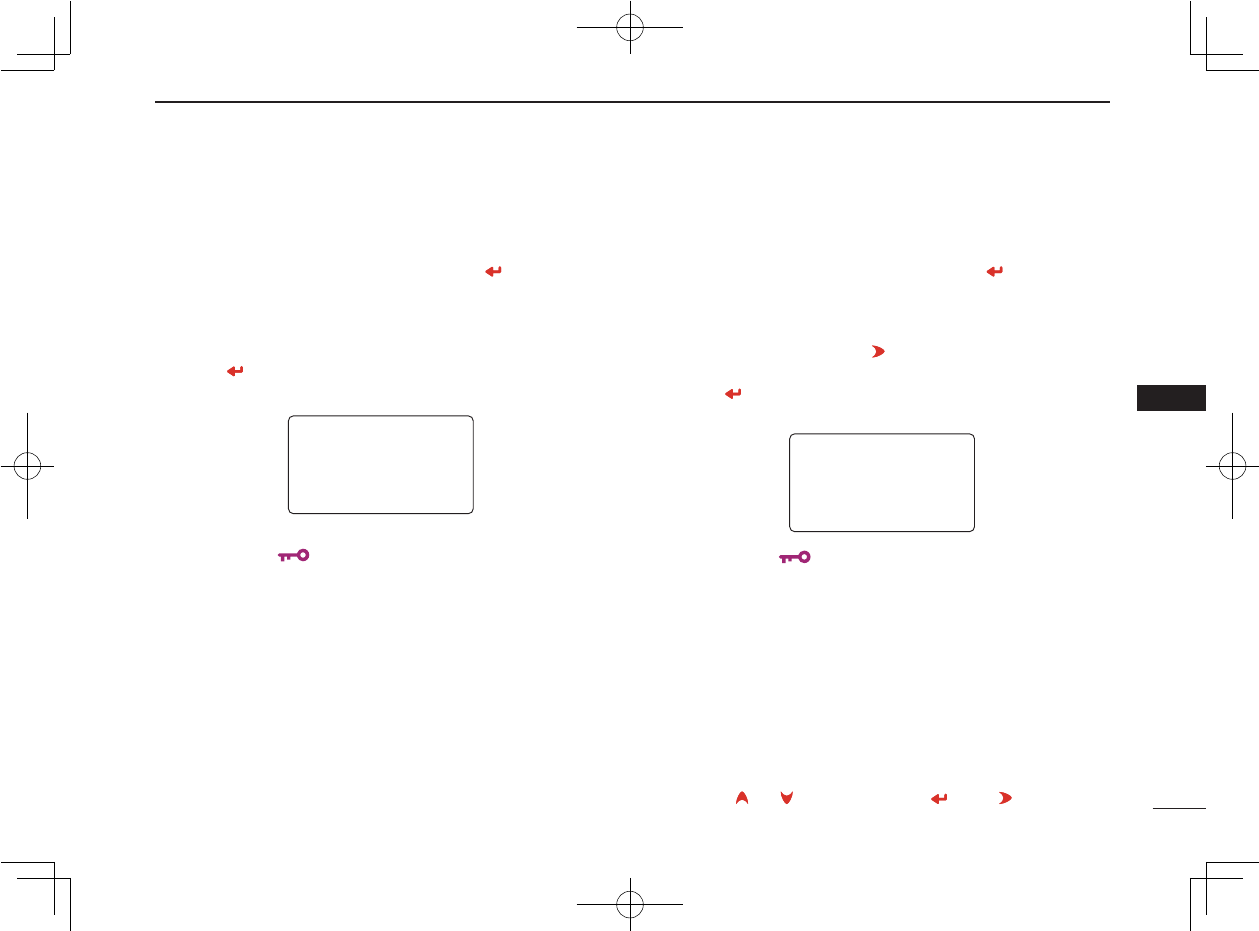
39
7
DV MODE OPERATION (Optional UT-121 is required for IC-92A)
New2001
7
D When calling the desired station
Continued instruction from step x on page 38.
c Rotate [DIAL]† to select “UR,” then push [ ](5)†.
• YOUR CALL SIGN screen is displayed.
v Rotate [DIAL]† to select the call sign channel in which de-
sired station’s call sign is programmed.
• See page 36 for station call sign programming details.
b Push [](5) to set the station’s call sign and return to
CALL SIGN screen.
n Push [MENU/ ] to return to frequency indication.
m Perform the instruction steps t and y on page 38.
D When sending a CQ
Continued instruction from step x on page 38.
c Rotate [DIAL]† to select “UR,” then push [ ](5)†.
• YOUR CALL SIGN screen is displayed.
v Rotate [DIAL]† to select the call sign channel in which
“CQCQCQ” is programmed.
Or, select “U” then push [](6) and [CQ](0) in sequence
to set “CQCQCQ.”
b Push [](5) to set “CQCQCQ” as the call sign and return
to CALL SIGN screen.
n Push [MENU/ to return to frequency indication.
m Perform the instruction step t and y on page 38.
†[DIAL] ↔ [ ](2)/[](8) [ ](5) ↔ [ ](6)
1
2
3
4
5
6
8
9
10
11
12
13
14
15
16
17
18
19
UR:STATION1
R1:
R2:NOT USE*
MY:MYCALL
/IC92
/IC92
CALL SIGN
CALL SIGN
r
UR:CQCQCQ
R1:
R2:NOT USE*
MY:MYCALL
/IC92
/IC92
CALL SIGN
CALL SIGN
r
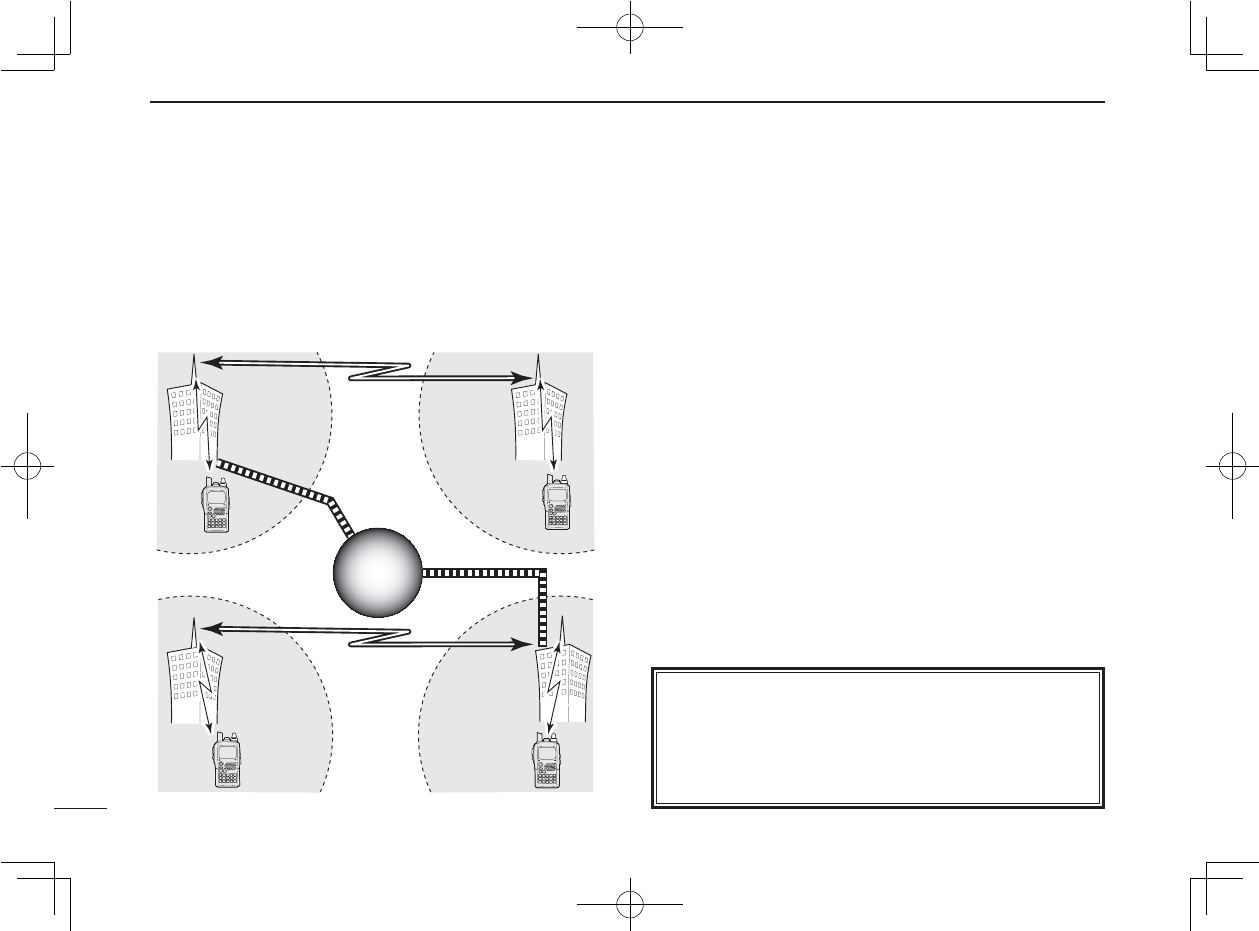
Ne
40
7DV MODE OPERATION (Optional UT-121 is required for IC-92A)
New2001
■ About D-STAR system
In the D-STAR system, repeater linking via a 10 GHz band
backbone and internet network (gateway connection) capa-
bilities are available. This system provides you to with much
wider coverage range during digital voice mode operation.
•-D-STAR system outline
For current repeater operation, stations that are communi-
cating must both be in the same repeater’s operating area.
However, in the D-STAR system as in the illustration at left,
the repeaters can be linked via the system repeaters (with
a 10 GHz signal). Thus stations A and B can communicate
even though they are in different repeater operating areas.
Also, the D-STAR system repeaters are connectable through
the internet— gateway connection capability.
For example, when station B uses the gateway connection
station B can communicate with the station C!
By using the gateway connection, long distance communica-
tion like DX operation may be possible with 144 or 440 MHz
digital voice!
In the D-STAR system, an independent repeater’s operating
area is called an Area and a group that of linked repeaters
via a 10 GHz backbone is called a Zone.
About time-out timer function
The IC-92A/92AD has a time-out timer function for digital
repeater operation. The timer limits a continuous trans-
mission for approx. 10 min. Warning beeps will sound
before 30 sec. (approx.) and just before the timer function-
ing.
Station
A
Station C Station D
Repeater A
Repeater D
440 MHz
440 MHz
Repeater C
10 GHz
Station
B
Repeater B
10 GHz
440 MHz
440 MHz
Internet
network
Internet
network
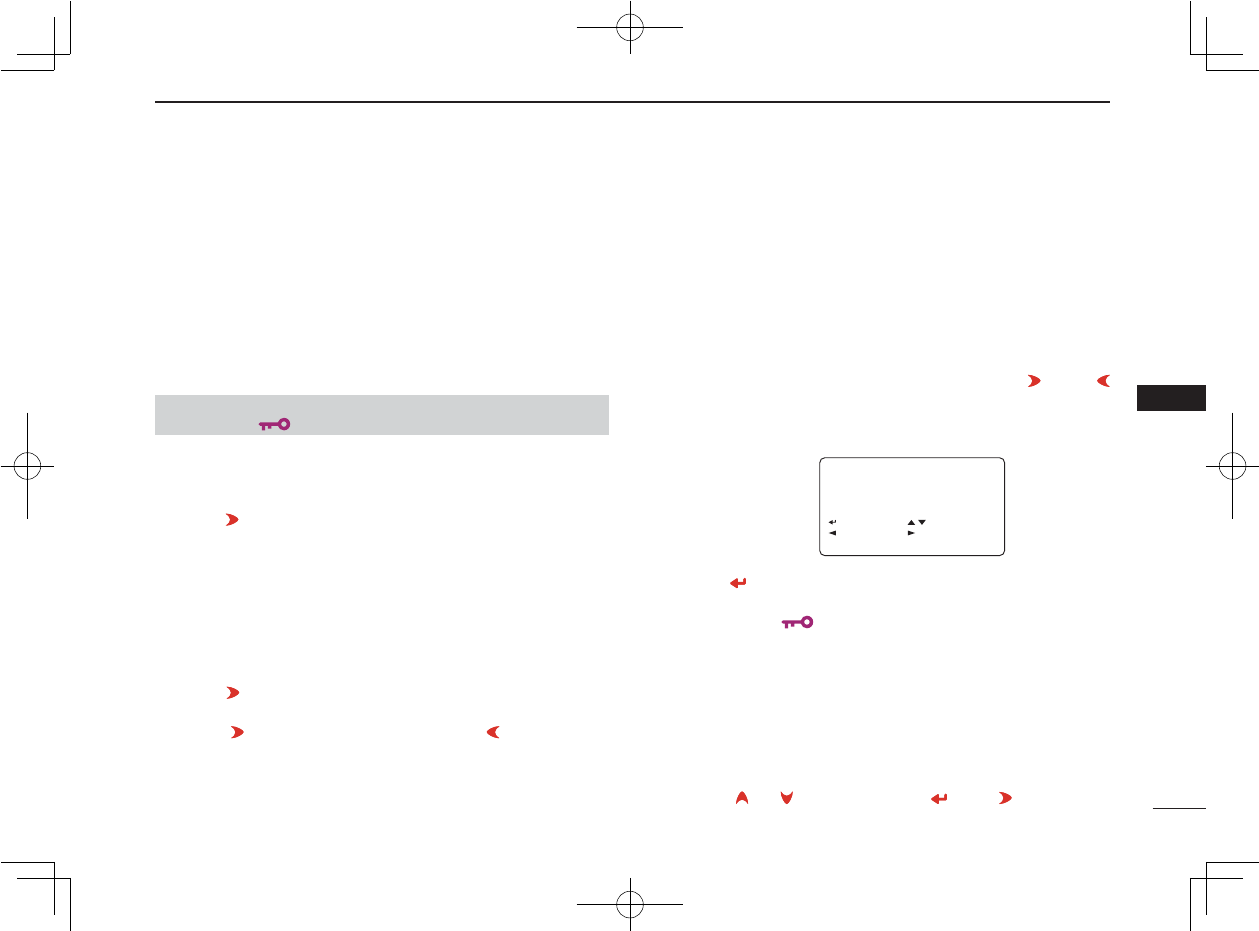
41
7
DV MODE OPERATION (Optional UT-121 is required for IC-92A)
New2001
7
■ Digital repeater operation
Repeater call signs must be programmed for repeater op-
eration in both digital voice and low-speed data communica-
tions.
D Repeater call sign programming
q Select B band as the main band. (p. 14)
w Enter “R1” or “R2” in call sign set mode.
• RPT1 or RPT2 CALL SIGN screen is displayed.
e Rotate [DIAL]† to select the desired call sign memory,
“R01” to “R60.”
r Push [](6) to enter call sign programming mode.
• The 1st digit blinks.
t Rotate [DIAL]† to select the desired character or code.
• Push [A/a](3) to change the character group from “AB” (alpha-
betical characters; capital letters), “12” (numbers) and “/” (sym-
bols) in sequence.
• Set “/” at the 1st digit then set the desired area repeater’s call
sign (in a different zone) for CQ call (“/” stands for “CQCQCQ”)
in a different zone operation. (p. 44)
y Push [ ](6) to select 2nd digit, then rotate [DIAL]† to se-
lect the desired character or code.
• Push [](6) to move the cursor right; push [](4) to move the
cursor left.
• 2nd digit blinks (1st digit stops blinking).
u Repeat the steps t and y to enter the desired repeater
call sign.
• Up to an 8-digit of call sign can be set.
• Push [7] when setting with the gateway connection if the
selected repeater has gateway capability. (The gateway con-
nection can be set in RPT1 only when “NOT USE✱” is set to
RPT2.)
• If an un-necessary character is entered, push [](6) or [
](4) to select the character, then push [CLR](1) to erase the
selected character, or push and hold [CLR](1) for 1 sec. to all
characters following the cursor.
i Push [](5) to store the programmed call sign and re-
turns to RPT1 or RPT2 CALL SIGN screen.
o Push [MENU/ ] to return to frequency indication.
†[DIAL] ↔ [ ](2)/[](8) [ ](5) ↔ [ ](6)
1
2
3
4
5
6
8
9
10
11
12
13
14
15
16
17
18
19
❮MENU screen❯ ➪ ❮CALL SIGN❯ ➪ ❮R1❯/❮R2❯
(Push [MENU/ ]) (Rotate [DIAL]†, then push [ï](5)†.)
R01
RPT1AA G
RPT1AA G
:SET
:BACK
:BACK
:SEL
:SEL
:EDIT
:EDIT
CLR:CLR
CLR:CLR
RPT1 CALL SIGN
RPT1 CALL SIGN
r
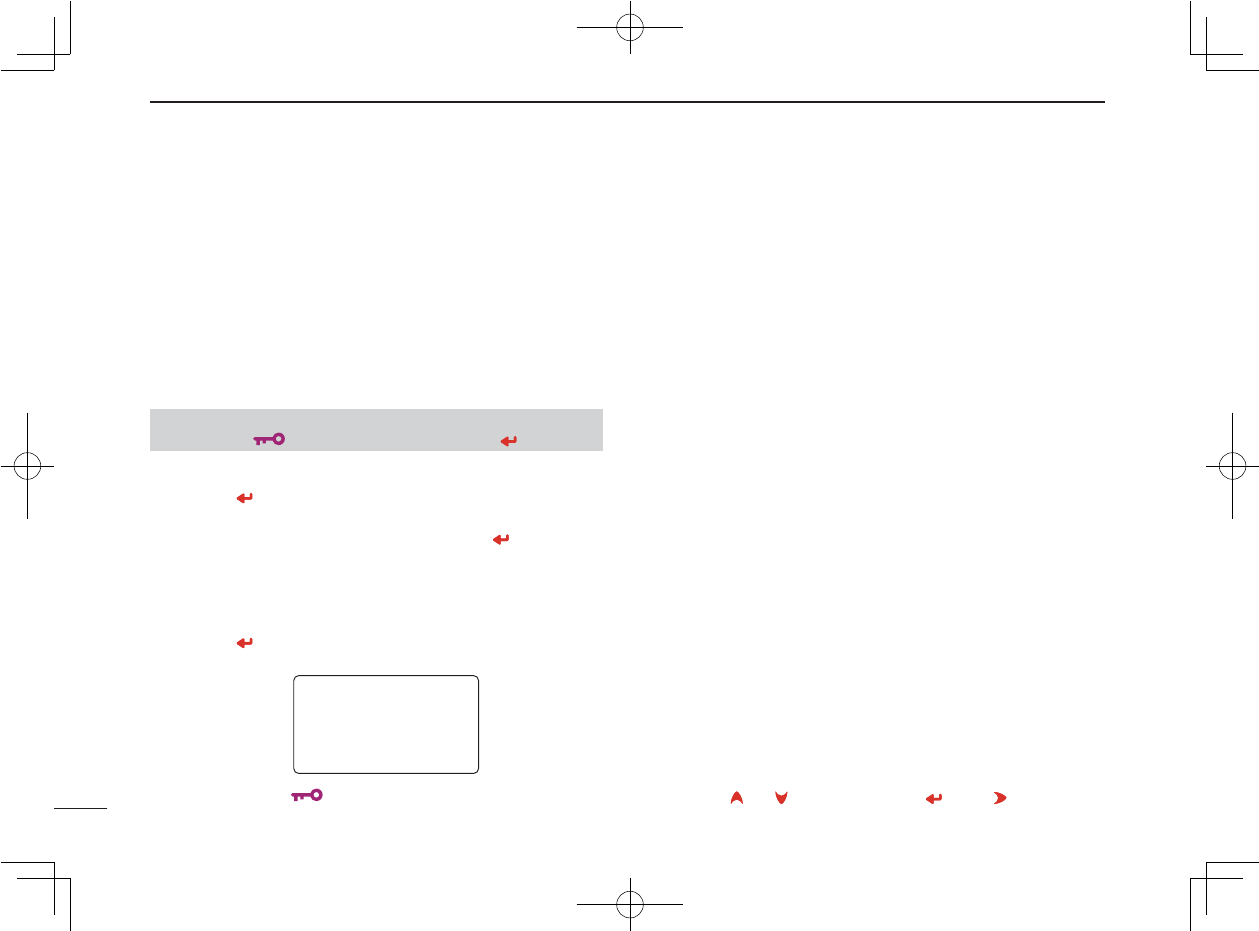
Ne
42
7DV MODE OPERATION (Optional UT-121 is required for IC-92A)
New2001
D Repeater operation in the same zone
q Set the desired repeater’s frequency, offset and shift di-
rection in B band. (pgs. 18, 31)
• Select DV mode in advance. (p. 21)
w Set your own call sign. (p. 38)
• See p. 34 for your own call sign programming.
e Set the desired station call sign. (p. 39)
• See p. 36 for station call sign programming.
r Set the repeater’s call sign as follows;
z Enter “R1” in call sign set mode.
x Rotate [DIAL]† to select the nearest repeater’s call sign.
c Push [](5) to set the call sign for “R1.”
• Return to CALL SIGN screen.
v Rotate [DIAL]† to select “R2” then push [ ](5)†.
• RPT2 CALL SIGN screen is displayed.
b Rotate [DIAL]† to select the desired repeater’s (in the
same zone) call sign.
• Select “NOT USE✱” when not operating RPT2.
n Push [ ](5) to set the call sign for “R2.”
• Return to CALL SIGN screen.
m Push [MENU/ ] to return to frequency indication.
t Push [PTT] to transmit; release to receive.
†[DIAL] ↔ [ ](2)/[](8) [ ](5) ↔ [ ](6)
❮MENU screen❯ ➪ ❮CALL SIGN❯ ➪ ❮R1❯
(Push [MENU/ ]) (Rotate [DIAL]†, then push [ ](5)†.)
UR:CQCQCQ
R1:RPT1AA
R2:NOT USE*
MY:MYCALL
/IC92
/IC92
CALL SIGN
CALL SIGN
r
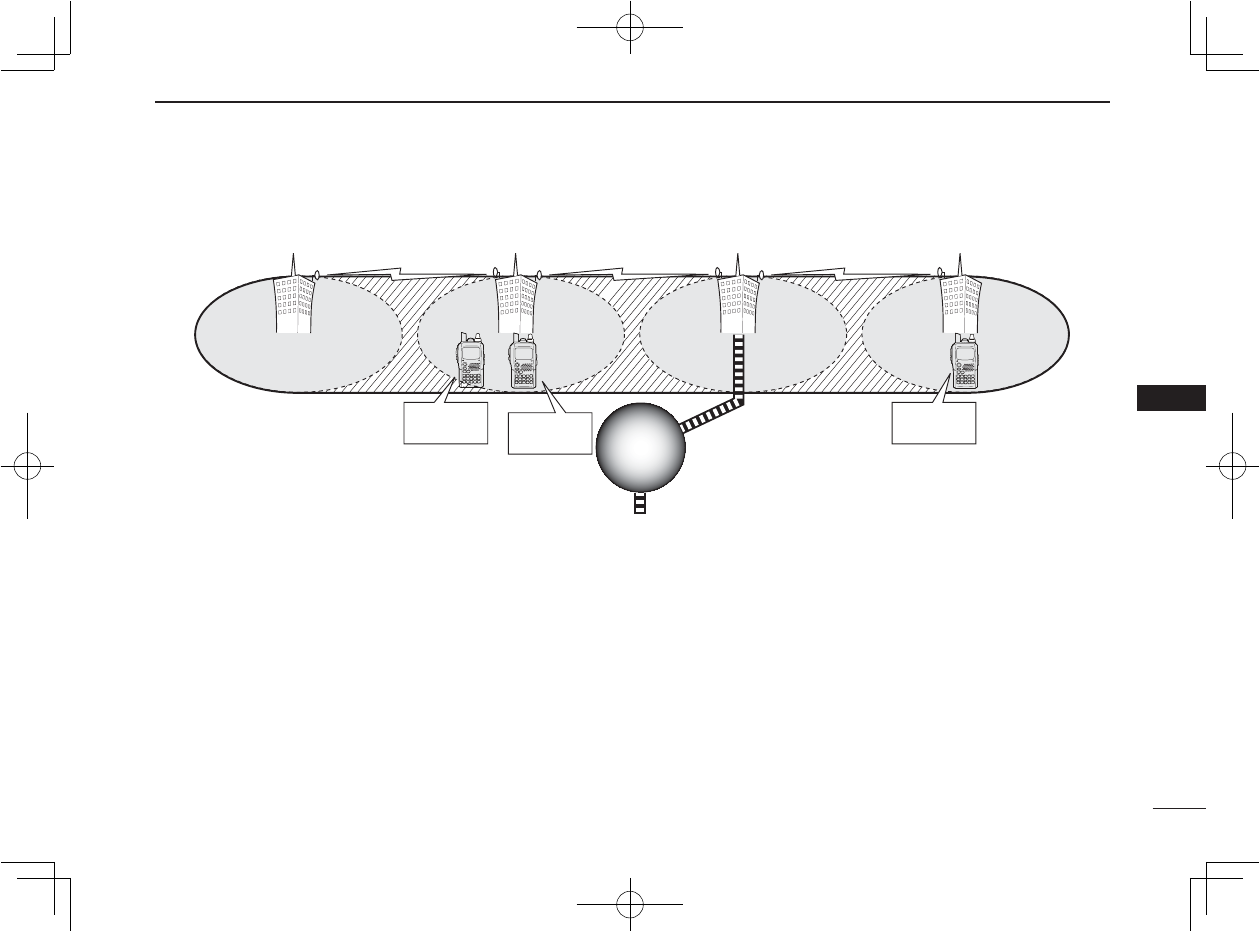
43
7
DV MODE OPERATION (Optional UT-121 is required for IC-92A)
New2001
7
Area 1
Zone
to another Zone
• Setting example 1
Repeater 1
: A11111
Area 2 Repeater 2
: A22222
Area 3
(Gateway)
Repeater 3
: A33333
Area 4 Repeater 4
: A44444
✔ What is the area?
The Area is the communication range that is
covered by a local repeater.
A Local repeater is called an area repeater in
the D-STAR system.
✔ What is the zone?
The Zone is composed of several areas, that
are linked by the 10 GHz microwave signal.
The areas 1 to 4 make up a zone in the
example above.
Station A
: A2222A Station B
: A2222B
Station C
: A4444C
Internet
network
network
Internet
network
❑ The setting when Station A is call-
ing Station B
UR : A2222B
R1 : A22222
R2 : NOT USEQ
MY : A2222A
❑ The setting when Station A is
making a CQ call in area 1
UR : CQCQCQ
R1 : A22222
R2 : A11111
MY : A2222A
❑ The setting when Station A is call-
ing Station C
UR : A4444C
R1 : A22222
R2 : A44444
MY : A2222A
1
2
3
4
5
6
8
9
10
11
12
13
14
15
16
17
18
19
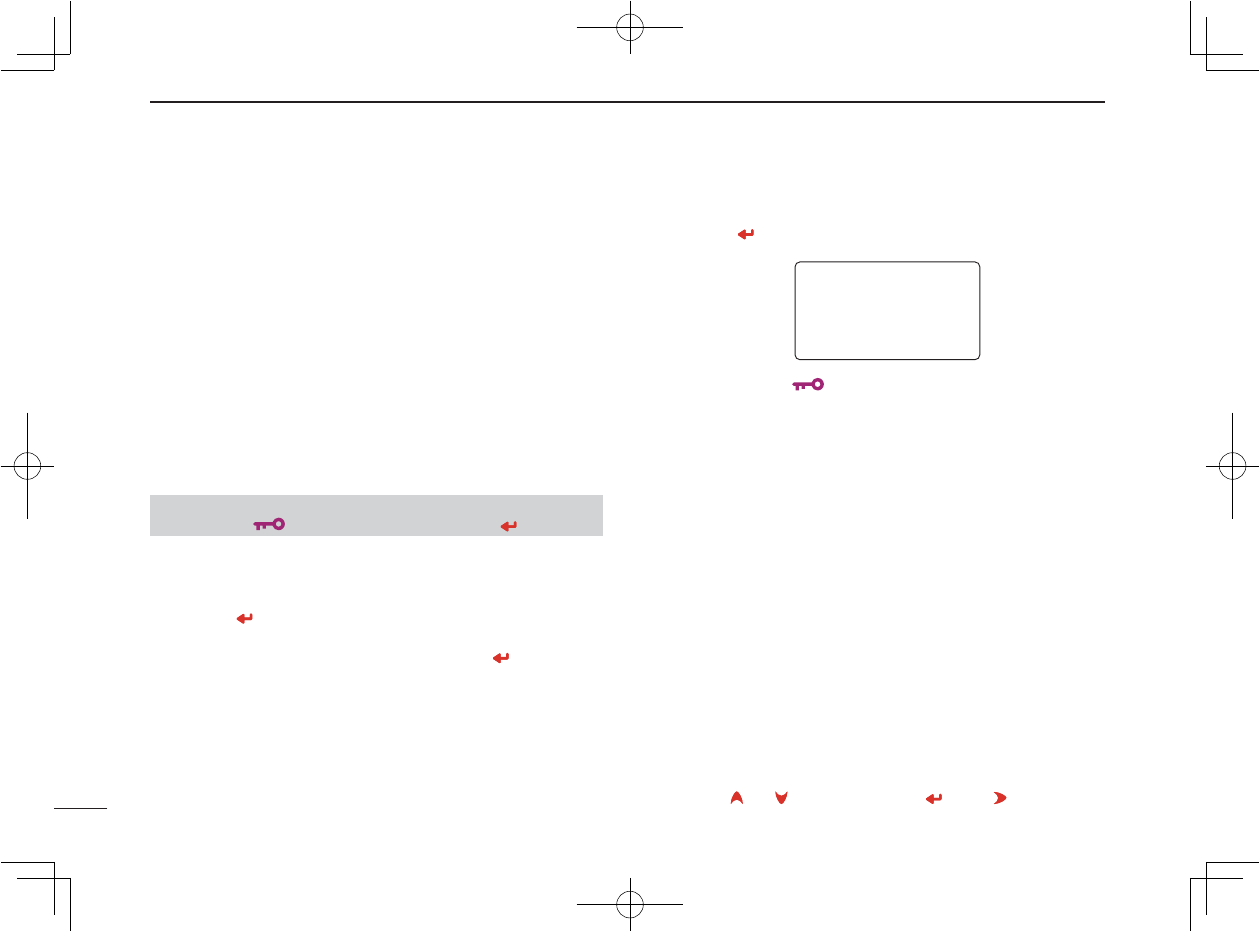
Ne
44
7DV MODE OPERATION (Optional UT-121 is required for IC-92A)
New2001
D Repeater operation into another zone
q Set the desired repeater’s frequency, offset and shift di-
rection in B band. (pgs. 18, 31)
• Select DV mode in advance.
w Set your own call sign. (p. 38)
• See p. 34 for your own call sign programming.
e Set the desired station call sign. (p. 39)
• When making a CQ call
Set the desired repeater’s (in a different zone) call sign
with a “/” symbol at the 1st digit, for the area in which
you want to make a CQ call, into “UR.”
• See p. 36 for station call sign programming.
r Set the repeater’s call sign as follows;
z Enter “R1” in call sign set mode.
x Rotate [DIAL]† to select the nearest repeater’s call sign.
• If the nearest repeater is gateway repeater, select the re-
peater’s call sign with “G” setting at the 8th digit.
c Push [ ](5) to set the call sign for “R1.”
• Return to CALL SIGN screen.
v Rotate [DIAL]† to select “R2” then push [ ](5)†.
b Rotate [DIAL]† to select the gateway repeater’s (in the
same zone) call sign.
• The call sign should have “G” setting at the 8th digit.
• When gateway repeater call sign is set in “R1,” select “NOT
USE✱” for “R2” setting.
n Push [ ](5) to set the call sign for “R2.”
•-Return to CALL SIGN screen.
m Push [MENU/ ] to return to frequency indication.
t Push [PTT] to transmit; release to receive.
†[DIAL] ↔ [ ](2)/[](8) [ ](5) ↔ [ ](6)
❮MENU screen❯ ➪ ❮CALL SIGN❯ ➪ ❮R1❯
(Push [MENU/ ]) (Rotate [DIAL]†, then push [ ](5)†.)
UR:CQCQCQ
R1:RPT1AA
R1:RPT1AA
R2:NOT USE*
MY:MYCALL
/IC92
/IC92
CALL SIGN
CALL SIGN
r
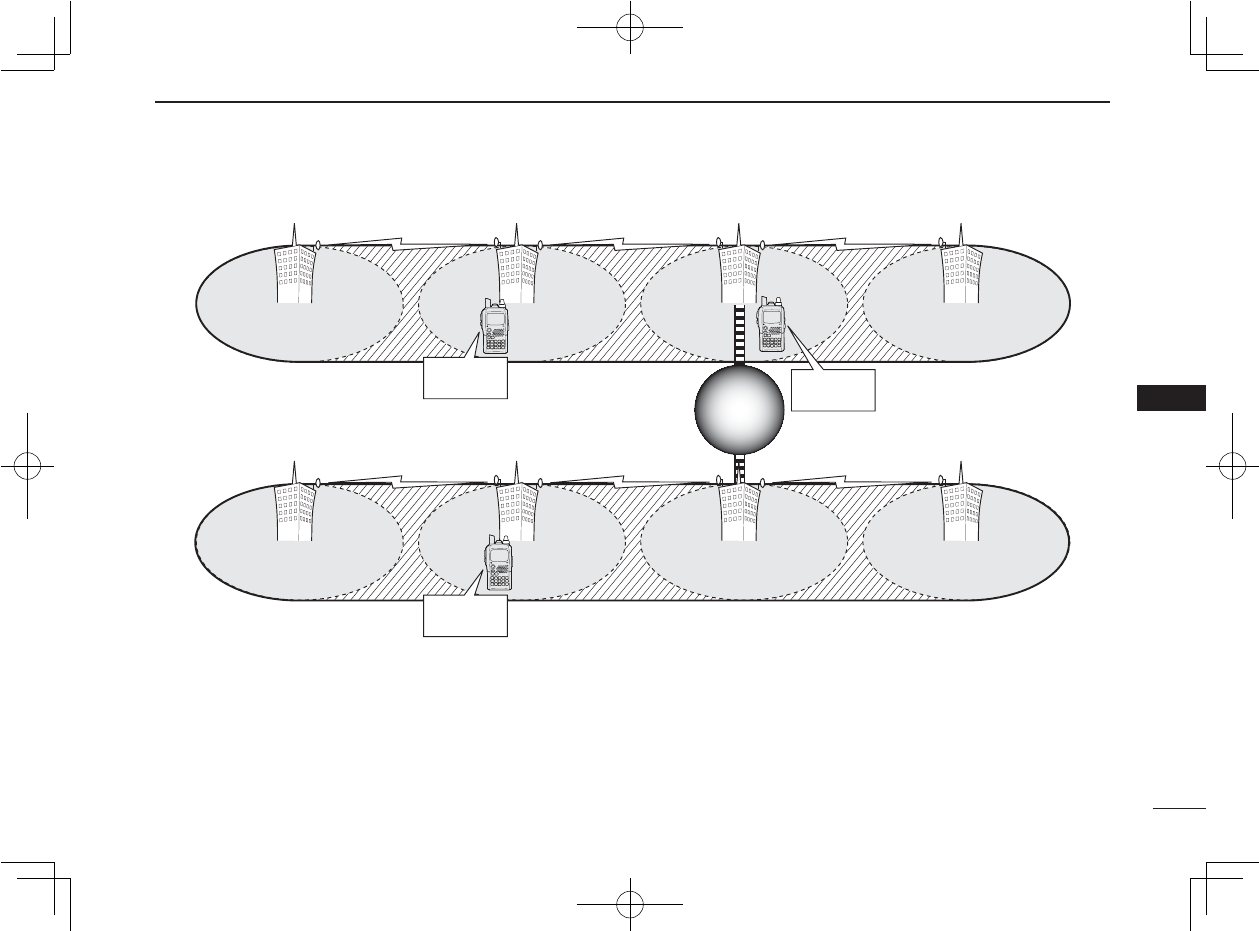
45
7
DV MODE OPERATION (Optional UT-121 is required for IC-92A)
New2001
7
Area 1
Zone A
• Setting example 2
Repeater 1
: A11111
Area 2
Repeater 2
: A22222
Area 3
(Gateway)
Repeater 3
: A33333
Repeater 3
3
: A33333
Repeater 3
: A33333 Area 4
Repeater 4
: A44444
Zone B
Area 6
Repeater 6
: B66666
Area 7
(Gateway) Repeater 7
: B77777
Area 8
Repeater 8
: B88888
Area 5 Repeater 5
: B55555
Station C
: B6666C
Station A
: A2222A Station B
: A3333B
Internet
network
network
Internet
network
❑ The setting when Station A is call-
ing Station C
UR : B6666C
R1 : A22222
R2 : A33333 G
MY : A2222A
❑ The setting when Station A is
making a CQ call in area 8
UR : /B88888
R1 : A22222
R2 : A33333 G
MY : A2222A
❑ The setting when Station B is call-
ing Station C
UR : B6666C
R1 : A33333 G
R2 : NOT USE✱
MY : A3333B
1
2
3
4
5
6
8
9
10
11
12
13
14
15
16
17
18
19
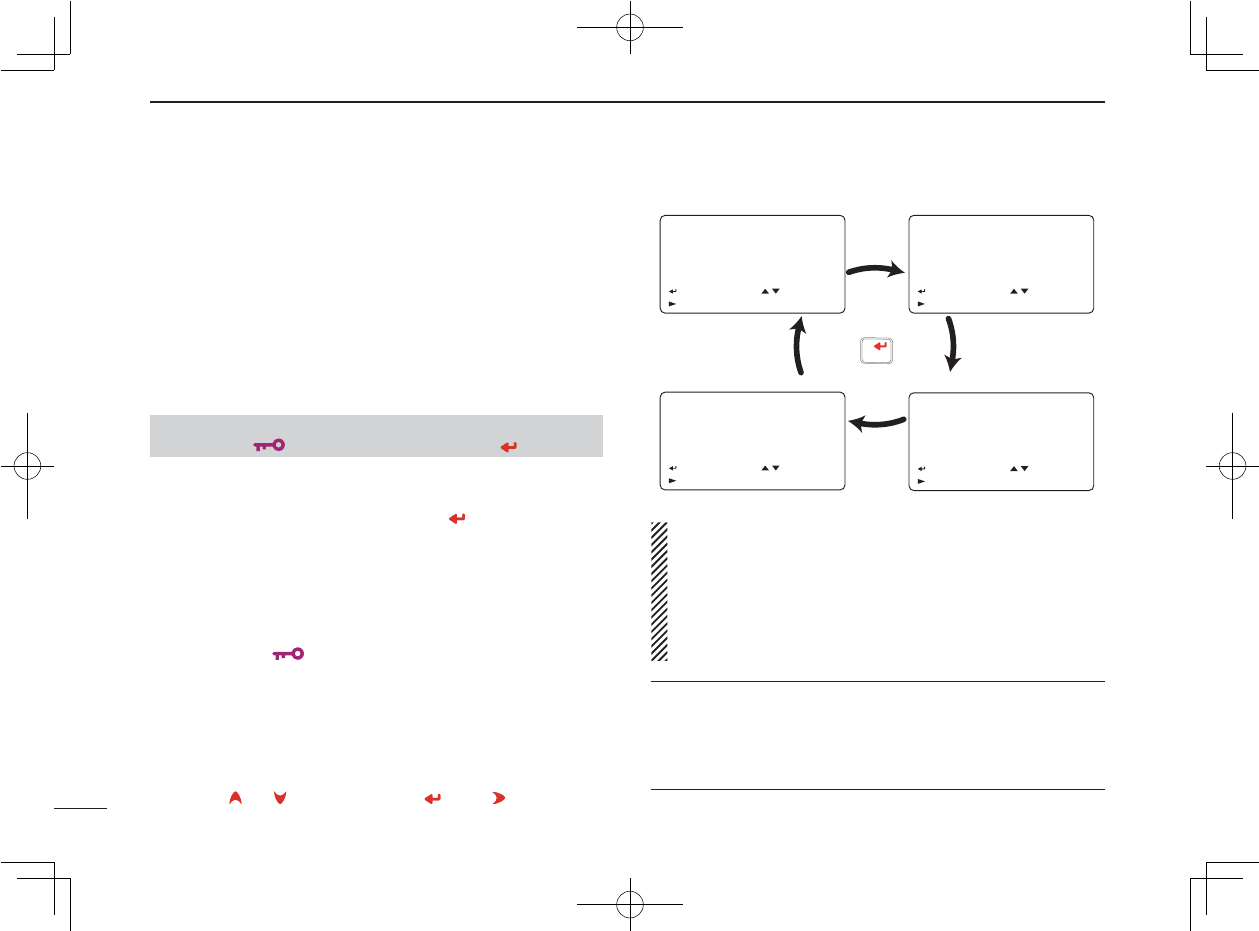
Ne
46
7DV MODE OPERATION (Optional UT-121 is required for IC-92A)
New2001
■ Received call sign
When a call is received in DV mode, the calling station and
the repeater call signs being used can be stored into the re-
ceived call record. The stored call signs are viewable in the
following manner.
Up to 20 calls can be recorded.
D Desired call record indication
q Enter RX call sign set mode.
• RX CALL SIGN screen is displayed.
w Rotate [DIAL]† to select the desired record channel.
e To confirm the received call, push [](5) several times
to select the desired call sign from CALLER, CALLED,
RXRPT1 and RXRPT2.
CALLER : The station call sign that made a call.
CALLED : The station call sign called by the caller.
RXRPT1 : The repeater call sign used by the caller station.
RXRPT2 : The repeater call sign linked from RXRPT1.
r Push [MENU/ ] to return to frequency indication.
NOTE: When a call is received in DV mode when the
power save function is activated, the call sign may not be
received correctly.
This is normal, not a malfunction, because of header of
the call sign cannot be detected during power save.
Turn the power save function OFF (p. 115) if you want to
receive a call sign correctly even in stand-by condition.
✔ For your information
When receiving a call, the received station call sign is auto-
matically displayed and scrolled in sequence at the bottom
line of the function display.
This can be turned OFF in display set mode. (p.100)
†[DIAL] ↔ [ ](2)/[](8) [ ](5) ↔ [ ](6)
❮MENU screen❯ ➪ ❮RX CALL SIGN❯
(Push [MENU/ ]) (Rotate [DIAL]†, then push [ ](5)†.)
RX01
CALLER:
AAAAAA
AAAAAA
/
/
:CALLED
:CALLED
:SEL
:SEL
:COPY
:COPY
CLR:CLR
CLR:CLR
RX CALL SIGN
RX CALL SIGN
r
RX01
RX01
CALLED:
CALLED:
CQCQCQ
CQCQCQ
:RXRPT1
:RXRPT1
:SEL
:SEL
:COPY
:COPY
CLR:CLR
CLR:CLR
RX CALL SIGN
RX CALL SIGN
r
RX01
RXRPT2:
:CALLER
:CALLER
:SEL
:SEL
:COPY
:COPY
CLR:CLR
CLR:CLR
RX CALL SIGN
RX CALL SIGN
r
RX01
RX01
RXRPT1:
RXRPT1:
:RXRPT2
:RXRPT2
:SEL
:SEL
:COPY
:COPY
CLR:CLR
CLR:CLR
RX CALL SIGN
RX CALL SIGN
r
Push
• Station call sign • Called station call sign
• Repeater 1 call sign
• Repeater 2 call sign
5
SKIP
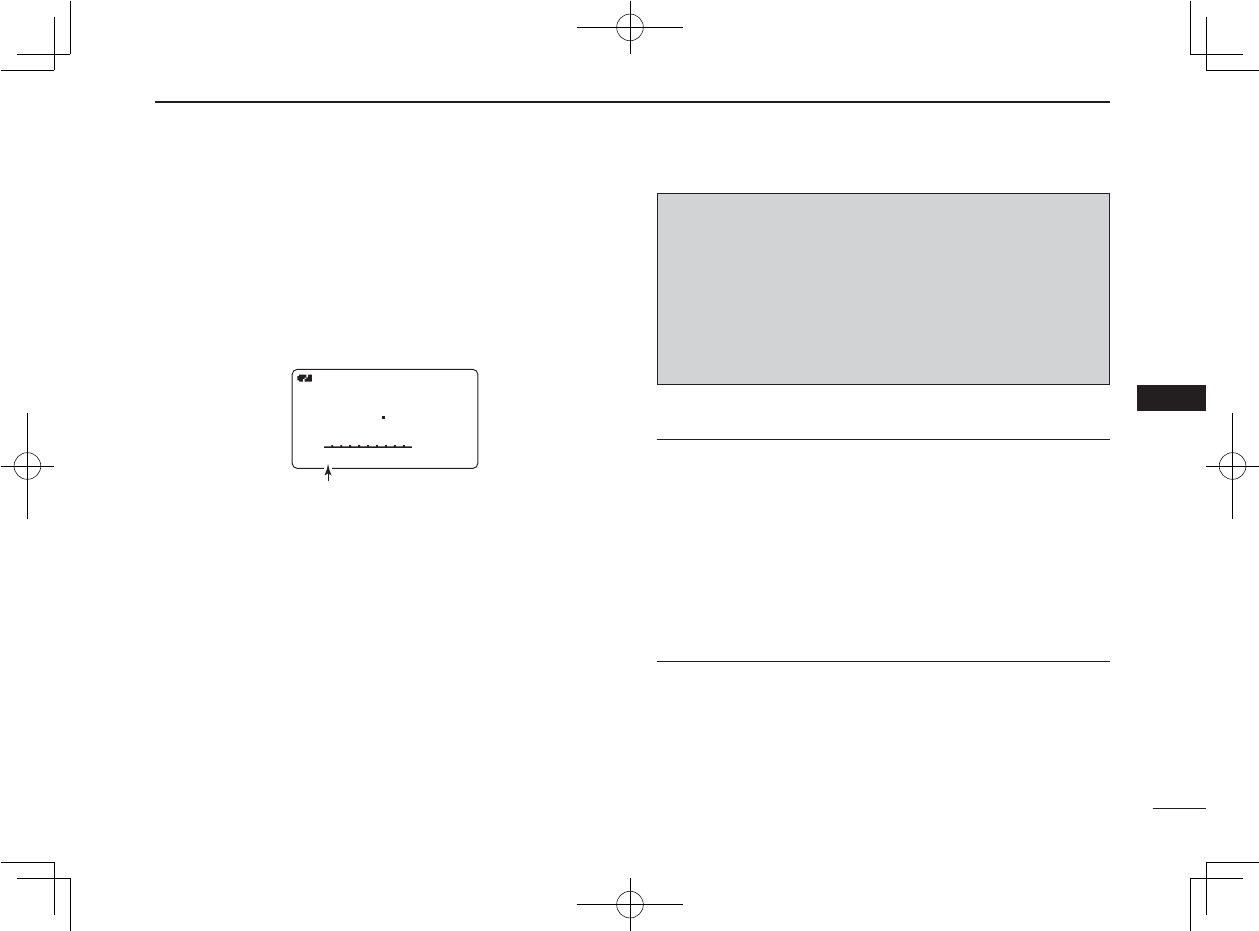
47
7
DV MODE OPERATION (Optional UT-121 is required for IC-92A)
New2001
7
D One-touch reply using the call record
The stored call signs in the call record can be used to the
call.
q After receiving a call, push and hold [RX➝CS](CALL) for
1 sec.
Or, while pushing and holding [RX➝CS](CALL), rotate
[DIAL] to select the desired call sign record.
• Set your own call sign (MY) in advance. (p. 34)
• The call sign stored in “CALLER” is stored as “UR,” “RXRPT1” is
stored as “R2” and “RXRPT2” is stored as “R1.”
• Error beeps sound when a call sign is received incorrectly, and
no call sign is set in this case.
w Push [PTT] to transmit; release to receive.
✔-For your information
When a call specifying your call sign is received, the call
signs of the calling station and the repeater it is using can be
used for operation automatically.
• When “RX call sign auto write” (p. 93) is set to “AUTO,” the
station call sign in “CALLER” is set to “UR” automatically.
• When “Repeater call sign auto write” (p. 93) is set to “AUTO,”
the stored station call sign in “RXRPT1” is stored as “R2”
and “RXRPT2” is stored as “R1” automatically.
1
2
3
4
5
6
8
9
10
11
12
13
14
15
16
17
18
19
DVDV
B
439706
-DUP-DUP
2525
AAAAAAAAAAAA
The received call sign is displayed while pushing and
holding [CALL/RX➝CS] when [DIAL] is rotated while
[CALL/RX➝CS] is pushed.
Important!
Setting call signs with the “One-touch reply using the call
record” operation as at left are for temporary operation
only. Therefore, the set call signs will be overwritten when
another call record is used to set call signs.
• Never saved into a call sign memory.
If you want to save the set call signs, see “Copying the call
record contents into call sign memory” (p. 50) for details.
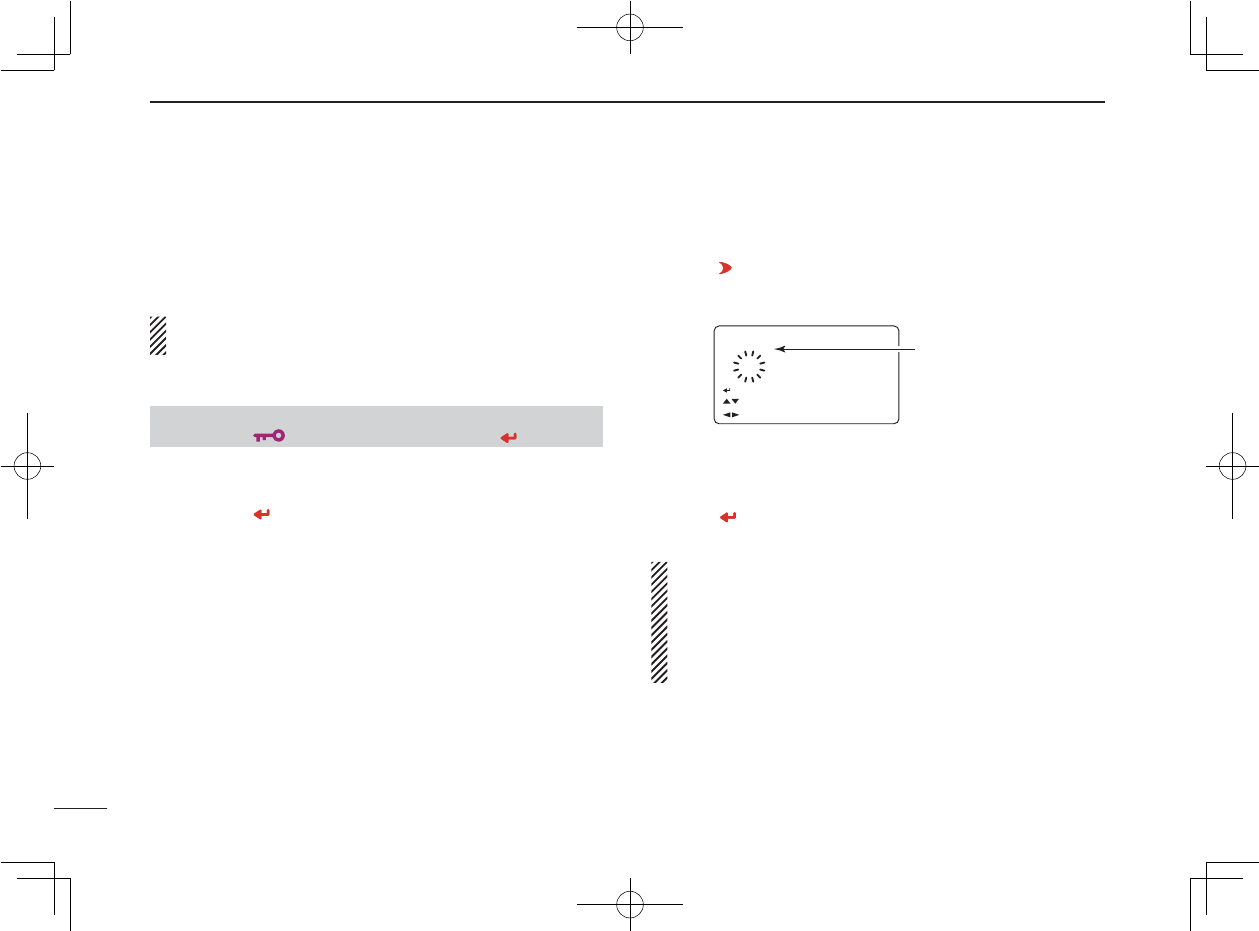
Ne
48
7DV MODE OPERATION (Optional UT-121 is required for IC-92A)
New2001
■ Copying the call sign
D Copying the call sign memory contents
This function is convenient when or modifying a part of the
current call sign.
NOTE: Make sure that the “EDIT RECORD” item in DV
set mode is set to “AUTO” or “SELECT” in advance. (p. 95)
q During DV mode operation, enter call sign set mode.
• CALL SIGN screen is displayed.
w Rotate [DIAL]† to select “UR,” “R1” or “R2” as desired,
then push [](5)†.
e Rotate [DIAL]† to select the desired call sign channel to
be copied.
• U01–U60 and R01–R60 are available.
• When “AUTO” is set to “EDIT RECORD” item
r Push [ ](6) to select the call sign programming mode.
• A blank channel is selected automatically.
• The 1st digit of the selected call sign blinks.
t Edit or modify the selected call sign as described in “D
Station call sign programming” (p. 36) or “D Repeater call
sign programming” (p. 41).
y Push [](5) to store the edited/modifi ed call sign into the
selected blank channel.
NOTE: The message “FULL” is displayed when no blank
channel is available in station or repeater call sign mem-
ory.
Select the desired call sign channel number as described
in step u of “• When “SELECT” is set to “EDIT RECORD”
item” at right-hand page in this case.
❮MENU screen❯ ➪ ❮CALL SIGN❯
(Push [MENU/ ]) (Rotate [DIAL]†, then push [ ](5)†.)
U21
U21 AB
†AAAAA
:SET
:SET
:SEL
:SEL
:CUR
:CUR
CLR:CLR
A/a:CHAR
A/a:CHAR
0:CQ
YOUR CALL SIGN
r
A blank channel
number blinks.
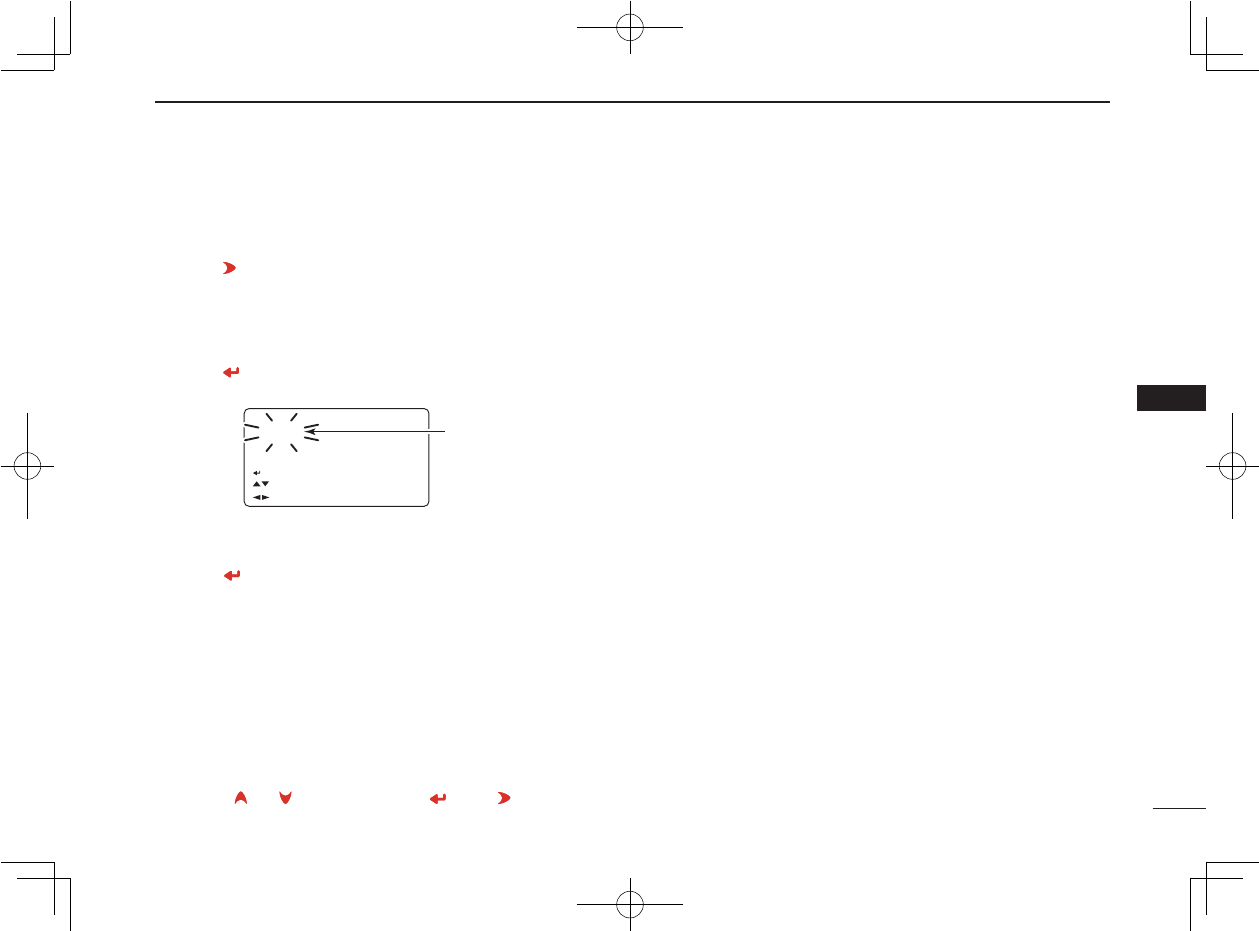
49
7
DV MODE OPERATION (Optional UT-121 is required for IC-92A)
New2001
7
• When “SELECT” is set to “EDIT RECORD” item
r Push [ ](6) to select the call sign programming mode.
• The 1st digit of the selected call sign blinks.
t Edit or modify the selected call sign as described in “D
Station call sign programming” (p. 36) or “D Repeater call
sign programming” (p. 41).
y Push [](5).
• Call sign channel number blinks.
u Rotate [DIAL]† to select the desired call sign channel to
store.
i Push [](5) to store the edited/modifi ed call sign into the
selected channel.
†[DIAL] ↔ [ ](2)/[](8) [ ](5) ↔ [ ](6)
1
2
3
4
5
6
8
9
10
11
12
13
14
15
16
17
18
19
U21 AB
AAAAA1
AAAAA1
:SET
:SEL
:CUR
CLR:CLR
CLR:CLR
A/a:CHAR
A/a:CHAR
0:CQ
YOUR CALL SIGN
YOUR CALL SIGN
r
Call sign channel
number bliks.
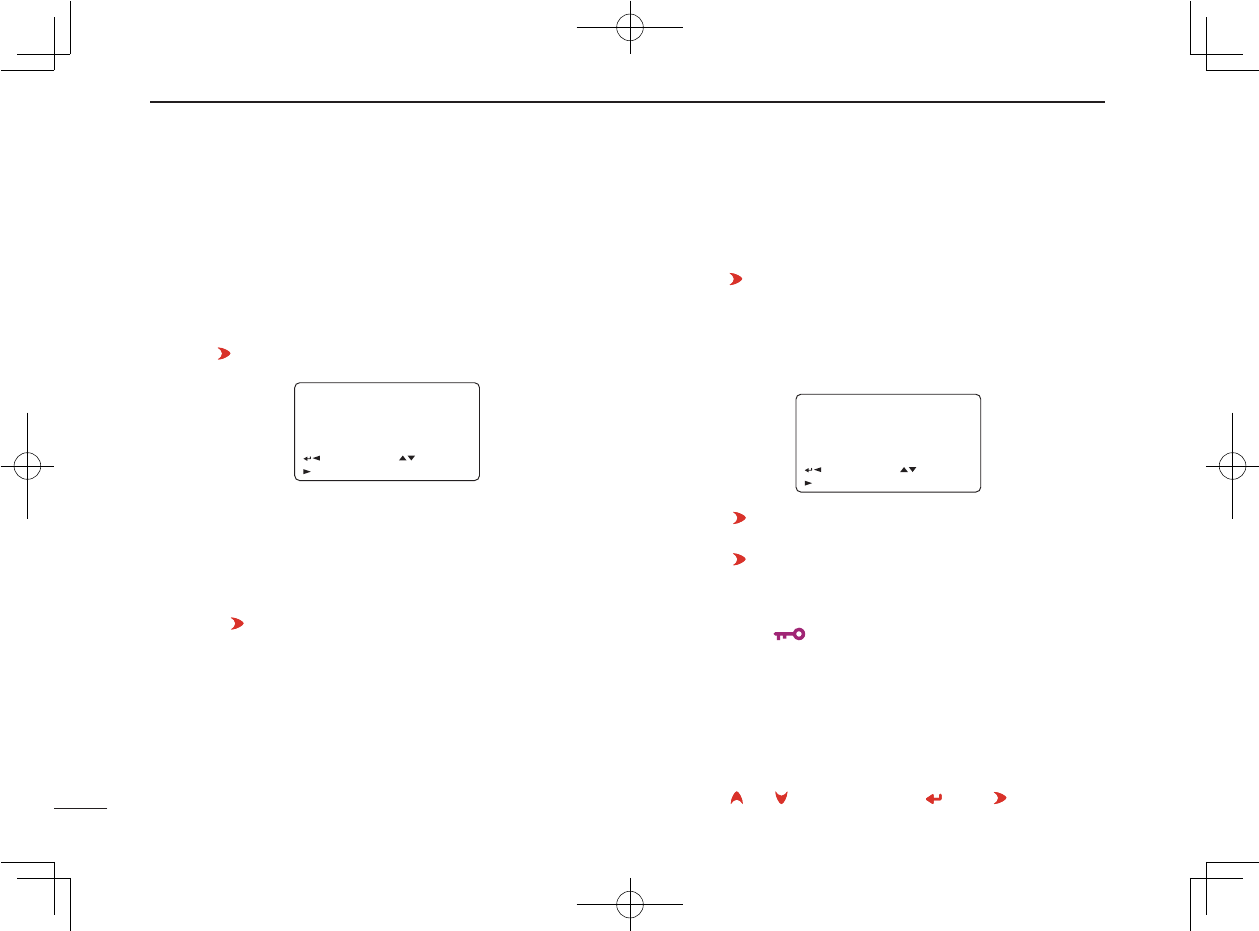
Ne
50
7DV MODE OPERATION (Optional UT-121 is required for IC-92A)
New2001
D Copying the call record contents into call sign memory
This is a way to copying the call record contents (“CALLER,”
“RXRPT1” and “RXRPT2”) into call sign memory (“UR,” “R1” and
“R2”) at the same time or individually.
q Perform the steps q to e of “D Desired call record indi-
cation” (p. 46) to select the desired call record or call sign.
w Push [](6) to select copy select mode.
• COPY SELECT screen is displayed.
e Rotate [DIAL]† to select the desired call sign to be copied
from “ALL,” “RXRPT1” and “RXRPT2.”
• “ALL” selection won’t appear when either station or repeater call
sign memory has no blank channel.
• When “ALL” is selected
➥ Push [](6) to copy the selected record’s contents into
the appropriate call sign memory.
• Returns to RX CALL SIGN screen automatically.
• When “CALLER,” “RXRPT1” or “RXRPT2” is
selected
z
Push
[ ](6) then r
otate [DIAL]
†
to select the desired con-
dition of call sign memory channel selection to be copied
to from “AUTO” and “LIST SEL.”
• “AUTO” selection won’t appear when the appropriate call sign
memory has no blank channel.
• Go to step r when “AUTO” is selected.
x Push [](6), then select the desired call sign memory
channel to copy to with [DIAL].
c Push [](6) to copy the call sign into the selected call
sign memory.
• Returns to RX CALL SIGN screen automatically.
r Push [MENU/ ] to return to frequency indication.
†[DIAL] ↔ [ ](2)/[](8) [ ](5) ↔ [ ](6)
RX01RX01
ALLALL
:BACK:BACK
:LIST:LIST C:CURR
COPY SELECTCOPY SELECT
:SEL:SEL
r
RX01
RX01
AUTO
LIST SEL
:BACK
:BACK
:LIST
:LIST
COPY SELECT
:SEL
r
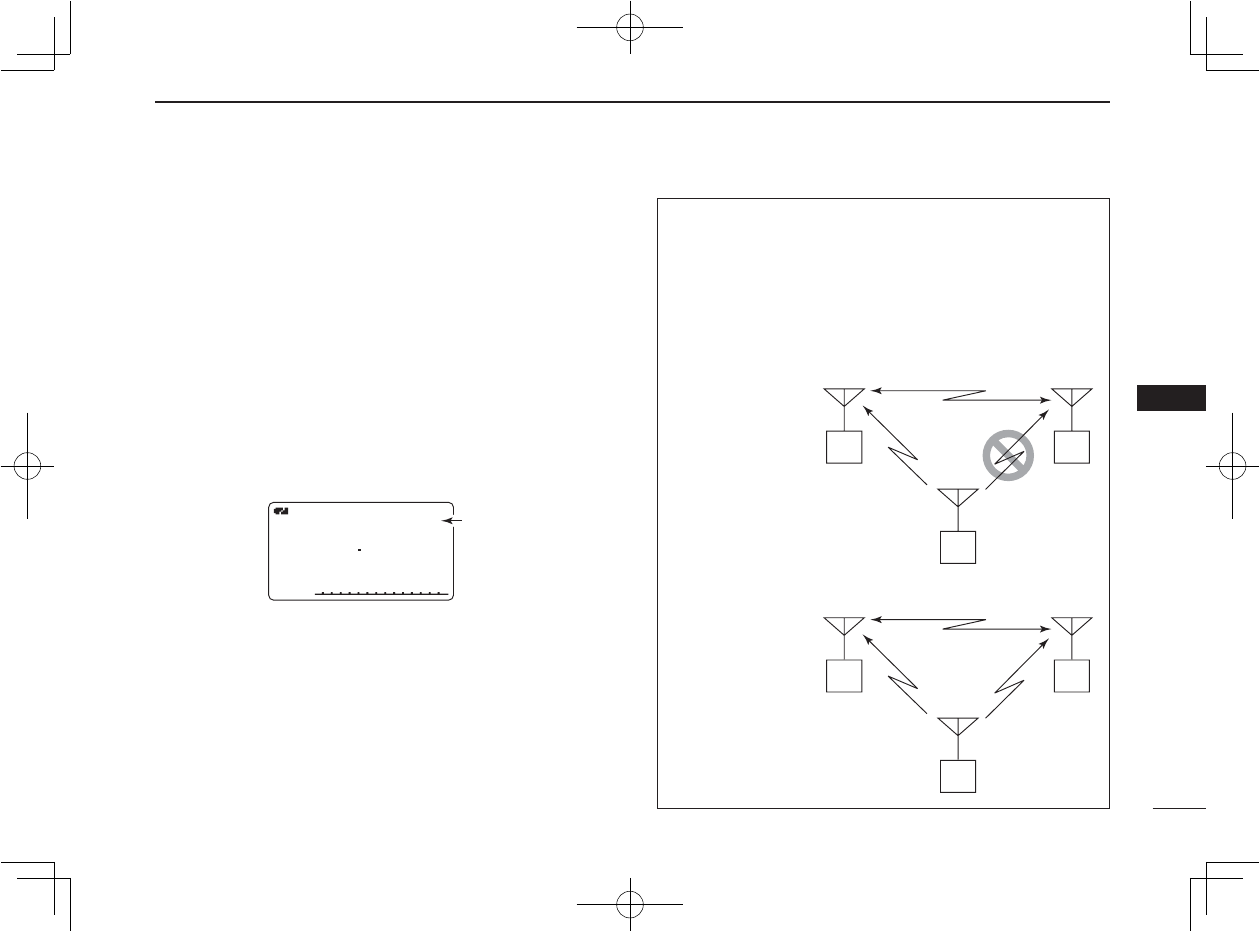
51
7
DV MODE OPERATION (Optional UT-121 is required for IC-92A)
New2001
7
■ Break-in communication
The break-in function allows you to break into a conversa-
tion, where the two original stations are communicating with
call sign squelch enabled.
q While receiving an another station’s communication, push
and hold [RX➝CS](CALL) for 1 sec. to set the communi-
cating station’s call sign.
• When a call sign has not been received correctly, error beeps
sound and no call sign is set. Receive the call sign of a commu-
nicating signal again, or set the call sign manually.
w Turn the Break-in function ON in the MENU screen opera-
tion (p. 103), then exit the MENU screen operation.
• “BK” appears.
e When both stations are in standby, push [PTT] to transmit
a break-in call.
• The programmed call sign station receives the break-in call as
well as your call sign.
r Wait for the reply call from the station who receives the
break-in call.
t After receiving the reply call, communicate normally.
y To cancel the break-in function, turn the Break-in function
OFF in the MENU screen operation (p. 103).
• How to use the break-in?
While operating with the call sign squelch (p. 110), the
squelch never opens (no audio sounds) even if a call is re-
ceived, unless your own call sign (“MY”) is specifi ed.
However, when the call including the “BK ON” signal
(break-in call) is received, the squelch will open and audio
sounds even if the call is specifi ed for another station.
1
2
3
4
5
6
8
9
10
11
12
13
14
15
16
17
18
19
BK
BK
DV
DV
B
LOW
LOW
ATT
ATT
430712
50
Appears
Station A Station B
Station C
• Station C calling to Station A with “BK OFF”
Station A Station B
Station C
• Station C calling to Station A with “BK ON”
Station A and B are
communicating
using the call sign
squelch.
Station A and B are
communicating
using the call sign
squelch.
Station B never hears that
Station C is calling Station A.
Station B also hears that
Station C is calling Station A.
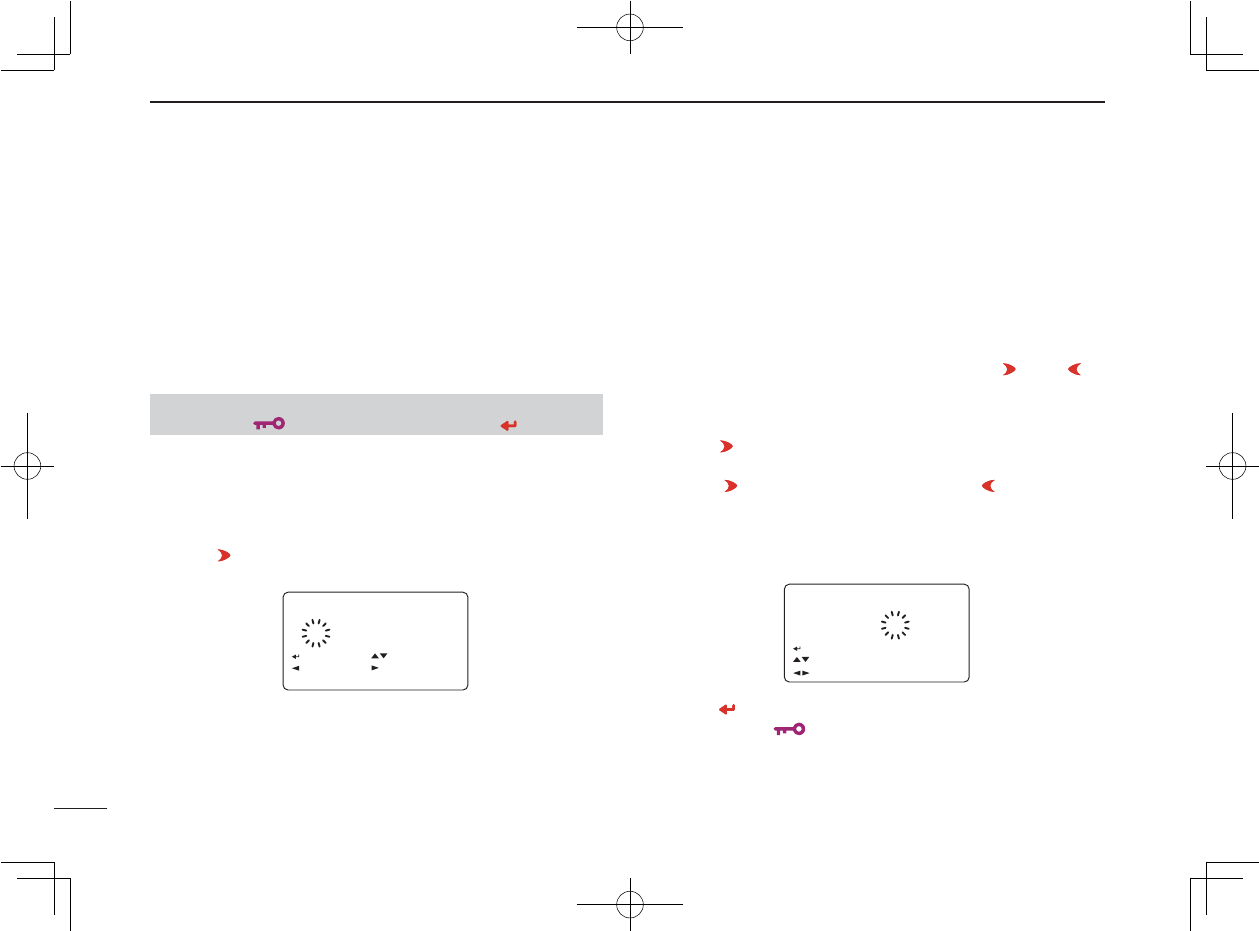
Ne
52
7DV MODE OPERATION (Optional UT-121 is required for IC-92A)
New2001
■ Message operation
D TX message programming
TX messages are available for up to 5 channels and each
channel can be programmed with a message of up to 20
characters. Available characters are 0 to 9, A to Z (capital let-
ters), a to z (lower case letters), some symbols and space.
q Enter “TX MESSAGE” in message/position set mode.
• TX MESSAGE screen is displayed.
w Rotate [DIAL]† to select the desired transmit message
channel.
• Ch01 to Ch05 and OFF are available.
• Previously message is displayed if programmed.
e Push [ ](6) to select the message edit condition.
• The 1st digit of the message blinks.
r Rotate [DIAL]† to select the desired character or symbol.
• Push [A/a](3) to change the character group from “AB” (alpha-
betical characters; capital letters), “ab” (alphabetical characters;
lower case letters), “12” (numbers) and “-!”-” (symbols) in se-
quence.
• If an un-necessary character is entered, push [](6) or [](4)
to select the character, then push [CLR](1) to erase the se-
lected character, or push and hold [CLR](1) for 1 sec. to erase
all characters following the cursor.
t Push [ ](6) to select 2nd digit, then rotate [DIAL]† to se-
lect the desired character or code.
• Push [](6) to move the cursor right; push [](4) to move the
cursor left.
• 2nd digit blinks (1st digit stops blinking).
y Repeat the steps r and t to enter the desired message.
• Up to 20-character messages can be set.
u Push [ ](5) to store the message.
i Push [MENU/ ] to return to frequency indication.
❮MENU screen❯ ➪ ❮MESSAGE/POSITION❯ ➪ ❮TX MESSAGE❯
(Push [MENU/ ]) (Rotate [DIAL]†, then push [ ](5)†.)
Ch01
Ch01
†
:SET
:SET
:SEL
:SEL
:BACK
:BACK
CLR:CLR
CLR:CLR
TX MESSAGE
:EDIT
:EDIT
r
Ch01
Ch01 !''
Hello!
†
:SET
:SET
:SEL
:SEL
:CUR
:CUR
CLR:CLR
A/a:CHAR
A/a:CHAR
TX MESSAGE
r
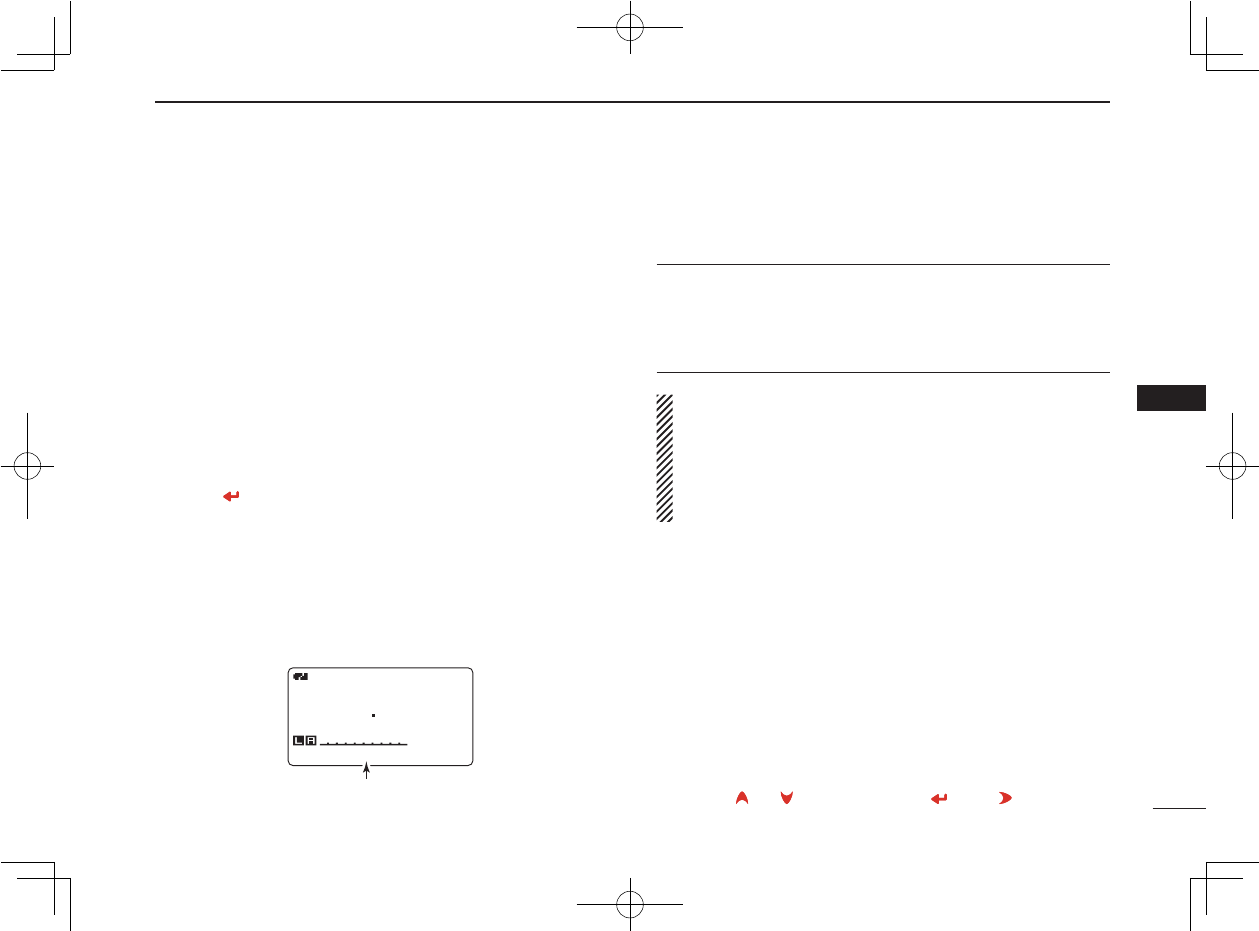
53
7
DV MODE OPERATION (Optional UT-121 is required for IC-92A)
New2001
7
D Message Transmission
Select the message transmission function ON (Ch01–05) and
OFF. When a message channel is selected, the transceiver
transmits a text message (pre-programmed). (default: OFF)
q Set the operating frequency, call signs and other settings,
such as repeater, as desired in B band.
w Perform the steps q to e in “D TX message program-
ming” as at left.
e Rotate [DIAL]† to select the desired message channel.
• “Ch01” to “Ch05” available.
• See left-hand pages for message programming.
r Push [ ](5) to set the message for transmission.
t Push [PTT] to transmit the selected message.
• The message is transmitted each time [PTT] is pushed.
• The message is transmitted each 30 sec. automatically during
continuous transmission.
y Release [PTT] to return to receive.
u When the reply call with a message is received, the call
sign and the message scrolls at the bottom of the function
display.
✔ For your information
The automatic received call sign and/or message indication
can be turned OFF in display set mode, if desired.
➥ RX CALL SIGN (p. 100)
➥ RX MESSAGE (p. 101)
NOTE: Only 1 message can be stored in the IC-92A/
92AD. The received message is cleared by turning power
OFF, or overwritten when another message is received.
A transmitted message that includes lower case charac-
ters from the IC-92A/92AD may not be decoded and dis-
played correctly by the ID-800H, IC-V82/U82, etc.
†[DIAL] ↔ [ ](2)/[](8) [ ](5) ↔ [ ](6)
1
2
3
4
5
6
8
9
10
11
12
13
14
15
16
17
18
19
DV
DV
B
430712
50
MSG:Hello!
MSG:Hello!
Scrolls the received message.
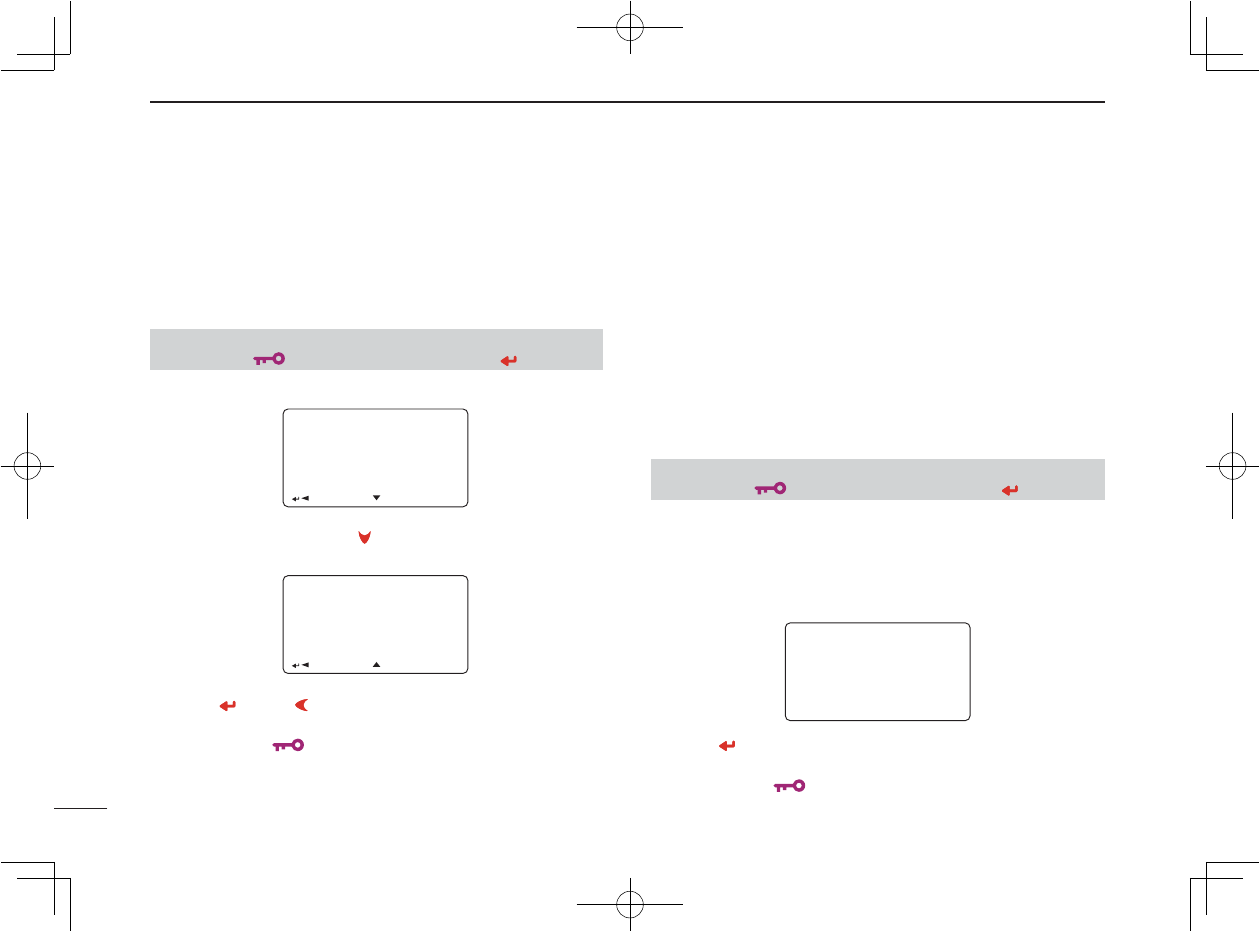
Ne
54
7DV MODE OPERATION (Optional UT-121 is required for IC-92A)
New2001
D RX message indication
The received message can also be checked in DV set mode.
q Select “RX MESSAGE” in message/position set mode.
• The received message is displayed in RX MESSAGE screen.
w Rotate [DIAL] or push [](8) to display the station call
sign.
e Push [](5) or [](4) to return to MESSAGE/POSITION
screen.
r Push [MENU/ ] to return to frequency indication.
■ Automatic reply function
The automatic reply function replies to calls by a station that
specifi ed your call sign.
Two methods of replying are available— one is making a
reply call with your own call sign, and other one is making
a reply call with reply voice audio that has been recorded in
DV voice memory.
D Automatic reply function setting
q Enter “AUTO REPLY” in DV set mode. (p. 92)
• AUTO REPLY screen is displayed.
w Rotate [DIAL]† to select the desired reply condition.
OFF : Deactivate the automatic reply function. (default)
ON : Reply to the call with your own call sign.
VOICE :
Reply to the call with the recorded voice memory.
e Push [ ](5).
• Returns to DV SET MODE screen automatically.
r Push [MENU/ ] to return to frequency indication.
❮MENU screen❯ ➪ ❮MESSAGE/POSITION❯ ➪ ❮RX MESSAGE❯
(Push [MENU/ ]) (Rotate [DIAL]†, then push [ ](5)†.)
MESSAGE:MESSAGE:
Hello!Hello!
:CALLER:CALLER
:BACK:BACK
RX MESSAGE
r
CALLER:CALLER:
BBBBBB BBBBBB
/ /
:MSG:MSG
:BACK:BACK
RX MESSAGE
r
❮MENU screen❯ ➪ ❮DV SET MODE❯ ➪ ❮AUTO REPLY❯
(Push [MENU/ ]) (Rotate [DIAL]†, then push [ ](5)†.)
OFF
ON
VOICE
VOICE
AUTO REPLY
AUTO REPLY
r
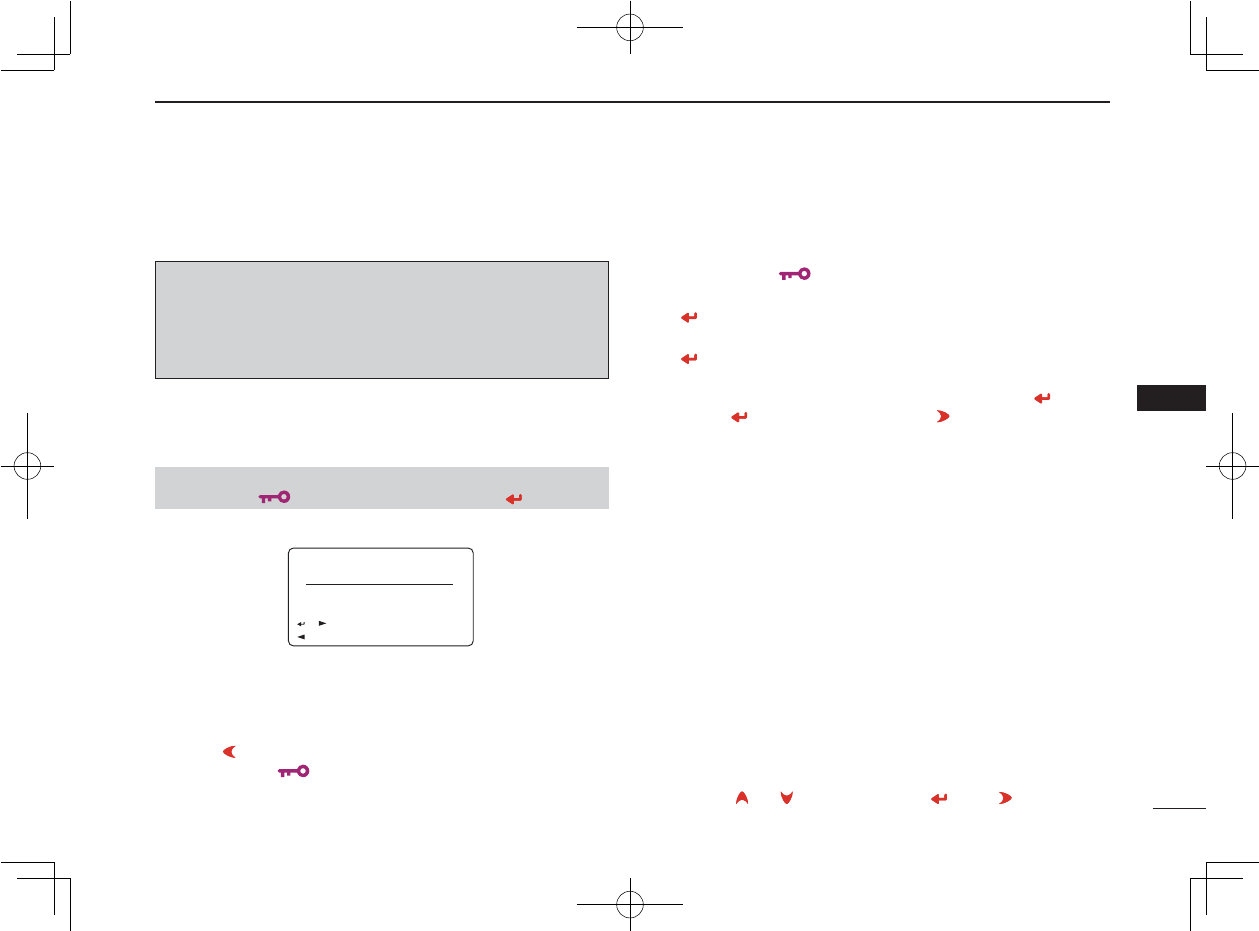
55
7
DV MODE OPERATION (Optional UT-121 is required for IC-92A)
New2001
7
D Voice memory recording for automatic reply
q Select DV mode in B band, and deactivate the priority
watch (p. 83) and weather alert function (p. 114) if activated.
w Enter “REPLY VOICE” in DV voice memo set mode.
• REPLY VOICE screen is displayed.
e While pushing and holding [PTT], speak into the micro-
phone.
• Up to 10 seconds of message is recordable.
• The recording stops after 10 second or when [PTT] is released.
r Push [ ](4) to return to DV VOICE MEMO screen.
t Push [MENU/ ] to return to frequency indication.
D Play-back or erase the voice memory
q Push [MENU/ ] to select menu mode indication.
w Rotate [DIAL]† to select “DV VOICE MEMO,” then push
[](5)†.
e Rotate [DIAL]† to select “REPLY VOICE,” then push
[](5)†.
• REPLY VOICE screen is displayed.
r To play-back the recorded voice memory, push [ ](5).
• Push [](5) again to pause, push [](6) to cancel the play-
back.
t To erase the recorded voice memory, push and hold
[CLR](1) for 1 sec.
†[DIAL] ↔ [ ](2)/[](8) [ ](5) ↔ [ ](6)
1
2
3
4
5
6
8
9
10
11
12
13
14
15
16
17
18
19
IMPORTANT!
Deactivate the dualwatch function and set minimum [VOL]
level when recording the DV voice memo.
Otherwise received audio or unwanted noise from A band
is also recorded into the voice memory.
❮MENU screen❯ ➪ ❮DV VOICE MEMO❯ ➪ ❮REPLY VOICE❯
(Push [MENU/ ]) (Rotate [DIAL]†, then push [ ](5)†.)
REPLY V
REPLY V
PTT:
●
:BACK
:BACK
CLR:CLR
CLR:CLR
REPLY VOICE
REPLY VOICE
:
r
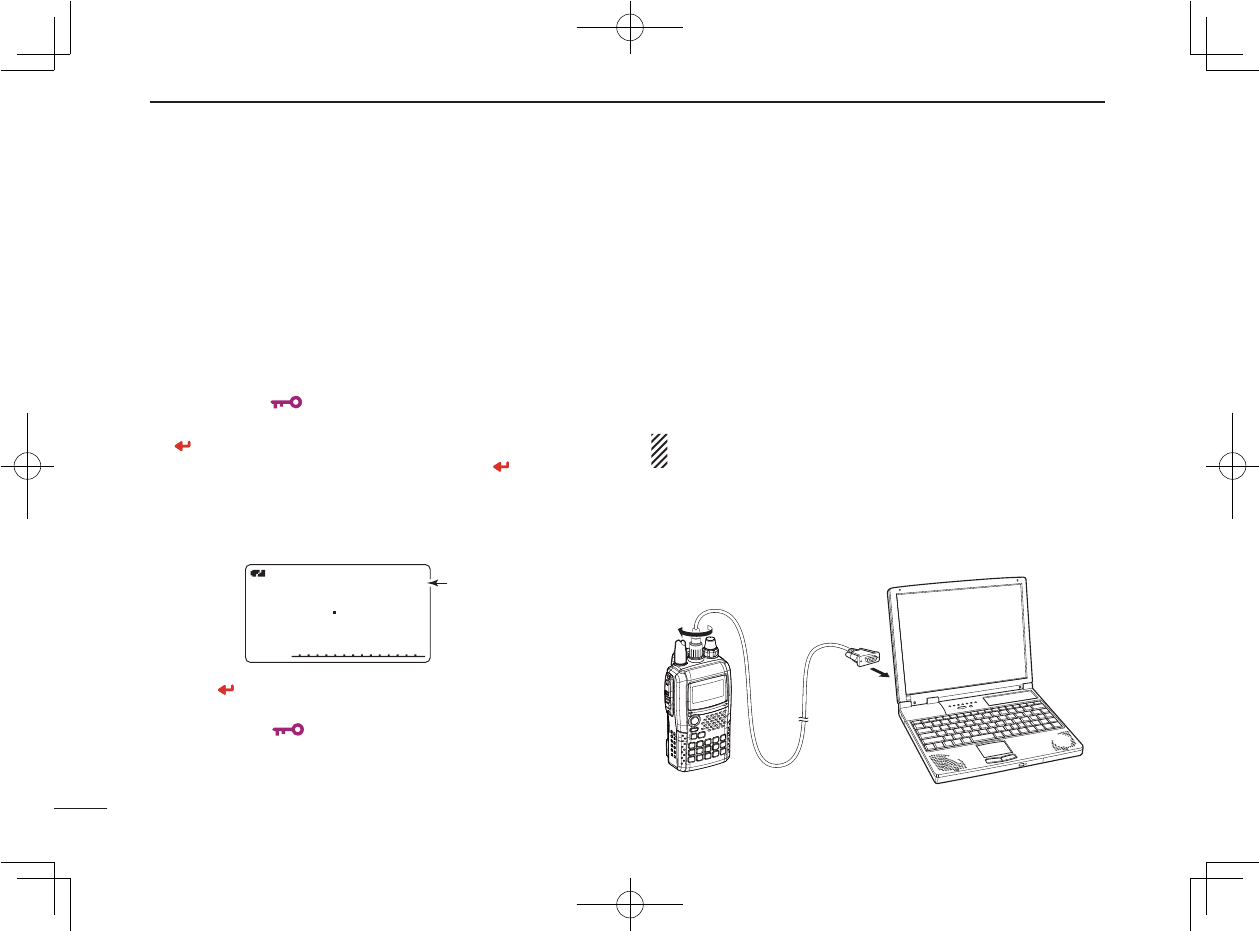
Ne
56
7DV MODE OPERATION (Optional UT-121 is required for IC-92A)
New2001
■ EMR communication
The EMR communication mode is available for digital mode
operation. In the EMR communication mode, no call sign
setting is necessary. When an EMR communication mode
signal is received, the audio (voice) will be heard at the
specified level even the volume setting level is set to mini-
mum level, or digital call sign/digital code squelch is in use.
q Set the desired frequency in 144 or 440 MHz band then
push [MENU/ ] to select menu mode indication.
w Rotate [DIAL]† to select “DV SET MODE,” then push
[](5)†.
e Rotate [DIAL]† to select “EMR,” then push [ ](5)†.
r Rotate [DIAL]† to select the desired reply condition.
OFF : The EMR communication sets OFF. (default)
ON : The EMR communication sets ON.
• “EMR” appears when selecting "ON".
t Push [ ](5).
• Returns to DV SET MODE screen automatically.
y Push [MENU/ ] to return to frequency indication.
■
Low-speed data communication
In addition to the digital voice communication, low-speed
data communication is available.
The optional OPC-1799 DATA COMMUNICATION CABLE and
serial data communication software (purchase locally) are re-
quired in addition.
The optional RS-92 REMOTE CONTROL SOFTWARE (OPC-1799
supplied) also includes a low-speed data communication ca-
pability.
NOTE: Turn OFF the GPS mode (p. 58) in advance to op-
erate the low-speed data communication.
D Connection
Connect the transceiver to your PC using with the optional
OPC-1799 as illustrated below.
EMR
EMR
DV
DV
B
430712
50
Appears to [MIC/SP/DATA]
OPC-1799
(optional)
to
RS-232C
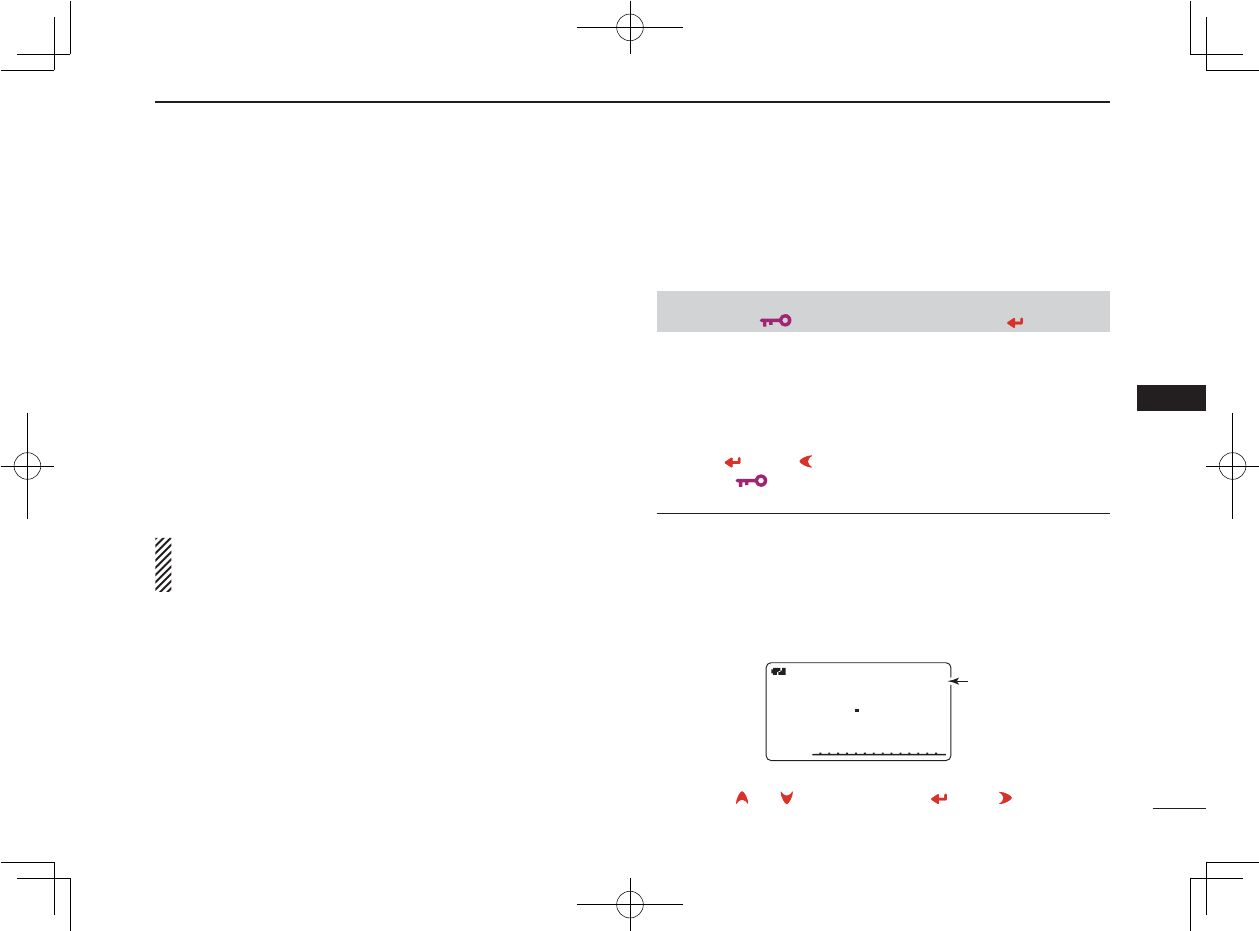
57
7
DV MODE OPERATION (Optional UT-121 is required for IC-92A)
New2001
7
D Low-speed data communication application
setting
Confi gure the low-speed data communication application as
follows.
• Port : The same COM port number as IC-92A/
92AD’s
• Baud rate : 38.4 kbps (fi xed value)
• Data : 8 bit
• Parity : None
• Stop : 1 bit
• Flow control : Xon/Xoff
D Low-speed data communication operation
NOTE: Confi rm that in AUTO, the computer controls when
[PTT] is activated to send data and the user doesn’t have
to operate the radio.
q Set your own, station call signs, etc. as described in
“■ Digital voice mode operation” (p. 38) and “■ Digital re-
peater operation” (p. 41).
w Refer to the instructions of the low-speed data communi-
cation application.
e To transmit data
• With your voice audio, push and hold [PTT] to transmit while
sending data from the PC. Release [PTT] to receive.
• Under computer control, see Transmission condition setting at
right.
D Transmission condition setting
q Enter “DV DATA TX” in DV set mode. (p. 92)
w Rotate [DIAL]† to select “PTT” or “AUTO.”
PTT : The input data from [MIC/SP/DATA] are transmit-
ted when pushing [PTT]. (default)
AUTO : The input data from [MIC/SP/DATA] are transmit-
ted automatically when the data are input.
e Push [](5) (or [ ](4)) to return to DV set mode, and push
[MENU/ ] to return to frequency indication.
✔ For your information
While operating low-speed data communication via the inter-
net network from one zone to another zone, some packets
may be lost due to the network trouble (poor data throughput
performance). In such a case, the IC-92A/92AD displays an
“L” in the upper right corner on the display to indicate Packet
Loss has occured.
†[DIAL] ↔ [ ](2)/[](8) [ ](5) ↔ [ ](6)
1
2
3
4
5
6
8
9
10
11
12
13
14
15
16
17
18
19
❮MENU screen❯ ➪ ❮DV SET MODE❯ ➪ ❮DV DATA T X❯
(Push [MENU/ ]) (Rotate [DIAL]†, then push [ ](5)†.)
L
DV
DV
B
430712
50
Appears
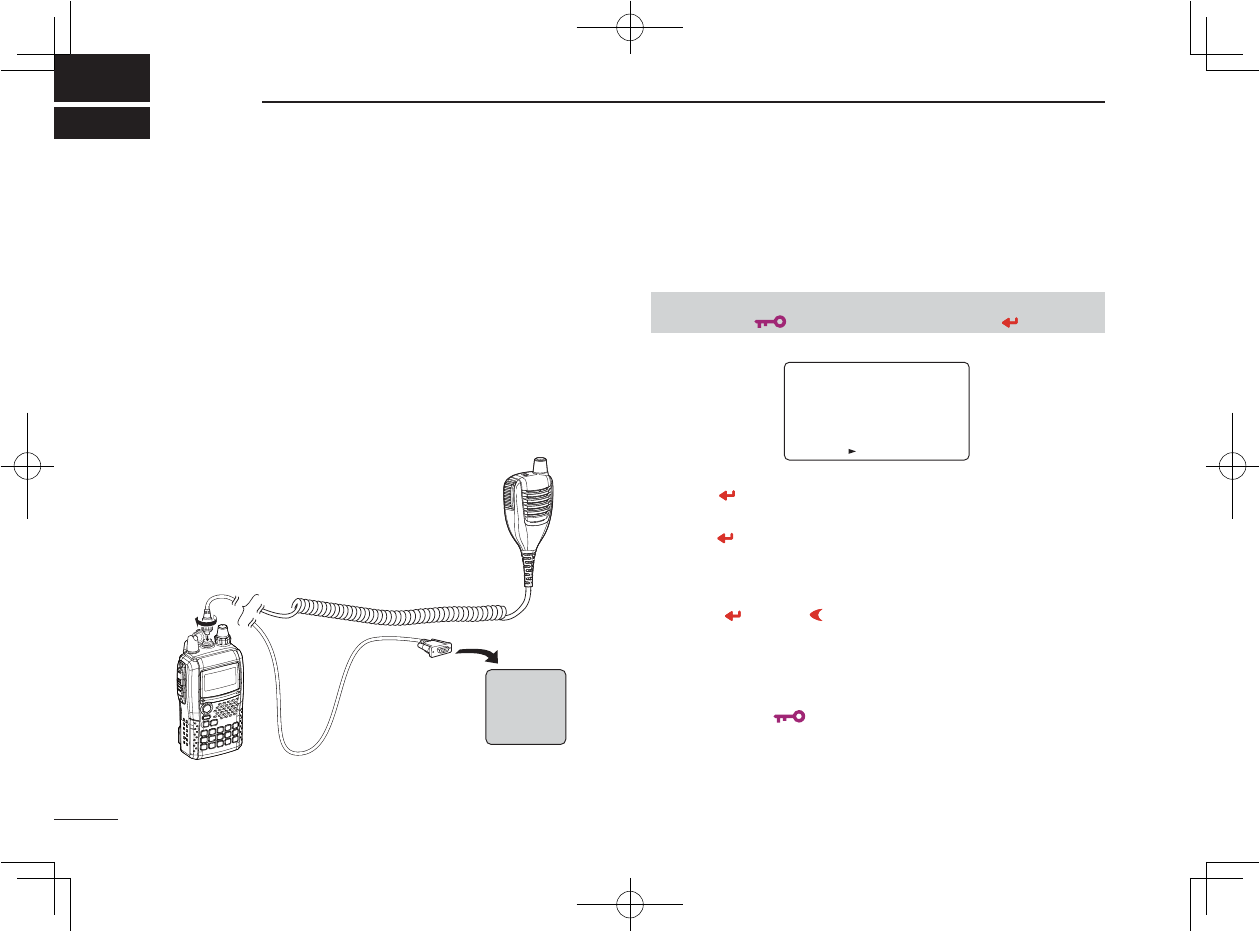
58
New2001
GPS/GPS-A OPERATION (Optional UT-121 is required for IC-92A)
8
Ne
■ GPS operation
Dipslaying (FM/AM/DV mode) or transmitting (DV mode
only) GPS data is available when connecting a 3rd party
GPS receiver* (RS-232C output/NMEA format) and optional
HM-175GPS (GPS speaker microphone). GPS data pass
through the [DATA/SP/MIC] socket of the IC-92A/92AD.
In addition, the GPS message transmission is also available
for the GPS mode operation.
*GPS receiver with RS-232C terminal is required.
* Set “GPS TX MODE” to “GPS” or “GPS-A” at r operation of right
colum when connecting a 3rd party GPS receiver.
D Sentence formatter setting
q Enter “GPS MODE” in DV set mode. (p. 94)
• GPS TX MODE screen is displayed.
w Rotate [DIAL]† to select “GPS.”
e Push [](5)† to select GPS SENTENCE screen.
r Rotate [DIAL]† to select the desired GPS sentence, then
push [](5).
• A total 6 sentences, RMC, GGA, GLL, GSA, VTG and GSV are
available.
t Rotate [DIAL]† to turn the sentence usage ON and OFF.
y Push [](5) (or [](4)) to return to GPS SENTENCE
screen.
u Repeat the steps r to y to set another GPS sentence
usage.
• Up to 4 GPS sentences are usable at the same time.
i Push [MENU/ ] to return to frequency indication.
OPC-1799
(optional)
HM-175GPS
(optional)
to [DATA/SP/MIC]
to RS-232C port
(null modem
adapter is required)
GPS
receiver
❮MENU screen❯ ➪ ❮DV SET MODE❯ ➪ ❮GPS TX MODE❯
(Push [MENU/ ]) (Rotate [DIAL]†, then push [ ](5)†.)
OFF
GPS
GPS-A
GPS-A
GPS TX MODE
:SENTENCE
:SENTENCE
r
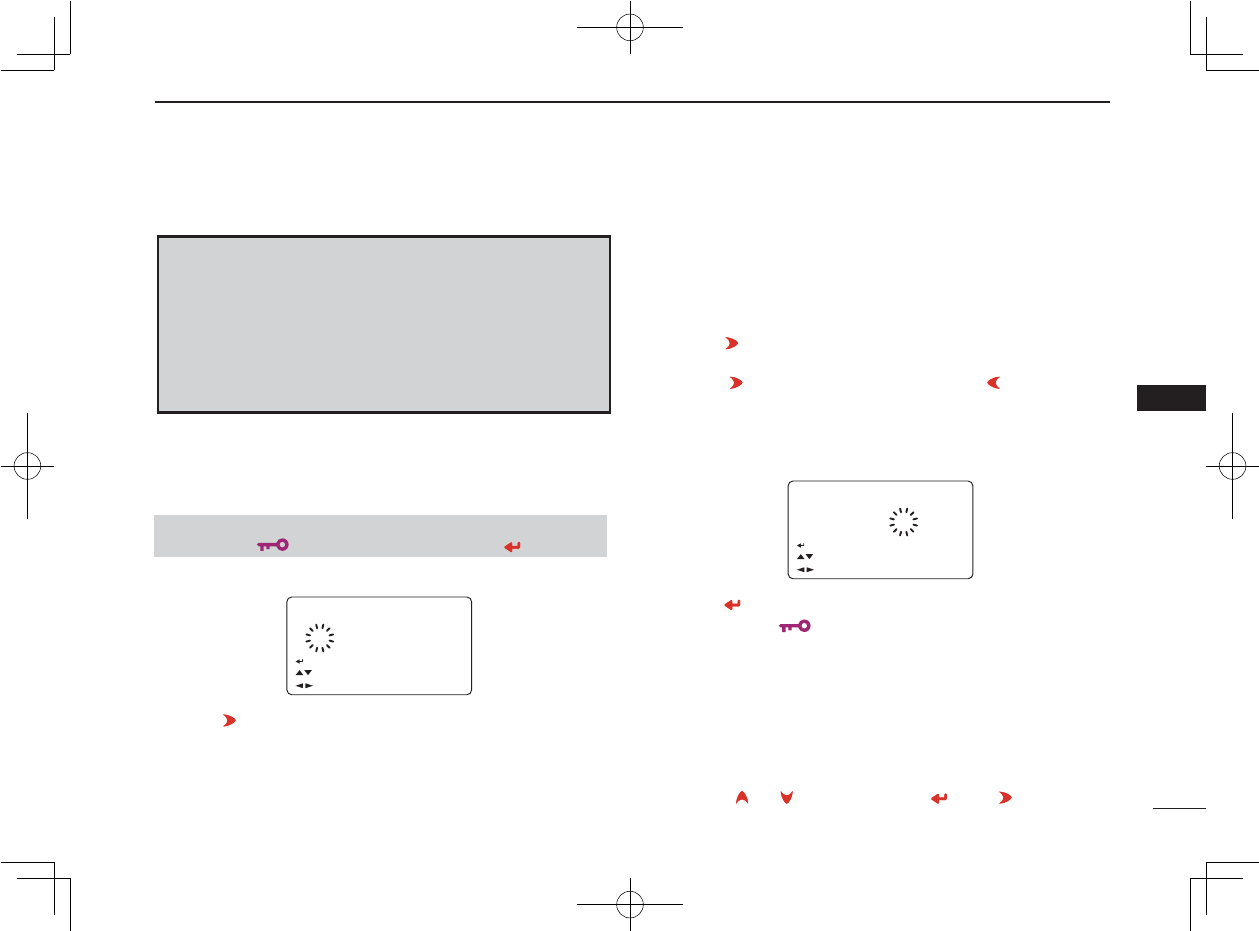
59
8
GPS/GPS-A OPERATION (Optional UT-121 is required for IC-92A)
New2001
7
1
2
3
4
5
6
8
9
10
11
12
13
14
15
16
17
18
19
D GPS message programming
q Enter “GPS” in message/position set mode.
• GPS MESSAGE screen is displayed.
w Push [ ](6) to select the message edit condition.
• The 1st digit of the message blinks.
e Rotate [DIAL]† to select the desired character or symbol.
• Push [A/a](3) to change the character group from “AB” (alpha-
betical characters; capital letters), “ab” (alphabetical characters;
lower case letters), “12” (numbers) and “!”” (symbols) in se-
quence.
r Push [ ](6) to select 2nd digit, then rotate [DIAL]† to se-
lect the desired character or code.
• Push [](6) to move the cursor right; push [](4) to move the
cursor left.
• 2nd digit blinks (1st digit stops blinking).
t Repeat the steps r and t to enter the desired message.
• Up to 20-character messages can be set.
y Push [ ](5) to store the message.
u Push [MENU/ ] to return to frequency indication.
❮MENU screen❯ ➪ ❮MESSAGE/POSITION❯ ➪ ❮GPS❯
(Push [MENU/ ]) (Rotate [DIAL]†, then push [ ](5)†.)
DATA:
DATA: AB
†
:SET
:SET
:SEL
:SEL
:CUR
:CUR
CLR:CLR
CLR:CLR
GPS MESSAGE
GPS MESSAGE
A/a:CHAR
A/a:CHAR
r
DATA:
DATA: AB
Hello!
†
:SET
:SEL
:CUR
CLR:CLR
GPS MESSAGE
A/a:CHAR
r
†[DIAL] ↔ [ ](2)/[](8) [ ](5) ↔ [ ](6)
NOTE: Set the GPV sentence is OFF when sending the
GPS message to conventional digital transceivers
(IC-2820/E2820,IC-D800,IC-91AD/E91,IC-V85).
GPV sentence is incompatible with them. There-
fore, those transceivers cannot display GPS mes-
sages properly when sending the GPS message
from IC-92AD with GPV sentense is available con-
dition.
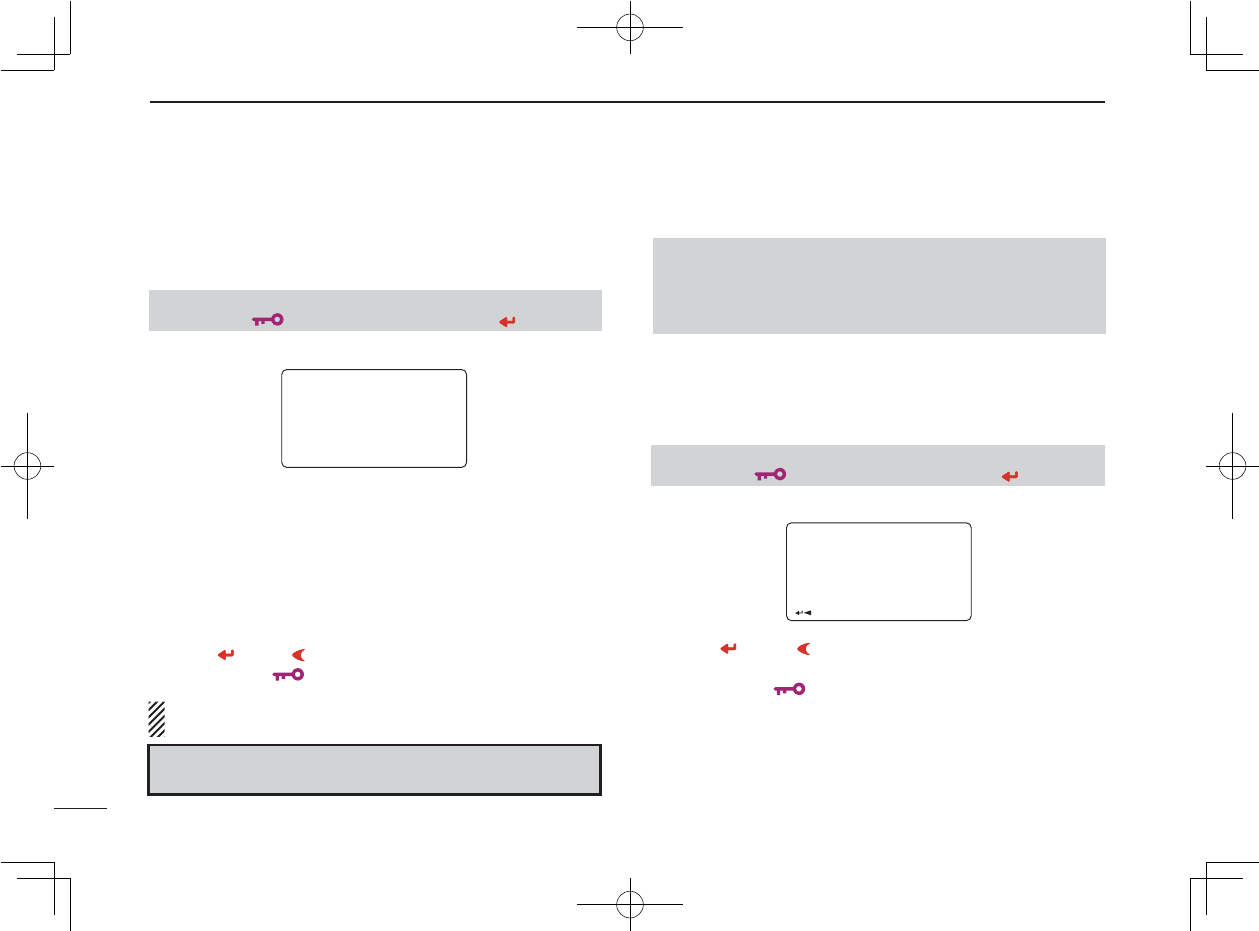
60
8GPS/GPS-A OPERATION (Optional UT-121 is required for IC-92A)
New2001
D GPS message automatic transmission
q Enter “GPS AUTO TX” in DV set mode. (p. 95)
• GPS AUTO TX screen is displayed.
w Rotate [DIAL]† to select the desired position data trans-
mitting interval from 5 sec., 10 sec., 30 sec., 1 min., 3
min., 5 min., 10 min., 30 min. and OFF.
• The position data is transmitted only when [PTT] is pushed with
OFF setting, the data is transmitted automatically once every
5 sec., 10 sec., 30 sec., 1 min., 3 min., 5 min., 10 min. and 30
min. when the appropriate setting is selected.
• The GPS message is also transmitted if programmed.
e Push [ ](5) (or [ ](4)) to return to DV SET MODE screen.
r Push [MENU/ ] to return to frequency indication.
NOTE: Your own call sign (“MY”) should be set to activate
the GPS automatic transmission.
D Received GPS message indication
q Enter “RX GPS” in message/position set mode.
• RX GPS MESSAGE screen is displayed.
w Push [](5) (or [](4)) to return to MESSAGE/POSITION
screen.
e Push [MENU/ ] to return to frequency indication.
Ne
❮MENU screen❯ ➪ ❮DV SET MODE❯ ➪ ❮GPS AUTO TX❯
(Push [MENU/ ]) (Rotate [DIAL]†, then push [ ](5)†.)
OFF
OFF
5SEC
5SEC
10SEC
10SEC
30SEC
30SEC
1MIN
1MIN
GPS AUTO TX
r
❮MENU screen❯ ➪ ❮MESSAGE/POSITION❯ ➪ ❮RX GPS❯
(Push [MENU/ ]) (Rotate [DIAL]†, then push [ ](5)†.)
DATA:
DATA:
Call from
Call from
Osaka!
Osaka!
:BACK
:BACK
RX GPS MESSAGE
r
[NOTICE]
USE GPS message automatic transmission at simplex mode.
Sending with GPS message automatic transmission through the
repeater may interfere with other amateur radio.
[NOTICE]
“5SEC” cannot select when 4 GPS sentences are selected.
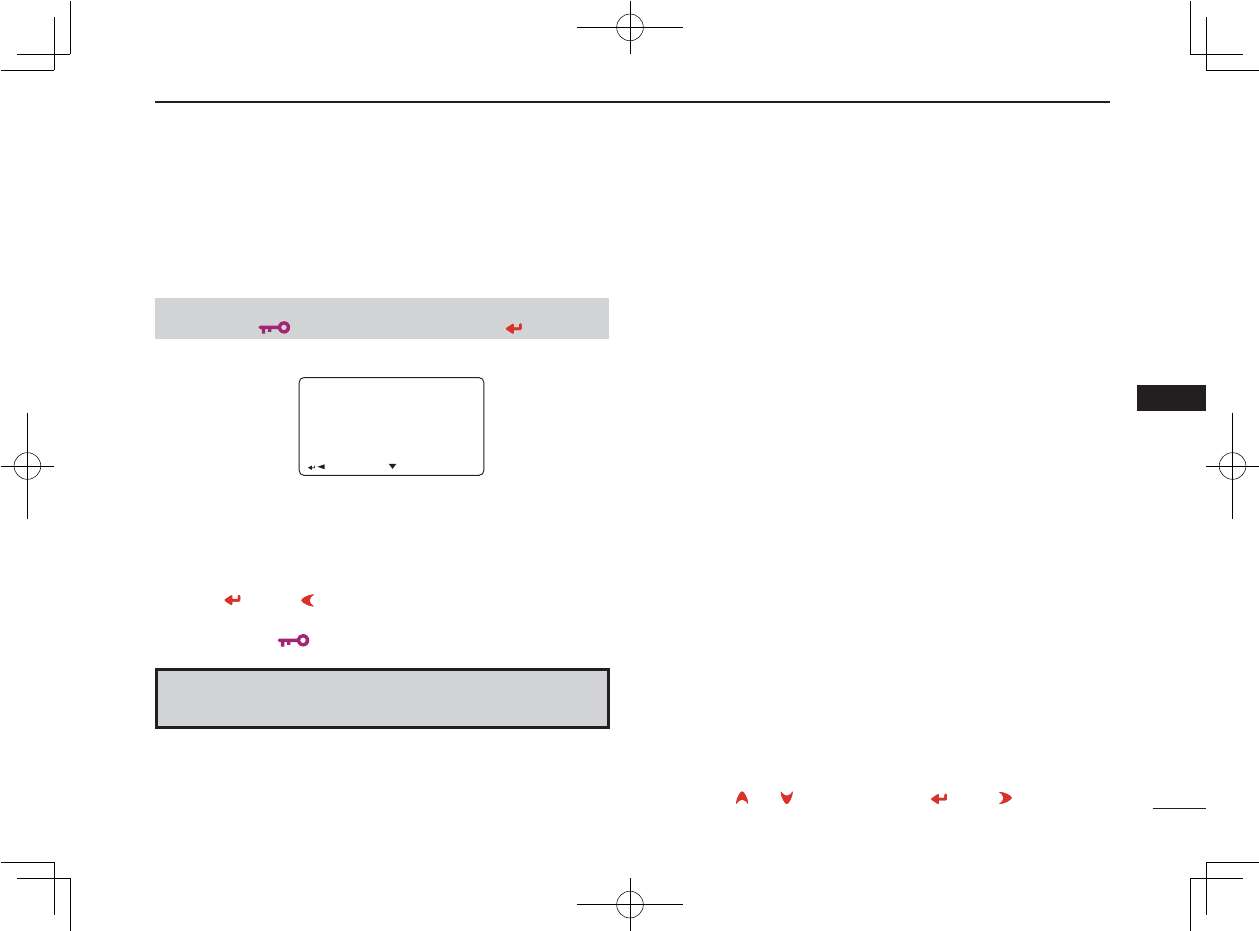
61
8
GPS/GPS-A OPERATION (Optional UT-121 is required for IC-92A)
New2001
7
D Position indication
q Enter “POSITION” in message/position set mode.
• GPS POSITION screen is displayed.
w Rotate [DIAL]† to select the received position data indica-
tion.
• MY POSITION and ELEVATION or RX POSITION and DIS-
TANCE display at the same tine when selecting SMALL on the
FONT SIZE in the set mode.
e Push [](5) (or [](4)) to return to MESSAGE/POSITION
screen.
r Push [MENU/ ] to return to frequency indication.
[Indication items]
• MY POSITION : Displaying own latitude and longitude.
• RX POSITION : Displaying other station latitude and longitude.
• ELEVATION : Displaying own elevation and the time.
• DIATANCE : Displaying distance from other station.
D Saving own/received position data
q Operate q – r of “Position indication” (See left column),
and select the desired position data.
w Push and hold [S.MR](MR) for 1 sec. to save the selected
position data to GPS memory (CH00).
• The M-CH number brings forward automatically in case the next
M-CH is already stored.
• 100 GPS M-CH are available.
• Push [MR] to display stored postion data.
1
2
3
4
5
6
8
9
10
11
12
13
14
15
16
17
18
19
†[DIAL] ↔ [ ](2)/[](8) [ ](5) ↔ [ ](6)
❮MENU screen❯ ➪ ❮MESSAGE/POSITION❯ ➪ ❮POSITION❯
(Push [MENU/ ]) (Rotate [DIAL]†, then push [ ](5)†.)
MY POSITION
MY POSITION
GPS POSITION
GPS POSITION
r
34.56.789 N
34.56.789 N
123.45.678 E
123.45.678 E
:RX POS
:RX POS
:BACK
:BACK
NOTE: The ELEVATION may be changed by received sig-
nal strength.
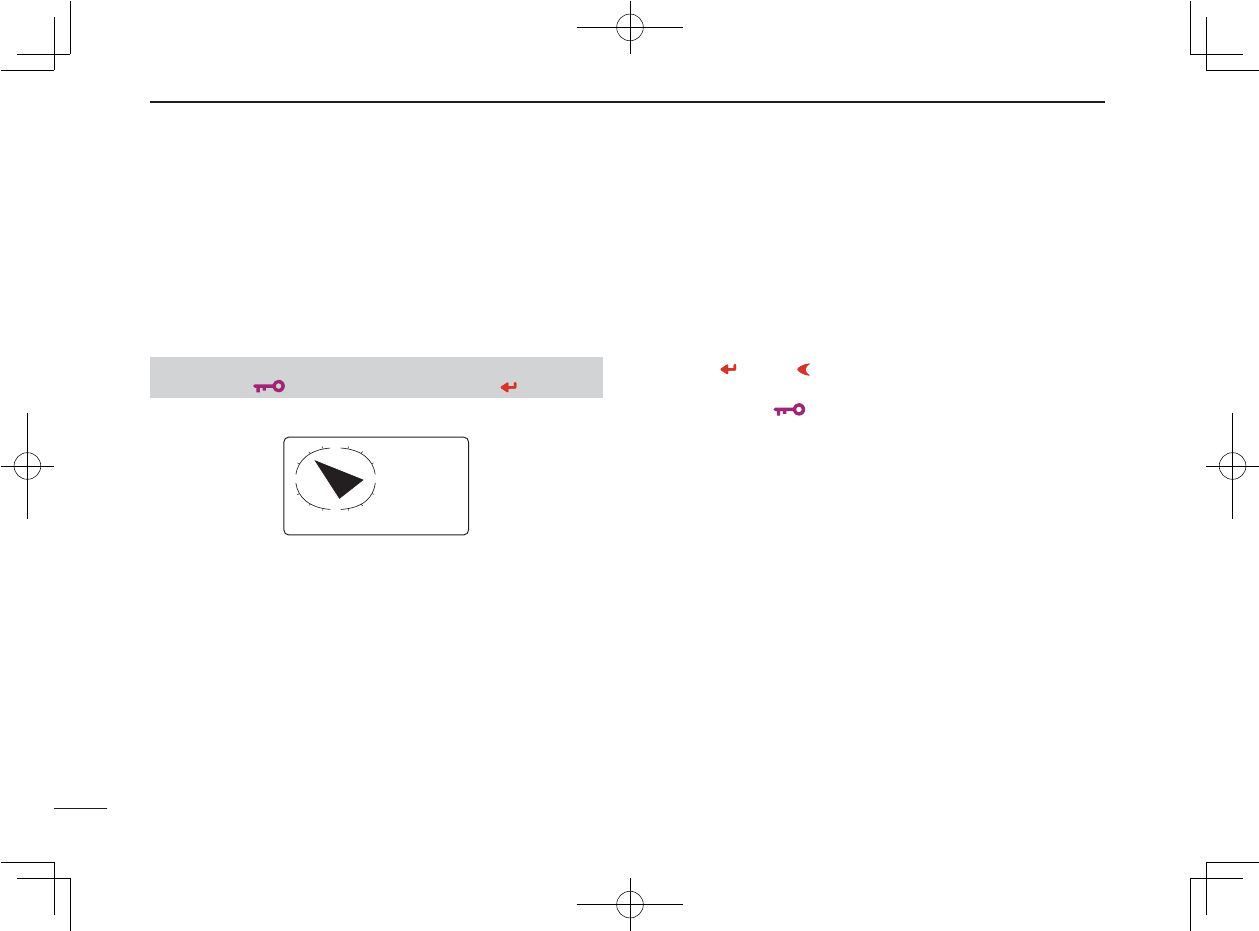
Ne
62
8GPS/GPS-A OPERATION (Optional UT-121 is required for IC-92A)
New2001
D Displaying own/received position data with
compass
Displaying the own direction, received station’s direction and
setting direction in the GPS memory.
q Enter “COMPAS” in message/position set mode.
• COMPAS screen is displayed.
w Rotate [DIAL]† to select the received position data indica-
tion.
• MY, RX or SET is available.
[Indication items]
• MY : Displaying own latitude, longitude, elevation, the time
and direction.
• RX : Displaying other station latitude, longitude, distance
from own and direction.
• SET : Displaying latitude, longitude, distance from own and
direction of alarm setting for GPS memory.
e Push and hold [S.MR](MR) for 1 sec. to save the selected
position data to GPS memory (CH00).
• The M-CH number brings forward automatically in case the next
M-CH is already stored.
• 100 GPS M-CH are available.
• Push [MR] to display stored postion data.
r Push [](5) (or [](4)) to return to MESSAGE/POSITION
screen.
t Push [MENU/ ] to return to frequency indication.
❮MENU screen❯ ➪ ❮MESSAGE/POSITION❯ ➪ ❮COMPAS❯
(Push [MENU/ ]) (Rotate [DIAL]†, then push [ ](5)†.)
35°
45
45'00
"
N
NORTH
UP
ELEVAT
ELEVAT
EW
N
S
15m
TIME
21:00
135°
36
36'00
"
E
MY
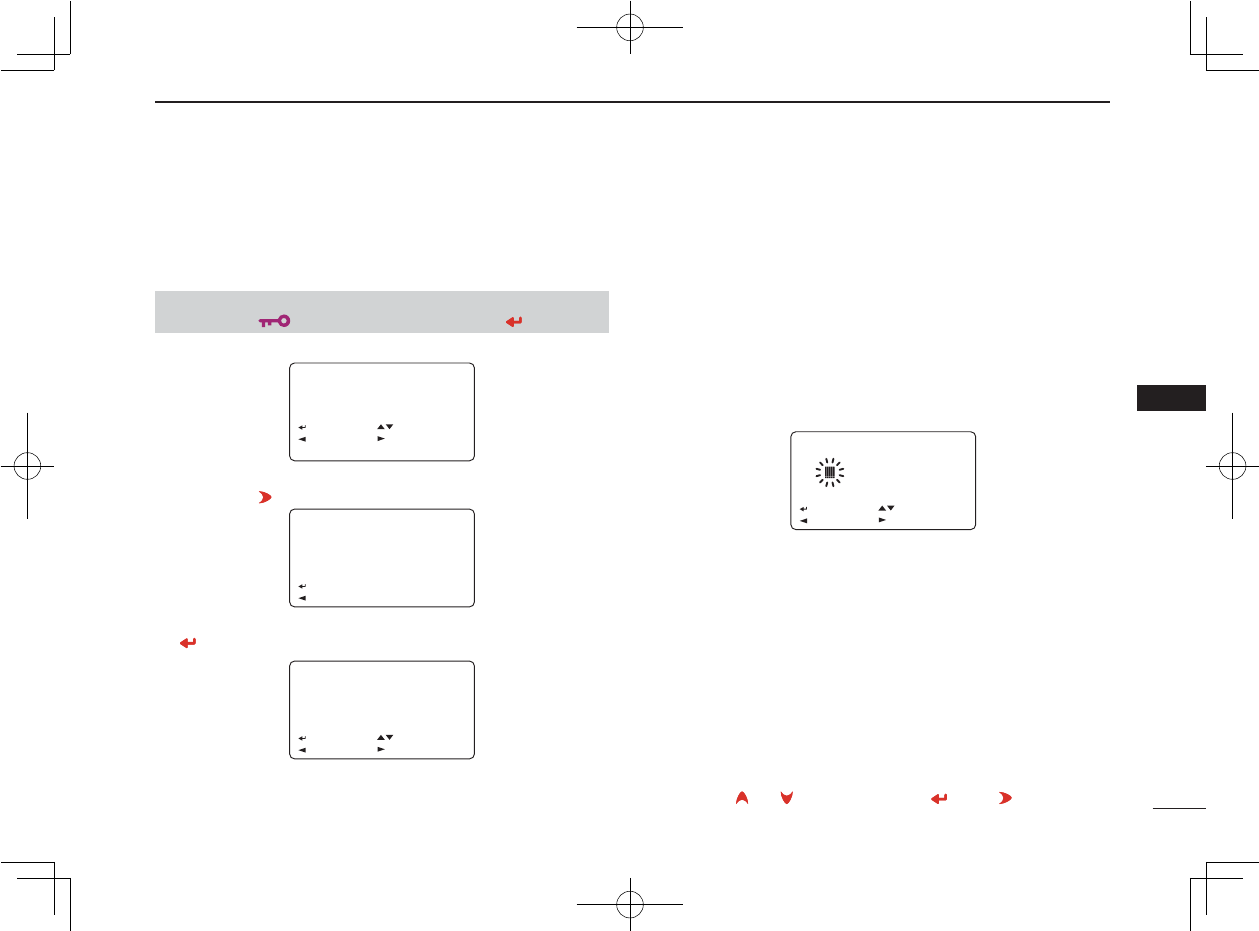
63
8
GPS/GPS-A OPERATION (Optional UT-121 is required for IC-92A)
New2001
7
D GPS data addition
q Enter “GPS MEMORY” in message/position set mode.
• GPS MEMORY screen is displayed.
w Rotate [DIAL]† to select the desired memory bank or ALL,
then push [](6).
e Rotate [DIAL]† to select <ADDITION>, then push
[](5).
1
2
3
4
5
6
8
9
10
11
12
13
14
15
16
17
18
19
†[DIAL] ↔ [ ](2)/[](8) [ ](5) ↔ [ ](6)
❮MENU screen❯
➪
❮MESSAGE/POSITION❯
➪
❮GPS MEMORY❯
(Push [MENU/ ]) (Rotate [DIAL]†, then push [ ](5)†.)
RX
RX
ALL
A:
A:
:SET
:SET
:BACK
:BACK
:SEL
:SEL
:EDIT
:EDIT
:ALM
:ALM
GPS MEMORY
C
r
<ADDITION>
<ADDITION>
:SET
:SET
:BACK
:BACK
BANK A
r
NAME:
NAME:
:SET
:SET
:BACK
:BACK
<ADDITION>
<ADDITION>
r
:SEL
:SEL
:EDIT
:EDIT
NAME:
NAME:
:SET
:BACK
:BACK
<ADDITION>
<ADDITION>
r
:SEL
:SEL
:EDIT
:EDIT
AB
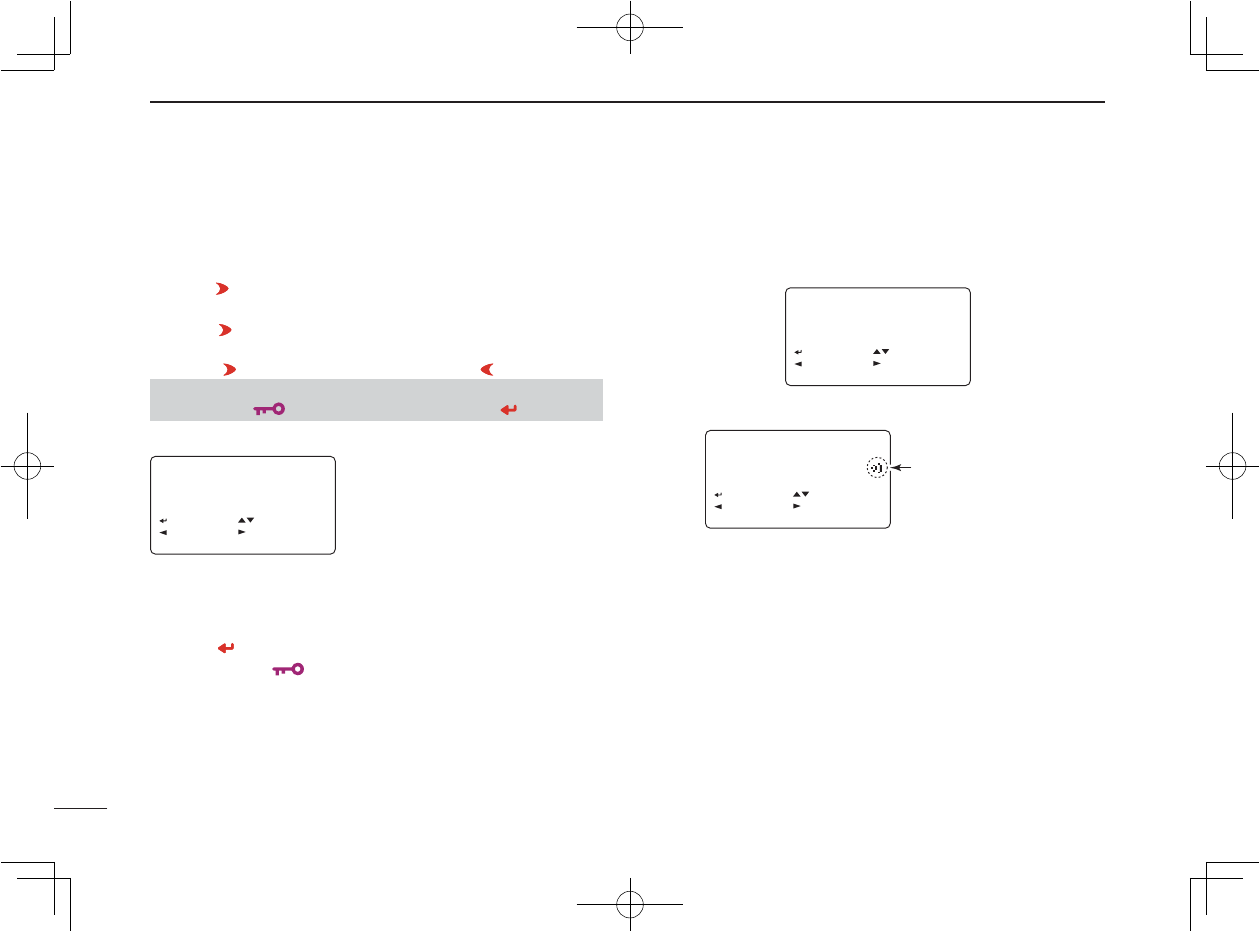
Ne
64
8GPS/GPS-A OPERATION (Optional UT-121 is required for IC-92A)
New2001
r Rotate [DIAL]† to select desired items (NAME, TIME,
LATITUDE, LONGITUDE, BANK or BANK NAME), then
push [](6) to edit the selected item.
t Rotate [DIAL]† to select the desired character or symbol.
y Push [](6) to select 2nd digit, then rotate [DIAL]† to se-
lect the desired character or code.
• Push [](6) to move the cursor right; push [](4) to move the
cursor left.
• 2nd digit blinks (1st digit stops blinking).
u Repeat the steps r and t to enter the desired message.
• Up to 20-character messages can be set.
i Push [ ](5) to add the GPS data.
o Push [MENU/ ] to return to frequency indication.
D GPS alarm setting
GPS alarm sounds when your own position is close the
specified area. This function can be set the received chan-
nel, specifi ed GPS memory channel, all GPS memory chan-
nels or a memory bank.
q Enter “GPS MEMORY” in message/position set mode.
• GPS MEMORY screen is displayed.
w Rotate [DIAL]† to select the desired memory bank or
memory channel.
• “RX”, “ALL”, one of the memory bank or memory channel can
be selected.
• Skip e and operate r when alarm RX, ALL, BANK A–Z set.
RX
ALL
A:
:SET
:BACK
:SEL
:EDIT
:EDIT
:ALM
GPS MEMORY
GPS MEMORY
C
r
<ADDITION>
<ADDITION>
01:BAY-
AREA
AREA
02:KOBE-AIR
:SET
:BACK
:BACK
:SEL
:SEL
:EDIT
:EDIT
:ALM
:ALM
BANK A
C
r
❮MENU screen❯
➪
❮MESSAGE/POSITION❯
➪
❮GPS MEMORY❯
(Push [MENU/ ]) (Rotate [DIAL]†, then push [ ](5)†.)
<ADDITION>
<ADDITION>
01:BAY
01:BAY-ARE
02:KOBE
02:KOBE-AIR
:SET
:SET
:BACK
:BACK
:SEL
:SEL
:EDIT
:EDIT
:ALM
:ALM
BANK A
C
r
Alarm mark
Appearing at 8-digits
of memory name.
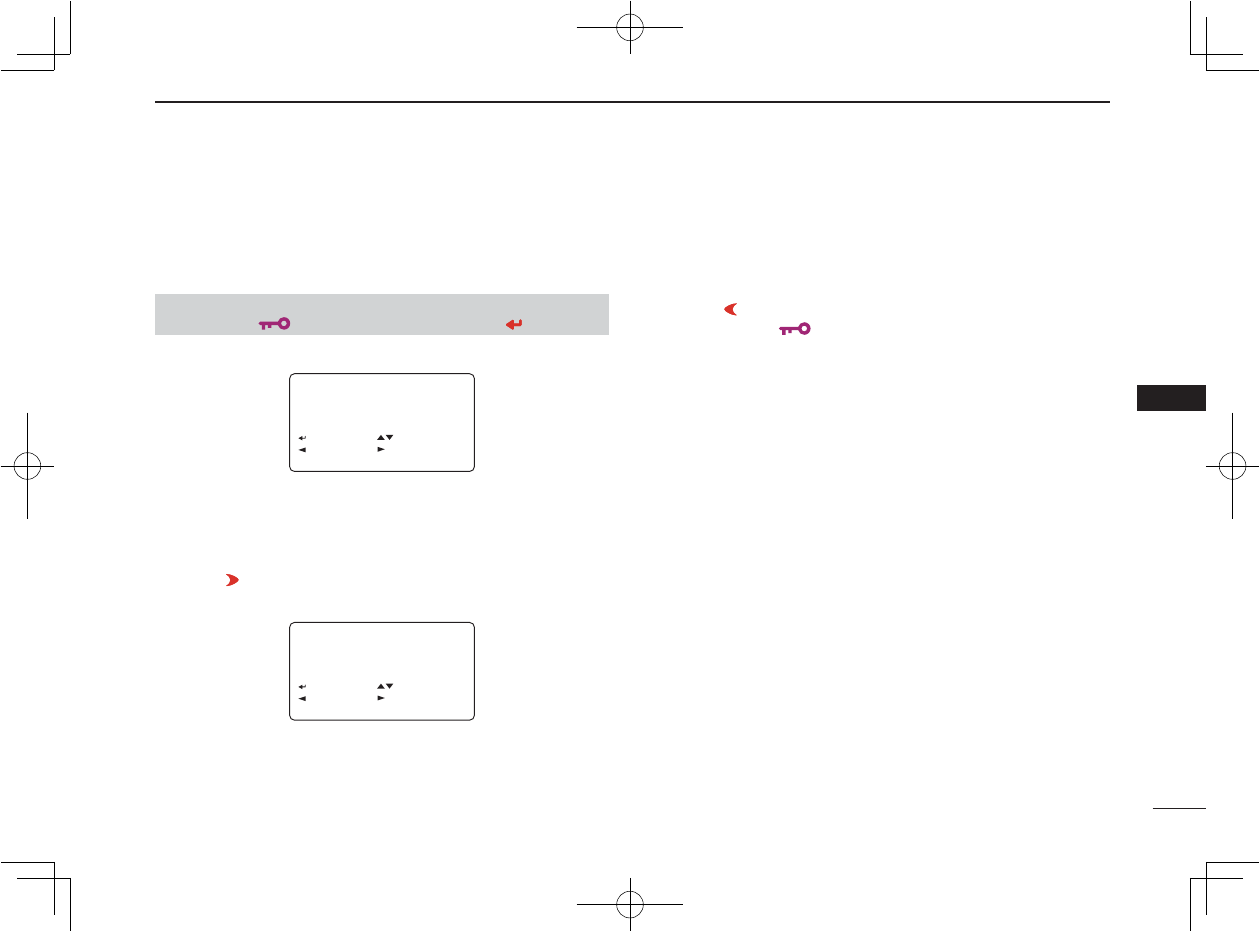
65
8
GPS/GPS-A OPERATION (Optional UT-121 is required for IC-92A)
New2001
1
2
3
4
5
6
7
8
9
10
11
12
13
14
15
16
17
18
19
D GPS memory clearing
q Enter “GPS MEMORY” in message/position set mode.
• GPS MEMORY screen is displayed.
w Rotate [DIAL]† to select “ALL” or desired memory bank or
memory channel.
• Skip e and operate r when ALL or each all channels of bank
A–Z delete.
e Push [](6), then rotate[DIAL]† to select the desired GPS
memory channel.
r Push and hold [CLR](1) for 1 sec. to clear.
• 3 beeps sound, then the memory channel is cleared.
• Remaining channels scroll up.
t Push [ ](4) to return to GPS MEMORY screen.
y Push [MENU/ ] to return to frequency indication.
RX
RX
ALL
A:
:SET
:SET
:BACK
:BACK
:SEL
:SEL
:EDIT
:EDIT
:ALM
:ALM
GPS MEMORY
C
r
❮MENU screen❯
➪
❮MESSAGE/POSITION❯
➪
❮GPS MEMORY❯
(Push [MENU/ ]) (Rotate [DIAL]†, then push [ ](5)†.)
<ADDITION>
<ADDITION>
01:BAY-
AREA
AREA
02:KOBE-AIR
:SET
:SET
:BACK
:BACK
:SEL
:SEL
:EDIT
:EDIT
:ALM
:ALM
BANK A
C
r
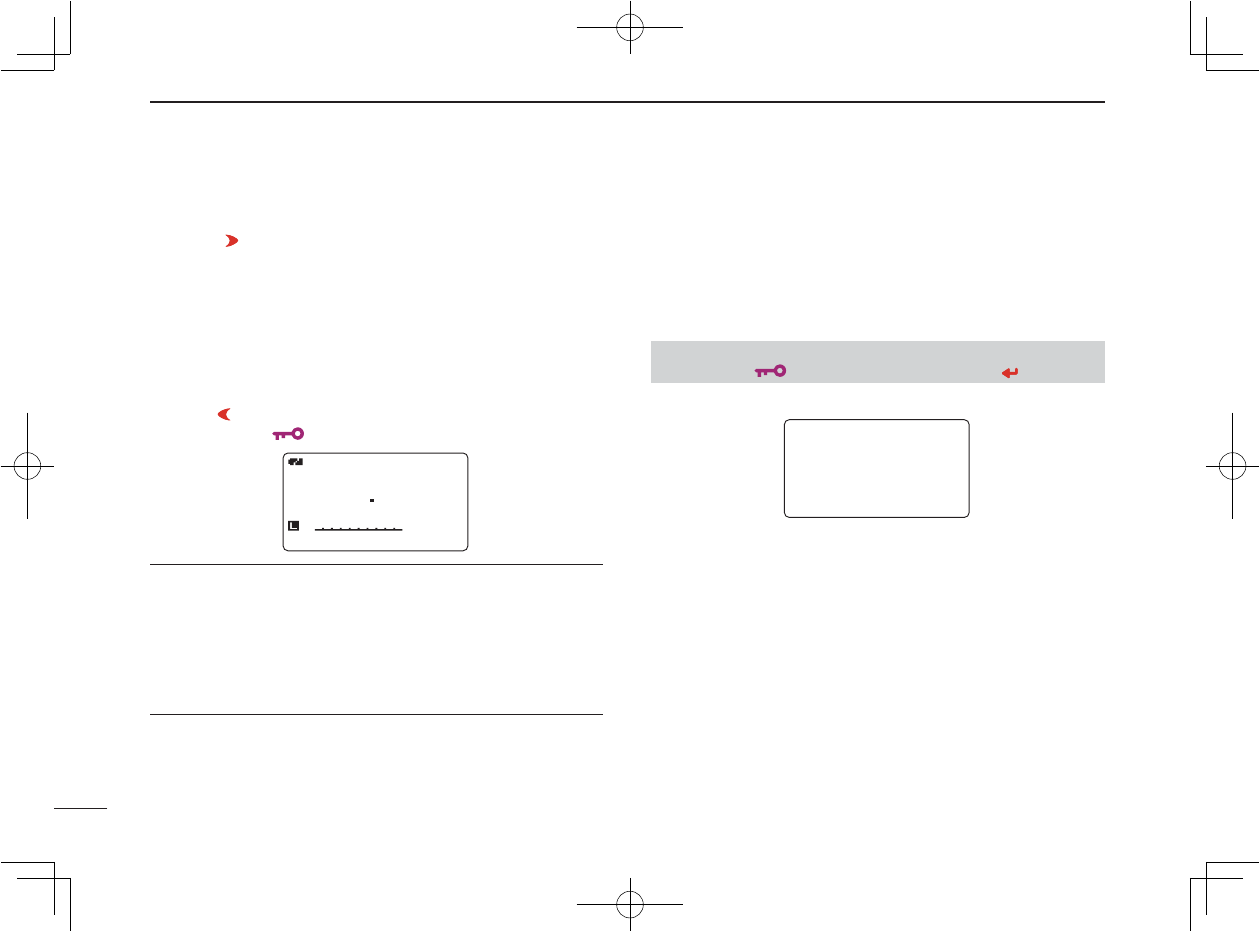
Ne
66
8GPS/GPS-A OPERATION (Optional UT-121 is required for IC-92A)
New2001
e Push [](6), then rotate[DIAL]† to select the desired
memory channel.
r Push [C](CALL) to switch alarm function ON or OFF.
t Push [](4) to return to GPS MEMORY screen.
y Push [MENU/ ] to return to frequency indication.
✔-For your information!
• When “RX” or memory channel is selected above step r,
alarm functions depending on “ALM AREA2” setting in the
GPS set mode (p. ??).
• When “ALL” or memory bank is selected above step r,
alarm functions depending on “ALM AREA1” setting in the
GPS set mode (p. ??).
■ Other functions for DV mode
operation
D DV voice memory
The IC-92A/92AD has a DV voice memory that records a
total 30 second (approx.) of received audio.
The DV voice memory is divided into 2 tracks, 15 seconds
each in a track, as the default setting.
◆ Recording received audio
q Select DV mode in B band, and deactivate the priority
watch (p. 83) and weather alert function (p. 114) if activated.
w While receiving a DV signal, push [REC].
e Rotate [DIAL] to select the desired track.
• “✱” is displayed beside the track number when the selected
track has been recorded.
r Push [REC] to start recording.
• Track counter (bar meter) is displayed during record.
DV
B
440012
50
q
REC TRACK:2
REC TRACK:2
❮MENU screen❯ ➪ ❮DV VOICE MEMO❯ ➪ ❮TRACK SIZE❯
(Push [MENU/ ]) (Rotate [DIAL]†, then push [ ](5)†.)
10S/3TRACK
10S/3TRACK
15S/2TRACK
15S/2TRACK
30S/1TRACK
30S/1TRACK
TRACK SIZE
r
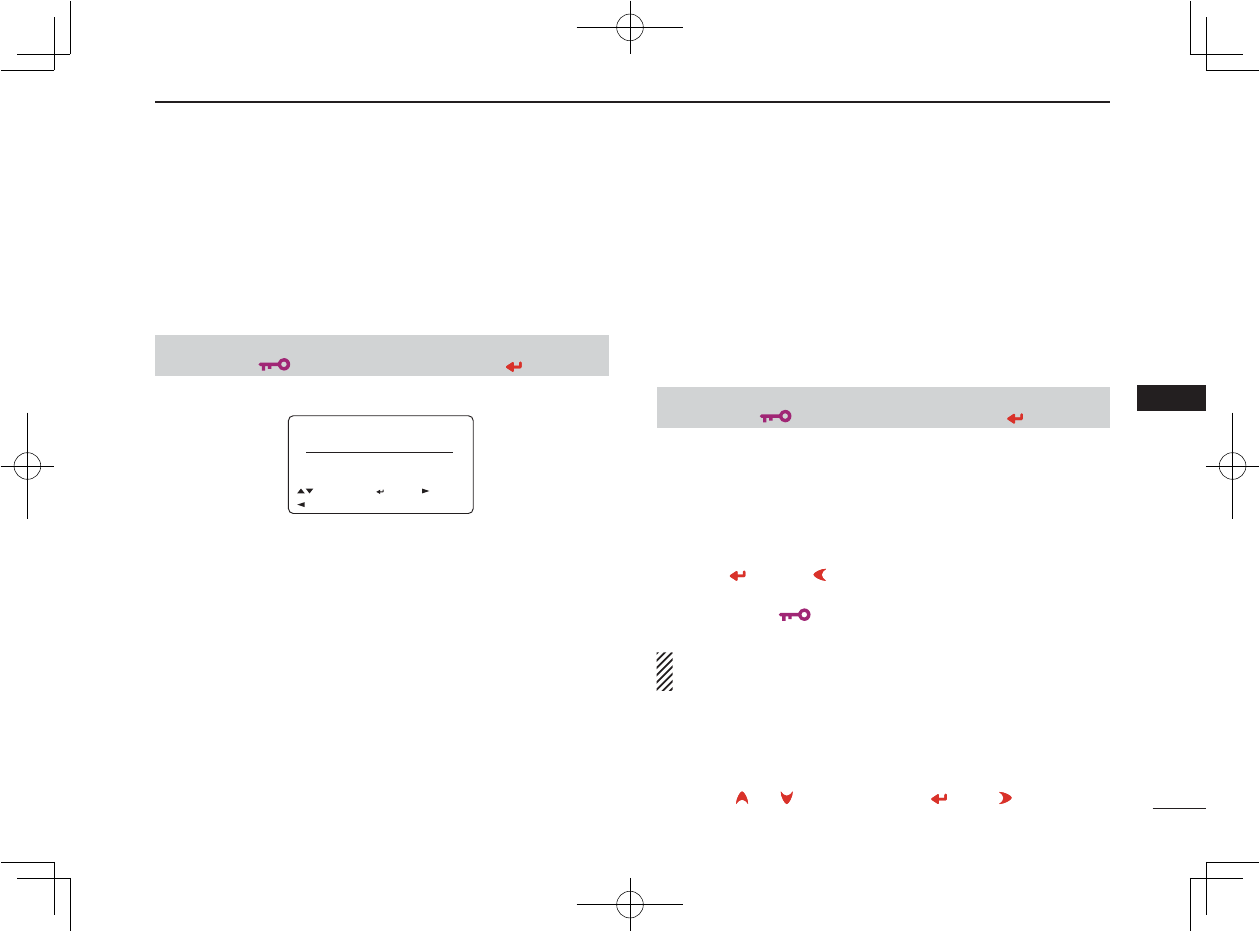
67
7
DV MODE OPERATION (Optional UT-121 is required for IC-92A)
New2001
1
2
3
4
5
6
7
8
9
10
11
12
13
14
15
16
17
18
19
• The recording is paused automatically when the DV signal is
interrupted or when the DV audio signal cannot be received
correctly. Re-starts the recording when the DV audio signal is
received correctly.
t Push [REC] again to stop recording.
• The recording stops automatically when the track becomes full.
◆ Track size setting
The track size can be changed with the following instruction.
q Enter “TRACK SIZE” in DV voice memo set mode.
• TRACK SIZE screen is displayed
w Rotate [DIAL]† to select the desired track size.
10S/3TRACK : Makes 3 tracks and 10 seconds audio
can be recorded in each track.
15S/2TRACK : Makes 2 tracks and 15 seconds audio
can be recorded in each track.
30S/1TRACK : Makes 1 track only and 30 seconds audio
can be recorded in a track.
e Push [](5) (or [](4)) to return to DV VOICE MEMO
screen.
r Push [MENU/ ] to return to frequency indication.
❮MENU screen❯ ➪ ❮DV VOICE MEMO❯ ➪ ❮TRACK❯
(Push [MENU/ ]) (Rotate [DIAL]†, then push [ ](5)†.)
TRACK:1
TRACK:1 *
:
:SEL
:SEL
:BACK
:BACK
CLR:CLR
CLR:CLR
TRACK
r
❮MENU screen❯ ➪ ❮DV SET MODE❯ ➪ ❮AUTO DETECT❯
(Push [MENU/ ]) (Rotate [DIAL]†, then push [ ](5)†.)
†[DIAL] ↔ [ ](2)/[](8) [ ](5) ↔ [ ](6)
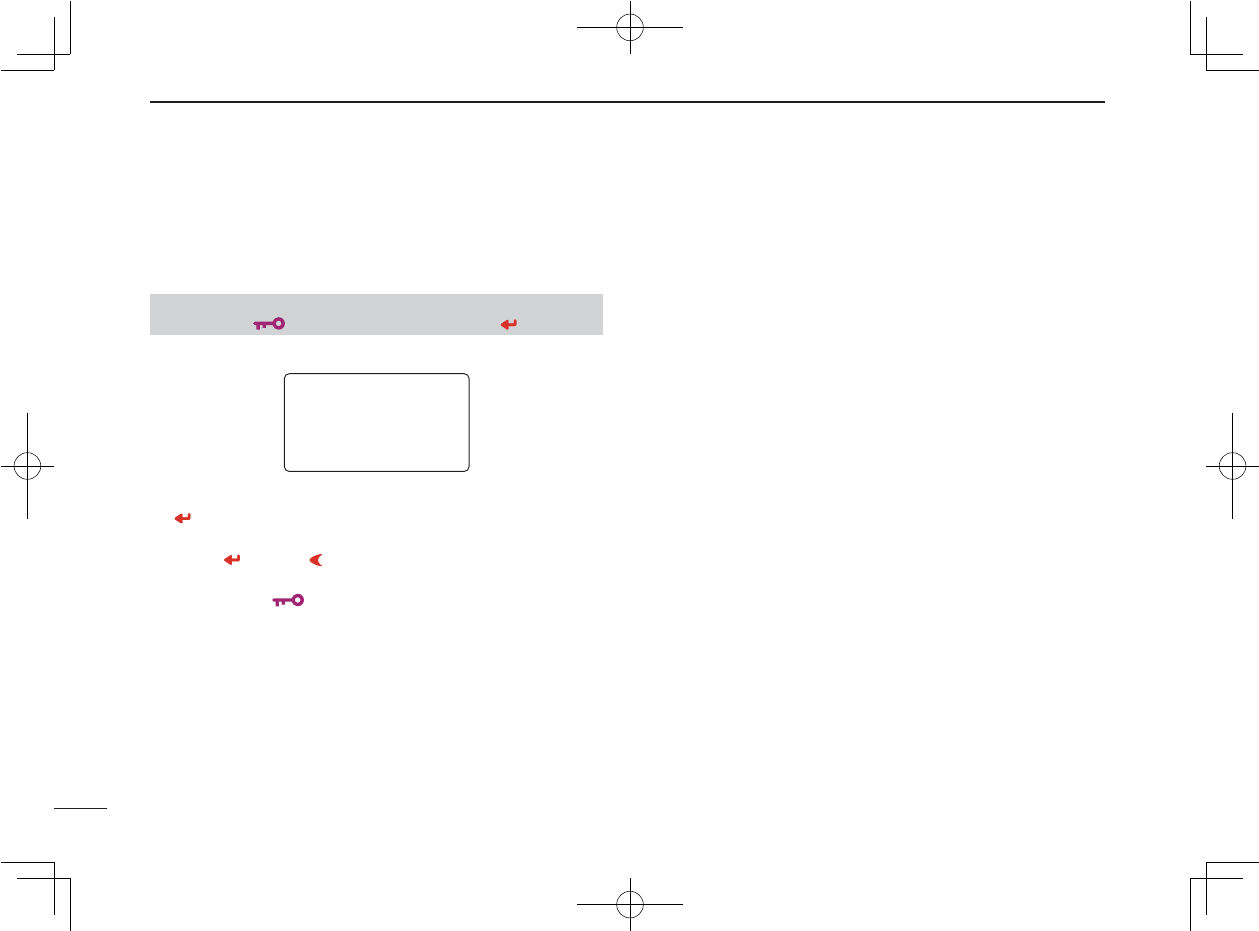
68
8GPS/GPS-A OPERATION (Optional UT-121 is required for IC-92A)
New2001
■ GPS set mode items
D Entering GPS set mode
q Enter “GPS SET MODE” in message/position set mode.
• GPS SET MODE screen is displayed.
w Rotate [DIAL]† to select the desired item, and then push
[](5)†.
e Rotate [DIAL]† to select the desired value or condition.
r Push [](5) (or [](4)) to return to GPS SET MODE
screen.
t Push [MENU/ ] to return to frequency indication.
D GPS SPEED
Selects the data transmission speed for packet operation
from 4800 bps (default) and 9600 bps.
D FORMAT
Selects the displaying position format from dddºmm.mm´
(default) and dddºmm´ss´´.
D UNITS
Selects display units for distance and elevation from “m” or
“ft/ml.”
(default : USA/General versions; ft/ml, Other versions; m)
D COMPASS DIRECTION
Selects compass indication type from “NORTH REF” (default)
and “SOUTH REF.”
D UTC offset
Sets time difference from UTC (Universal Time Coordinated)
within –12:00 to +12:00 range in 5 min. steps. (default: 0:00)
GPS SPEED
GPS SPEED
FORMAT
FORMAT
UNITS
UNITS
COMPASS DIR
COMPASS DIR
UTC OFFSET
UTC OFFSET
GPS SET MODE
r
❮MENU screen❯
➪
❮MESSAGE/POSITION❯
➪
❮GPS SET MODE❯
(Push [MENU/ ]) (Rotate [DIAL]†, then push [ ](5)†.)
Ne
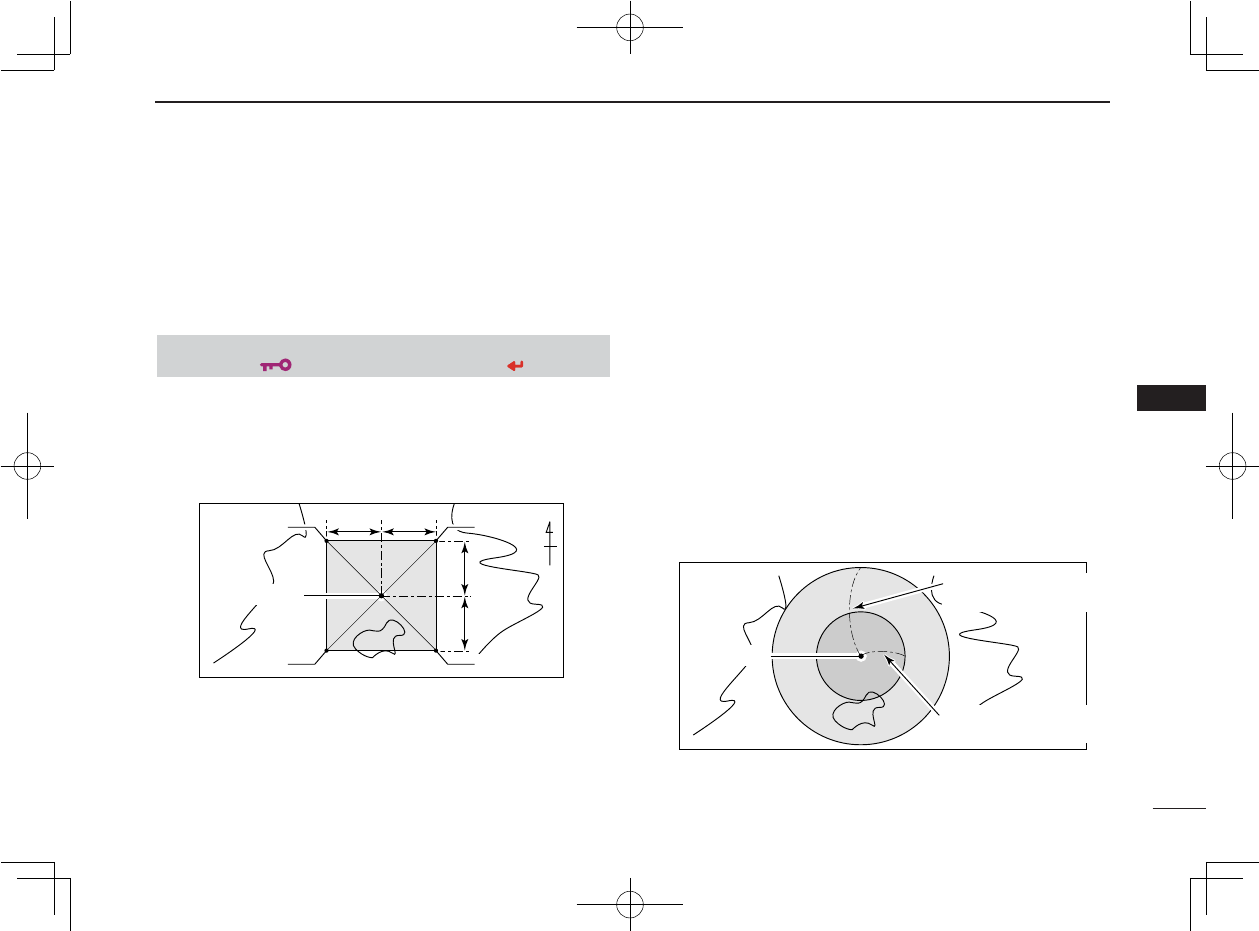
69
8
GPS/GPS-A OPERATION (Optional UT-121 is required for IC-92A)
New2001
1
2
3
4
5
6
7
8
9
10
11
12
13
14
15
16
17
18
19
D-Alarm area 1
Sets GPS alarm active range within 00c05s to 59c59s in
1 sec. (00c01s) steps. (default: 00c15s)
q Enter “GPS MEMORY” in message/position set mode.
w The alarm area 1 function is available when “GPS
ALARM” function of ALL or BANK A–Z turns ON.
D-Alarm area 2
Selects GPS alarm active range from “LIMITED,” “EX-
TENDED” and “BOTH.”
•-LIMITED : GPS alarm will be sound when a
target position is coming into 500 m*
(547 Y)* range.
•-EXTENDED : GPS alarm will be sound when a
target position is coming into 1 km*
(1094 Y)* range.
• BOTH : GPS alarm will be sound when a
target position is coming into both
500 m* (547 Y)* and 1 km* (1094 Y)*
range. (default)
*Approximate
00
′
15
″
00
′
15
″
00
′
15
″
00
′
15
″
Your position
Point A
Point C
Point B
Point D
N
• Example:
Your position : 35˚N/135˚E
ALM AREA1 setting : 00′15″ (default)
• Position of point A : 35˚00′15″N/134˚59′45″E
• Position of point B : 35˚00′15″N/135˚00′15″E
• Position of point C : 34˚59′45″N/134˚59′45″E
• Position of point D : 34˚59′45″N/135˚00′15″E
When the target position is coming into the area as above, the
GPS alarm will be sound.
Extended range
(approx. 1 km; 1094 Y)
Limited range
(approx. 500 m; 547 Y)
Your position
• Example:
When the target position is coming into either/each area as
above, the GPS alarm will be sound.
❮MENU screen❯
➪
❮MESSAGE/POSITION❯
➪
❮GPS SET MODE❯
(Push [MENU/ ]) (Rotate [DIAL]†, then push [ ](5)†.)
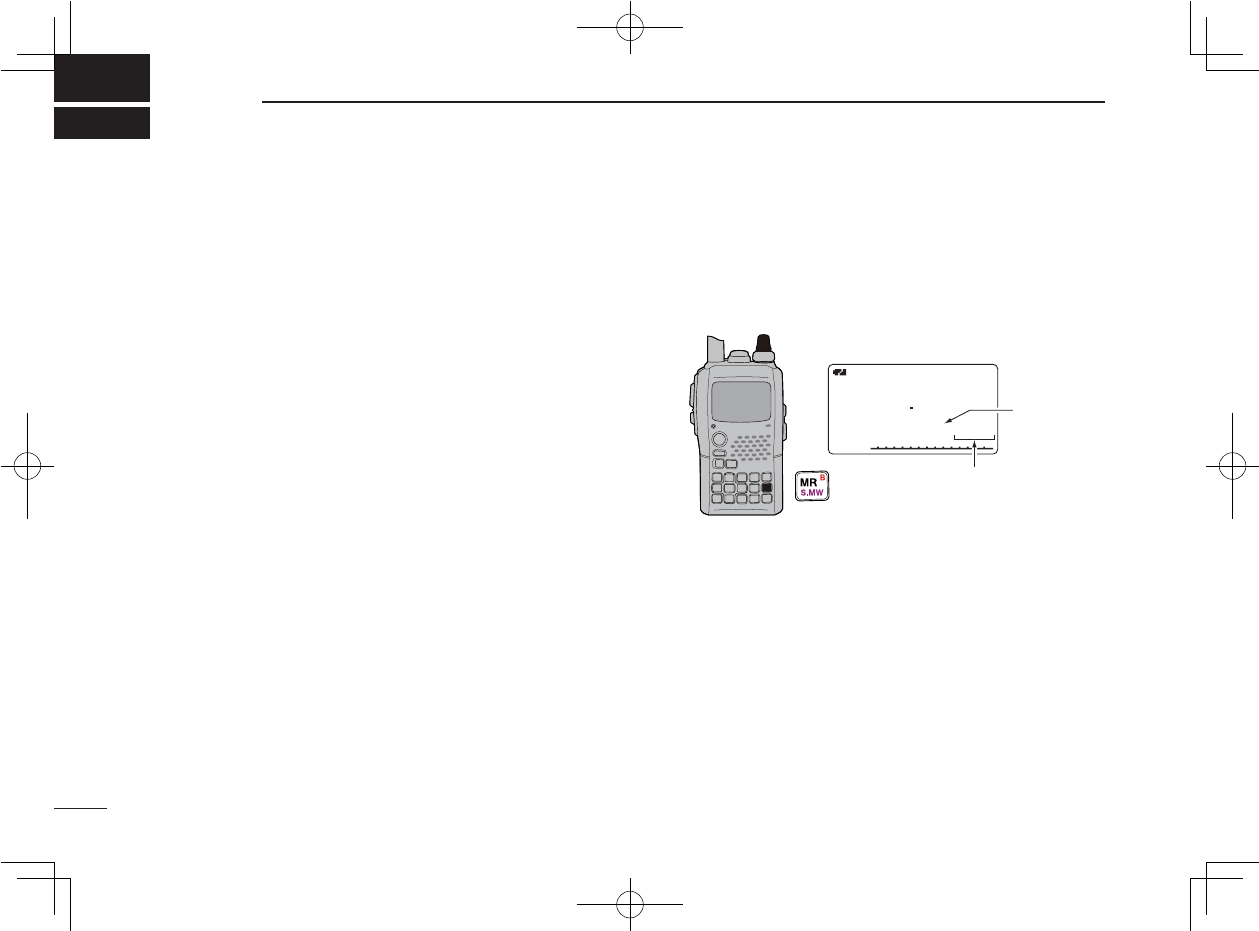
72
NeNew2001
MEMORY/CALL CHANNELS
9
■ General description
The IC-92A/92AD has 850 memory channels in A band, 450
memory channels in B band, and 2 call channels in each
band. Memory channels in each bands including 50 scan
edge memory channels (25 pairs) for storage of often-used
frequencies, respectively.
And a total of 26 memory banks, A to Z, are available in
each bands for storing groups of frequencies, etc. Up to 100
channels can be assigned into a bank.
D Memory channel contents
The following information can be programmed into memory
channels:
• Operating frequency (p. 18)
• Operating mode (p. 21)
• Duplex direction (+DUP or –DUP) with an offset fre-
quency (p. 31)
• Subaudible tone encoder (p. 107), tone squelch or
DTCS squelch ON/OFF (p. 110)
• Subaudible tone frequency (p. 107), tone squelch fre-
quency or DTCS code with polarity (pgs. 107, 111)
• Scan skip information (p. 80)
• Memory bank (p. 67)
• Memory name (p. 70)
• Tuning step (p. 18)
• Call sign squelch or Digital code squelch* (p. 110)
• Station call sign* (p. 36)
• RPT1/RPT2 call sign* (p. 41)
*Available for B band operation only.
■ Selecting a memory channel
D Using [DIAL]— Programmed channels
q Push [MR] to select memory mode.
w Rotate [DIAL] to select the desired memory channel.
• Only programmed channels are displayed.
D Using [DIAL]— All channels
q Push [MR] to select memory mode.
w Push and hold [S.MW](MR) for 1 sec. to enter select
memory write mode.
• 1 short and 1 long beep sound.
• “μ ” indicator blinks.
e Rotate [DIAL] to select the desired memory channel.
• All channels are displayed.
• Push [VFO] to return to memory mode indication.
A
μ
FM
146010
000
000
[DIAL]
MR
S.MW
B
Appears
Rotate [DIAL] to select
the memory channel.
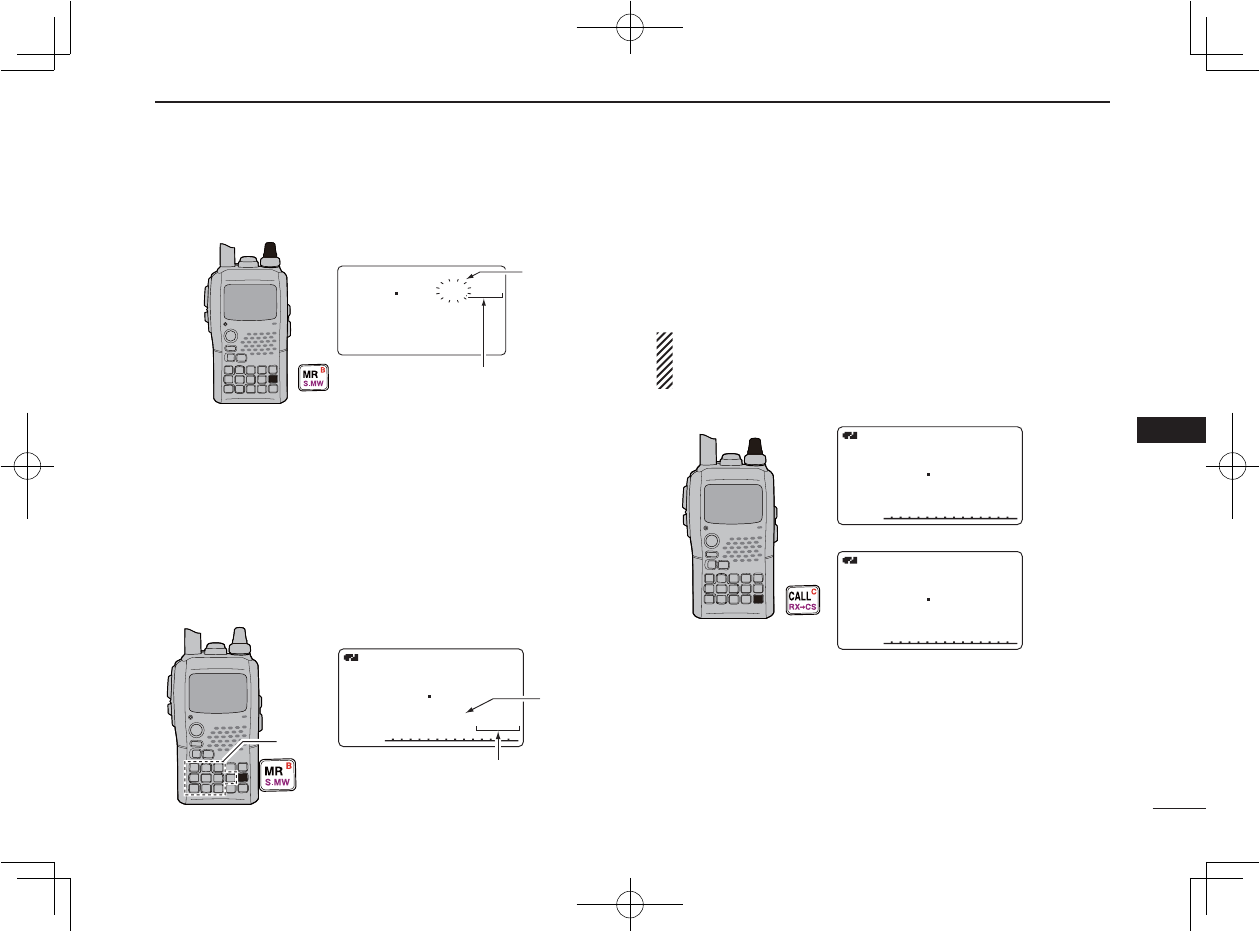
New2001
73
8
MEMORY/CALL CHANNELS
1
2
3
4
5
6
7
8
9
10
11
12
13
14
15
16
17
18
19
D Using the KEYPAD
q Push [MR] to select memory mode.
w Push the keypad to enter 3 digits to select the desired
memory channel.
• The blank channels are also selectable.
• Example— selecting memory channel “25”
Push [MR] then push [0], [2], [5].
■ Selecting a call channel
q Push [CALL] to select call channel mode.
• Pushing [CALL] toggles call, TV* and weather† channels.
w Rotate [DIAL] to select the desired call channel.
• “C0” and “C1” are selectable.
* Appears only when TV channels are programmed via the
optional RS-92. Also available for A band operation only.
†
Available for the USA version only.
146
010
010
BANK
BANK
:----
:----
MNAME:
MNAME:
SKIP
SKIP
:OFF
:OFF
FM
FM
r
μ
000
000
[DIAL]
MR
S.MW
B
Blinks
Rotate [DIAL] to select
the memory channel.
Appears
A
μ
FM
FM
145600
025
025
The entered memory
channel is selected.
MR
S.MW
B
Keypad
A
FM
440000
C1
A
FM
146010
C0
VHF band call channel
UHF band call channel
[DIAL]
CALL
RX
CS
C
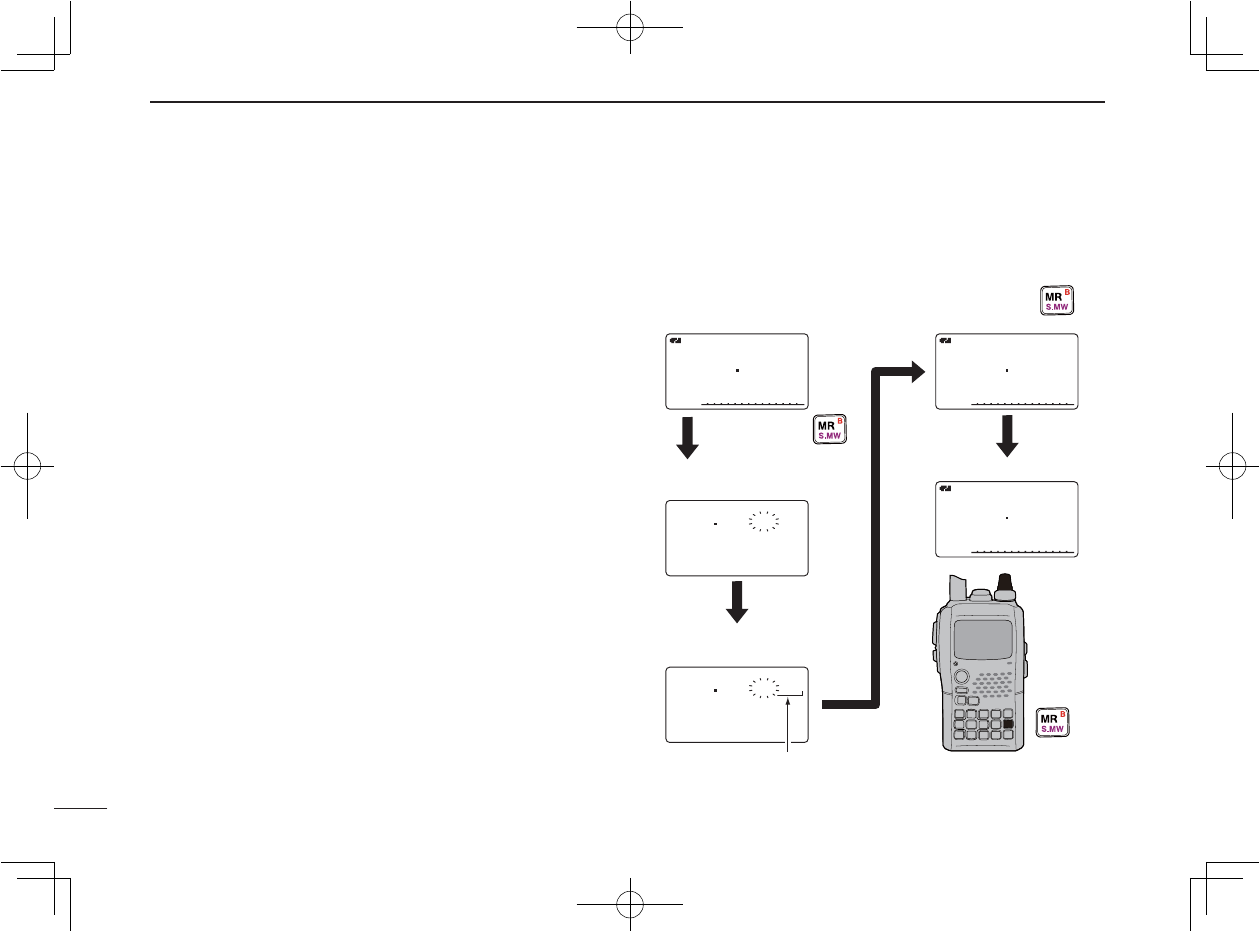
Ne
74
8MEMORY/CALL CHANNELS
New2001
■
Memory channel programming
q Push [VFO] to select VFO mode.
w Set the desired frequency:
➥ Select the desired band with [BAND].
➥ Set the desired frequency with [DIAL].
➥ Or set the desired frequency with keypad directly.
In this case, the band and frequency settings with
[BAND] and [DIAL] as above are not required.
➥ Set other data (e.g. offset frequency, duplex direction,
tone squelch, etc.), if desired.
e Push and hold [S.MW](MR) for 1 sec. to enter select
memory write mode.
• 1 short and 1 long beep sound.
• “μ ” indicator blinks.
r Rotate [DIAL] to select the desired channel.
• Call channels (C0, C1), VFO (VFO) and scan edge channels
(0A/0B to 24A/24B), as well as regular memory channels, can
be programmed in this way.
t Push and hold [S.MW](MR) for 1 sec. to program.
• 3 beeps sound.
• Memory channel number automatically increases when con-
tinuing to push and hold [S.MW](MR) for 3 sec. after program-
ming.
[EXAMPLE]: Programming 145.870 MHz into memory
channel 11 (blank channel).
14
146010
BANK
BANK
:----
:----
MNAME:
MNAME:
SKIP
SKIP
:OFF
:OFF
FM
r
μ
000
BANK
BANK
:----
:----
MNAME:
MNAME:
SKIP
SKIP
:OFF
:OFF
r
μ
011
A
FM
FM
145870
PSKIP
PSKIP
A
FM
145870
PSKIP
PSKIP
A
μ
FM
145870
PSKIP
PSKIP
011
[DIAL]
MR
S.MW
B
MR
S.MW
B
MR
S.MW
B
VFO mode
Enter select memory
write mode.
Rotate [DIAL] to select
channel 11.
Push and hold
for 1 sec.
Channel 11
Push and hold
for 1 sec. to program.
Return to the VFO mode.
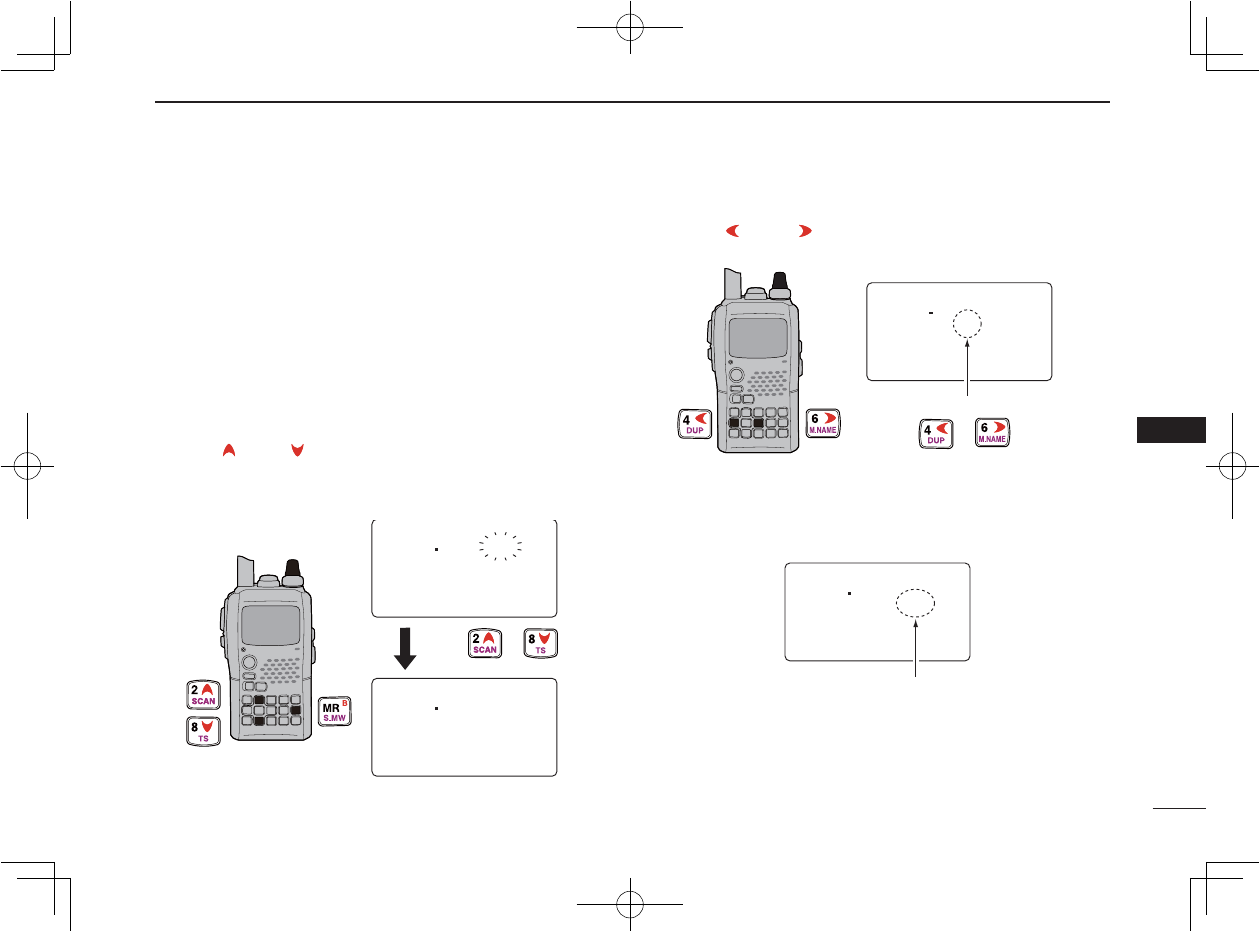
75
8
MEMORY/CALL CHANNELS
New2001
1
2
3
4
5
6
7
8
9
10
11
12
13
14
15
16
17
18
19
■ Memory bank setting
The IC-92A/92AD has a total of 26 banks (A to Z). Regular
memory channels, 000 to 799 (A band)/000 to 399 (B band),
are assigned to the desired bank for easy memory manage-
ment.
q Push and hold [S.MW](MR) for 1 sec. to enter select
memory write mode.
• 1 short and 1 long beep sound.
• “μ ” indicator blinks.
w Rotate [DIAL] to select the desired memory channel.
e Push [](2) or [ ](8) to select “BANK.”
• Bank group and channel number is displayed if the selected
memory channel has already been previously assigned to a
bank.
r Push [](4) or [](6) several times to select the desired
bank group from “A” to “Z.”
t Rotate [DIAL] to select the bank channel number from
“00” to “99.”
• Only vacant bank channel numbers will be displayed.
y Push and hold [S.MW](MR) for 1 sec. to assign the chan-
nel to the bank.
• Return to the previous indication.
145870870
BANKBANK :----:----
MNAME:MNAME:
SKIPSKIP :OFF:OFF
FMFM
r
μ
011011
145870870
BANKBANK :----:----
MNAME:MNAME:
SKIPSKIP :OFF:OFF
r
μ
011011
Push or
[DIAL]
MR
S.MW
B
2
SCAN
8
TS
2
SCAN
8
TS
145870
BANK
BANK
:C-00
:C-00
MNAME:
MNAME:
SKIP
SKIP
:OFF
:OFF
r
μ
011
011
Bank group is selected
with or .
[DIAL]
4
DUP
6
M.NAME
4
DUP
6
M.NAME
145870
BANK :C-05
MNAME:
MNAME:
SKIP
SKIP
:OFF
r
μ
011
011
Bank channel is
selected with [DIAL].
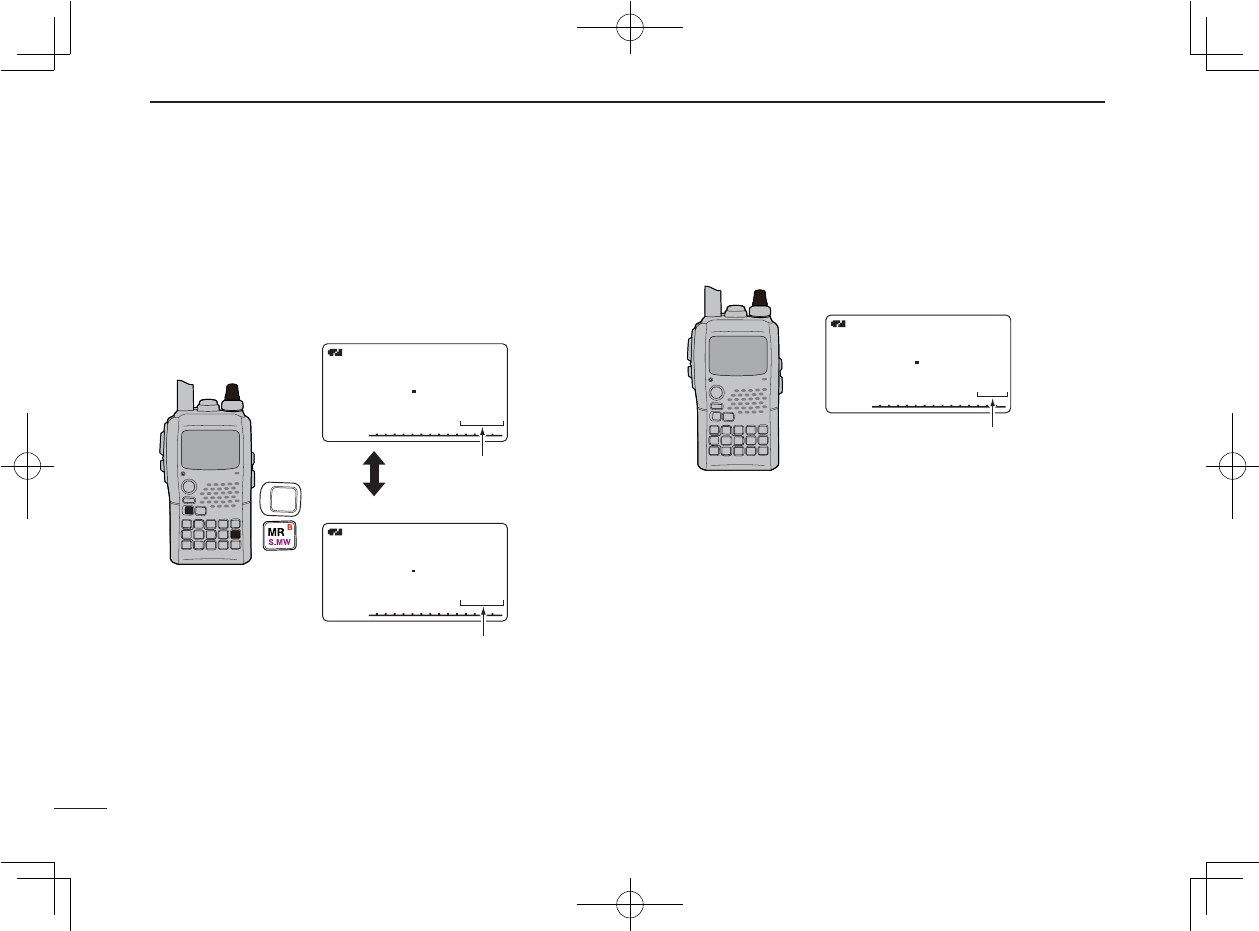
Ne
76
8MEMORY/CALL CHANNELS
New2001
■ Memory bank selection
q Push [MR] several times to select memory bank mode.
w While pushing and holding [BAND], rotate [DIAL] to se-
lect the desired bank (A to Z).
• Only programmed banks are displayed.
e Rotate [DIAL] to select the bank channel.
• Only programmed channels are displayed.
r Push [MR] to return to regular memory condition.
A
μ
FM
FM
145870
011
011
Memory mode
A
μ
FM
FM
145870
C05
C05
Memory bank mode
Bank channel is
displayed.
Memory channel is
displayed.
[DIAL]
MR
S.MW
B
BAND
D
A
μ
FM
145620
C01
C01
Memory bank mode
Bank channel is
selected with [DIAL].
[DIAL]
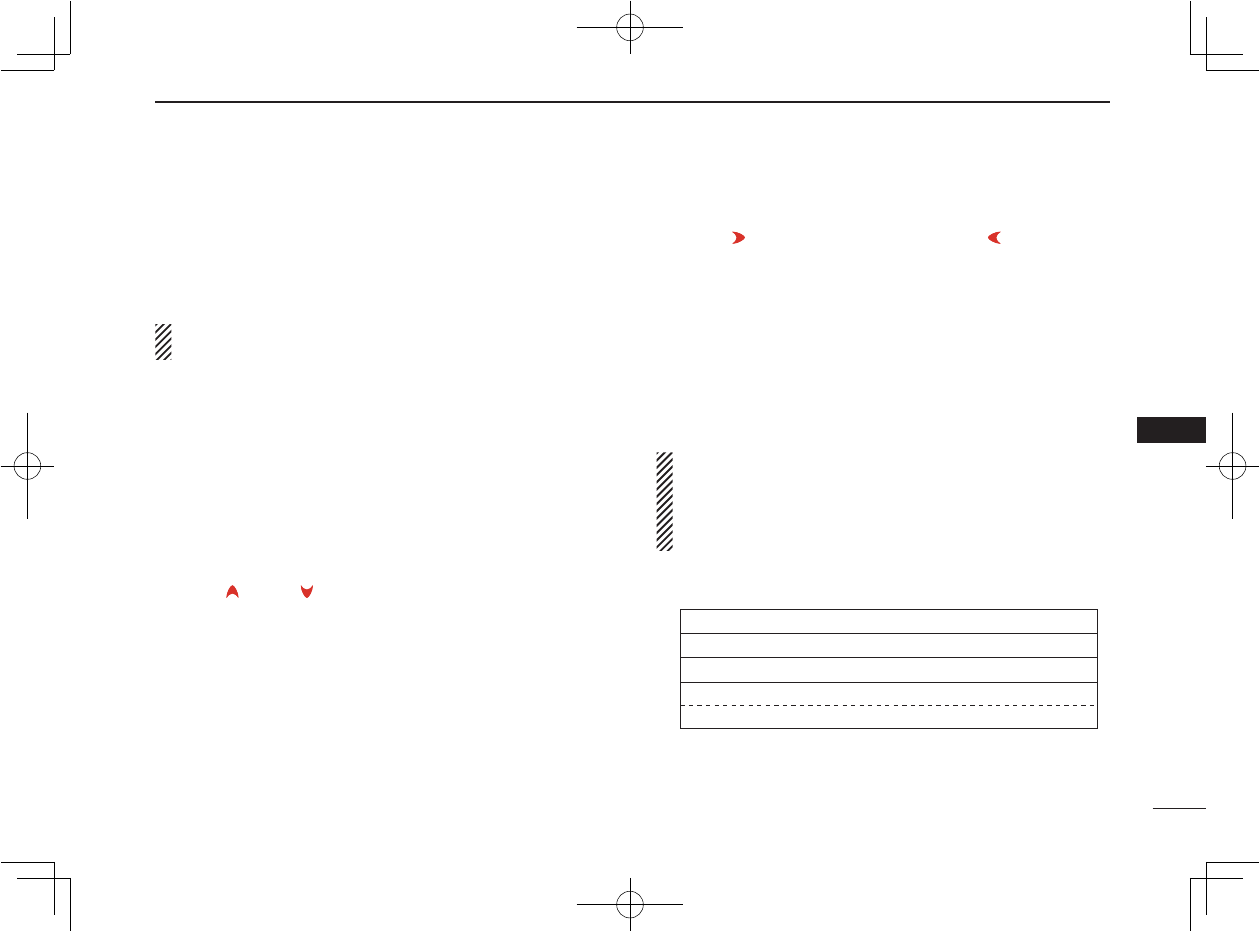
77
8
MEMORY/CALL CHANNELS
New2001
1
2
3
4
5
6
7
8
9
10
11
12
13
14
15
16
17
18
19
■ Programming memory/bank/scan name
Each memory channel can be programmed with an alpha-
numeric channel name for easy recognition and can be indi-
cated independently by channel. Names can be a maximum
of 8 characters.
NOTE: Scan name indication can be turned ON or OFF in
display set mode. (p. 101)
q Push [MR] to select memory mode.
• When programming a call channel name, push [CALL] to se-
lect call channel mode.
w Rotate [DIAL] to select the desired memory channel.
• Select scan edge channels (0A/0B to 24A/24B) for program-
ming a scan name.
e Push and hold [S.MW](MR) for 1 sec. to enter select
memory write mode.
• 1 short and 1 long beep sound.
• “μ ” indicator blinks.
r Push [](2) or [](8) several times to select “BNAME,”
“MNAME” or “SNAME” when programming the bank
name, the memory name or the scan name, respectively.
• After selecting the name to be programmed, a cursor blinks for
the fi rst character.
t Rotate [DIAL] to select the desired character.
• The selected character blinks.
• Push [A/a](3) to change the character group from “AB” (alphabeti-
cal characters; capital letters), “ab” (alphabetical characters; lower
case letters), “12” (numbers) and “-!”-” (symbols) in sequence.
• Push [](6) to move the cursor right; push [](4) to move the
cursor left.
• Push [CLR](1) to erase the selected character, or push and
hold [CLR](1) for 1 sec. to erase all characters following the
cursor.
y Repeat step t until the desired channel name is pro-
grammed.
u Push and hold [S.MW](MR) for 1 sec. to program the
name and exit channel name programming.
• 3 beeps sound.
NOTE: Only one bank name can be programmed into
each bank. Therefore, the previously programmed bank
name will be displayed when bank name indication is se-
lected. Also, the programmed bank name is assigned for
the other bank channels automatically.
D Available characters
ABCDEFGHIJKLMNOPQRSTUVWXY
ABCDEFGHIJKLMNOPQRSTUVWXYZ
abcdefghijklmnopqrstuvwxy
abcdefghijklmnopqrstuvwxyz
012345678
0123456789
! '
'#$%&'()*+,-./:;<=>?@[\]
'#$%&'()*+,-./:;<=>?@[\]
^_`{|}
^_`{|}~
(Space)
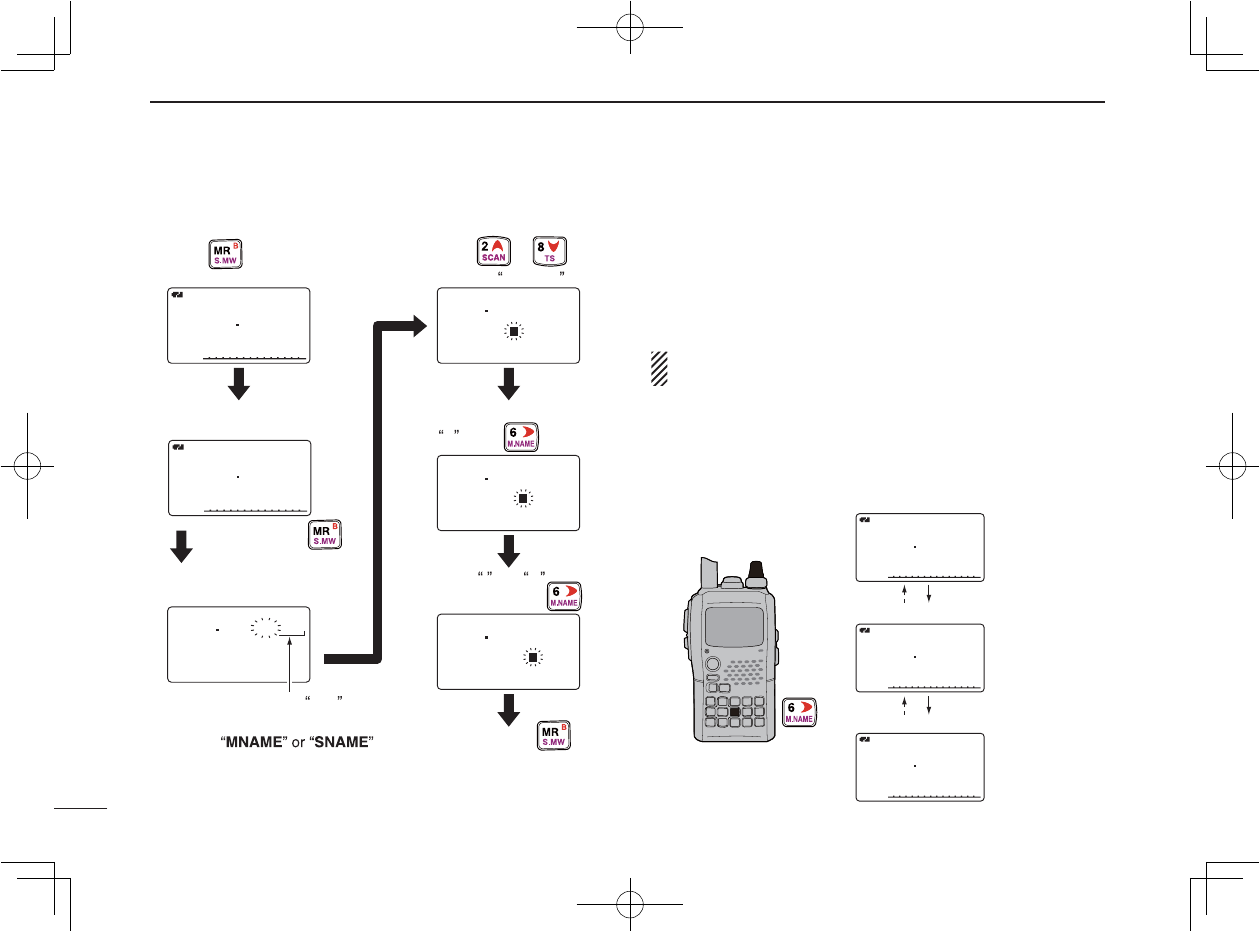
Ne
78
8MEMORY/CALL CHANNELS
New2001
[EXAMPLE]: Programming the bank name “AIR” into the
scan edge channel 03A. ■ Selecting memory/bank name
indication
During memory mode operation, either the programmed
memory name or bank name can be displayed below the
frequency indication.
NOTE: The programmed scan name is displayed during
the programmed scan edge channel selection.
q Push [MR] to select memory mode.
w While pushing [M.N](6), rotate [DIAL] to select display
indication type from memory name (normal size), memory
name (large size), bank name and OFF.
127
500
500
BANK
BANK
:A-01
:A-01
BNAME:
BNAME:
MNAME:
MNAME:
SNAME:
SNAME:
AM
AM
r
μ
03A
A
μ
AM
127500
03A
A
μ
FM
145
870
870
011
12
127500
BANK
BANK
:A-01
:A-01
BNAME:AIR
BNAME:AIR
MNAME:
MNAME:
SNAME:
SNAME:
AM
AM
r
μ
03A
12
127500
BANK
BANK
:A-01
:A-01
BNAME:AI
BNAME:AI
MNAME:
MNAME:
SNAME:
SNAME:
AM
AM
r
μ
03A
12
127500
BANK
BANK
:A-01
:A-01
BNAME:A
BNAME:A
MNAME:
MNAME:
SNAME:
SNAME:
AM
AM
r
μ
03A
Enter select memory
write mode.
Push and hold
for 1 sec.
Push and hold
for 1 sec. to program.
Push
to select memory mode.
Rotate [DIAL] to select
scan edge channel 03A.
Push
to select BNAME *.
or
Scan edge channel 03A
Rotate [DIAL] to enter
A , push .
Enter I and R
with [DIAL] and .
*Select
when programming the
memory name or the scan
name, respectively.
MR
S.MW
B
MR
S.MW
B
MR
S.MW
B
2
SCAN
8
TS
6
M.NAME
6
M.NAME
A
A
AIR
AIR
μ
FM
127
500
500
03A
03A
A
Airport1
Airport1
μ
FM
127
500
500
03A
03A
A
μ
FM
FM
127
500
500
03A
03A
Name indication OFF.
Memory name indication
Bank name indication
[DIAL]
6
M.NAME
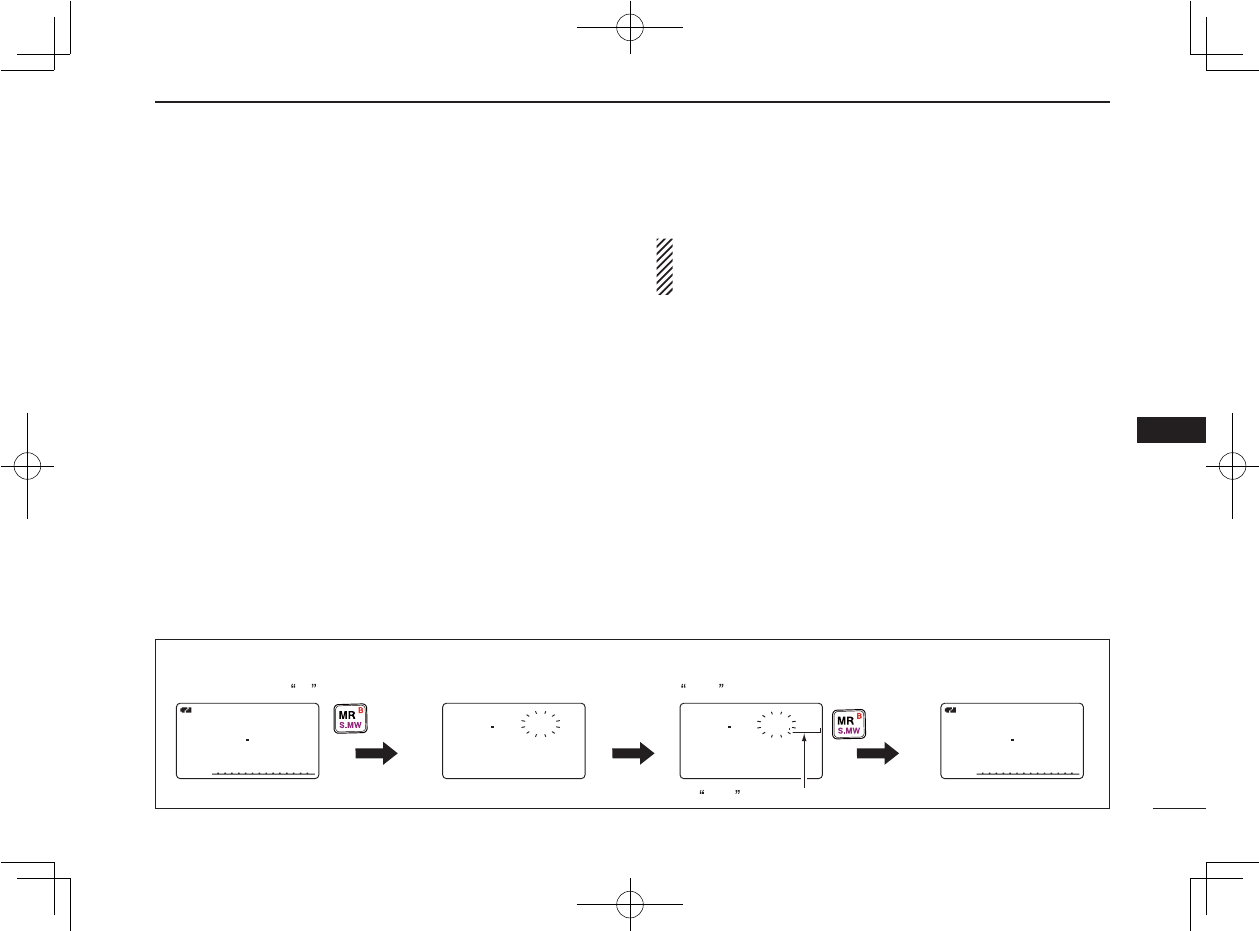
79
8
MEMORY/CALL CHANNELS
New2001
1
2
3
4
5
6
7
8
9
10
11
12
13
14
15
16
17
18
19
■ Copying memory/call contents
This function transfers a memory channel’s contents to
VFO (or another memory/call channel). This is useful when
searching for signals around a memory channel frequency
and for recalling the offset frequency, subaudible tone fre-
quency etc.
D Memory/call➪VFO
q Select the memory (call) channel to be copied.
➥ Push [MR] or [CALL] to select memory mode or call
channel mode, then rotate [DIAL] to select the desired
channel.
w Push and hold [S.MW](MR) for 1 sec. to enter select
memory write mode.
• 1 short and 1 long beep sound.
• “μ ” indicator blinks.
e Rotate [DIAL] to select “VFO.”
r Push and hold [S.MW](MR) for 1 sec. to write the selected
channel contents to VFO mode.
• Returns to VFO mode automatically.
Holding [S.MW](MR) for 2 sec. at the step w, will also
copy the memory contents to VFO. In this case, the steps
e and r are not necessary.
D Memory/call➪memory/call
q Select the memory (call) channel to be copied.
➥ Push [MR] or [CALL] to select memory mode or call
channel mode, then rotate [DIAL] to select the desired
memory channel.
w Push and hold [S.MW](MR) for 1 sec. to enter select
memory write mode.
• 1 short and 1 long beep sound.
• “μ ” indicator blinks.
• Do not hold [S.MW](MR) for more than 2 sec. otherwise the
memory contents will be copied to VFO.
e Rotate [DIAL] to select the target memory (call) channel.
r Push and hold [S.MW](MR) for 1 sec. again to copy.
A
FM
FM
145870
PSKIP
PSKIP
A
μ
FM
FM
14
145870
011
011
14
145000
FM
FM
μ
VFO
145
870
870
BANK
BANK
:----
:----
MNAME:
MNAME:
SKIP
SKIP
:OFF
:OFF
FM
FM
r
μ
011
011
During memory mode,
rotate [DIAL] to select
memory channel 11 .
Rotate [DIAL] to select
VFO .
Push and hold
for 1 sec.
VFO is selected.
MR
S.MW
BPush and hold
for 1 sec.
MR
S.MW
B
[EXAMPLE]: Copying memory channel 11 to VFO.
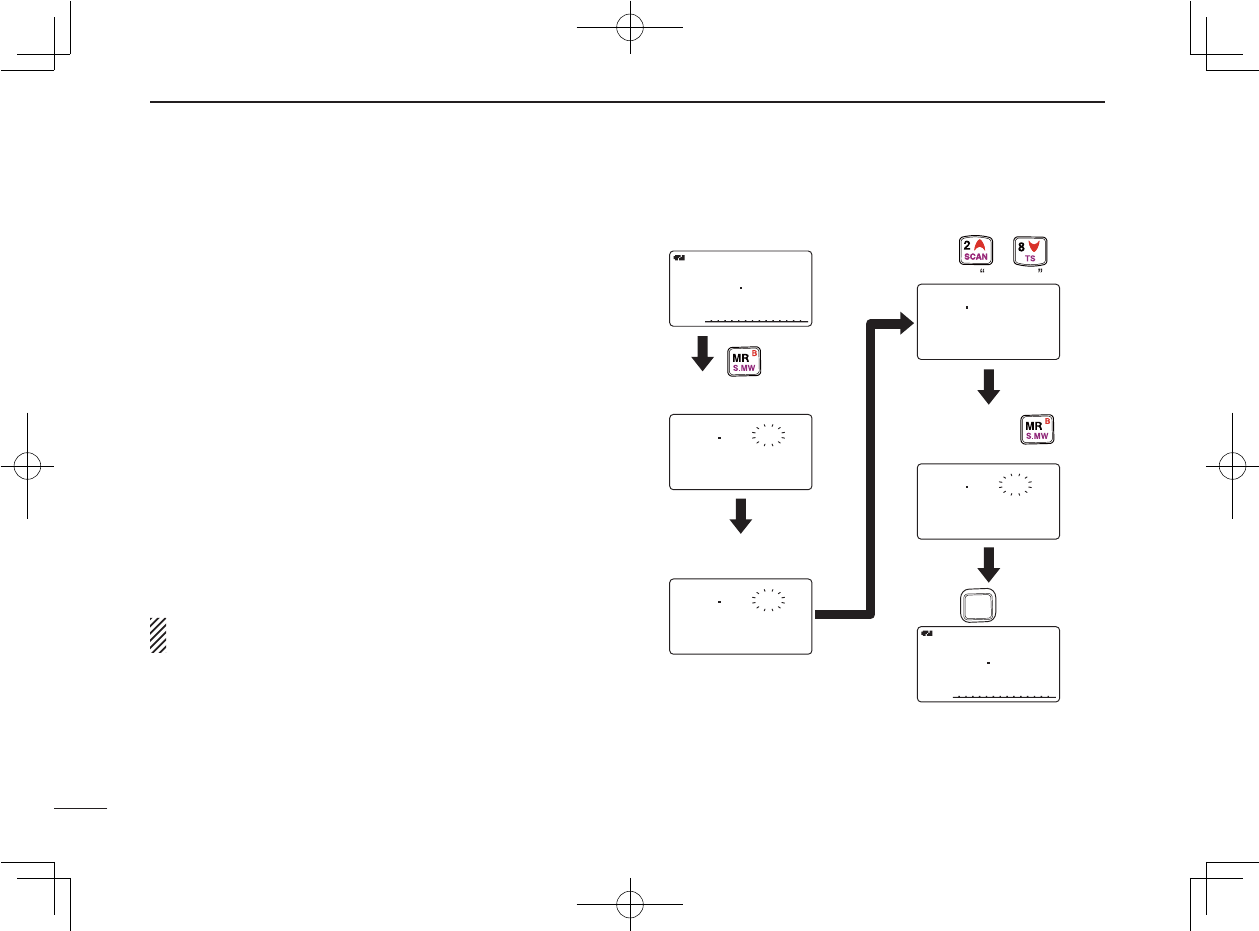
Ne
80
8MEMORY/CALL CHANNELS
New2001
■ Memory clearing
Contents of programmed memories can be cleared
(blanked), if desired.
q Push and hold [S.MW](MR) for 1 sec. to enter select
memory write mode.
• 1 short and 1 long beeps sound.
• “μ ” indicator blinks.
• Do not hold [S.MW](MR) for more than 2 sec. otherwise the
memory contents will be copied to VFO.
w Rotate [DIAL] to select the desired memory channel to be
cleared.
e Push [∫](2) or [√](8) to select “CLEAR.”
r Push and hold [S.MW](MR) for 1 sec. to clear the con-
tents.
• 3 beeps sound.
• The cleared channel changes to blank channel
• Return to select memory write mode.— “μ ” indicator blinks.
Push [VFO] to exit select memory write mode.
NOTE: Be careful!— the contents of cleared memories
CANNOT be recalled.
146
010
010
BANK
BANK
:----
:----
MNAME:
MNAME:
SKIP
SKIP
:OFF
:OFF
FM
r
μ
000
145
000
000
MNAME:
MNAME:
SKIP
SKIP
:OFF
:OFF
CLEAR
CLEAR
r
μ
005
005
A
FM
FM
145870
PSKIP
PSKIP
145
000
000
BANK
BANK
:----
:----
MNAME:
MNAME:
SKIP
SKIP
:OFF
:OFF
r
μ
005
BANK
BANK
:----
:----
MNAME:
MNAME:
SKIP
SKIP
:OFF
:OFF
r
μ
005
005
A
FM
145870
PSKIP
PSKIP
VFO mode
Rotate [DIAL] to select
the desired channel.
Push and hold
for 1 sec. to clear.
Push .
Return to the VFO mode.
Enter select memory
write mode.
Push and hold
for 1 sec.
Push
to select CLEAR .
or
MR
S.MW
B
MR
S.MW
B
2
SCAN
8
TS
VFO
MHz
A
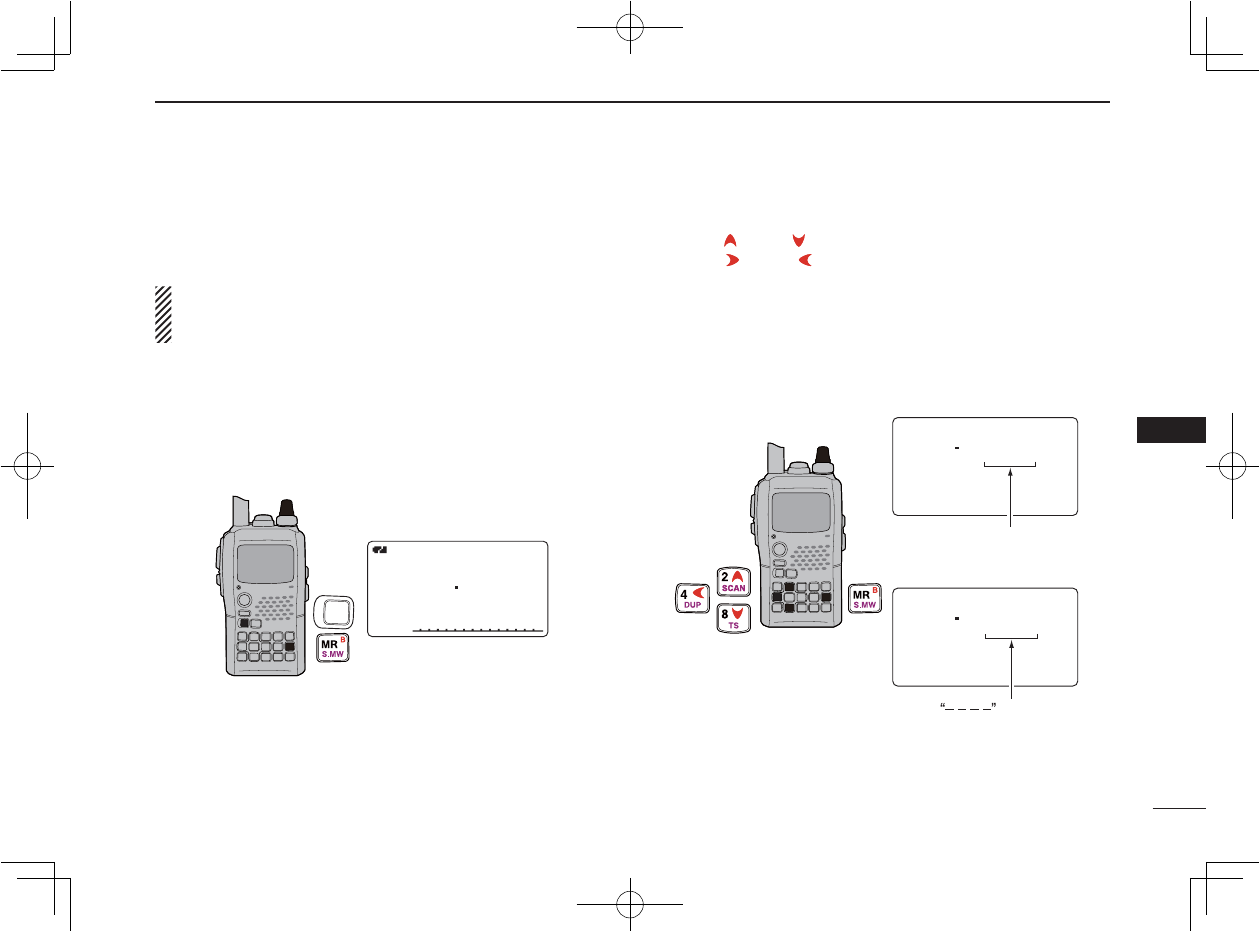
81
8
MEMORY/CALL CHANNELS
New2001
1
2
3
4
5
6
7
8
9
10
11
12
13
14
15
16
17
18
19
■ Erasing/transferring bank contents
The bank contents of programmed memory channels can be
cleared or reassigned to another memory bank.
INFORMATION: Even if the memory bank contents are
cleared, the memory channel contents still remain pro-
grammed.
q Select the desired bank contents to be transferred or
erased from the bank. (p. 68)
➥ Push [MR] several times to select memory bank mode.
➥ While pushing [BAND], rotate [DIAL] to select the de-
sired memory bank group.
➥ Rotate [DIAL] to select the bank channel.
w Push [S.MW](MR) for 1 sec. to enter select memory write
mode.
• 1 short and 1 long beeps sound.
• Displays the original memory channel number automatically
and “μ ” indicator blinks.
• Do not hold [S.MW](MR) for more than 2 sec., otherwise the
memory contents will be copied to VFO.
e Push [ ](2) or [ ](8) to select “BANK.”
r Push [](6) or [](4) several times to select the desired
bank group to be transferred.
• Select “– – – –” indication when erasing the contents from the
bank.
t Rotate [DIAL] to select the desired bank channel.
• Skip this step when “– – – –” indication is selected in step r.
y Push [S.MW](MR) for 1 sec. to erase/transfer the bank
contents.
[DIAL]
MR
S.MW
B
BAND
D
A
μ
FM
433000
C05
C05
14
145600
BANK
BANK
:----
:----
BNAME:
BNAME:
MNAME:
MNAME:
SKIP
SKIP
:OFF
:OFF
FM
FM
r
μ
025
14
145600
BANK
BANK
:B-11
:B-11
BNAME:
BNAME:
MNAME:
MNAME:
SKIP
SKIP
:OFF
:OFF
FM
FM
r
μ
025
To transfer the bank contents
to ch 11 in Bank B.
To erase
Bank channel is
displayed.
is displayed.
[DIAL]
MR
S.MW
B
2
SCAN
8
TS
4
DUP
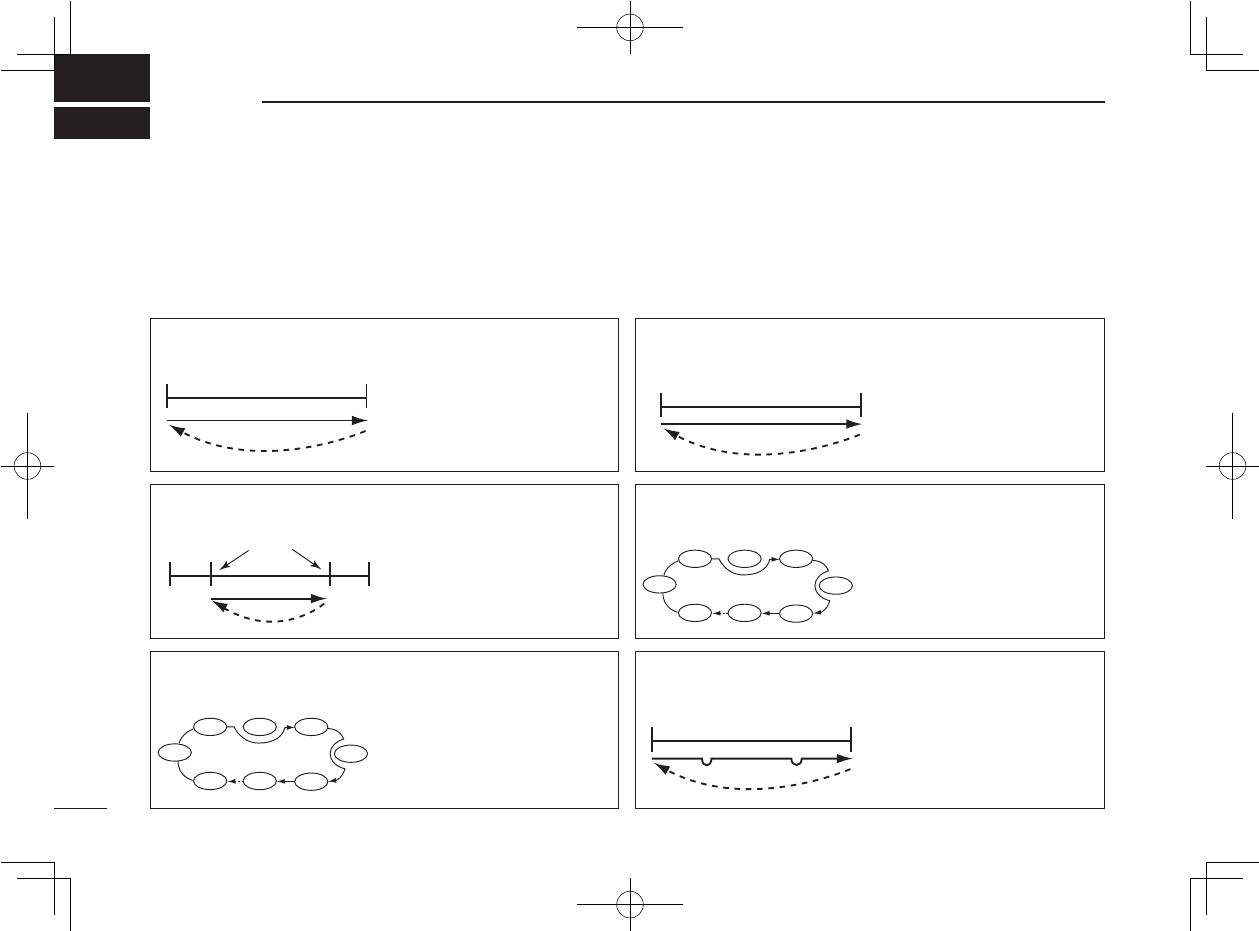
82
NeNew2001
SCAN OPERATION
9
■ Scan types
Scanning searches for signals automatically and makes it
easier to locate new stations for contact or listening pur-
poses.
There are 7 scan types and 4 resume conditions to suit your
operating needs.
FULL SCAN (p. 75) Repeatedly scans all fre-
quencies over the entire
band.
Some frequency ranges are
not scanned according to the
frequency coverage of the
transceiver’s version.
SELECTED BAND SCAN
(p. 75)
Repeatedly scans all fre-
quencies over the entire se-
lected band.
ALL/SELECTED BANK
SCAN (p. 78)
Repeatedly scans all bank
channels or selected bank
channels. The skip scan is
also available.
FREQUENCY/MEMORY
SKIP FUNCTION (p. 79)
Skips unwanted frequen-
cies or channels that incon-
veniently stop scanning.
This function can be turned
ON and OFF by pushing and
holding [SKIP](5) in either
VFO or memory mode.
PROGRAMMED SCAN
(p. 75)
Repeatedly scans between
two user-programmed fre-
quencies. Used for checking
for frequencies within a speci-
fied range such as repeater
output frequencies, etc.
MEMORY (SKIP) SCAN
(p. 77)
Repeatedly scans memory
channels except those set
as skip channel. Skip chan-
nels can be turned ON and
OFF by pushing and holding
[SKIP](5) in memory mode.
495
kHz
999.990
MHz
Scan
Jump
Band
edge
Band
edge
Scan
Jump
Band
edge xxA xxB
Band
edge
Scan edges
Scan
Jump
SKIP
SKIP
M 0 M 4
M 1 M 2 M 3
M 5
M 199
M 6
SKIP
SKIP
A99 A03
A00 A01 A02
A04
A98
A05
Band
edge
Band
edge
Scan
SKIP SKIP
Jump
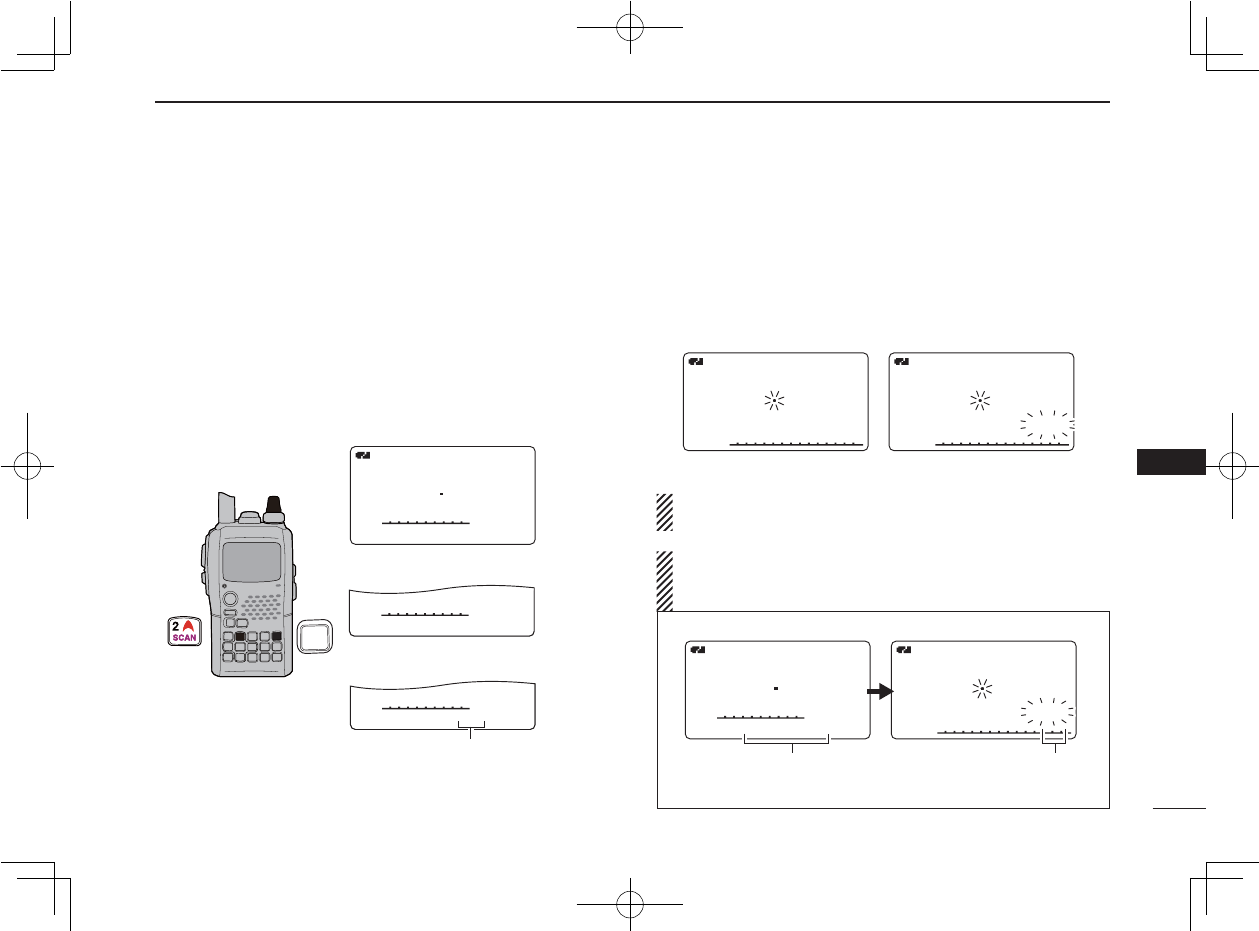
New2001
83
9
SCAN OPERATION
1
2
3
4
5
6
7
8
9
10
11
12
13
14
15
16
17
18
19
■ Full/band/programmed scan
q Push [VFO] to select VFO mode.
• Select the desired frequency band with [BAND], if desired.
w Set the squelch level.
e While pushing and holding [SCAN](2), rotate [DIAL] to
select the desired scanning type.
• “ALL” for full scan; “BAND” for band scan, “PROG-xx (or scan
name if programmed)” for programmed scan (xx= 0 to 24; pro-
grammed scan edges numbers are only displayed), “DUP” (ap-
pears only when duplex operation is set) for duplex scan.
r To start the scan, release [SCAN](2).
• Scan pauses when a signal is received.
• Rotate [DIAL] to change the scanning direction, or resumes
manually.
• Push [VFO] to stop the scan.
About the scanning steps: The selected tuning step in
each frequency band (in VFO mode) is used during scan.
Duplex scan function: Repeatedly scans two frequen-
cies (transmission/reception) during duplex scan opera-
tion.
FM
FM
A
148800
PSKI
PSKIP
P01
P01
FM
FM
A
148800
PSKI
PSKIP
SCAN:SCANNAME
SCAN:SCANNAME
Scan name
Scan name is not displayed during a programmed scan.
Scan edge number
Scan name selection
FM
FM
A
146010
SCAN:ALL
SCAN:ALL
FM
A
148 800
SCAN:BANDSCAN:BAND
FM
A
148 800
SCAN:PROG-01SCAN:PROG-01
PSKI
PSKIP
PSKI
PSKIP
PSKI
PSKIP
• Full scan selection
• Programmed scan selection
• Band scan selection
Selectable between “ 00” to “24”
if programmed.
[DIAL]
2
SCAN
VFO
MHz
A
FM
A
14
148800
FM
A
PSKI
PSKIP
PSKI
PSKIP
P01
P01
148800
• During full/band scan • During programmed scan
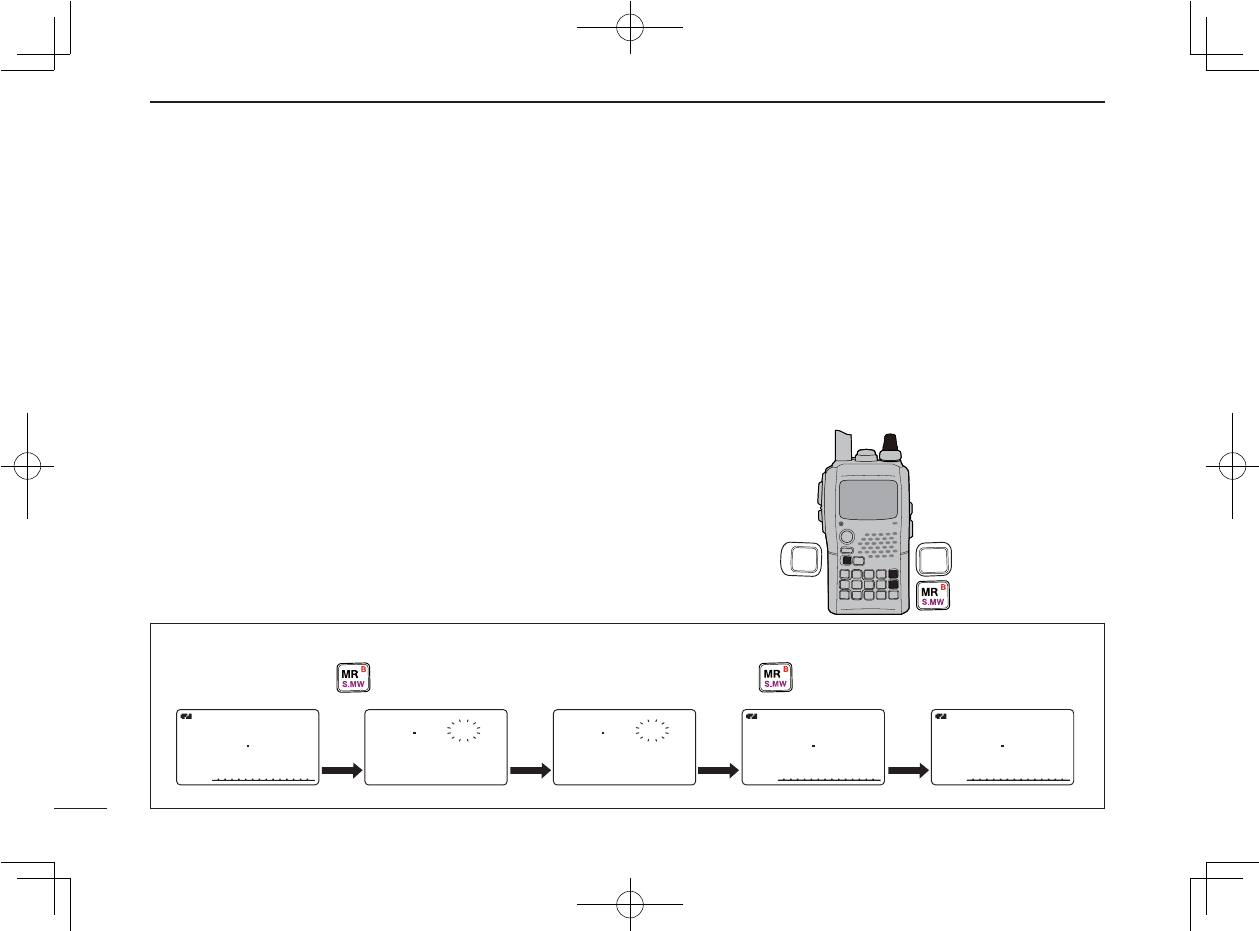
Ne
84
9SCAN OPERATION
New2001
■ Scan edges programming
Scan edges can be programmed in the same manner as
memory channels. Scan edges are programmed into scan
edges, 00A/00B to 24A/24B, in memory channels.
q Push [VFO] to select VFO mode.
w Set the desired frequency:
➥ Select the desired band with [BAND].
➥ Set the desired frequency with [DIAL].
➥ Set other data (e.g. offset frequency, duplex direction, tone
squelch, etc.), if desired.
e Push and hold [S.MW](MR) for 1 sec. to enter the select
memory write mode.
• 1 short and 1 long beeps sound.
• “μ ” indicator blinks.
r Rotate [DIAL] to select the desired programmed scan
edge channel from 00A to 24A.
t Push and hold [S.MW](MR) for 1 sec.
• 3 beeps sound.
• The other scan edge channel “B,” 00B to 24B, is automatically
selected when continuing to push [S.MW](MR) after program-
ming.
y To program a frequency for the other pair of scan edges,
00B to 24B, repeat steps w and r.
• If the same frequency is programmed into a pair of scan edges,
programmed scan will not function.
[EXAMPLE]: Programming 145.300 MHz into scan edges 03A.
[DIAL]
VFO
MHz
A
MR
S.MW
B
BAND
D
A
FM
FM
145300
PSKI
PSKIP
A
FM
145300
PSKI
PSKIP
03A
03A
A
FM
145300
PSKI
PSKIP
14
146
010
010
BANK
BANK
:----
:----
MNAME:
MNAME:
SKIP
SKIP
:OFF
:OFF
FM
r
μ
001
BANK
BANK
:----
:----
MNAME:
MNAME:
SNAME:
SNAME:
FM
FM
r
μ
03A
Push and hold for 1 sec. Rotate [DIAL] Push and hold for 1 sec.
MR
S.MW
BMR
S.MW
B
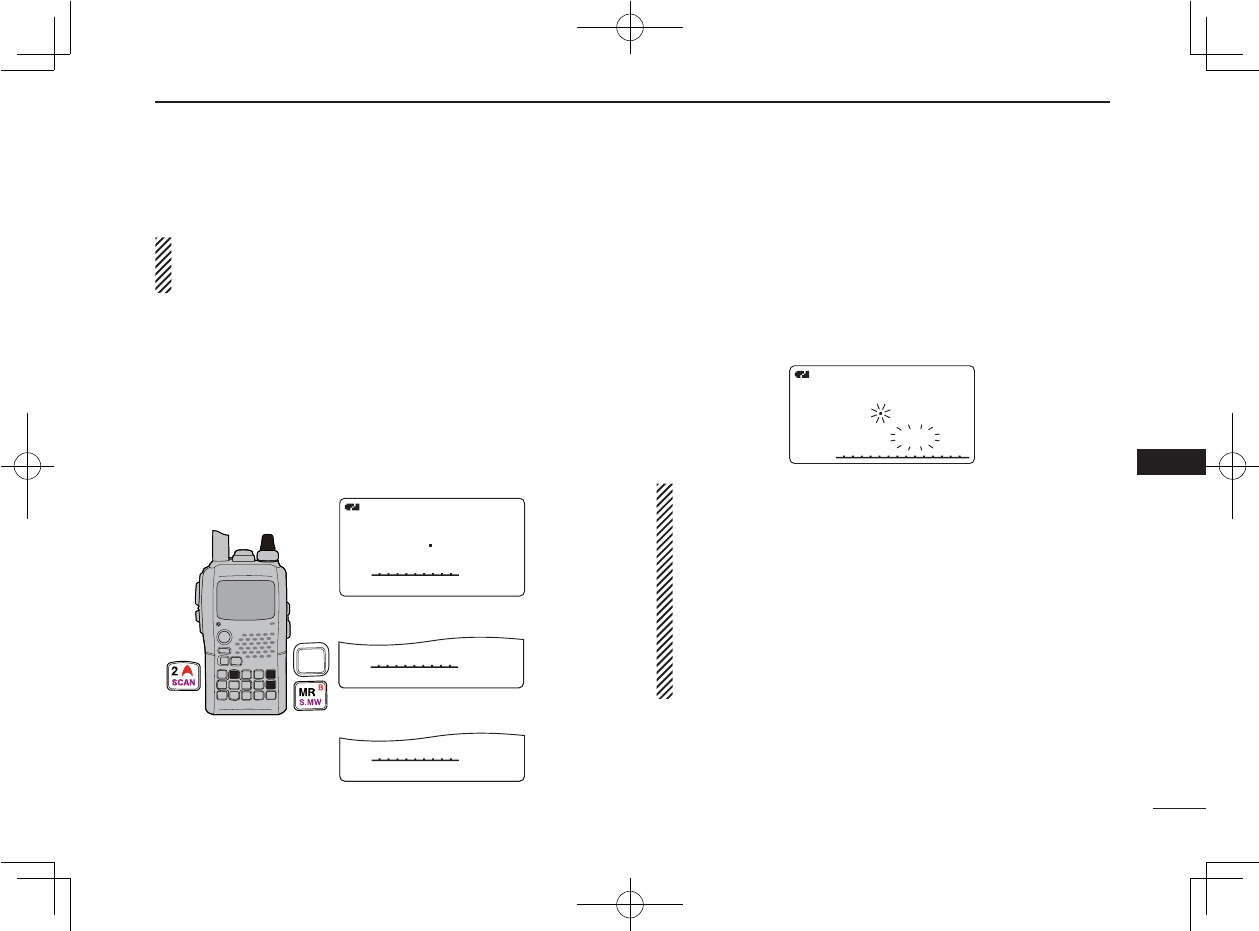
85
9
SCAN OPERATION
New2001
1
2
3
4
5
6
7
8
9
10
11
12
13
14
15
16
17
18
19
■ Memory scan
IMPORTANT!: To perform memory scan, 2 or more mem-
ory channels MUST be programmed, otherwise the scan
will not start.
q Push [MR] to select memory mode.
w Set the squelch level.
e While pushing and holding [SCAN](2), rotate [DIAL] to
select the desired scanning type.
• “ALL” for full memory scan; “BAND” for band memory scan,
“MODE” for mode scan, “DUP” (appears only when duplex op-
eration is set) for duplex scan.
r Release [SCAN](2) to start the selected scan.
• Scan pauses when a signal is received.
• Rotate [DIAL] to change the scanning direction, or resumes
manually.
t To stop the scan, push [VFO].
Band memory scan function: Repeatedly scans all
memory channels programmed with any frequencies of
the band programmed in the memory channel selected
for scanning.
Mode scan function: Repeatedly scans all memory
channels in which the same operating mode as the se-
lected memory channel has been programmed.
Duplex scan function: Repeatedly scans two frequen-
cies (transmission/reception) during duplex scan opera-
tion.
FM
A
146010
μ
088
088
SCAN:ALL
SCAN:ALL
FM
A
148 800
μ
088088
SCAN:BANDSCAN:BAND
FM
A
148 800
μ
088088
SCAN:MODESCAN:MODE
PSKI
PSKIP
PSKI
PSKIP
PSKI
PSKIP
• All memory scan selection
• Mode scan selection
• Band memory scan selection
[DIAL]
VFO
MHz
A
MR
S.MW
B
2
SCAN
FM
A
μ
012
148800
• During memory scan
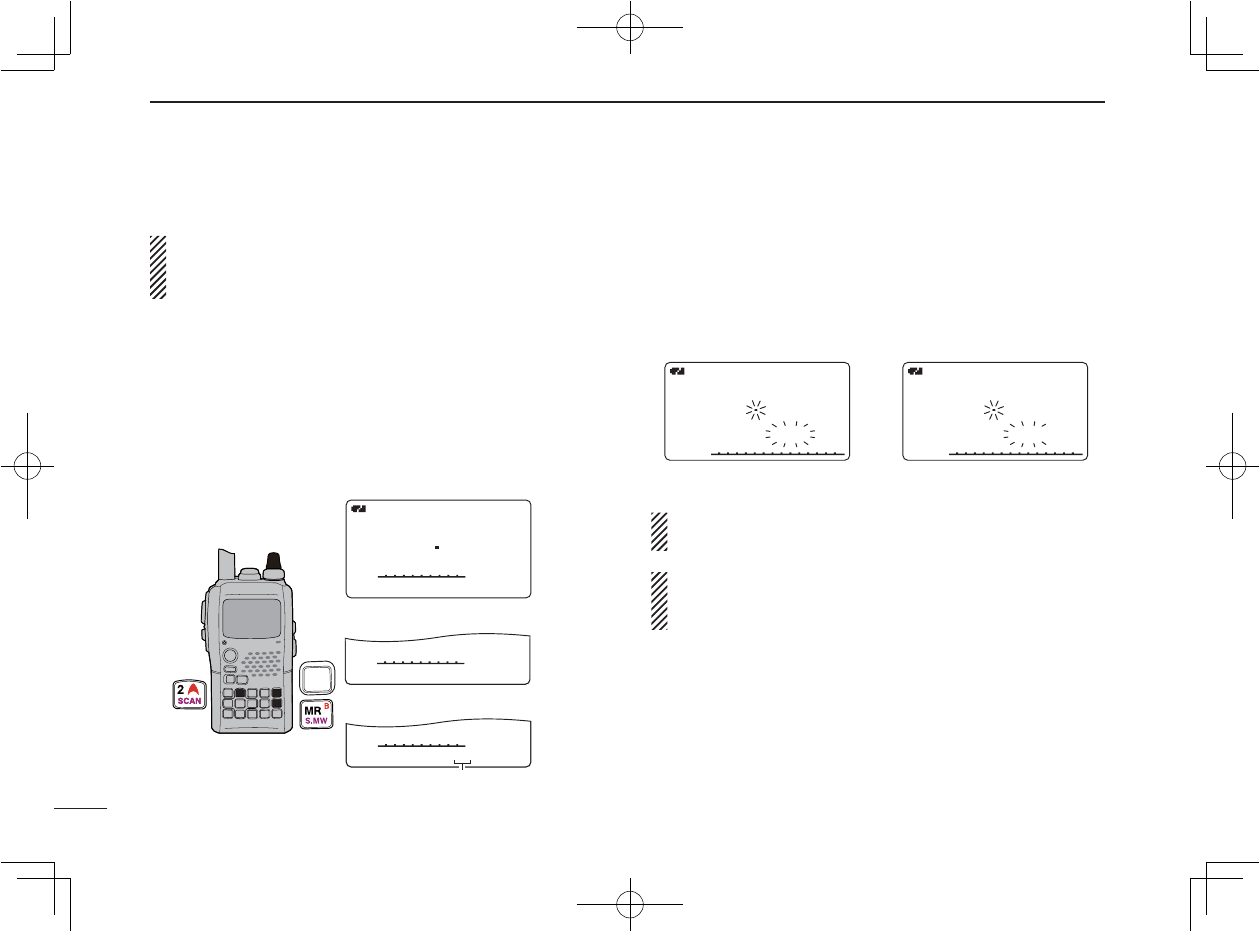
Ne
86
9SCAN OPERATION
New2001
■ Memory bank scan
IMPORTANT!: To perform memory bank scan, 2 or more
bank channels MUST be programmed, otherwise the
scan will not start.
q Push [S.MW](MR) several times to select memory bank
mode.
w Set the squelch level.
e While pushing and holding [SCAN](2), rotate [DIAL] to
select the desired scanning type.
• “ALL” for all bank scan; “BANK-LINK” for bank link scan or
“BANK-x” for bank scan (x= A to Z; programmed bank groups
are only displayed.), “DUP” (appears only when duplex opera-
tion is set) for duplex scan.
r Release [SCAN](2) to start the selected scan.
• Scan pauses when a signal is received.
• Rotate [DIAL] to change the scanning direction, or resumes
manually.
t To stop the scan, push [VFO].
The bank-link setting can be changed in scan set mode.
See page 97 for details.
Duplex scan function: Repeatedly scans two frequen-
cies (transmission/reception) during duplex scan opera-
tion.
FM
A
146010
μ
A01
A01
SCAN:ALL
SCAN:ALL
FM
A
148800
μ
A01
SCAN:BANK-LINKSCAN:BANK-LINK
FM
A
148800
μ
A01A01
SCAN:BANK-ASCAN:BANK-A
PSKI
PSKIP
PSKI
PSKIP
PSKI
PSKIP
• All bank scan selection
• Bank scan selection
• Bank link scan selection
Selectable between “A” to “Z”
if programmed.
[DIAL]
VFO
MHz
A
MR
S.MW
B
2
SCAN
FM
A
μ
888
148800
• During all bank/bank link scan • During bank scan
FM
A
μ
A88
148800
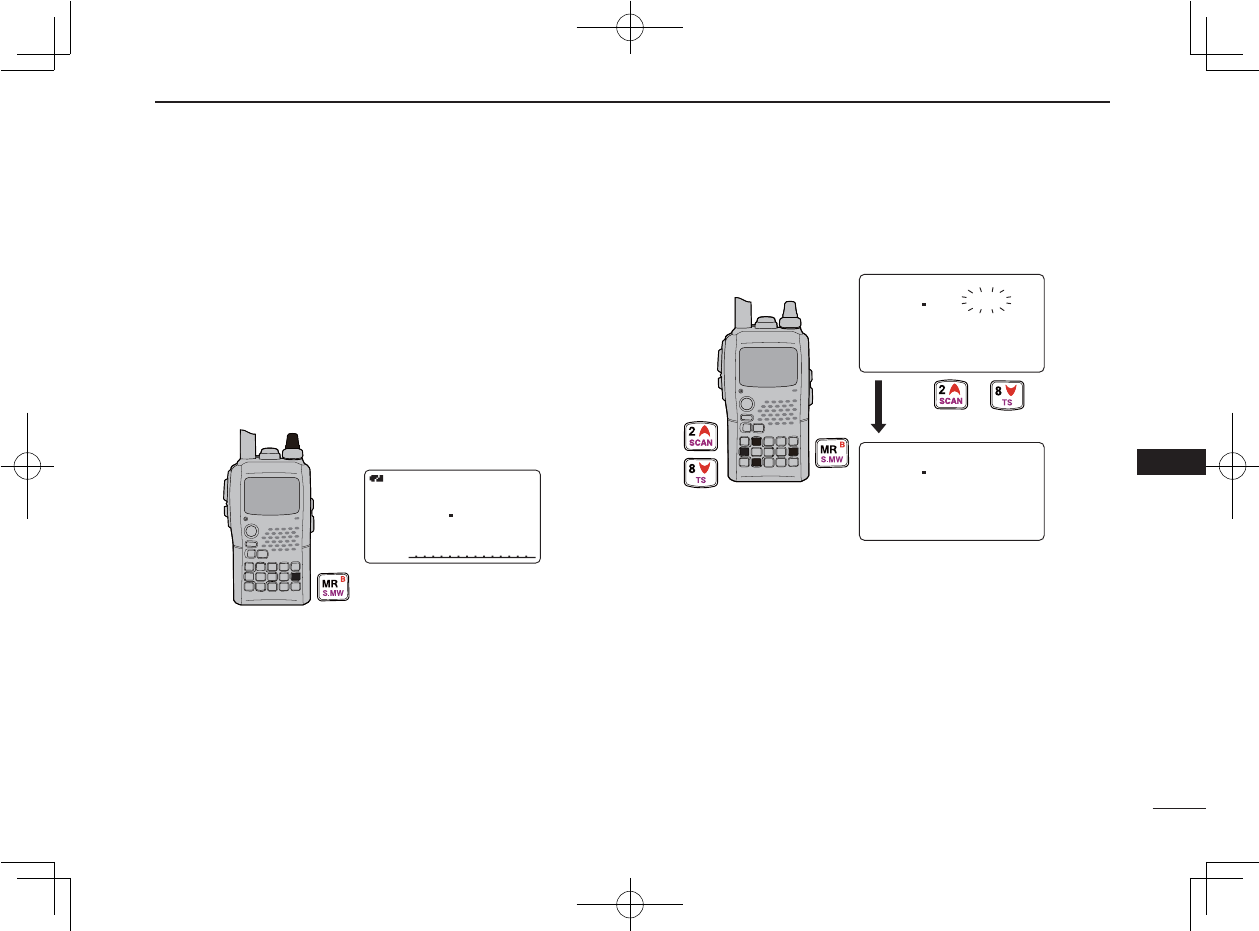
87
9
SCAN OPERATION
New2001
1
2
3
4
5
6
7
8
9
10
11
12
13
14
15
16
17
18
19
■ Skip channel/frequency setting
Memory channels can be set to be skipped for memory skip
scan. In addition, memory channels can be set to be skipped
for both memory skip scan and frequency skip scan. These
are useful to speed up the scan rate.
q Select a memory channel:
➥ Push [MR] to select memory mode.
➥ Rotate [DIAL] to select the desired channel to be a
skip channel/frequency.
w Push and hold [S.MW](MR) for 1 sec. to enter select
memory write mode.
e Push [∫](2) or [√](8) several times to select “SKIP.”
r Rotate [DIAL] to select the skip condition from “SKIP,”
“P SKIP” or “OFF” for the selected channel.
• P SKIP : The channel is skipped during memory/bank scan and
the programmed frequency is skipped during VFO
scan, such as programmed scan.
• SKIP : The channel is skipped during memory or bank scan.
• OFF : The channel is scanned during any scan.
(Continue to the next page.)
FM
FM
A
μ
020
020
145870
[DIAL]
MR
S.MW
B
146
010
010
BANK
BANK
:----
:----
MNAME:
MNAME:
SKIP
SKIP
:OFF
:OFF
FM
FM
r
μ
012
146
010
010
MNAME:
MNAME:
SKIP
SKIP
:OFF
:OFF
CLEAR
CLEAR
FM
FM
r
μ
012
or
several times.
Push
MR
S.MW
B
2
SCAN
8
TS
2
SCAN
8
TS
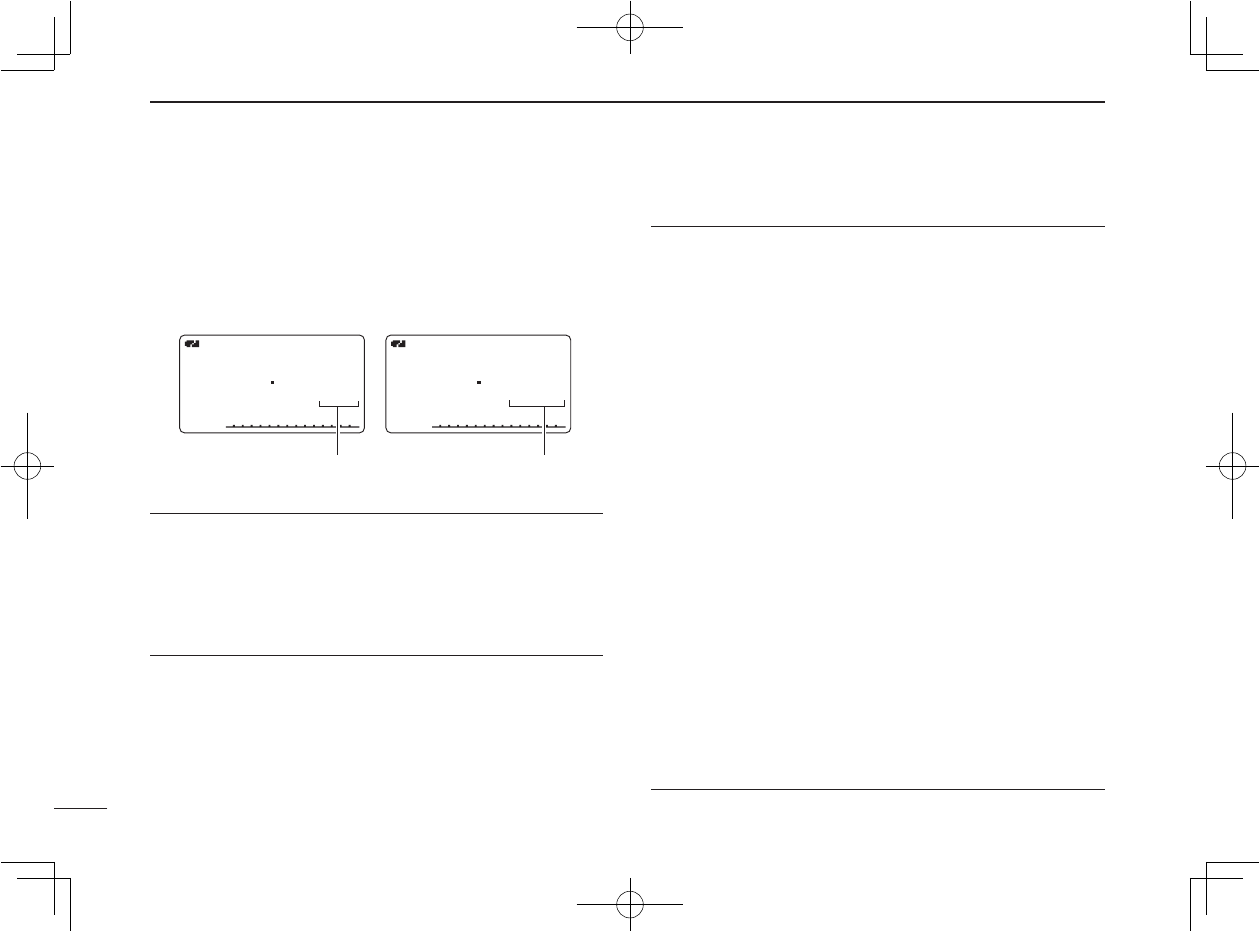
Ne
88
9SCAN OPERATION
New2001
t Push and hold [S.MW](MR) for 1 sec. to store the skip
condition into the memory.
• “SKIP” or “P SKIP” indicator appears, according to the skip se-
lection in the step r.
✔-CONVENIENT!
The the skip setting can be set with the following operation.
q Select the desired memory channel to be set as a skip
channel/frequency.
w
While pushing [SKIP](5), rotate [DIAL] to select the skip
condition from “P SKIP,” “SKIP” and “OFF
(no indication)
.”
✔-CONVENIENT!
During VFO scanning, such as programmed scan, the skip
setting can be programmed into the highest blank memory
channel which is automatically selected with the following
operation.
q Start the VFO scan.
➥ Push [VFO] to select VFO mode.
• Select the desired frequency band with [BAND], if desired.
➥ Set the squelch level.
➥ While pushing and holding [SCAN](2), rotate [DIAL] to
select the desired scanning type.
• “ALL” for full scan; “BAND” for band scan, “PROG-xx (or
scan name if programmed)” for programmed scan (xx= 0 to
24; programmed scan edges numbers are only displayed),
“DUP” for duplex scan.
➥ To start the scan, release [SCAN](2).
• Scan pauses when a signal is received.
• Rotate [DIAL] to change the scanning direction, or resumes
manually.
w When scan pauses and you want to set the paused fre-
quency as a skip frequency.
➥ Push and hold [SKIP](5) for 1 sec. to store the paused
frequency into the highest blank memory channel.
• While pushing and holding [SKIP](5), rotate [DIAL] to select
a skip condition from “SKIP,” “P-SKIP” and “OFF.”
• While pushing and holding [SKIP](5), scan pauses; and
after writing the frequency, scan resumes.
FM
A
μ
SKIP
SKIP
033
033
145700
FM
A
μ
PSKI
PSKIP
033
033
145700
• Skip channel setting • Program skip setting
“SKIP” appears “P SKIP” appears
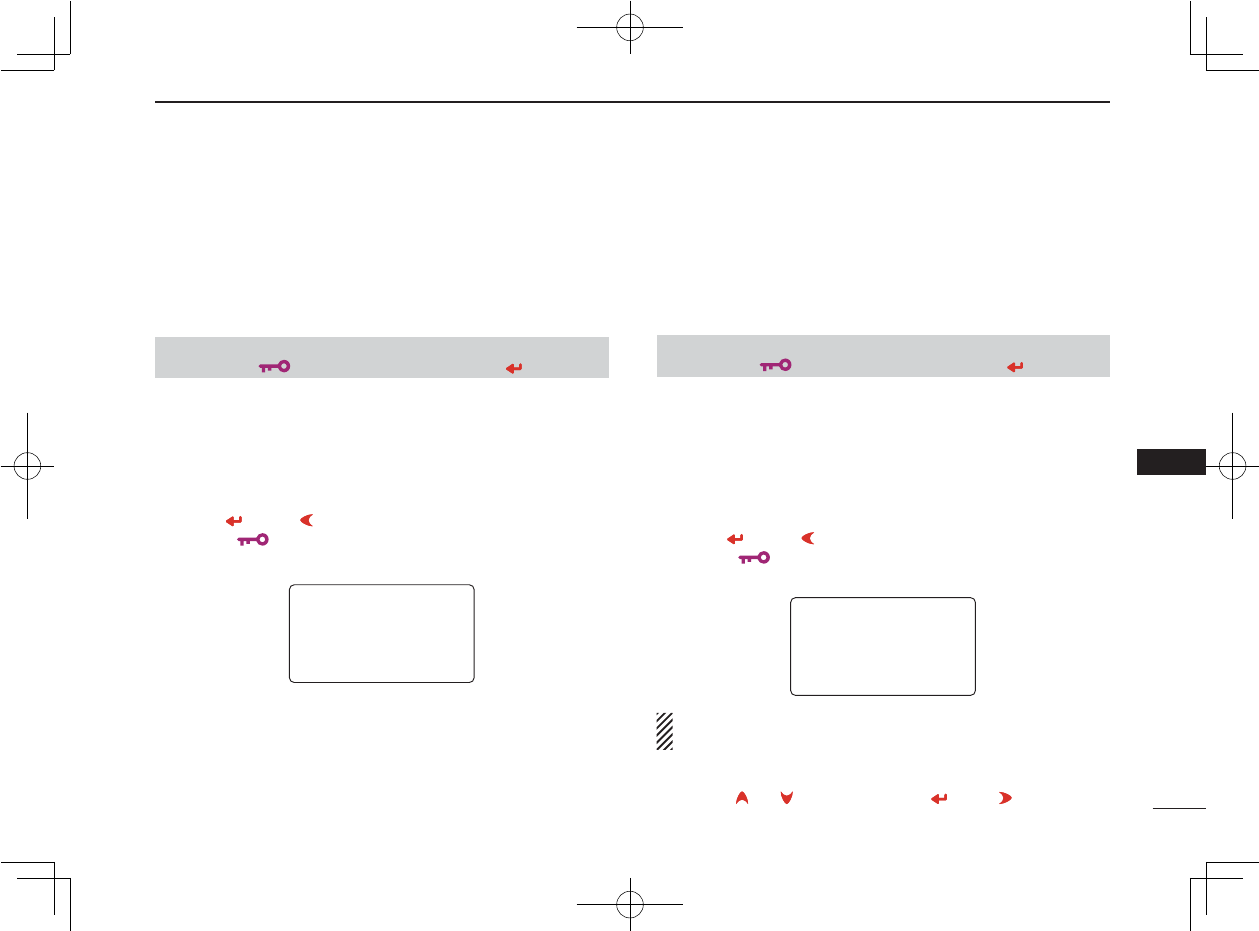
■ Scan resume condition
D Scan pause timer
The scan pauses when receiving signals according to the
scan pause time. It can be set from 2 to 20 sec. or unlimited.
q Enter “PAUSE” in scan set mode. (p. 96)
w Rotate [DIAL]† to set the desired scan pausing time from
2–20 sec. (2 sec. steps) or “HOLD.”
• “2SEC”–“20SEC” :- Scan pauses for 2–20 sec. while receiving a
signal.
• “HOLD” :- Scan pauses on a received a signal until it
disappears.
e Push [ ](5) (or [ ](4)) to return to scan set mode.
r [MENU/ ] to return to frequency indication.
D Scan resume timer
The scan restarts after the signal disappears according to
the resume time. It can be set from 0–5 sec. or unlimited.
q Enter “RESUME” in scan set mode. (p. 96)
w Rotate [DIAL]† to set the desired scan resume time from
0–5 sec. (1 sec. steps) and “HOLD.”
• “0SEC” :- Scan restarts immediately after the signal
disappears.
• “1SEC”–“5SEC” :- Scan restarts 1–5 sec. after the signal disap-
pears.
• “HOLD” :- Scan restarts by rotating [DIAL] only.
e Push [ ](5) (or [ ](4)) to return to scan set mode.
r [MENU/ ] to return to frequency indication.
Scan resume timer must be set shorter than the scan
pause timer, otherwise this timer does not activate.
89
9
SCAN OPERATION
New2001
1
2
3
4
5
6
7
8
9
10
11
12
13
14
15
16
17
18
19
❮MENU screen❯ ➪ ❮SCAN❯ ➪ ❮PAUSE❯
(Push [MENU/ ]) (Rotate [DIAL]†, then push [ ](5)†.)
10SEC
6SEC
8SEC
4SEC
12SEC
PAUSE TIMER
PAUSE TIMER
r
• Pause timer setting
❮MENU screen❯ ➪ ❮SCAN❯ ➪ ❮RESUME❯
(Push [MENU/ ]) (Rotate [DIAL]†, then push [ ](5)†.)
• Resume timer setting
2SEC
4SEC
3SEC
1SEC
5SEC
RESUME TIMER
RESUME TIMER
r
†[DIAL] ↔ [ ](2)/[](8) [ ](5) ↔ [ ](6)
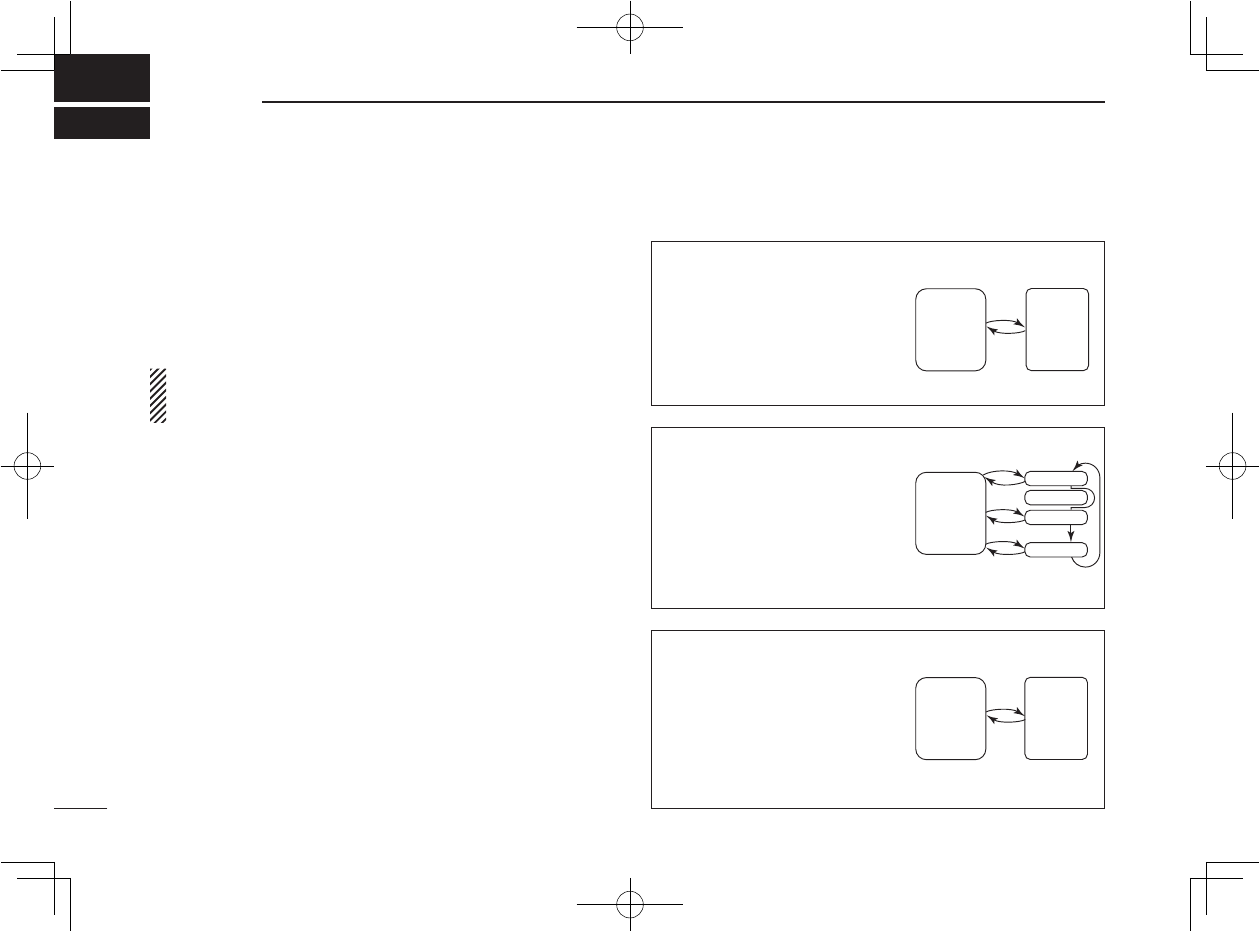
90
NeNew2001
PRIORITY WATCH
10
■ Priority watch types
Priority watch checks for signals on the frequency every
5 sec. while operating on a VFO frequency or scanning. The
transceiver has 3 priority watch types to suit your needs.
The watch resumes according to the selected scan resume
condition. See page 81 for details.
NOTE: If the pocket beep function is activated, the trans-
ceiver automatically selects the tone squelch function
when priority watch starts.
D About priority beep function
When receiving a signal on the priority frequency, you can
be alerted with beeps and a blink “S.” This function can
be activated when setting the priority watch function ON.
MEMORY/CALL CHANNEL WATCH
While operating on a VFO fre-
quency, priority watch checks
for a signal on the selected
every 5 sec.
• A memory channel with skip infor-
mation can be watched.
MEMORY SCAN WATCH
While operating on a VFO fre-
quency, priority watch checks
for signals on each memory
channel in sequence.
• The memory skip function and/or
memory bank scan is useful to
speed up the scan.
VFO SCAN WATCH
While scanning in VFO mode,
priority watch checks for signals
on the selected every 5 sec.
5 sec.
VFO
frequency
Memory
(Call)
channel
5 sec.
VFO
frequency
SKIP
Mch 000
Mch 001
Mch 001
Mch 999
5 sec.
VFO
scan
Memory
(Call)
channel
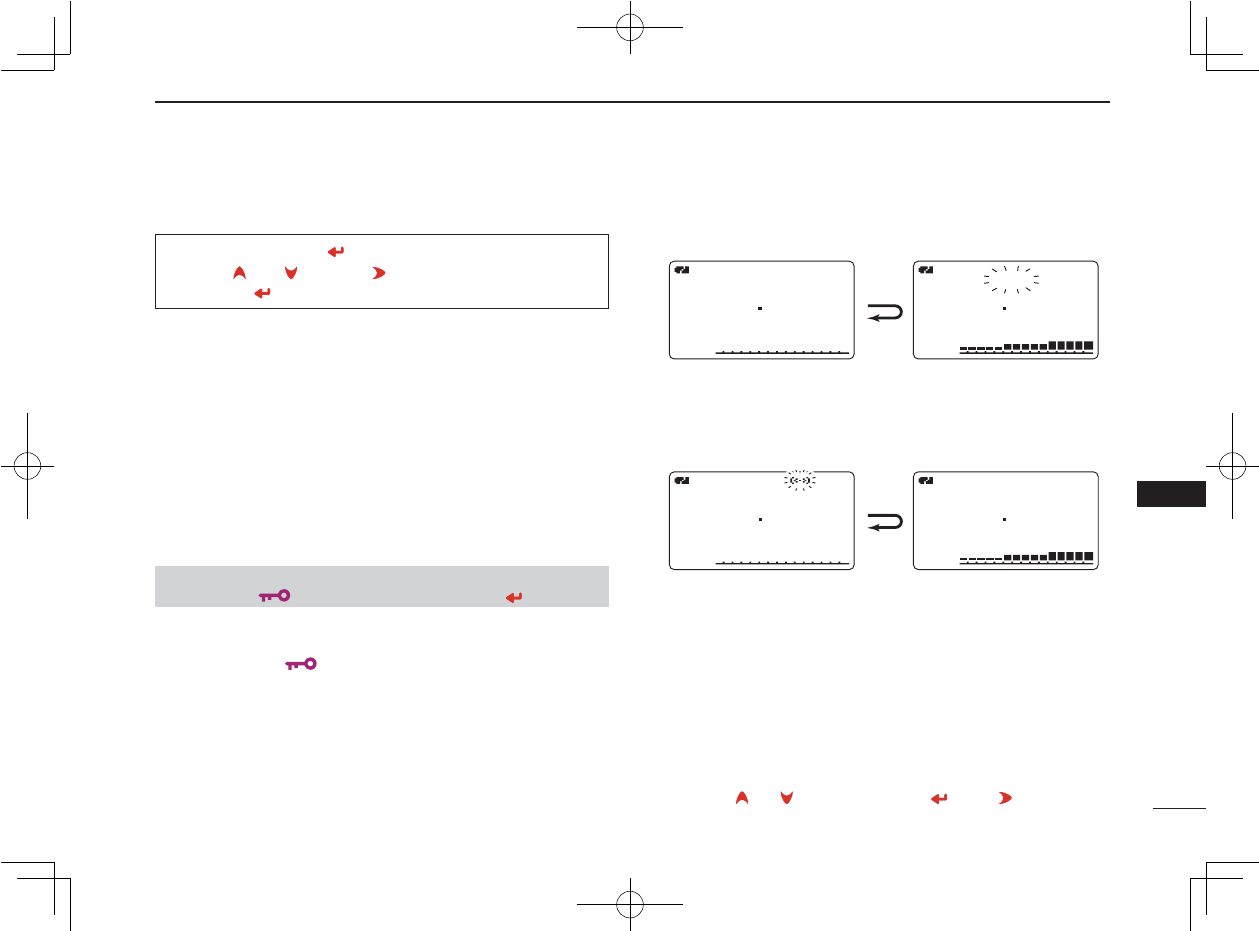
■ Priority watch operation
D Memory/call channel and memory scan watch
q Select VFO mode; then, set an operating frequency.
w Set the watching channel(s).
For memory channel watch:
Select the desired memory channel.
For call channel watch:
Select the desired call channel.
For memory scan watch:
Select memory mode, or the desired bank group; then,
push and hold [SCAN](2) for 1 sec. to start memory/bank
scan.
e Enter “PRIO WATCH” in scan set mode. (p. 96)
r Rotate [DIAL]† to select “ON.”
• Select “BELL” if the priority beep function is desired.
t Push [MENU/ ] to exit scan set mode and start the
watch.
• “PRIO” indicator appears.
• The transceiver checks the memory/bank channel(s) or call
channel every 5 sec.
• The watch resumes according to the selected scan resume
condition. (p. 81)
y Push [VFO] to cancel the watch.
New2001
91
10
PRIORITY WATCH
1
2
3
4
5
6
7
8
9
10
11
12
13
14
15
16
17
18
19
Although [DIAL] and [ ](5) are used for description in this
section, [](2)/[](8) and [](6) are available instead of
[DIAL] and [](5).
❮MENU screen❯ ➪ ❮SCAN❯ ➪ ❮PRIO WATCH❯
(Push [MENU/ ]) (Rotate [DIAL]†, then push [ ](5)†.)
• During priority watch
Monitors VFO frequency
for 5 sec.
Pauses on a memory or
call channel when a
signal is received.
• During priority watch with priority beep
Emits beep and blinks “S” indicator when a signal is
received on a memory or call channel.
PRIO
PRIO
FM
FM
A
145180
μ
035
035
PRIO
PRIOFM
A
433260
PSKI
PSKIP
PRIO
PRIO
FM
FM
A
145180
μ
035
035
PRIO
PRIOFM
A
433260
PSKI
PSKIP
†[DIAL] ↔ [ ](2)/[](8) [ ](5) ↔ [ ](6)
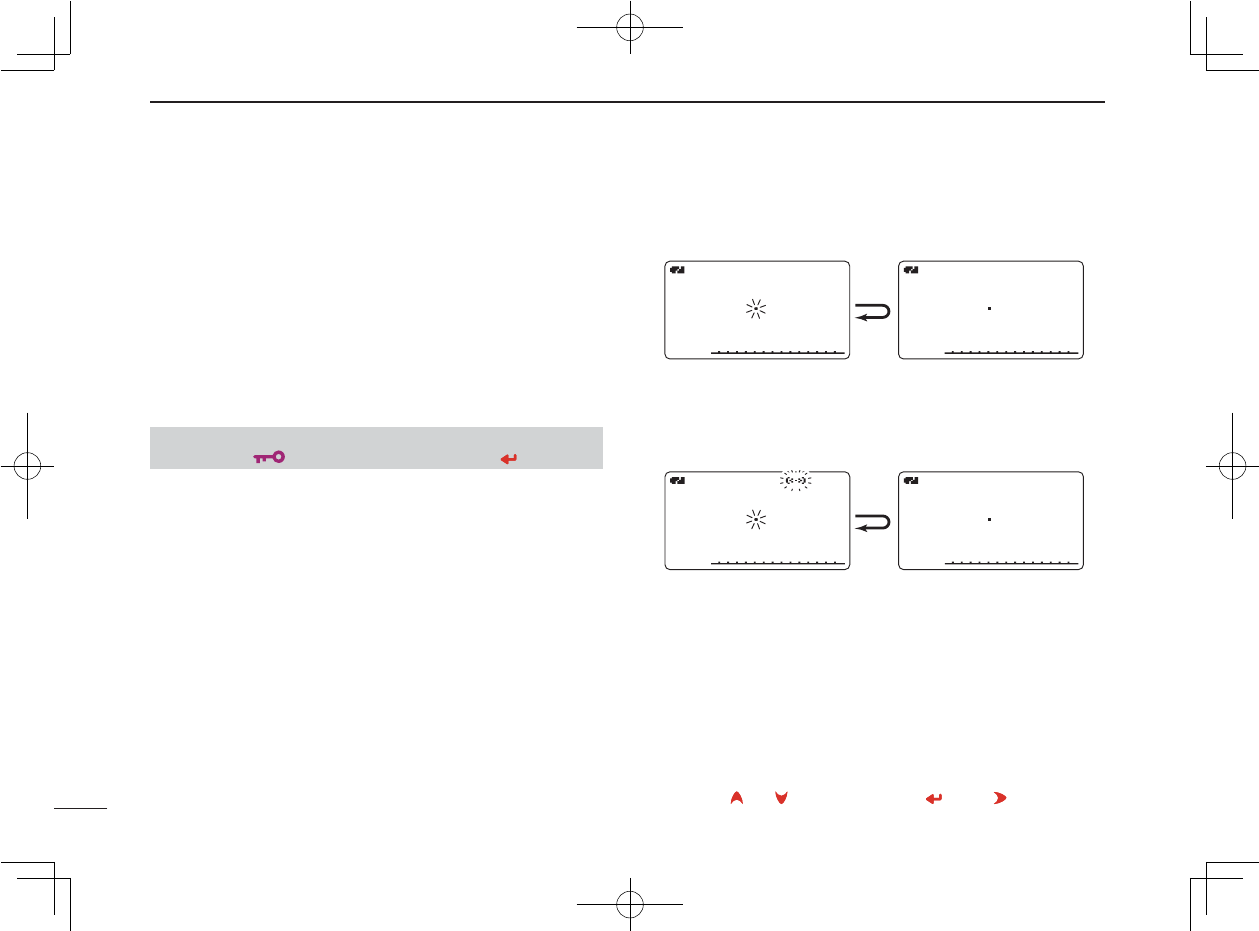
92
10 PRIORITY WATCH
New2001
D VFO scan watch
q Set the watching channel(s).
For memory channel watch:
Select the desired memory channel.
For call channel watch:
Select the desired call channel.
For memory scan watch:
Select memory mode, or the desired bank group; then,
push and hold [SCAN](2) for 1 sec. to start memory/bank
scan.
w Enter “PRIO WATCH” in scan set mode. (p. 96)
e Rotate [DIAL]† to select “ON.”
• Select “BELL” if the priority beep function is desired.
r Push [VFO] to exit scan set mode and start the watch.
• “PRIO” indicator appears.
t Push and hold [SCAN](2) for 1 sec. to enter scan type se-
lection condition.
y Rotate [DIAL] to select the desired scan type from “ALL,”
“BAND” and “PROG-xx (xx= 0–24),” “DUP.”
u Release [SCAN](2) to start the VFO scan watch.
• The transceiver checks the memory/bank channel(s) or call
channel every 5 sec.
• The watch resumes according to the selected scan resume
condition. (p. 81)
i Push [VFO] to cancel the watch.
❮MENU screen❯ ➪ ❮SCAN❯ ➪ ❮PRIO WATCH❯
(Push [MENU/ ]) (Rotate [DIAL]†, then push [ ](5)†.)
• During priority watch
Searches VFO frequencies
for 5 sec.
Pauses on a memory or
call channel when a
signal is received.
• During priority watch with priority beep
Emits beep and blinks “S” indicator when a signal is
received on a memory or call channel.
PRIO
PRIO
FM
FM
A
145000
μ
000
000
PRIO
PRIOFM
A
888800
PSKI
PSKIP
PRIO
PRIOFM
A
145000
μ
000
000
PRIO
PRIO
FM
FM
A
888800
PSKI
PSKIP
†[DIAL] ↔ [ ](2)/[](8) [ ](5) ↔ [ ](6)
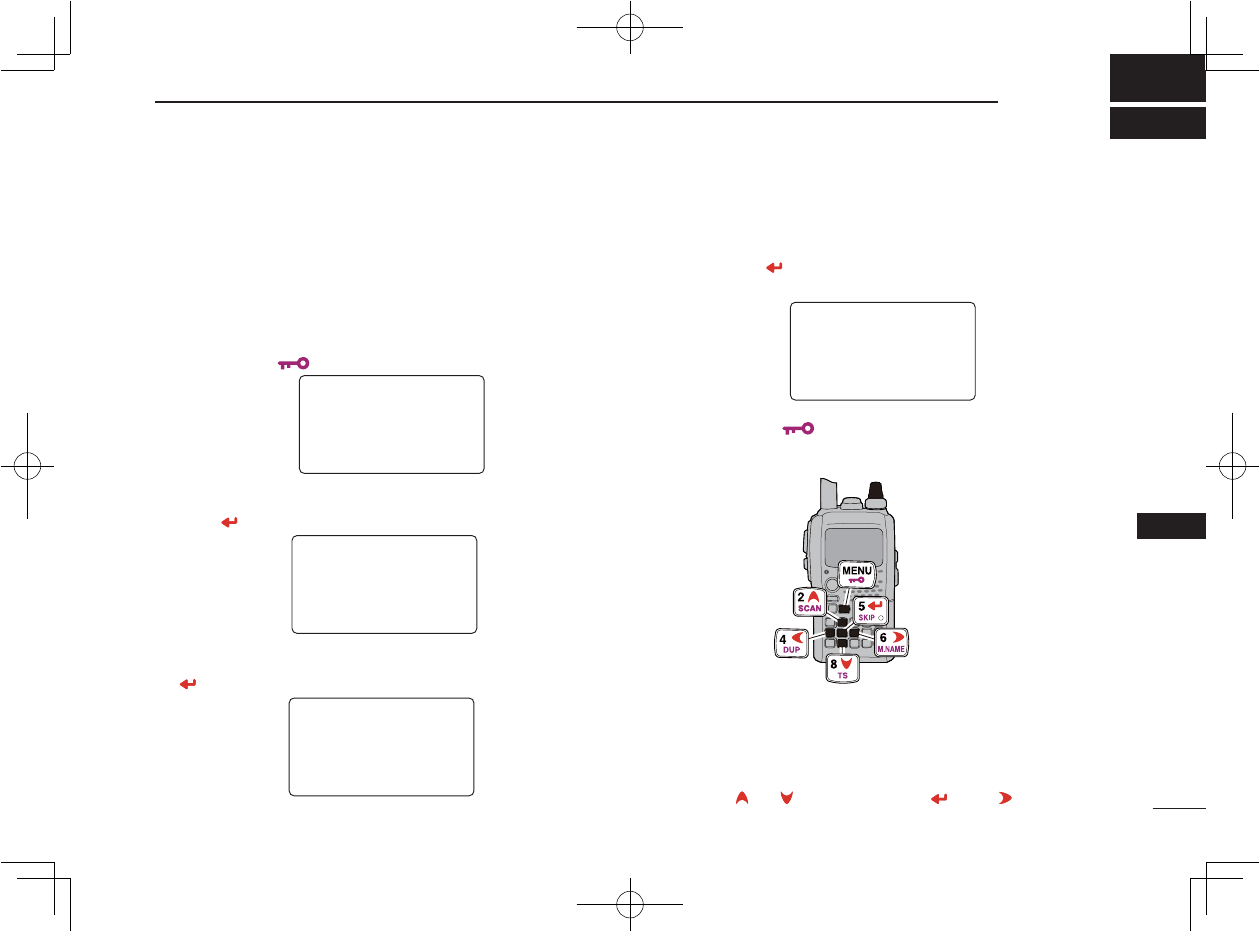
93
11
MENU SCREEN OPERATION
1
2
3
4
5
6
7
8
9
10
11
12
13
14
15
16
17
18
19
■ General
MENU screen is used for programming infrequently changed
values or conditions of functions.
D Entering MENU screen and operation
e.g.) Set “AUTO power OFF” to 30 minutes.
q Push [MENU/ ] to enter MENU screen.
w Rotate [DIAL]† to select the desired menu group, then
push [](5)†.
e Rotate [DIAL]† to select the desired item, then push
[](5)†.
r Rotate [DIAL]† to select the desired value or condition,
then push [](5) to return to the setting item selection
mode.
t Push [MENU/ ] to return to frequency indication, re-
peat steps w to r to set another items.
SET MODE
SET MODE
SCAN
DUP/TONE...
DUP/TONE...
DISPLAY
DISPLAY
SOUNDS
***** MENU *****
***** MENU *****
r
• MENU groups
appear.
AP OFF
AP OFF
POWER SAVE
POWER SAVE
ATTENUATOR
ATTENUATOR
MONITOR
MONITOR
DIAL SPEED
DIAL SPEED
SET MODE
SET MODE
r
• Setting items
appear.
OFF
30MIN
60MIN
90MIN
120MIN
AUTO POWER OFF
AUTO POWER OFF
r
OFF
30MIN
60MIN
90MIN
120MIN
120MIN
AUTO POWER OFF
AUTO POWER OFF
r
[DIAL]
MENU
2
SCAN
8
TS
4
DUP
6
M.NAME
5
SKIP
†[DIAL] ↔ [ ](2)/[](8) [ ](5) ↔ [ ](6)
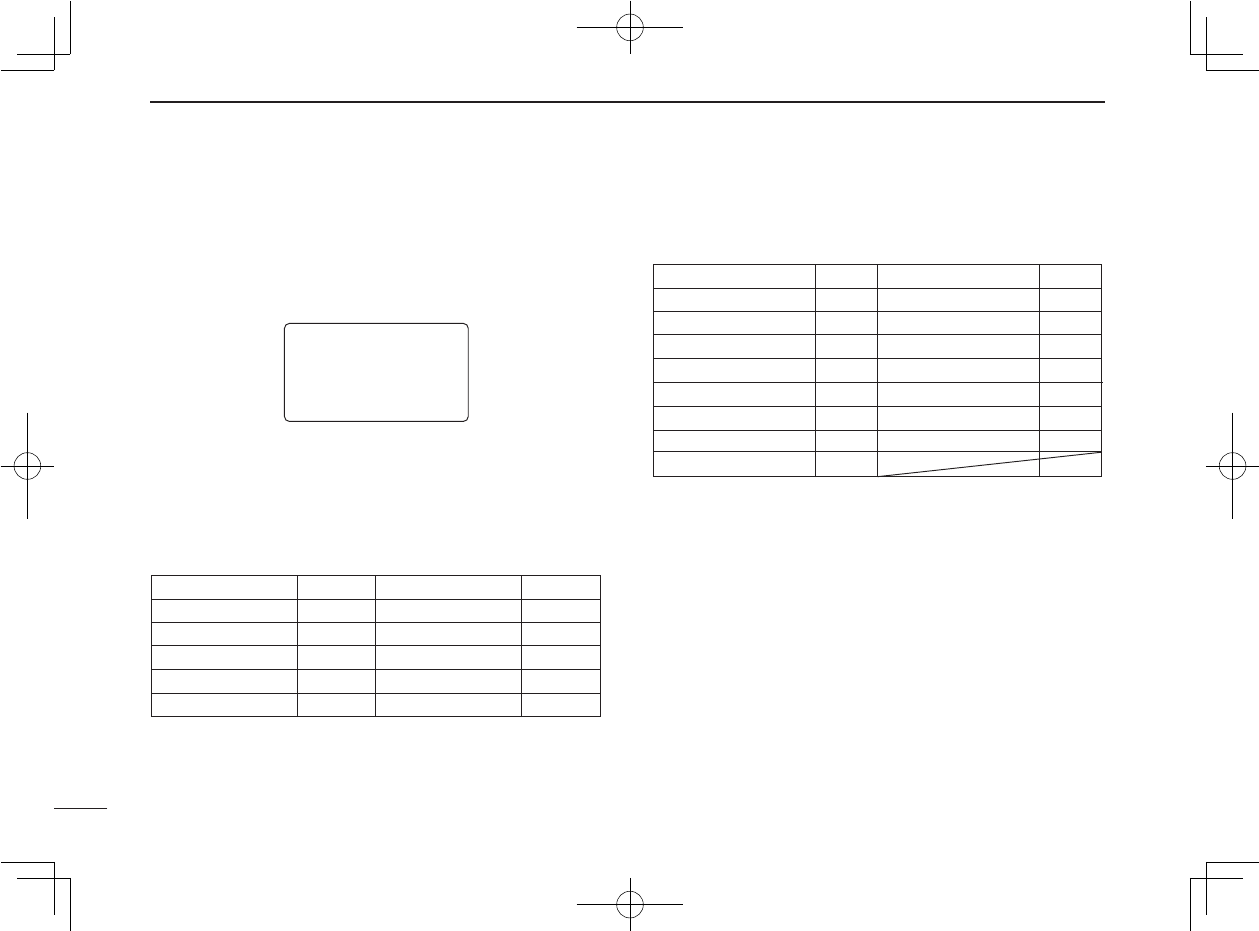
Ne
94
11 MENU SCREEN OPERATION
New2001
■ MENU screen indication for B
band*
While B band is selected, MENU screen shows following in-
dication.
*The optional UT-121 is required for IC-92A.
■ Menu list
†Refer to the chapter 7 for details.
■ Items list
D Set mode
RX CALL S
RX CALL S
MESSAGE/POS
DV VOICE M
SET MODE
DV SET MODE
DV SET MODE
***** MENU *****
***** MENU *****
r
MENU screen indication for B band.
pgs. 92–95
pgs. 96, 97
pgs. 97–99
pgs. 99–101
p. 102
—
—
—
—
pgs. 88–91
CALL SIGN†
RX CALL SIGN†
MESSAGE/POSITION†
DV VOICE MEMO†
SET MODE
MENU REF.
DV SET MODE
SCAN
DUP/TONE…
DISPLAY
SOUNDS
MENU REF.
AUTO POWER OFF
POWER SAVE
ATTENUATOR
MONITOR
DIAL SPEED-UP
AUTO REPEATER
MIC SIMPLE MODE
WEATHER ALERT
ITEMS
p. 88
p. 88
p. 88
p. 89
p. 89
p. 89
p. 90
p. 90
REF.
AUTO POWER ON
LOCK
PTT LOCK
BUSY LOCKOUT
TIME-OUT TIMER
ACTIVE BAND
DIAL REPLACE
ITEMS
p. 90
p. 90
p. 91
p. 91
p. 91
p. 91
p. 91
REF.
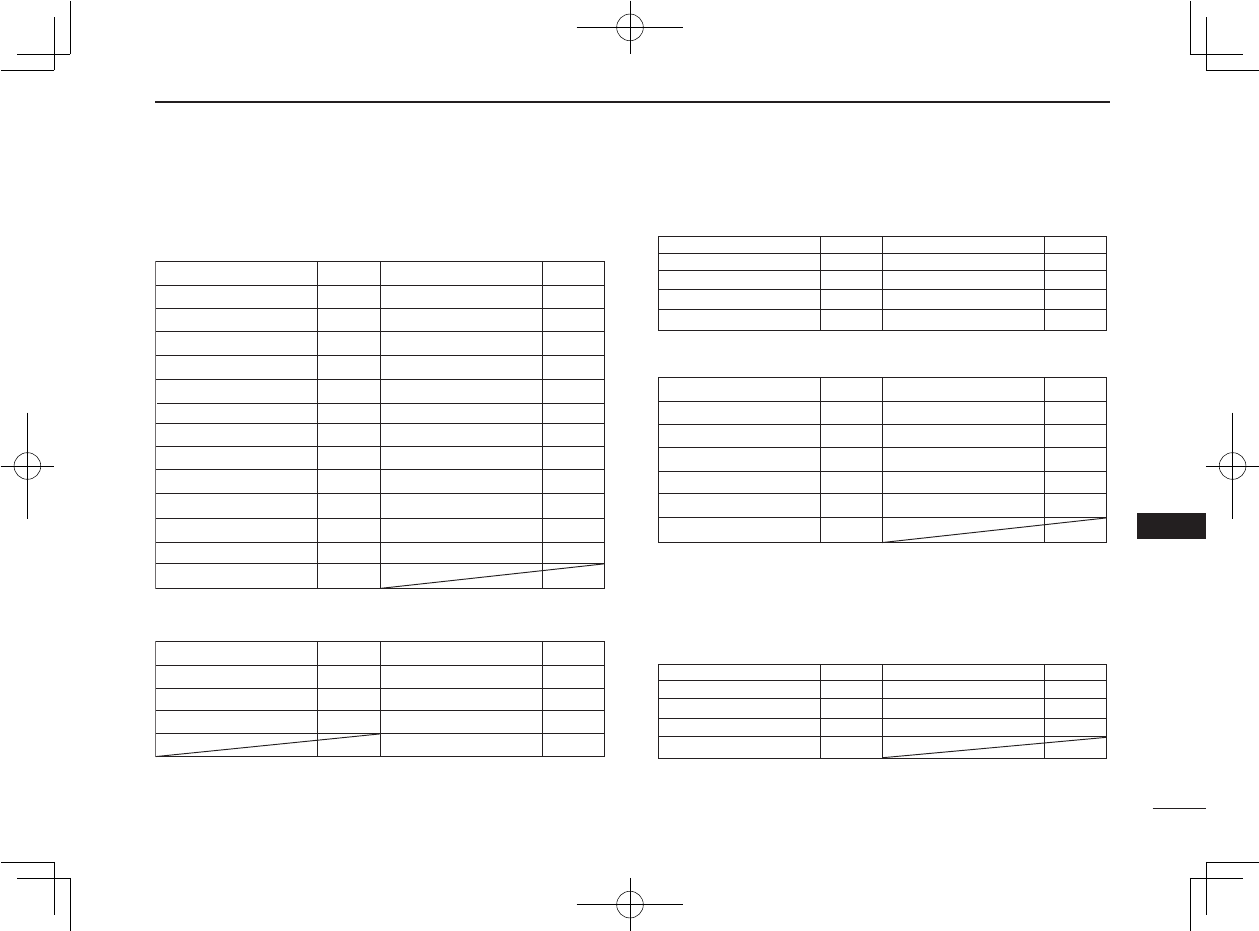
95
11
MENU SCREEN OPERATION
New2001
1
2
3
4
5
6
7
8
9
10
11
12
13
14
15
16
17
18
19
D DV set mode
Available for B band of IC-92AD, or if the UT-121 is installed in the
IC-92A.
D Scan set mode
‡
Not available during the TV band or weather channel mode selec-
tion.
D DUP/TONE set mode
Not available for the TV and weather channel mode.
D DISPLAY set mode
*1
Available for B band of IC-92AD, or UT-121 is installed IC-92A
only.
*2
Available for B band of IC-92AD, or if the UT-121 is installed in the
IC-92A.
D SOUNDS set mode
*1
Available for B band of IC-92AD, or if the UT-121 is installed in the
IC-92A.
OFFSET FREQ
REPEATER TONE
CTCSS TONE
DTCS CODE
ITEMS
p. 97
p. 97
p. 98
p. 98
REF.
DTCS POLARITY
DTMF SPEED
DTMF SPEED
DTMF TX KEY
ITEMS
p. 98
p. 99
p. 99
p. 99
REF.
BACKLIGHT
BUSY LED
LCD CONTRAST
RX CALL SIGN*1
TX CALL SIGN*1
RX MESSAGE*1
ITEMS
p. 99
p. 99
p. 100
p. 100
p. 100
p. 100
REF.
SCROLL
SCAN NAME
OPENING LOGO
OPENING CALL S*2
FONT SIZE
ITEMS
p. 101
p. 101
p. 101
p. 101
p. 101
REF.
BEEP LEVEL
KEY-TOUCH BEEP
SCAN STOP BEEP
SCOPE AF OUTPUT
ITEMS
p. 102
p. 102
p. 102
p. 102
REF.
VOLUME SELECT
STANDBY BEEP*1
SUB BAD MUTE
ITEMS
p. 102
p. 102
p. 103
REF.
AUTO REPLY
DIGITAL CODE
DV DATA TX
DIGITAL MONITOR
DIGITAL RPT SET
RXCALL WRITE
RXRPT WRITE
GPS TX MODE
➥ GPS SENTENCE
➥ RMC SENTENCE
GGA SENTENCE
GLL SENTENCE
GSA SENTENCE
ITEMS
p. 92
p. 92
p. 92
p. 93
p. 93
p. 93
p. 93
p. 93
p. 93
p. 93
p. 93
p. 93
p. 94
REF.
VTG SENTENCE
➥ GPS-A SET
➥
UNPROTO ADDRESS
DATA EXTENSION
TIME STAMP
GPS-A SYMBOL
COMMENT
GPS AUTO TX
DV AUTO DETECT
EDIT RECORD
BK
EMR
ITEMS
p. 94
p. 94
p. 94
p. 94
p. 94
p. 94
p. 95
p. 95
p. 95
p. 95
p. 95
p. 95
REF.
‡
‡
‡
‡
‡
‡
‡
‡
‡
‡
‡
‡
‡
PRIO WATCH‡
PAUSE TIMER
RESUME TIMER
ITEMS
p. 96
p. 96
p. 96
REF.
BANK LINK
➥ BANK-A
PSCAN LINK
➥ PSCAN-00
ITEMS
p. 97
p. 97
p. 97
p. 97
REF.
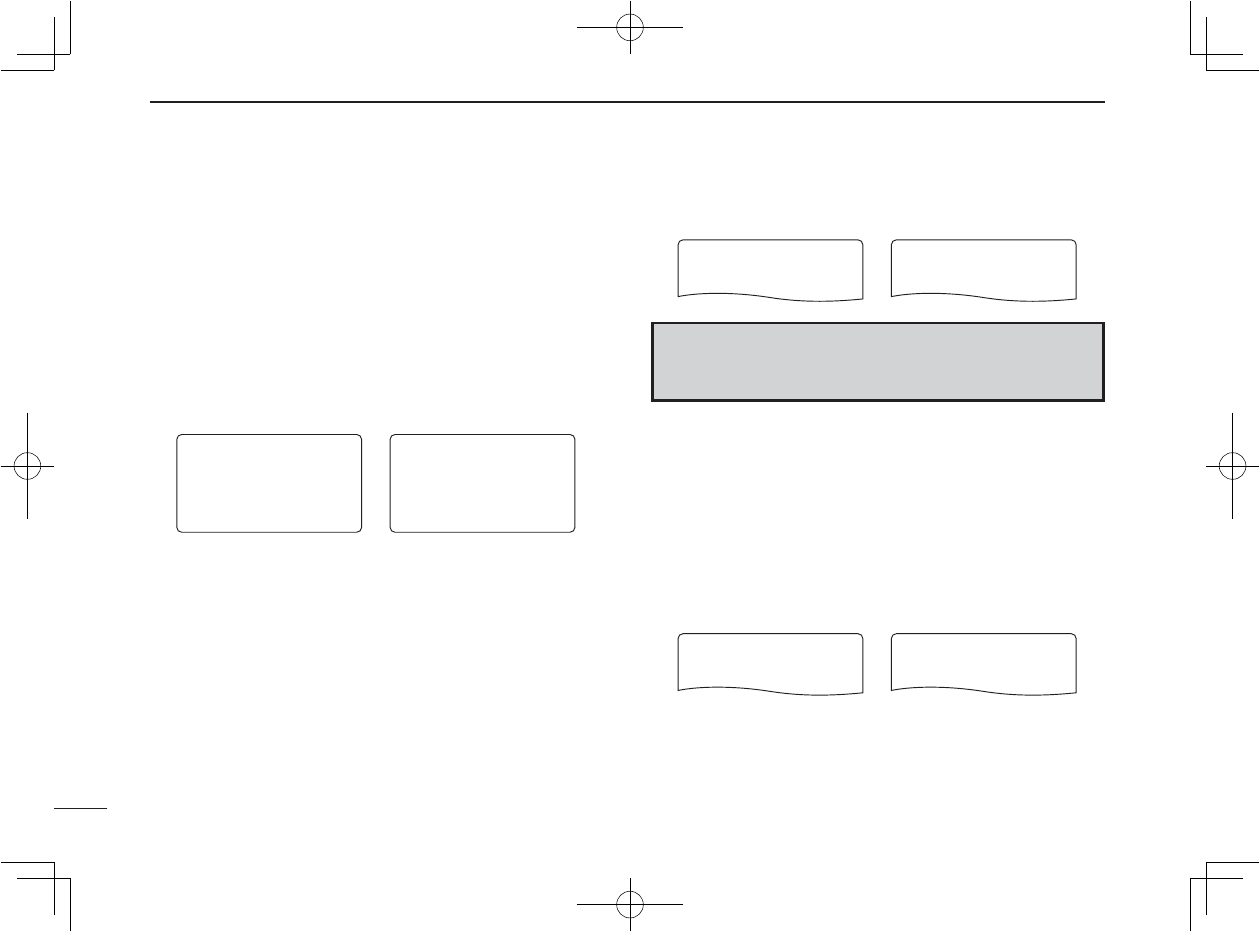
Ne
96
11 MENU SCREEN OPERATION
New2001
■ Set mode items
D Auto power OFF
The transceiver can be set to automatically turn OFF after
a specifi ed time period with a beep when no key operations
are performed.
30 min., 60 min, 90 min, 120 min and OFF (default) can be
specified. The specified time period is retained even when
the transceiver is turned OFF by the auto power OFF func-
tion. To cancel the function, select “OFF” in this item.
D Power save
The power save function reduces the current drain to con-
serve battery power. This power save function can be turned
OFF, if desired, by turning power ON and OFF.
In the default setting (“AUTO” selection), the power save func-
tion is activated in a 1:1 (150 msec.: 150 msec.) ratio when
no signal is received for 5 sec. The ratio becomes 1:4
(150 msec.: 600 msec.) when no signal is received for another
60 sec. Then the ratio becomes 1:8 (150 msec.: 1200 msec.)
when no signal is received for another more 60 sec.
D Attenuator
The attenuator prevents distortion of a desired signal by very
strong RF signals near the desired frequency or when very
strong electric fields, such as from a broadcasting station,
are present at your location.
Select the attenuator function ON and OFF (default).
OFF
30MIN
60MIN
90MIN
120MIN
AUTO POWER OFF
AUTO POWER OFF
r
30MIN
30MIN
OFF
OFF
60MIN
60MIN
90MIN
90MIN
120MIN
120MIN
AUTO POWER OFF
AUTO POWER OFF
r
AUTO
OFF
POWER SAVE
POWER SAVE
r
OFF
OFF
AUTO
AUTO
POWER SAVE
POWER SAVE
r
OFF
ON
ATTENUATOR
ATTENUATOR
r
ON
OFF
OFF
ATTENUATOR
ATTENUATOR
r
NOTE: Power save function is unable to function when
using the external power supply (More than 10 V DC) or
setting Auto reply function to ON or VOICE (☞p. 100).
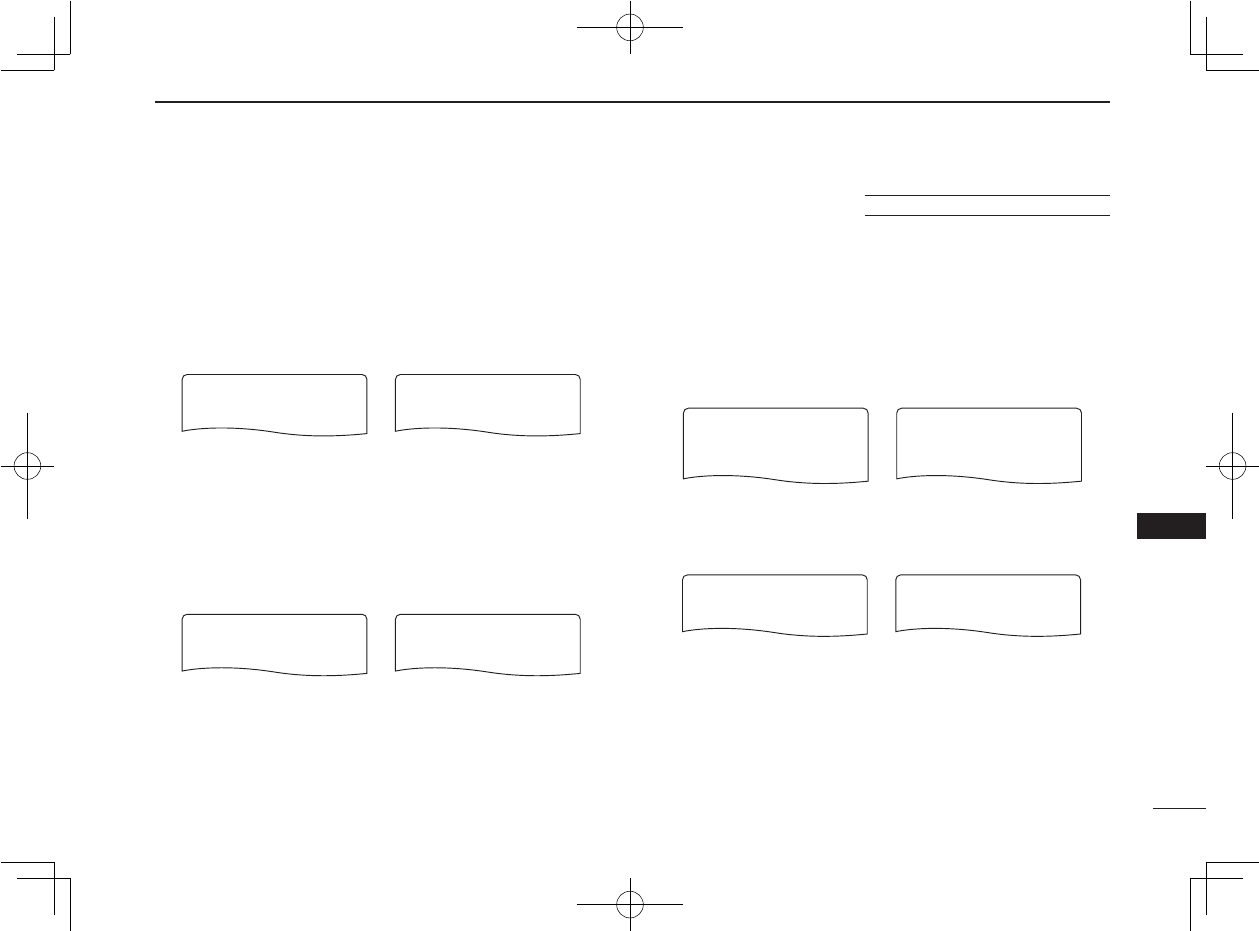
97
11
MENU SCREEN OPERATION
New2001
1
2
3
4
5
6
7
8
9
10
11
12
13
14
15
16
17
18
19
D Monitor key action
The monitor key, [SQL] , can be set as a ‘sticky’ key. When
set to the sticky condition, each push of [SQL] toggles the
monitor function ON and OFF.
• PUSH : Pushing and holding [SQL] to monitor the fre-
quency. (default)
• HOLD : Push [SQL] momentarily to monitor the frequency
and push momentarily again to cancel it.
D Dial speed acceleration
The dial speed acceleration automatically speeds up the
tuning dial speed when rotating [DIAL] rapidly.
• OFF : The dial speed acceleration is turned OFF.
• ON : The dial speed acceleration is tuned ON.
(default)
D Auto repeater U.S.A./KOREAN versions only
The auto repeater function automatically turns ON or OFF
the duplex operation and tone encoder. The offset and re-
peater tone is not changed by the auto repeater function.
Reset these frequencies, if necessary.
U.S.A. version:
• OFF : The auto repeater function is turned OFF.
• RPT1 : Activates for duplex only. (default)
• RPT2 : Activates for duplex and tone.
Korean version:
• OFF : Deactivates the function.
• ON : Activates duplex and tone. (default)
PUSH
HOLD
HOLD
MONITOR
MONITOR
r
HOLD
HOLD
PUSH
PUSH
MONITOR
MONITOR
r
ON
OFF
DIAL SPEED-UP
DIAL SPEED-UP
r
OFF
OFF
ON
DIAL SPEED-UP
DIAL SPEED-UP
r
RPT1
OFF
RPT2
AUTO REPEATER
AUTO REPEATER
r
OFF
RPT1
RPT2
AUTO REPEATER
AUTO REPEATER
r
ON
OFF
AUTO REPEATER
AUTO REPEATER
r
OFF
OFF
ON
AUTO REPEATER
AUTO REPEATER
r

Ne
98
11 MENU SCREEN OPERATION
New2001
D Microphone simple mode
Microphone simple mode is used to change the function
assignments for keys on the optional HM-75A REMOTE CON-
TROL SPEAKER-MICROPHONE. (pgs. 122, 124)
• SIMPLE
• NORM-1 (default)
• NORM-2
D Weather alert function
Turns weather alert function ON and OFF. (p. 114)
(default: OFF)
D Auto power ON
Auto power ON function turns the transceiver power ON au-
tomatically after passing the set time period from power OFF.
Select the desired time period within 30 minutes to 24 hours
in 30 minutes steps and OFF. (default: OFF)
D Key lock Type
While the key lock function is ON, [PWR], [PTT], [SQL],
[VOL] and [MENU](Lock function only) can still be accessed.
Accessible keys can be set to 1 of 4 groups.
• NORMAL : [PWR], [PTT], [SQL], [VOL] and [MENU]
(Lock function only) accessible. (default)
• NO SQL : [PWR], [PTT], [SQL] and [MENU] (Lock func-
tion only) are accessible.
• NO VOL : [PWR], [PTT], [VOL] and [MENU] (Lock func-
tion only) are accessible.
• ALL : [PWR], [PTT] and [MENU] (Lock function only)
are accessible.
NORM-1
SIMPLE
NORM-2
MIC SIMPLE MODE
MIC SIMPLE MODE
r
SIMPLE
SIMPLE
NORM-1
NORM-1
NORM-2
NORM-2
MIC SIMPLE MODE
MIC SIMPLE MODE
r
OFF
ON
WEATHER ALERT
WEATHER ALERT
r
OFF
ON
WEATHER ALERT
WEATHER ALERT
r
OFF
AUTO POWER ONAUTO POWER ON
24:00
AUTO POWER ONAUTO POWER ON
NORMAL
NO SQL
NO VOL
ALL
LOCK
r
NORMAL
NORMAL
NO SQL
NO SQL
NO VOL
NO VOL
ALL
ALL
LOCK
LOCK
r
U.S.A. version only
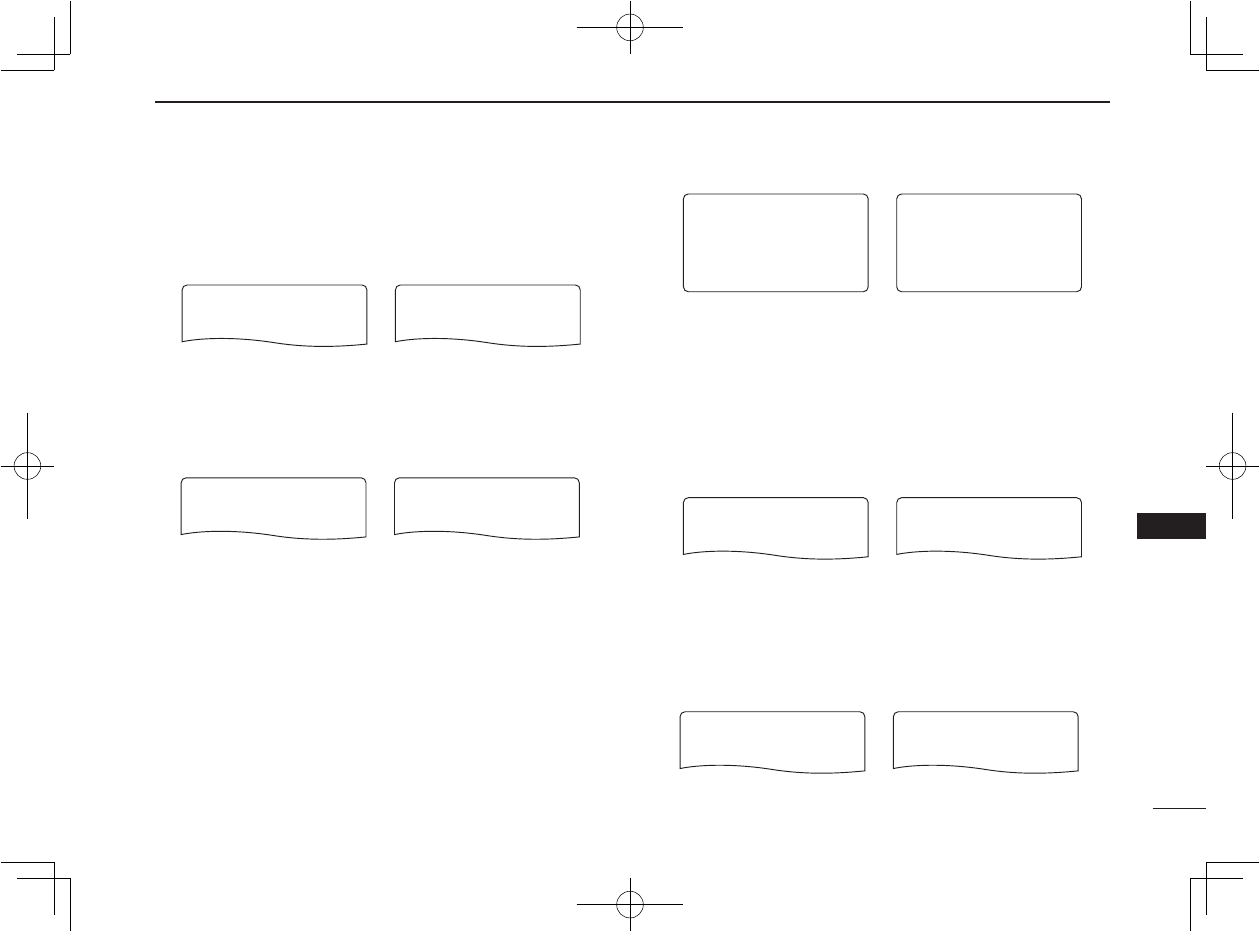
99
11
MENU SCREEN OPERATION
New2001
1
2
3
4
5
6
7
8
9
10
11
12
13
14
15
16
17
18
19
D PTT lock
Turns the PTT lock function ON and OFF.
Transmission with [PTT] is inhibited when ON is selected to
prevent accidental transmission, etc. (default: OFF)
D Busy lockout
Turns the busy lockout function ON and OFF.
This function inhibits transmission while receiving a signal or
when the squelch is open. (default: OFF)
D Time-out timer
To prevent accidental prolonged transmission, etc., the
transceiver has a time-out timer. This function cuts a trans-
mission OFF after 1, 3, 5 or 10 min. of continuous transmis-
sion. This timer can be cancelled.
• OFF : The time-out timer is turned OFF. (default)
• 1 to 10 MIN : The transmission is cut OFF after the set
period elapses.
D Active band
Allows continuous frequency selection of the operating fre-
quency across all bands.
• SINGLE : A single operating frequency can be
selected within the current band. Push
[BAND] for band selection in this case.
• ALL : The operating frequency can be selected
continuously. (default)
D Dial replace
Exchanging [DIAL] and [VOL] function.
• OFF : The dial replace function is turned OFF.
(default)
• ON : The dial replace function is turned ON.
OFF
ON
PTT LOCK
PTT LOCK
r
OFF
ON
PTT LOCK
PTT LOCK
r
OFF
ON
BUSY LOCKOUT
BUSY LOCKOUT
r
OFF
ON
BUSY LOCKOUT
BUSY LOCKOUT
r
OFF
1MIN
3MIN
5MIN
10MIN
TIME-OUT TIMER
TIME-OUT TIMER
r
OFF
1MIN
3MIN
5MIN
10MIN
TIME-OUT TIMER
TIME-OUT TIMER
r
ALL
SINGLE
ACTIVE BAND
ACTIVE BAND
r
ALL
SINGLE
SINGLE
ACTIVE BAND
ACTIVE BAND
r
ON
OFF
OFF
DIAL REPLACE
DIAL REPLACE
r
ON
OFF
DIAL REPLACE
DIAL REPLACE
r
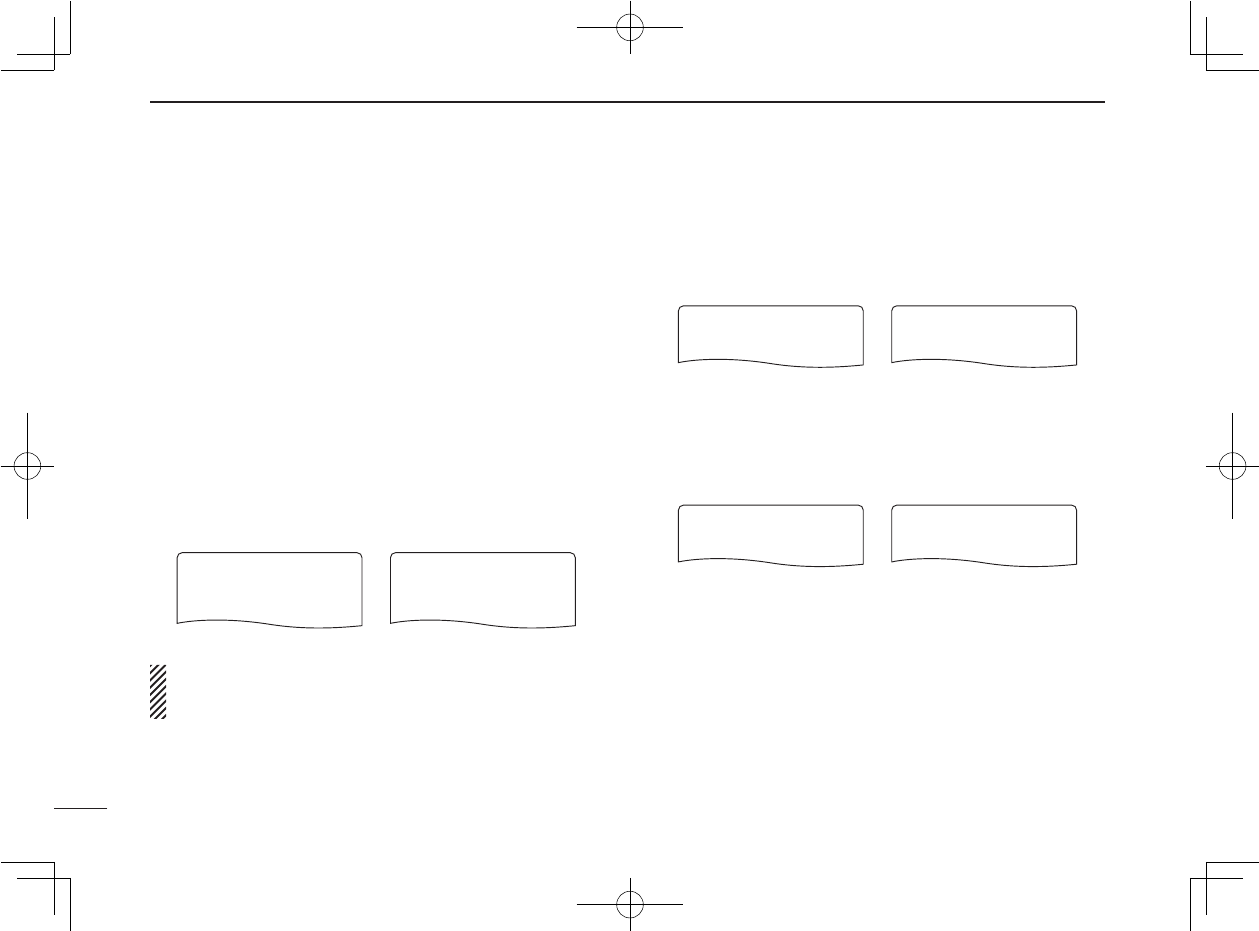
Ne
100
11 MENU SCREEN OPERATION
New2001
■ DV set mode items
The following items are selectable by the IC-92AD or op-
tional UT-121 is installed into the IC-92A.
D Auto reply
This function replies to an individual station call even you are
away from the transceiver.
After a manual transmission (pushing [PTT]), the Auto Reply
setting returns to OFF automatically.
• OFF : No reply is performed even a call is received.
(default)
• ON : Sets caller’s call sign and reply to the call with
the set own call sign automatically.
• VOICE : Sets caller’s call sign and reply to the call with
the recorded audio in REPLY VOICE memory
of DV VOICE MEMO.
NOTE: When “ON” or “VOICE” is set to the auto reply
function, the power save function (p. 88) is turned OFF au-
tomatically to receive call sign signal properly.
D Digital code
Sets the desired digital code for digital code squelch opera-
tion. Total of 100 codes (00–99) are available. (default: 00)
D DV data TX
During low-speed data operation, auto data transmission
function is available. This function transmits when data has
been input from PC via the [DATA] jack. (default: PTT)
OFF
ON
VOICE
AUTO REPLY
AUTO REPLY
r
OFF
ON
VOICE
AUTO REPLY
AUTO REPLY
r
00
DIGITAL CODE
DIGITAL CODE
99
DIGITAL CODE
DIGITAL CODE
PTT
AUTO
AUTO
DV DATA TX
DV DATA TX
PTT
AUTO
DV DATA TX
DV DATA TX
r
r
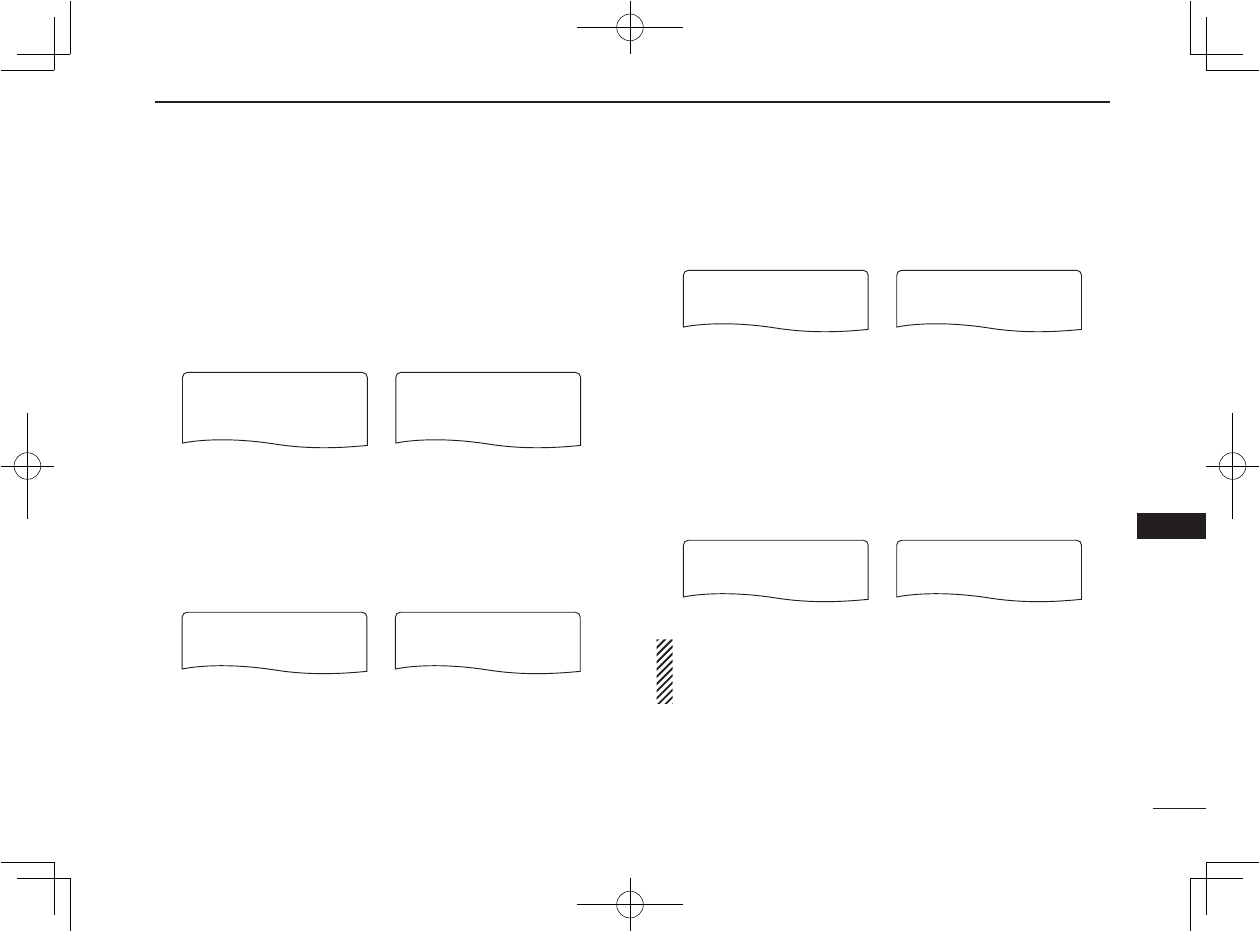
101
11
MENU SCREEN OPERATION
New2001
1
2
3
4
5
6
7
8
9
10
11
12
13
14
15
16
17
18
19
D Digital monitor
Sets the desired monitoring mode during digital mode op-
eration from “Auto,” “Digital” and “Analog.”
• AUTO : The transceiver sets monitoring mode to FM
and DV according to the received signal. (de-
fault)
• DIGITAL : Monitors in DV mode.
• ANALOG : Monitors in FM mode.
D Digital repeater setting
When accessing a digital repeater with a call sign different
than is programmed, the repeater call sign can be stored
into “RPT1” and/or “RPT2” automatically by reading the re-
peater’s transmission. The stored repeater’s call sign can be
re-called when selecting the repeater call sign. (default: ON)
D RX call sign auto write
When an individual station call is received, the calling station
call sign can be automatically set in “UR.” (default: OFF)
D Repeater call sign auto write
When accessing a repeater with a call sign different than is
programmed, the repeater call sign can be set into “RPT1”
and/or “RPT2” automatically by reading the repeater’s trans-
mission. (default: OFF)
The transceiver sets the received repeater call sign for
operation. Therefore, when a different call sign is set for
operation, the previously set repeater call sign will be lost.
AUTO
DIGITAL
ANALOG
DIGITAL MONITOR
DIGITAL MONITOR
r
AUTO
AUTO
DIGITAL
DIGITAL
ANALOG
ANALOG
DIGITAL MONITOR
DIGITAL MONITOR
r
ON
OFF
DIGITAL RPT SET
DIGITAL RPT SET
r
ON
OFF
DIGITAL RPT SET
DIGITAL RPT SET
r
OFF
AUTO
RXCALL WRITE
RXCALL WRITE
r
OFF
AUTO
AUTO
RXCALL WRITE
RXCALL WRITE
r
OFF
AUTO
RXRPT WRITE
RXRPT WRITE
r
OFF
AUTO
AUTO
RXRPT WRITE
RXRPT WRITE
r
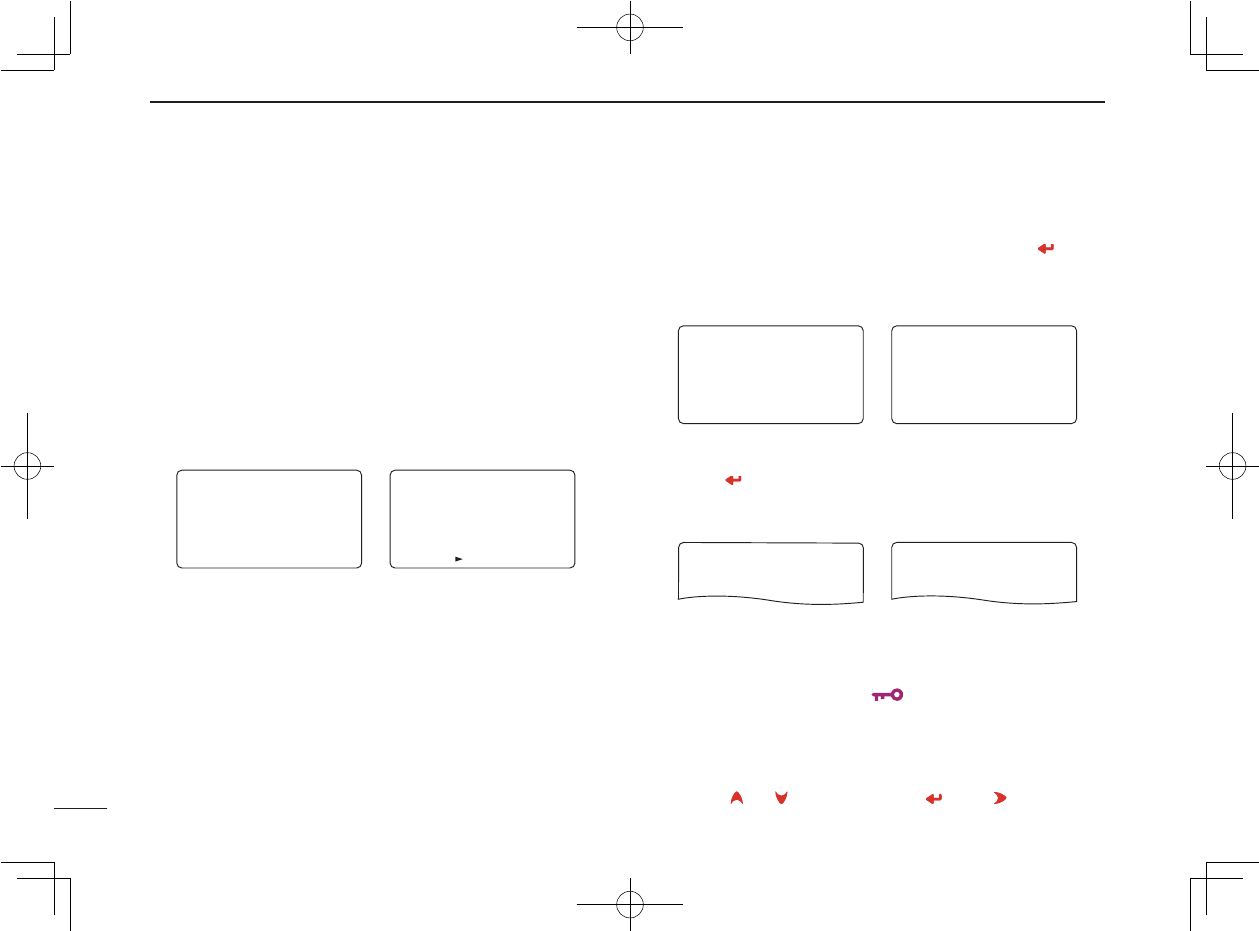
Ne
102
11 MENU SCREEN OPERATION
New2001
D GPS TX mode
Sets transmitting position data from connected a GPS re-
ceiver ON and OFF.
When the position information is received from a connected
GPS receiver and the GPS Auto TX Timer setting (p. 95) is
set to a specifi c time, the transceiver automatically transmits
with the current position and message at every setting inter-
val. (default: DISABLE)
• DISABLE : Transmitting position data is disable. (default)
• GPS : Transmitting position data at GPS mode.
• GPS-A : Transmitting position data at GPS-A mode.
• Sentence formatter setting
q Select “GPS” in GPS TX mode item, then push [ ](5)† to
enter the sentence formatter selection.
w Rotate [DIAL]† to select the desired sentence formatter.
•- RMC, GGA, GLL, GSA, VTG and GPS are selectable.
e Push [ ](5)† to enter the desired sentence formatter se-
lection.
r Rotate [DIAL]† to select the setting.
t Rotate [DIAL]† to select next sentence and repeat steps
w to r, or push [MENU/ ] to return to frequency in-
dication.
•-Only three sentence formatters can be activated at same time.
DISABLE
GPS
GPS-A
GPS TX MODE
GPS TX MODE
r
:SENTENCE
:SENTENCE
DISABLE
DISABLE
GPS
GPS-A
GPS TX MODE
GPS TX MODE
r
RMC:OFF
GGA:ON
GLL:OFF
GLL:OFF
GSA:OFF
VTG:OFF
GPS SENTENCE
GPS SENTENCE
r
RMC:OFF
RMC:OFF
GGA:ON
GGA:ON
GLL:OFF
GLL:OFF
GSA:OFF
GSA:OFF
VTG:OFF
VTG:OFF
GPS SENTENCE
GPS SENTENCE
r
OFF
ON
RMC SENTENCE
RMC SENTENCE
r
OFF
ON
RMC SENTENCE
RMC SENTENCE
r
†[DIAL] ↔ [ ](2)/[](8) [ ](5) ↔ [ ](6)
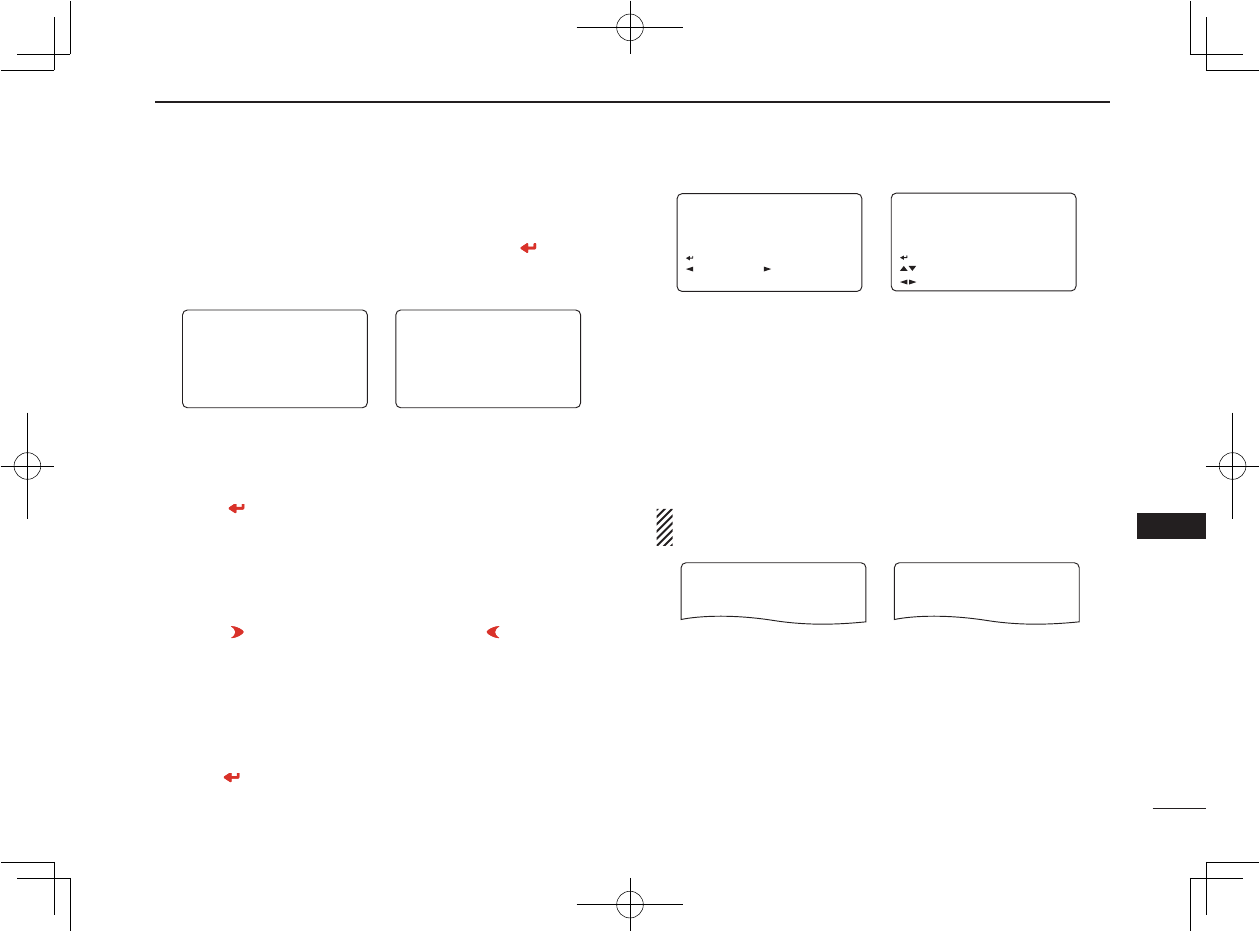
103
11
MENU SCREEN OPERATION
New2001
1
2
3
4
5
6
7
8
9
10
11
12
13
14
15
16
17
18
19
D GPS-A Set mode
Entering to GPS-A set mode for GPS-A operation when sse-
lect “GPS-A” in GPS TX mode item, then push [](5)†. This
set mode is available to set unproto address, data extension,
time stamp, GPS-A symbol and comment.
D Unproto Address
56 characters can be entered for unproto address.
q Push [](5)† to enter the unproto address edit mode.
w Rotate [DIAL]† to select the desired character.
• The selected character blinks.
• Push [A/a](3) to change the character group from “AB” (alphabeti-
cal characters; capital letters), “ab” (alphabetical characters; lower
case letters), “12” (numbers) and “ !” ” (symbols) in sequence.
• Push [](6) to move the cursor right; push [](4) to move the
cursor left.
• Push [CLR](1) to erase the selected character, or push and
hold [CLR](1) for 1 sec. to erase all characters following the
cursor.
e Repeat step w until the desired channel name is pro-
grammed.
r Push [](5)† to program the unproto address and exit the
unproto address edit mode.
D DATA Extension
Sets the data extension capability from “COURSE/SPEED”
and OFF (default).
The transceiver’s course and speed information is addition-
ally transmitted with position data when “COURSE/SPEED”
is selected.
NOTE: When “COURSE/SPEED” is selected, number of
character for “COMMENT” is limited to 36-character.
UNPROTO ADD
DATA EXTENS
TIME STAMP
GPS-A SYMBO
COMMENT
GPS-A SET MODE
GPS-A SET MODE
r
UNPROTO ADD
UNPROTO ADD
DATA EXTENS
DATA EXTENS
TIME STAMP
TIME STAMP
GPS-A SYMBO
GPS-A SYMBO
COMMENT
COMMENT
GPS-A SET MODE
GPS-A SET MODE
r
API92,DSTA
API92,DSTA
R*
R* R*
:SET
:SET
:EDIT
CLR:CLR
CLR:CLR
UNPROTO ADDRESS
UNPROTO ADDRESS
:BACK
:BACK
AB
†
PI92,DSTA
PI92,DSTA
:SET
:SEL
:CUR
CLR:CLR
CLR:CLR
A/a:CHAR
A/a:CHAR
UNPROTO ADDRESS
UNPROTO ADDRESS
OFF
COURSE/SPEE
DATA EXTENSION
DATA EXTENSION
r
OFF
COURSE/SPEE
COURSE/SPEE
DATA EXTENSION
DATA EXTENSION
r
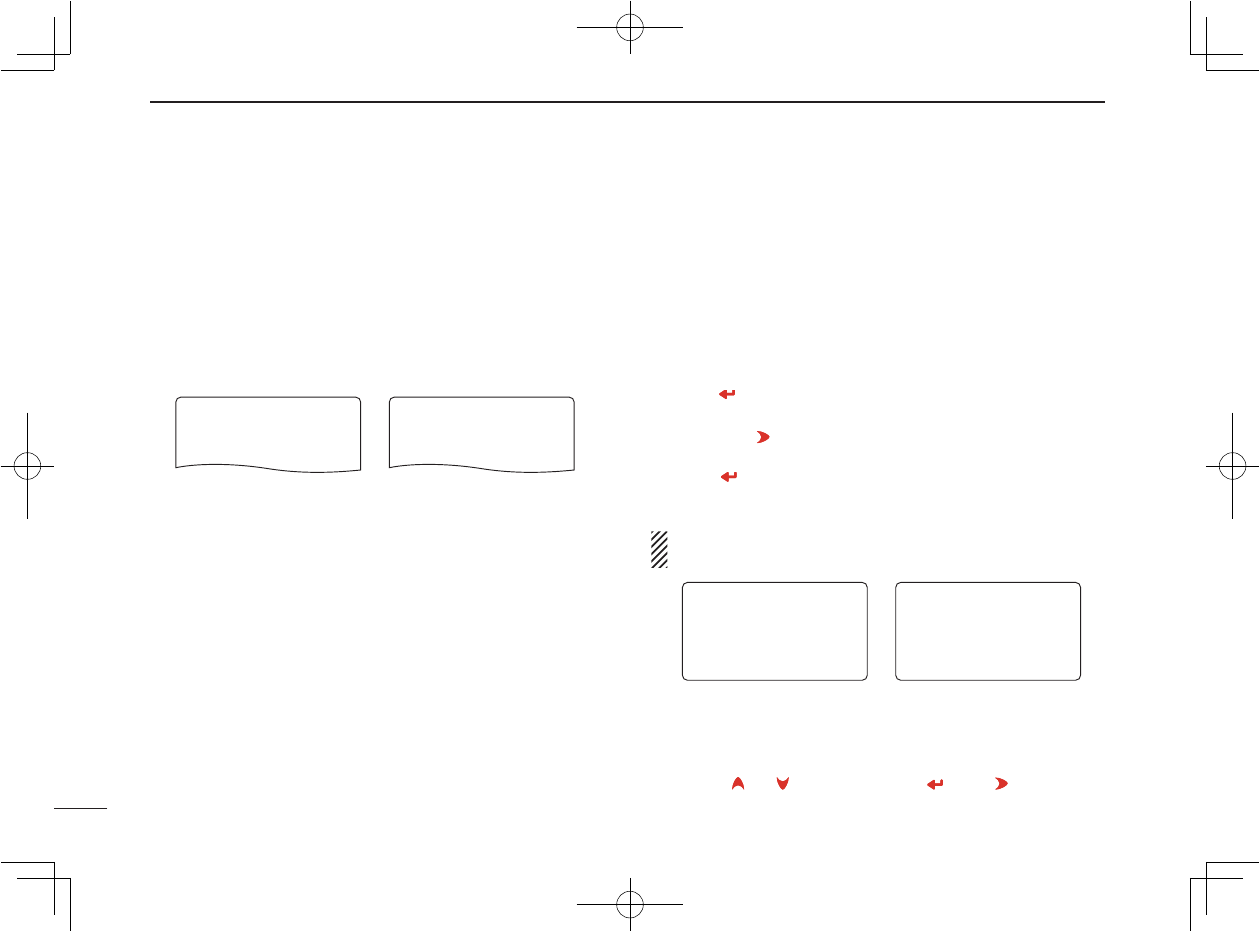
104
11 MENU SCREEN OPERATION
New2001
D Time stamp
Selects transmitting time stamp type from DHM, HMS and
OFF. This function can be transmitted UTC (Universal Time
Coordinated)time only.
• OFF : No time stamp is transmitted. (default)
• DHM : Time stamp in the format of Day, Hour and
Minute is transmitted.
• HMS : Time stamp in the format of Hour, Minute and
Second is transmitted.
D GPS-A symbol
Selects the desired GPS-A symbol.
Available symbols: Ambulance, Bus, Fire Truck, Bicycle,
Yacht, Helicopter, Small Aircraft, Ship (Power Boat), Car
(default), Motorcycle, Balloon, Jeep, Recreational Vehicle,
Truck, Van and Other.
If “Other” is selected, set the desired symbol code as follows;
q Push [](5)† to enter programming condition.
w Rotate [DIAL] to select the 1st character from “\” and “/.”
e Push Push [ ](6) to select the 2nd digit.
r Rotate [DIAL] to select the 2nd digit character.
t Push [](5)† to program the symbol code, then exit pro-
gramming condition.
When “Other” is selected, check the symbol codes of
APRS
®
and set it correctly.
Ne
†[DIAL] ↔ [ ](2)/[](8) [ ](5) ↔ [ ](6)
OFF
DHM
DHM
HMS
HMS
TIME STAMP
TIME STAMP
r
OFF
DHM
DHM
HMS
HMS
TIME STAMP
TIME STAMP
r
Helicpter
Small Aircr
Ship(power
Car
Motorcycle
GPS-A SYMBOL
GPS-A SYMBOL
r
Helicpter
Helicpter
Small Aircr
Small Aircr
Ship(power
Ship(power
Car
Car
Motorcycle
Motorcycle
GPS-A SYMBOL
GPS-A SYMBOL
r
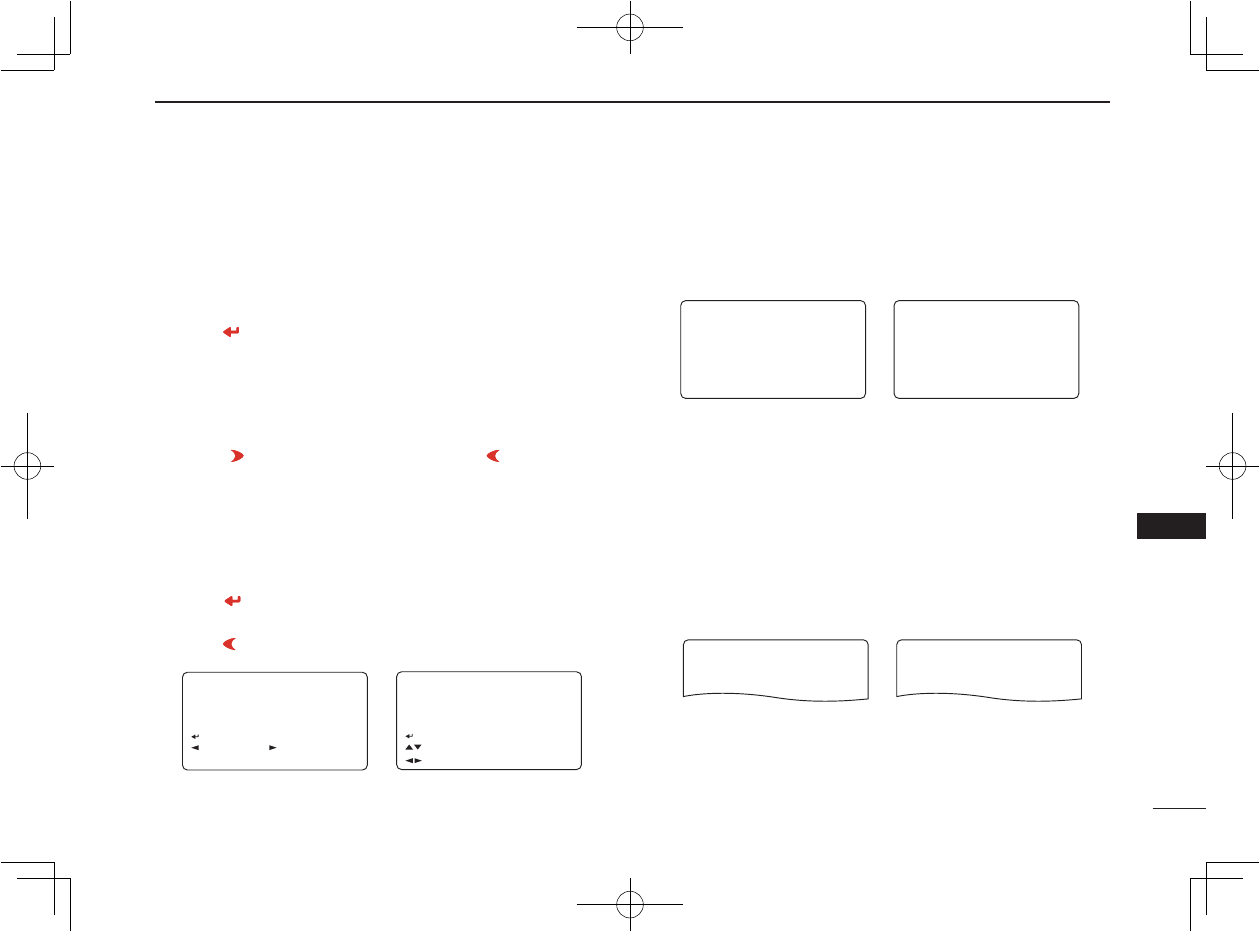
105
11
MENU SCREEN OPERATION
New2001
1
2
3
4
5
6
7
8
9
10
11
12
13
14
15
16
17
18
19
D Comment
Program up to a 43-character* comment. The programmed
comment is transmitted with the GPS position data.
*36-character comment can only be programmed when
“COURSE/SPEED” is selected in data extension.
q Push [](5)† twice to enter programming condition.
w Rotate [DIAL] to select the desired character.
• The selected character blinks.
• Push [A/a](3) to change the character group from “AB” (alphabeti-
cal characters; capital letters), “ab” (alphabetical characters; lower
case letters), “12” (numbers) and “ !” ” (symbols) in sequence.
• Push [](6) to move the cursor right; push [](4) to move the
cursor left.
• Push [CLR](1) to erase the selected character, or push and
hold [CLR](1) for 1 sec. to erase all characters following the
cursor.
e Repeat step w until the desired channel name is pro-
grammed.
r Push [](5)† to program the comment and exit comment
programming condition.
t Push [](4) to return to GPS-A SET screen mode.
D GPS auto TX timer
Selects the desired interval for automatic position transmis-
sion function from 5, 10, 30 second, 1, 3, 5, 10 and 30 min-
utes.
D DV auto detect
When a signal other than DV mode is received during DV
mode operation, the transceiver has capability of automatic
FM mode selection.
• OFF : Operating mode is fi xed in DV. (default)
• ON : The transceiver automatically selects FM
mode for temporary operation.
:SET
:EDIT
CLR:CLR
CLR:CLR
COMMENT
COMMENT
:BACK
:BACK
AB
AB
†
:SET
:SEL
:CUR
CLR:CLR
CLR:CLR
A/a:CHAR
A/a:CHAR
COMMENT
OFF
5SEC
10SEC
30SEC
1MIN
GPS AUTO TX
GPS AUTO TX
r
OFF
OFF
5SEC
5SEC
10SEC
10SEC
30SEC
30SEC
1MIN
1MIN
GPS AUTO TX
GPS AUTO TX
r
OFF
ON
DV AUTO DETECT
DV AUTO DETECT
r
OFF
ON
DV AUTO DETECT
DV AUTO DETECT
r
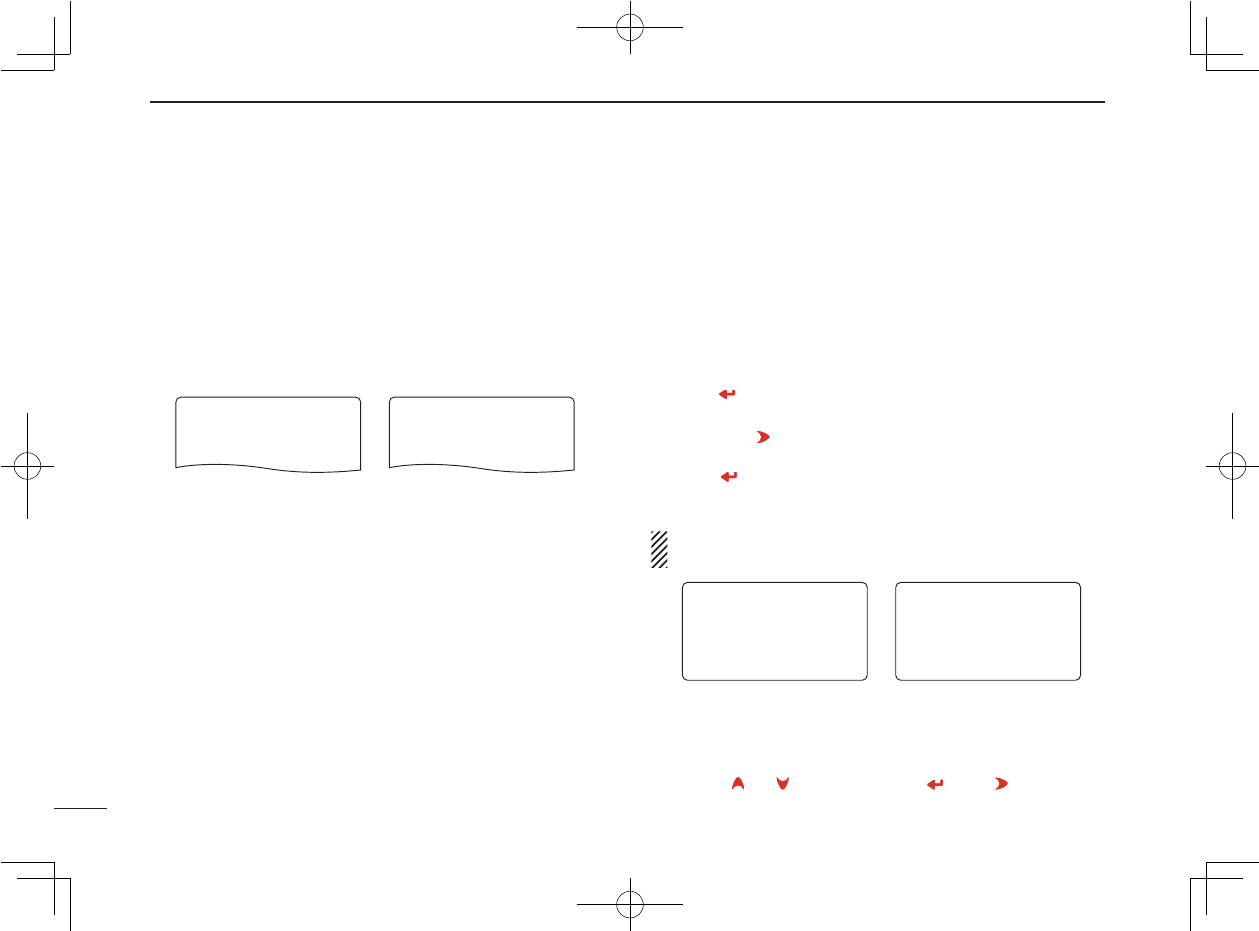
106
11 MENU SCREEN OPERATION
New2001
D Time stamp
Selects transmitting time stamp type from DHM, HMS and
OFF. This function can be transmitted UTC (Universal Time
Coordinated)time only.
• OFF : No time stamp is transmitted. (default)
• DHM : Time stamp in the format of Day, Hour and
Minute is transmitted.
• HMS : Time stamp in the format of Hour, Minute and
Second is transmitted.
D GPS-A symbol
Selects the desired GPS-A symbol.
Available symbols: Ambulance, Bus, Fire Truck, Bicycle,
Yacht, Helicopter, Small Aircraft, Ship (Power Boat), Car
(default), Motorcycle, Balloon, Jeep, Recreational Vehicle,
Truck, Van and Other.
If “Other” is selected, set the desired symbol code as follows;
q Push [](5)† to enter programming condition.
w Rotate [DIAL] to select the 1st character from “\” and “/.”
e Push Push [ ](6) to select the 2nd digit.
r Rotate [DIAL] to select the 2nd digit character.
t Push [](5)† to program the symbol code, then exit pro-
gramming condition.
When “Other” is selected, check the symbol codes of
APRS
®
and set it correctly.
†[DIAL] ↔ [ ](2)/[](8) [ ](5) ↔ [ ](6)
OFF
DHM
DHM
HMS
HMS
TIME STAMP
TIME STAMP
r
OFF
DHM
DHM
HMS
HMS
TIME STAMP
TIME STAMP
r
Helicpter
Small Aircr
Ship(power
Car
Motorcycle
GPS-A SYMBOL
GPS-A SYMBOL
r
Helicpter
Helicpter
Small Aircr
Small Aircr
Ship(power
Ship(power
Car
Car
Motorcycle
Motorcycle
GPS-A SYMBOL
GPS-A SYMBOL
r
Ne
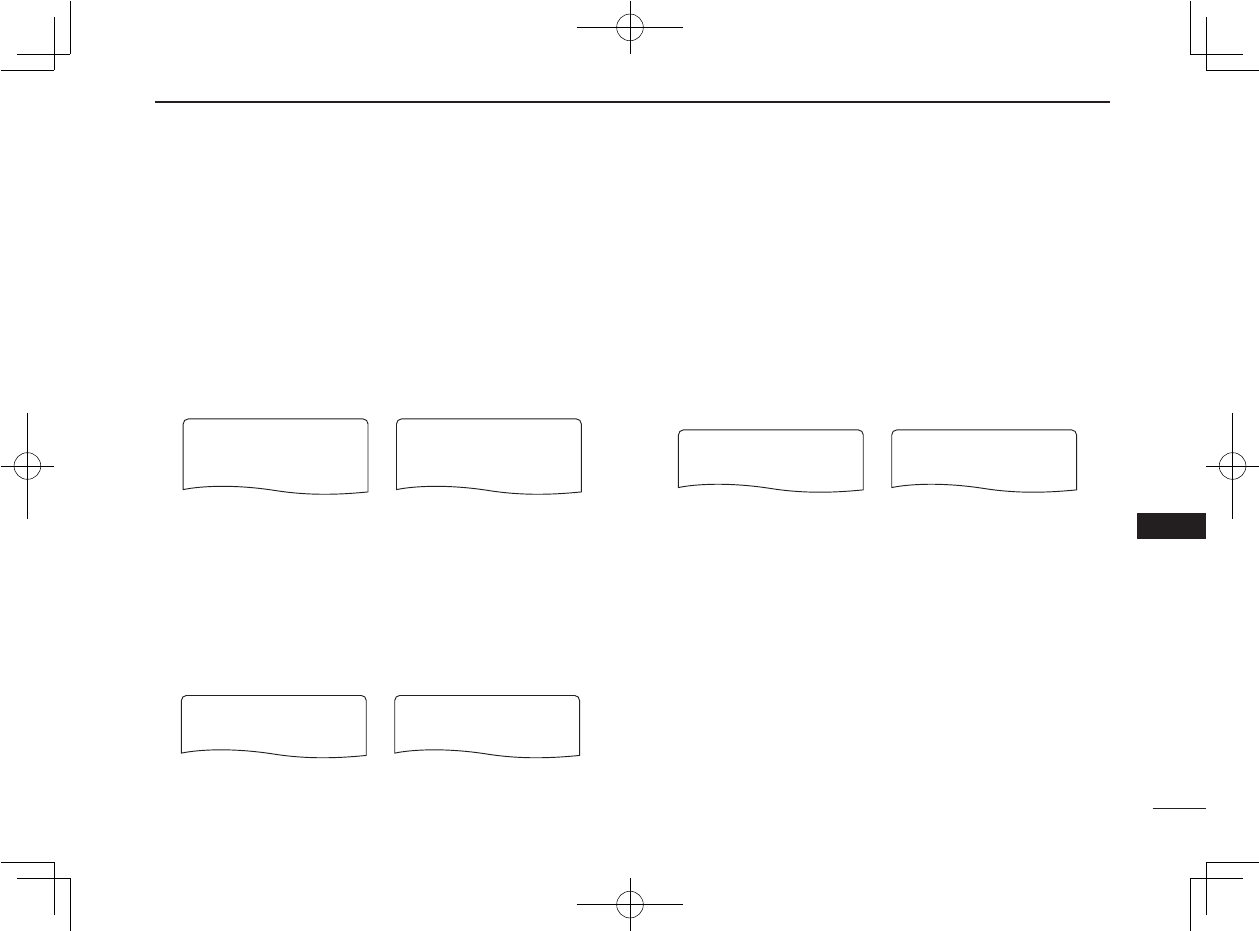
107
11
MENU SCREEN OPERATION
New2001
1
2
3
4
5
6
7
8
9
10
11
12
13
14
15
16
17
18
19
D Call sign edit record
Selects the call sign programming when the call sign is ed-
ited or corrected with the pre-programmed call sign.
• OFF : The edited or corrected call sign is over writ-
ten.
• SELECT : The edited or corrected call sign is pro-
grammed into the selected call sign memory.
• AUTO : The edited or corrected call sign is pro-
grammed into a blank channel automatically.
(default)
D Break-in function
The break-in function allows you to break into a conversa-
tion, where the two original stations are communicating with
call sign squelch enabled.
• OFF : The break-in function is set to OFF. (default)
• ON : The break-in function is set to ON.
• “BK” appears on the display.
D EMR function
The EMR communication mode is available for digital mode
operation. In the EMR communication mode, no call sign
setting is necessary. When an EMR communication mode
signal is received, the audio (voice) will be heard at the
specified level even the volume setting level is set to mini-
mum level, or digital call sign/digital code squelch is in use.
• OFF : The EMR function is set to OFF. (default)
• ON : The EMR function is set to ON.
• “EMR” appears on the display.
AUTO
SELECT
OFF
EDIT RECORD
EDIT RECORD
r
AUTO
SELECT
OFF
EDIT RECORD
EDIT RECORD
r
ON
ON
OFF
OFF
BK
BK
r
ON
OFF
BK
BK
r
ON
OFF
EMR
EMR
r
ON
OFF
EMR
EMR
r
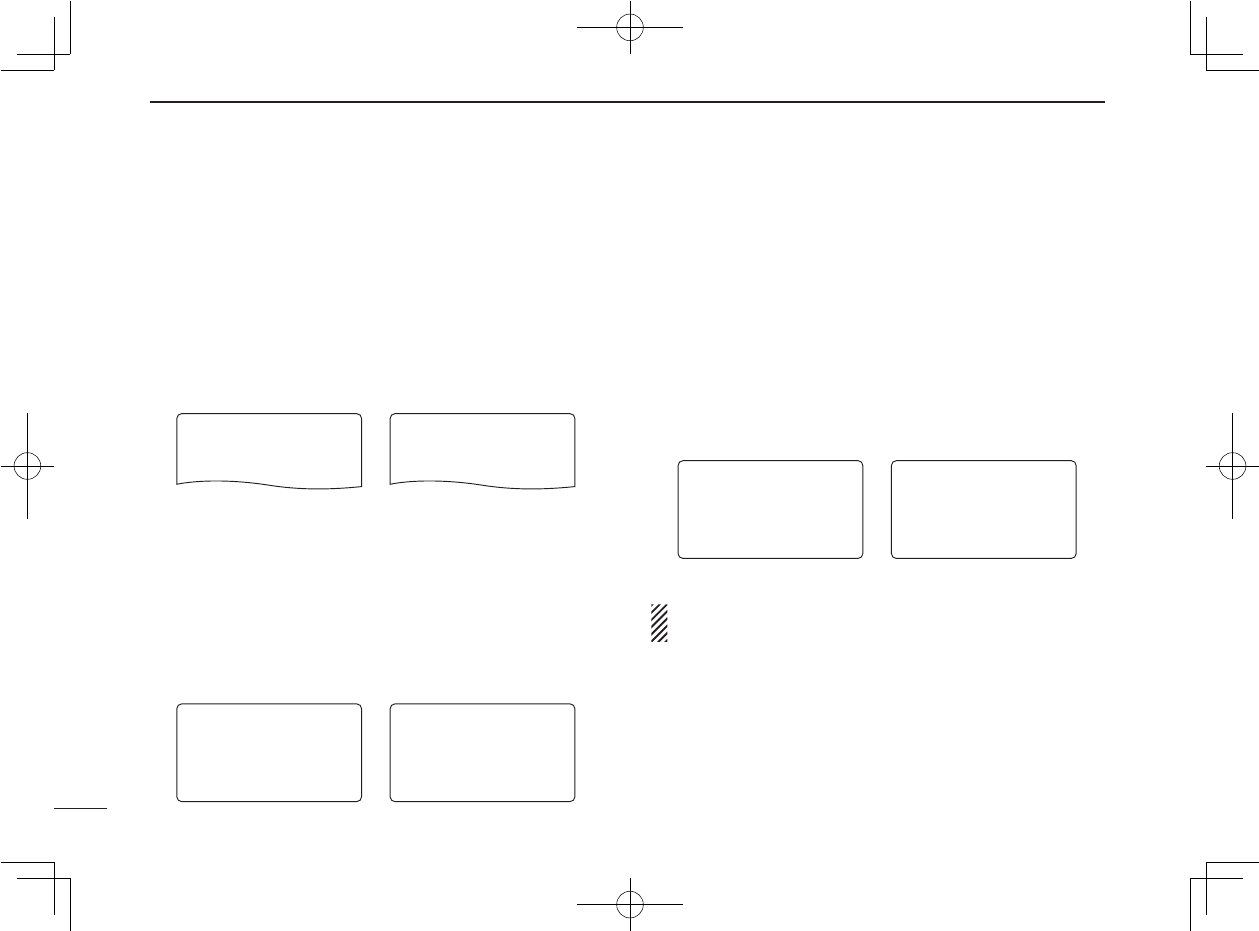
Ne
108
11 MENU SCREEN OPERATION
New2001
■ Scan set mode items
D Priority watch
Activates priority watch or priority watch with alert (Bell).
• OFF : The priority watch is turned OFF. (default)
• ON : The transceiver checks the memory channel fre-
quency every 5 sec.
• B ELL : The transceiver checks the memory channel
frequency every 5 sec. You can be alerted with
beeps and blinking “S.”
D Scan pause timer
Selects the scan pause time. When receiving signals, the
scan pauses according to the scan pause time.
• 2–20 SEC : Scan pauses for 2–20 sec. on a received
signal in 2 sec. steps. (default: 10 sec.)
• HOLD : Scan pauses on a received signal until it
disappears. Rotate [DIAL] to resume man-
ually.
D Scan resume timer
Selects the scan resume time from a paused frequency after
the received signal disappears.
• 0 : Scan resumes when a received signal disap-
pears.
• 1–5 SEC : Scan pauses 1–5 sec. after a received signal
disappears. (default: 2 sec.)
• HOLD : Scan pauses on the received signal even if it
disappears. Rotate [DIAL]† to resume manu-
ally.
Scan resume timer must be set shorter than scan pause
timer (previous item), otherwise this timer does not activate.
OFF
ON
BELL
PRIO WATCH
PRIO WATCH
r
OFF
ON
BELL
PRIO WATCH
PRIO WATCH
r
10SEC
6SEC
8SEC
4SEC
12SEC
PAUSE TIMER
PAUSE TIMER
r
20SEC
20SEC
16SEC
16SEC
18SEC
18SEC
14SEC
14SEC
HOLD
HOLD
PAUSE TIMER
PAUSE TIMER
r
2SEC
4SEC
3SEC
1SEC
5SEC
RESUME TIMER
RESUME TIMER
r
3SEC
3SEC
5SEC
5SEC
4SEC
4SEC
2SEC
2SEC
HOLD
HOLD
RESUME TIMER
RESUME TIMER
r
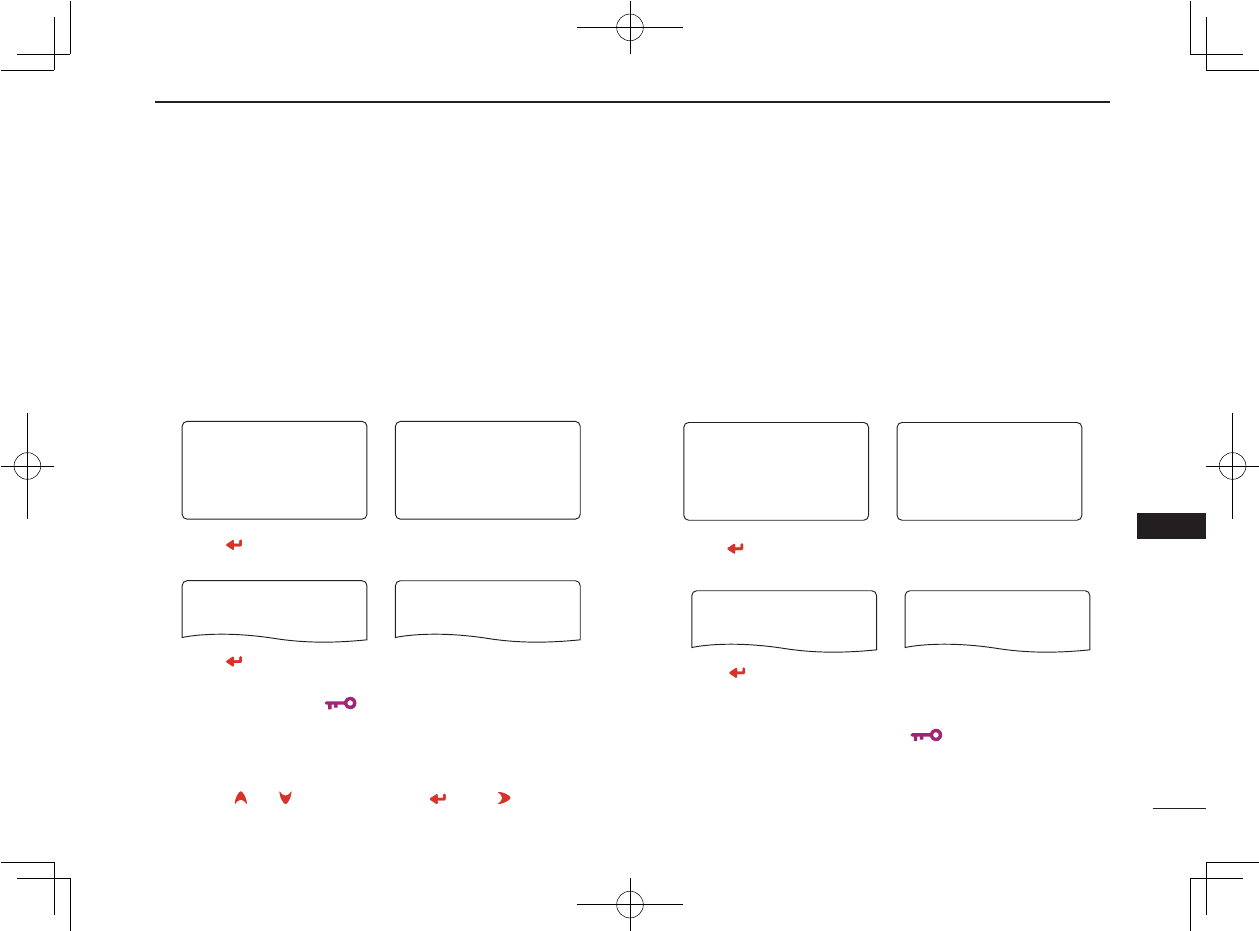
109
11
MENU SCREEN OPERATION
New2001
1
2
3
4
5
6
7
8
9
10
11
12
13
14
15
16
17
18
19
D Memory bank link function
Sets the memory bank link function ON (default) and OFF.
The link function provides continuous bank scan, scanning
all contents in the selected banks during bank scan.
• Bank link setting
q Rotate [DIAL]† to select the bank that you want to
change.
w Push [](5)† to enter bank setting.
e Rotate [DIAL]† to select the setting.
r Push [](5)† to set and return to the BANK LINK screen.
t Rotate [DIAL]† to select next bank and repeat steps w to
r, or push [MENU/ ] to exit scan set mode.
D Program scan link function
Sets the program scan link function ON (default) and OFF.
The link function provides continuous program scan in the
selected number during program scan.
• Program scan link setting
q Rotate [DIAL]† to select the program scan number that
you want to change.
w Push [](5)† to enter program scan setting.
e Rotate [DIAL]† to select the setting.
r Push [](5)† to set and return to the PROGRAM SCAN
LINK screen.
t Rotate [DIAL]† to select next program scan and repeat
steps w to r, or push [MENU/ ] to exit MENU screen
operation.
BANK-A:ON
BANK-D:ON
BANK-C:ON
BANK-B:ON
BANK-E:ON
BANK LINK
BANK LINK
r
BANK-V:ON
BANK-V:ON
BANK-Y:ON
BANK-Y:ON
BANK-X:ON
BANK-X:ON
BANK-W:ON
BANK-W:ON
BANK-Z:ON
BANK-Z:ON
BANK LINK
BANK LINK
\
r
ON
OFF
BANK-A
BANK-A
r
ON
OFF
BANK-A
BANK-A
r
†[DIAL] ↔ [ ](2)/[](8) [ ](5) ↔ [ ](6)
P-00:OFF
P-03:ON
P-02:ON
P-01:ON
P-04:ON
PSCAN LINK
PSCAN LINK
r
P-01:ON
P-01:ON
P-04:ON
P-04:ON
P-03:ON
P-03:ON
P-02:ON
P-02:ON
P-05:ON
P-05:ON
PSCAN LINK
PSCAN LINK
\
r
ON
OFF
PSCAN-00
PSCAN-00
r
ON
OFF
PSCAN-00
PSCAN-00
r
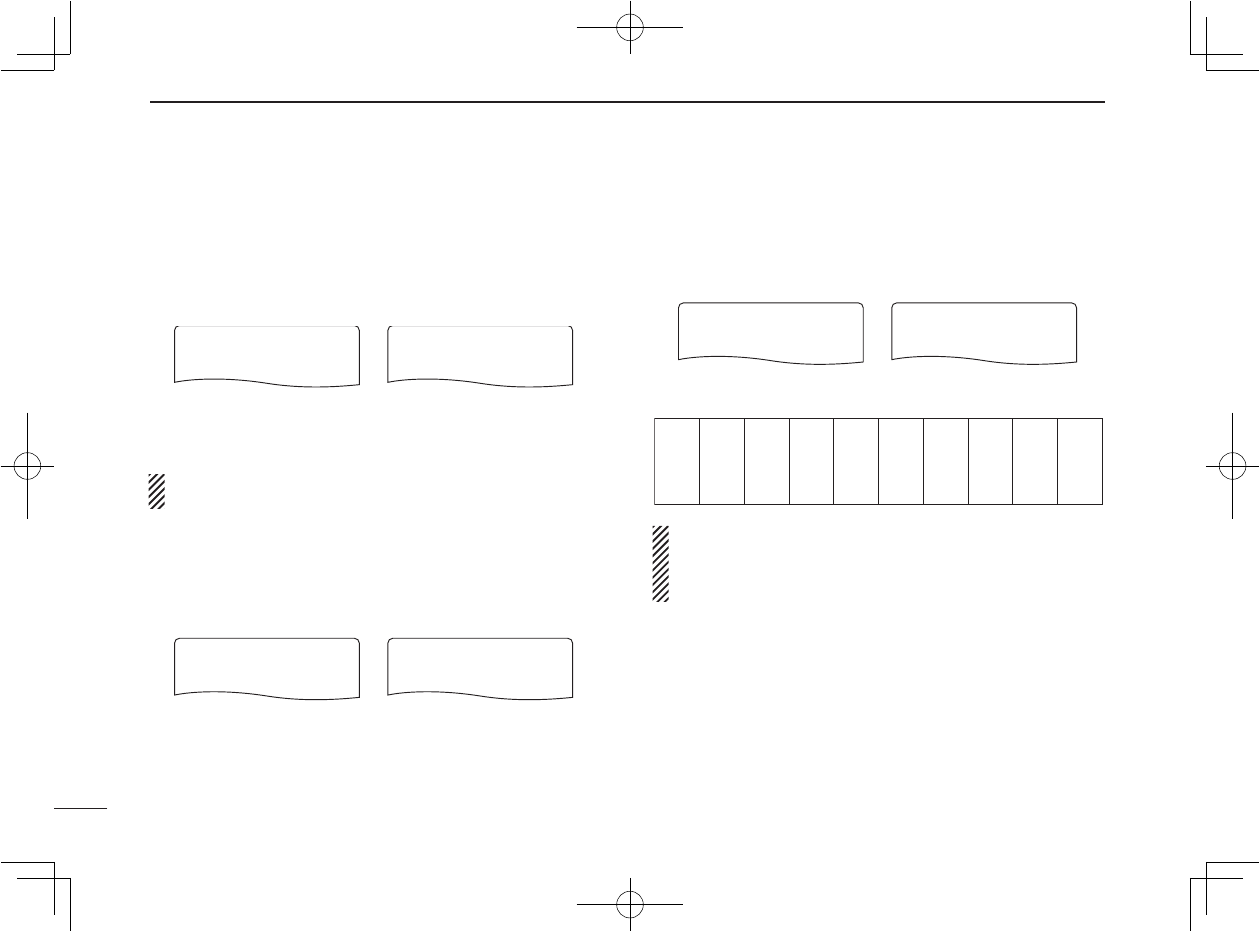
■ DUP/TONE set mode items
D Offset frequency
Sets the offset frequency for duplex (repeater) operation
within 0 to 159.995 MHz range.
The default value may differ according to the selected fre-
quency band (before accessing DUP/TONE set mode) and trans-
ceiver version.
The selected tuning step in VFO mode is used for setting
the offset frequency.
D Repeater tone frequency
Selects subaudible tone frequency for accessing a repeater,
etc. Total of 50 tone frequencies (67.0–254.1 Hz) are available.
(default: 88.5)
D TSQL frequency
Selects tone frequency for tone squelch or pocket beep op-
eration from one of 50 available frequencies (67.0–254.1 Hz).
(default: 88.5)
• Available subaudible tone frequencies
The transceiver has 50 tone frequencies and conse-
quently their spacing is narrow compared with units
having 38 tones. Therefore, some tone frequencies may
receive interference from adjacent tone frequencies.
MENU SCREEN OPERATION
110
11
New2001
0.000.00
OFFSET FREQOFFSET FREQ
159.995.00159.995.00
OFFSET FREQOFFSET FREQ
88.5
REPEATER TONE
REPEATER TONE
254.1
254.1
REPEATER TONE
REPEATER TONE
88.5
CTCSS TONE
CTCSS TONE
254.1
254.1
CTCSS TONE
CTCSS TONE
67.0
69.3
71.9
74.4
77.0
79.7
82.5
85.4
88.5
91.5
94.8
97.4
100.0
103.5
107.2
110.9
114.8
118.8
123.0
127.3
131.8
136.5
141.3
146.2
151.4
156.7
159.8
162.2
165.5
167.9
171.3
173.8
177.3
179.9
183.5
186.2
189.9
192.8
196.6
199.5
203.5
206.5
210.7
218.1
225.7
229.1
233.6
241.8
250.3
254.1
Ne
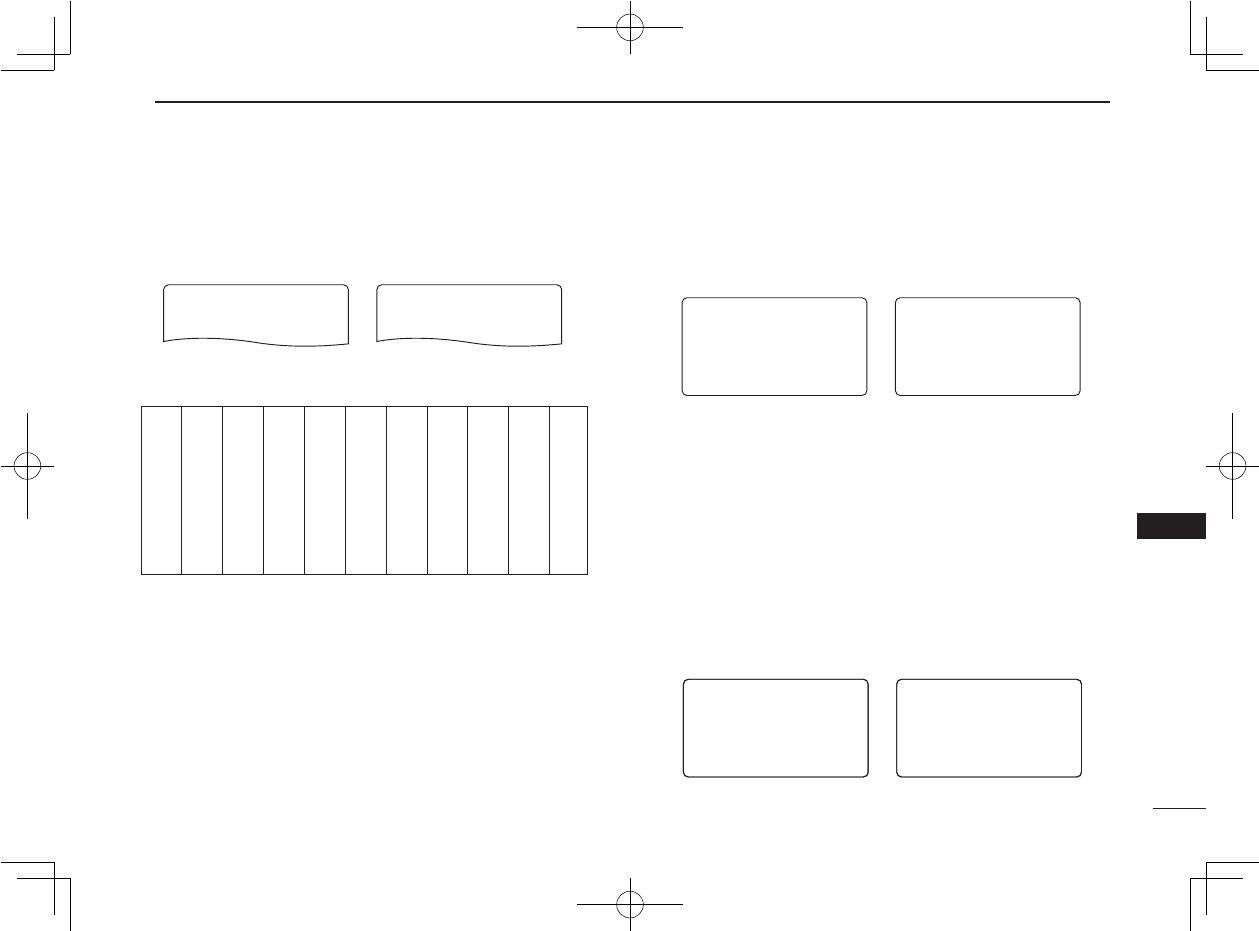
D DTCS code
Selects DTCS (both encoder/decoder) code for DTCS squelch
operation. Total of 104 codes (023–754) are available.
(default: 023)
• Available DTCS codes
D DTCS polarity
Sets DTCS polarity from “BOTH N” (TX/RX: normal), “TN-RR”
(TX: normal, RX: reverse), “TR-RN” (TX: reverse, RX: normal) and
“BOTH R” (TX/RX: reverse). (default: BOTH N)
D DTMF speed
Select the desired DTMF transmission speed from 100
msec, 200 msec, 300 msec, 500 msec.
• 100 : 100-msec. interval; 5.0 characters per second
(default)
• 200 : 200-msec. interval; 2.5 characters per second
• 300 : 300-msec. interval; 1.6 characters per second
• 500 : 500-msec. interval; 1.0 character per second
New2001
MENU SCREEN OPERATION
111
11
1
2
3
4
5
6
7
8
9
10
11
12
13
14
15
16
17
18
19
023
DTCS CODE
DTCS CODE
754
754
DTCS CODE
DTCS CODE
023
025
026
031
032
036
043
047
051
053
125
131
132
134
143
145
152
155
156
162
245
246
251
252
255
261
263
265
266
271
356
364
365
371
411
412
413
423
431
432
506
516
523
526
532
546
565
606
612
624
054
065
071
072
073
074
114
115
116
122
165
172
174
205
212
223
225
226
243
244
274
306
311
315
325
331
332
343
346
351
445
446
452
454
455
462
464
465
466
503
627
631
632
654
662
664
703
712
723
731
732
734
743
754
TX/RX: Normal polarity TX/RX: Reverse polarity
BOTH N
TN-RR
TR-RN
BOTH R
DTCS POLARITY
DTCS POLARITY
r
BOTH R
BOTH R
TN-RR
TN-RR
TR-RN
TR-RN
BOTH N
BOTH N
DTCS POLARITY
DTCS POLARITY
r
100
200
300
500
DTMF SPEED
DTMF SPEED
r
100
100
200
200
300
300
500
500
DTMF SPEED
DTMF SPEED
r
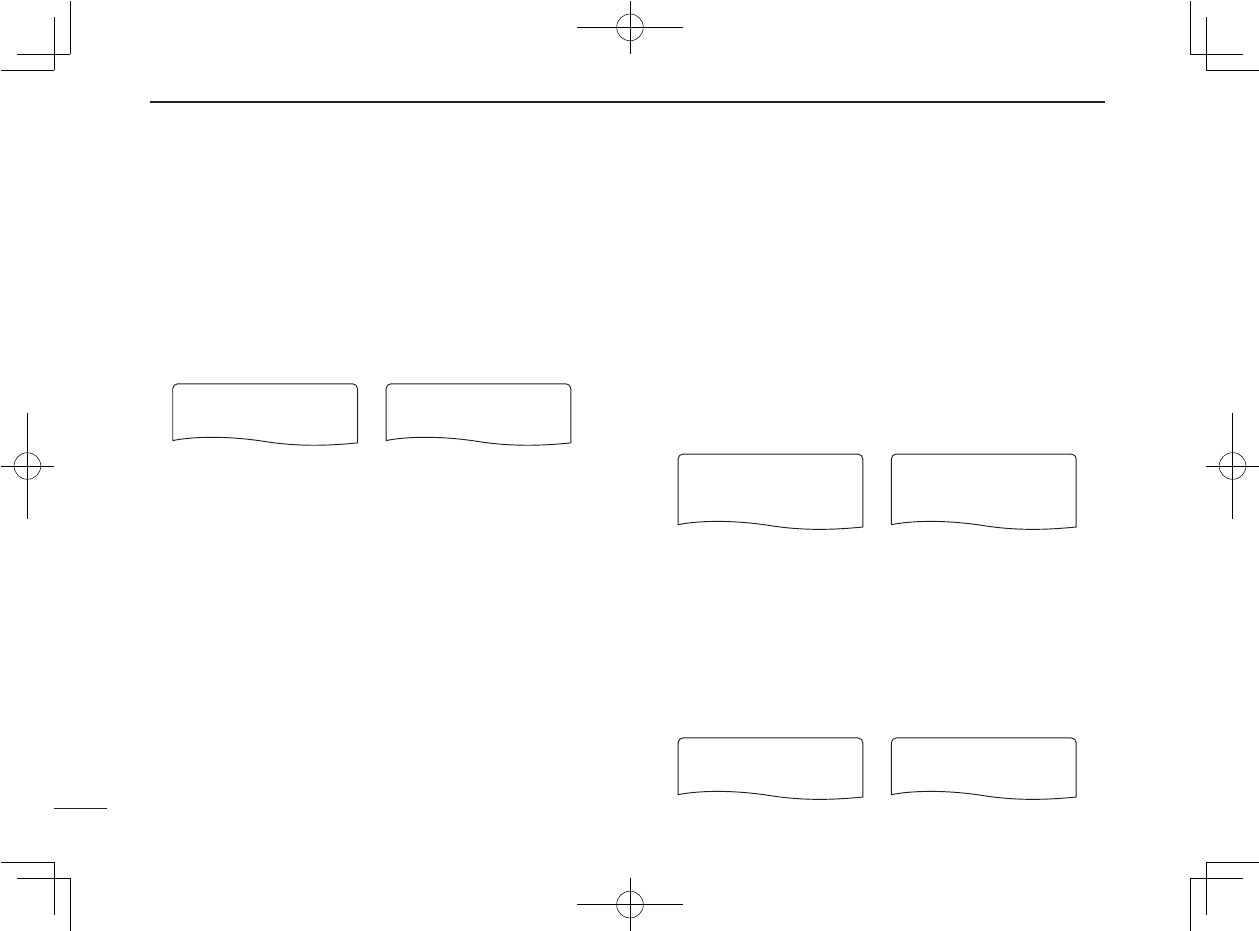
Ne
112
11 MENU SCREEN OPERATION
New2001
D DTMF TX KEY
Selects DTMF transmitting code when pushing and holding
[PTT], then pusing 10-key.
• KEY : [1]–[9], [0], [A], [B], [C], [D], [E] or [F] DTMF
code is transmitted respectively. (default)
• DTMF-M : The assigned DTMF memory to [1]–[9] and
[0] is transmitted respectively.
■ Display set mode items
D Display backlighting
The transceiver has display backlighting with a 5 sec. timer
for night time operation. The display backlighting can be
turned ON continuously or turned OFF, if desired.
• OFF : The backlight is turned OFF.
• ON : The backlight continuously lights ON.
• AUTO : Lights when an operation is performed, goes out
after 5 sec. (default)
* C ontinuously lights ON while operating with an
external DC power source.
D Busy LED
The TX/RX indicator lights green while receiving a signal or
when the squelch is open. This indication can be turned OFF
to conserve the battery power, if desired.
• OFF : The indicator does not function even if a signal is
received.
• ON : The indicator lights green while receiving a signal
or when the squelch is open. (default)
AUTO
ON
OFF
BACKLIGHT
BACKLIGHT
r
AUTO
ON
OFF
BACKLIGHT
BACKLIGHT
r
ON
OFF
BUSY LED
BUSY LED
r
ON
OFF
BUSY LED
BUSY LED
r
DTMF-M
KEY
DTMF TX KEY
DTMF TX KEY
r
DTMF-M
DTMF-M
KEY
DTMF TX KEY
DTMF TX KEY
r
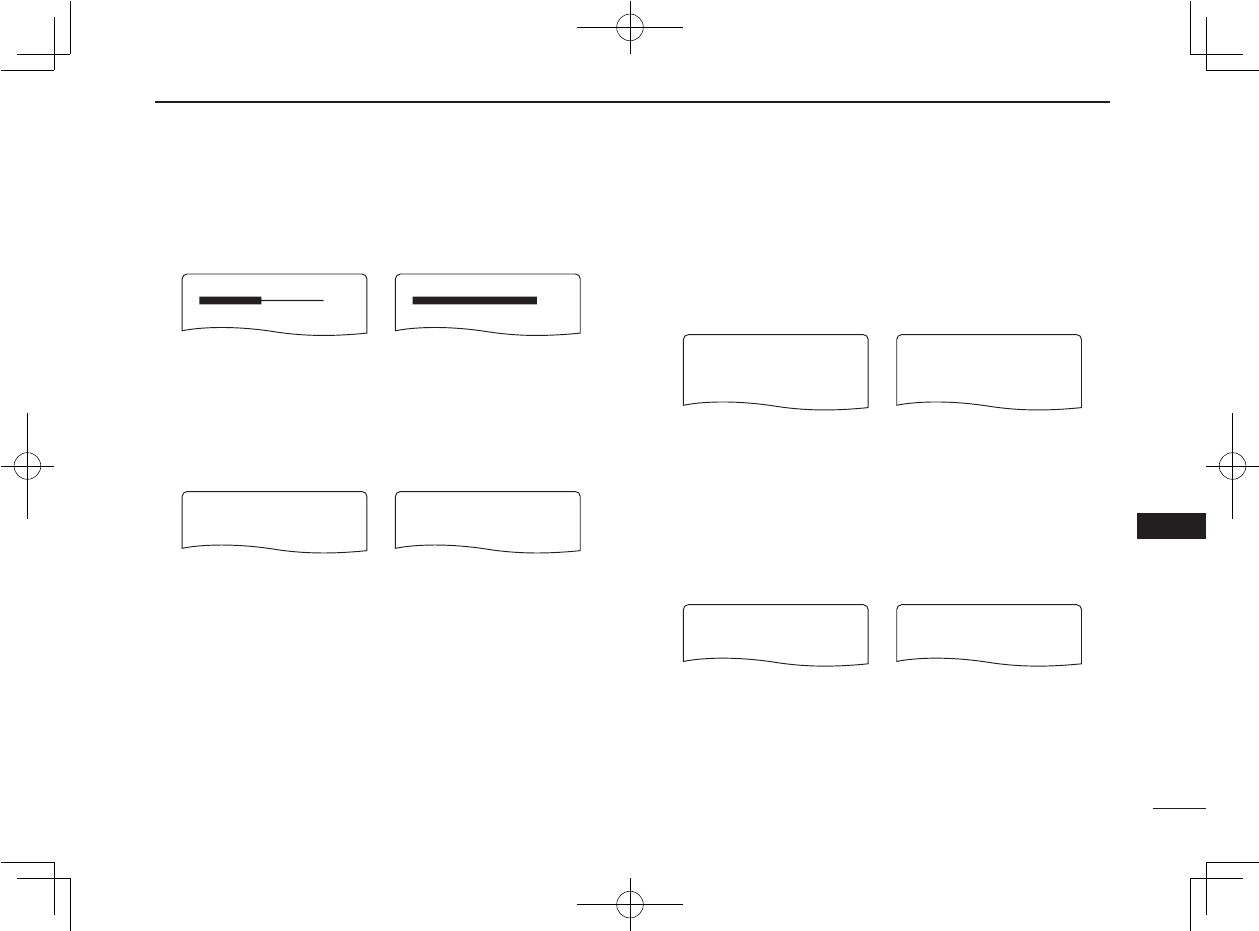
113
11
MENU SCREEN OPERATION
New2001
1
2
3
4
5
6
7
8
9
10
11
12
13
14
15
16
17
18
19
D LCD contrast
The contrast of the LCD can be selected from 16 levels.
• 1 (Low contrast) to 16 (High contrast) (default: 8)
D RX Call Sign Display
☞ Available for IC-92AD, or UT-121 is installed IC-92A only.
When a call is received, the calling station call sign can be
indicated automatically. (default: AUTO)
D TX Call Sign Display
☞
Available for IC-92AD, or if the UT-121 is installed in the IC-92A.
Selects call sign display function from YOUR, MY and OFF.
When this setting is set to YOUR or MY, the transceiver au-
tomatically indicates the set station or your own call sign at
digital mode transmission. (default: YOUR)
D RX message Display
☞
Available for IC-92AD, or if the UT-121 is installed in the IC-92A.
Sets auto received message display function AUTO and
OFF. When this setting is set to AUTO, the transceiver auto-
matically indicates and scrolls the received message.
(default: AUTO)
LCD CONTRAST
LCD CONTRAST
LCD CONTRAST
LCD CONTRAST
High contrast (16)Default (8)
AUTO
OFF
RX CALL SIGN
RX CALL SIGN
r
AUTO
AUTO
OFF
RX CALL SIGN
RX CALL SIGN
r
YOUR
MY
OFF
TX CALL SIGN
TX CALL SIGN
r
YOUR
MY
OFF
TX CALL SIGN
TX CALL SIGN
r
AUTO
OFF
RX MESSAGE
RX MESSAGE
r
AUTO
AUTO
OFF
RX MESSAGE
RX MESSAGE
r
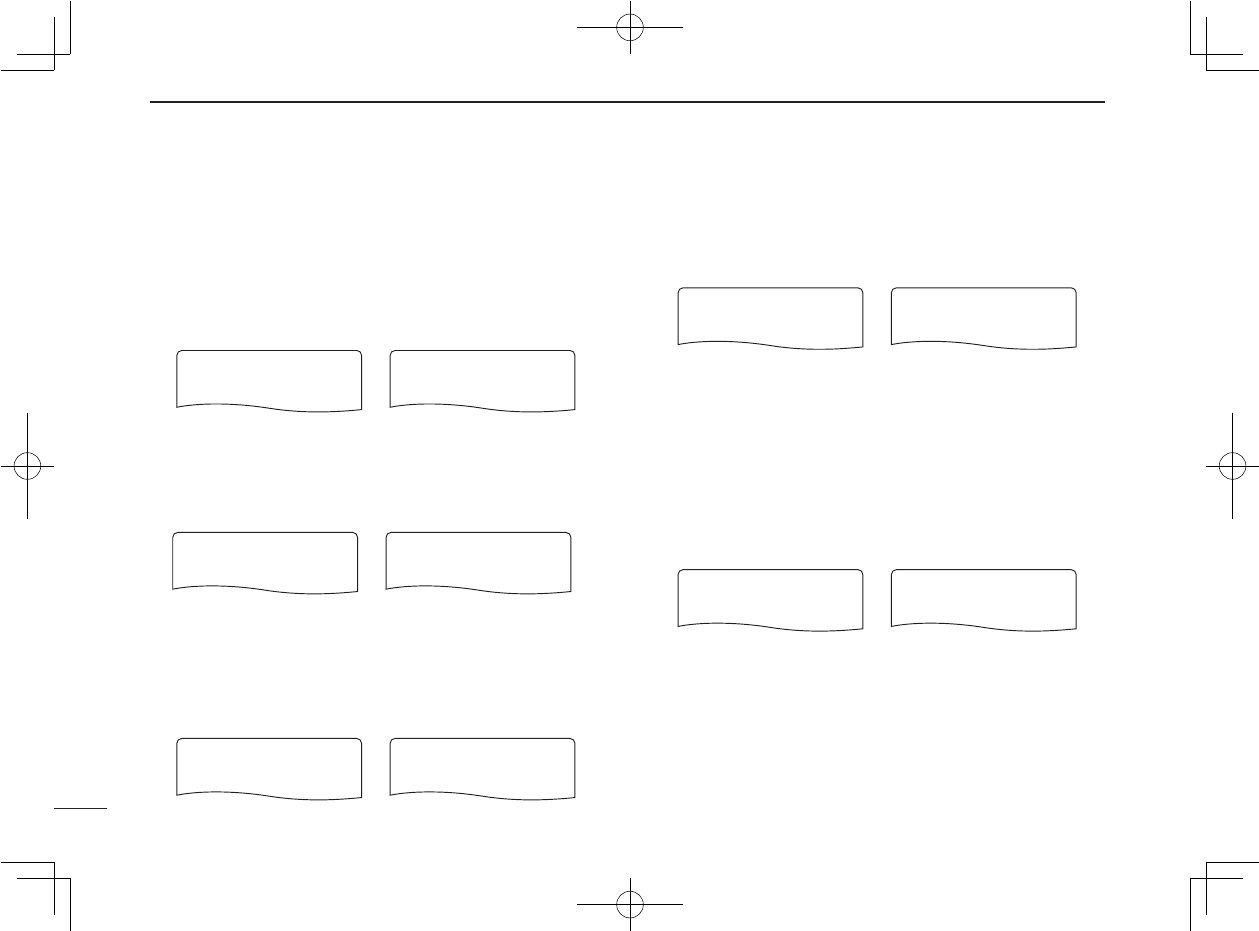
Ne
114
11 MENU SCREEN OPERATION
New2001
D Scan name
The programmed scan or bank name is displayed during the
scan type selection.
• ON : The programmed scan or bank name is dis-
played. (default)
• OFF : The programmed scan or bank name is not dis-
played.
D Scroll speed
Set he display scrolling speed.
• FAST : Scroll speed is set to fast. (default)
• SLOW : Scroll speed is set to slow.
D Opening logo
The opening logo indication (Icom logo and transceiver name)
that is displayed at power ON can be skipped, if desired.
• ON : Opening logo is displayed at power ON. (default)
• OFF : Opening logo indication is skipped.
D Opening call sign
☞
Available for IC-92AD, or if the UT-121 is installed in the IC-92A.
The set your own call sign, programmed in my call sign, can
be displayed at power ON. (default: OFF)
D Font size
Displayed character size during MENU mode indication in
the function display is selectable from Large and Small.
• LARGE : Makes 5 lines (Max. 5 items are displayed at the
same time). (default)
• SMALL : Makes 6 lines (Max. 6 items are displayed at the
same time).
ON
OFF
SCAN NAME
SCAN NAME
r
ON
OFF
SCAN NAME
SCAN NAME
r
ON
OFF
OPENING LOGO
OPENING LOGO
r
OFF
OFF
ON
OPENING LOGO
OPENING LOGO
r
OFF
ON
OPENING CALL S
OPENING CALL S
r
ON
OFF
OFF
OPENING CALL S
OPENING CALL S
r
LARGE
SMALL
FONT SIZE
FONT SIZE
r
SMALL
LARGE
FONT SIZE
FONT SIZE
r
SLOW
FAST
SCROLL
SCROLL
r
SLOW
SLOW
FAST
FAST
SCROLL
SCROLL
r
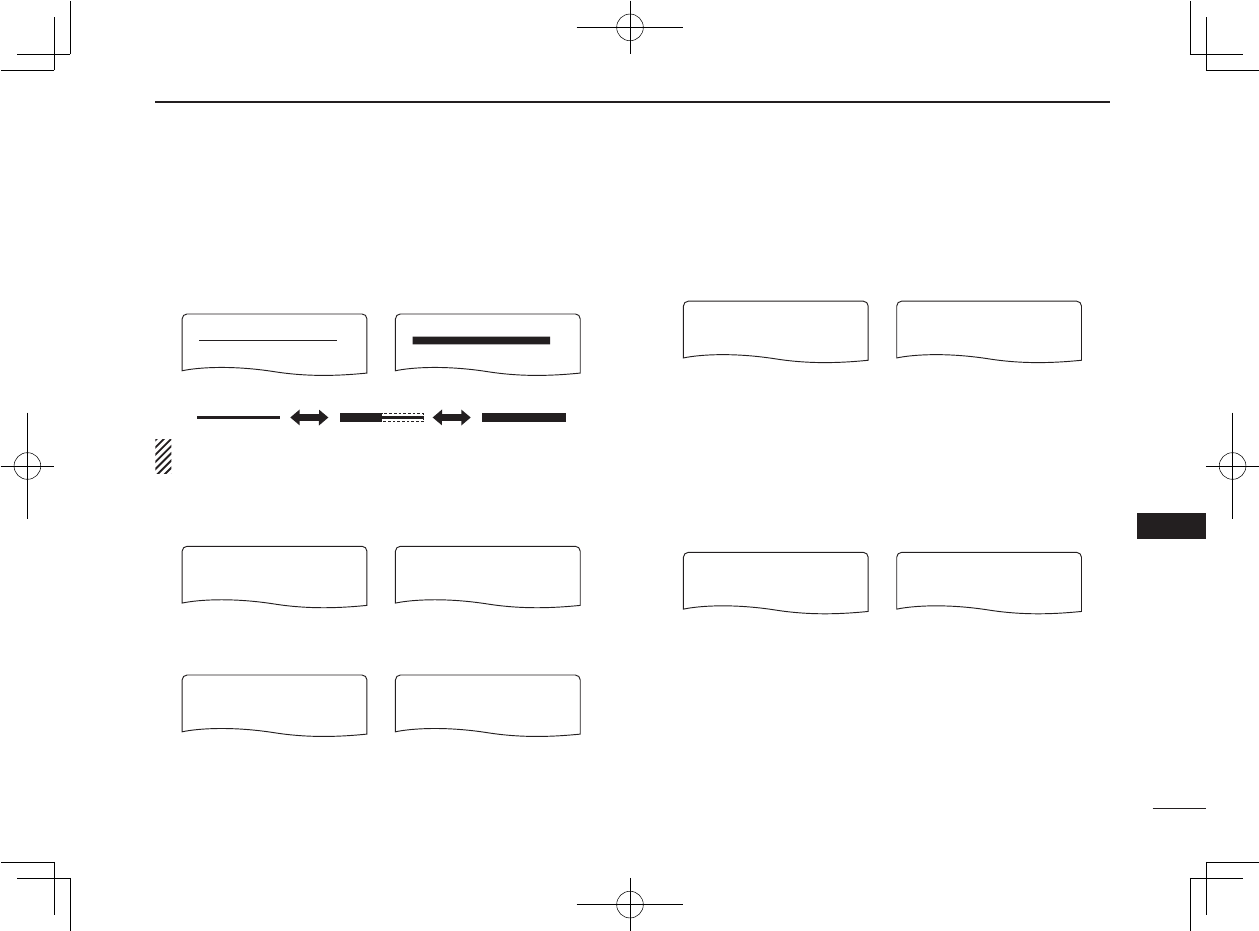
115
11
MENU SCREEN OPERATION
New2001
1
2
3
4
5
6
7
8
9
10
11
12
13
14
15
16
17
18
19
■ Sounds set mode items
D Beep output level
Adjusts the key-touch beep tone level to the desired level
within 39 levels.
The key-touch beep (following item) must be set to ON to
have a beep tone.
D Key-touch beep
Turns the key-touch beep ON or OFF. (default: ON)
D Scan stop beep
Turns the scan stop beep function ON or OFF. (default: OFF)
D Scope audio output
Select the audio output function capability during sweep with
band scope function.
• ON : The received audio sounds during sweep. (default)
• OFF : No audio sounds during sweep.
D Volume select
Select the volume level adjustment from Both and Separate
for dualwatch operation.
• BOTH : Both A band and B band volume level is
adjusted with [VOL] at the same time. (de-
fault)
• SEPARATE : The Volume setting is adjusted independ-
ently in A and B bands with [VOL].
BEEP LEVEL
BEEP LEVEL
BEEP LEVEL
BEEP LEVEL
Minimum level (no audio)Maximum level
ON
OFF
KEY-TOUCH BEEP
KEY-TOUCH BEEP
r
OFF
OFF
ON
KEY-TOUCH BEEP
KEY-TOUCH BEEP
r
OFF
ON
SCAN STOP BEEP
SCAN STOP BEEP
r
ON
OFF
OFF
SCAN STOP BEEP
SCAN STOP BEEP
r
ON
OFF
SCOPE AF OUTPUT
SCOPE AF OUTPUT
r
OFF
OFF
ON
SCOPE AF OUTPUT
SCOPE AF OUTPUT
r
BOTH
SEPARATE
VOLUME SELECT
VOLUME SELECT
r
SEPARATE
SEPARATE
BOTH
BOTH
VOLUME SELECT
VOLUME SELECT
r

116
11 MENU SCREEN OPERATION
New2001
D Standby Beep
☞ Available for IC-92AD, or if the UT-121 is installed in the IC-
92A.
Turns the beep emission capability ON and OFF when the
communicating station finishes transmitting or the receive
signal disappears while in the digital mode operation. (default:
ON)
D Sub-band muting function
Sub-band audio signal is muted automatically while dual-
band operating.
• OFF : Disable sub-band muting function. (default)
• MUTE : Sub-band audio signal is muted when re-
ceiving signal on MAIN band.
• BEEP : Beep sounds when finishing to receive
sub-band signal while sub-band muting.
ON
OFF
STANDBY BEEP
STANDBY BEEP
r
OFF
OFF
ON
STANDBY BEEP
STANDBY BEEP
r
MUTE
BEEP
OFF
SUB BAND BEEP
SUB BAND BEEP
r
OFF
OFF
MUTE
MUTE
BEEP
BEEP
SUB BAND BEEP
SUB BAND BEEP
r
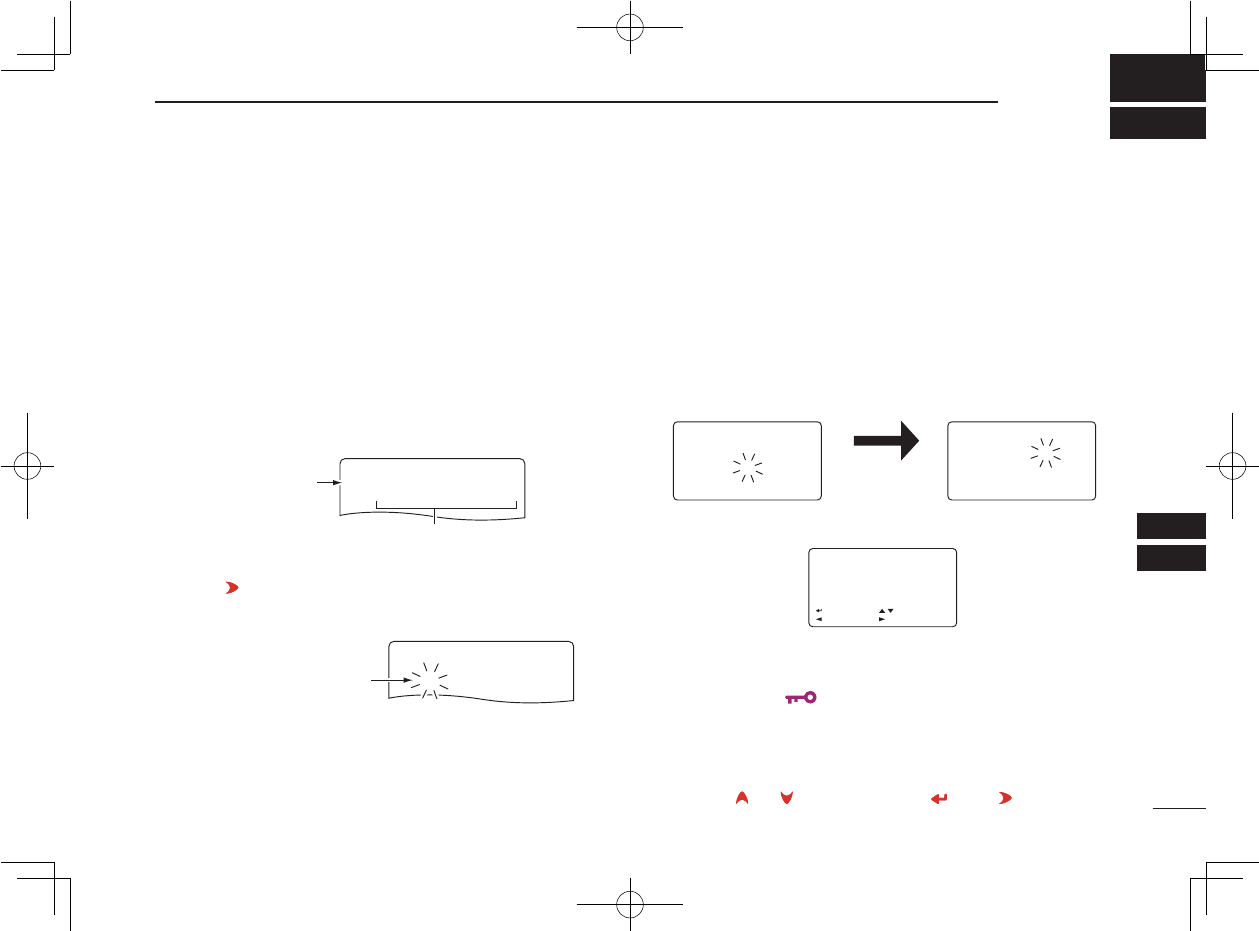
117
12
OTHER FUNCTIONS
1
2
3
4
5
6
7
8
9
10
11
12
13
14
15
16
17
18
19
■ Programming a DTMF code
DTMF codes are used for autopatching, accessing repeat-
ers, controlling other equipment, etc. The transceiver has 10
DTMF memory channels (Ch01–Ch10) for storage of often-
used DTMF codes of up to 16 digits.
q Push and hold [DTMF.M](9) for 1 sec. to enter DTMF
memory.
w Rotate [DIAL]† to select the desired DTMF memory chan-
nel.
• “T-CALL” appears when a 1750 Hz tone burst signal is selected.
(p. 33)
e Push [ ](6) to enter programming mode.
• Previously programmed DTMF code is displayed if pro-
grammed.
r Push the desired keys to input the characters.
• [0]–[9] input “0”–“9,” [A](VFO) inputs “A,” [B](MR) inputs “B,”
[C](CALL) inputs “C,” [D](BAND) inputs “D,” [#](.) inputs “#” and
[✱](REC) inputs “✱.”
• Up to 16 digits can be programmed.
• Push [MAIN/DUAL] to delete the cursor placed code.
• Push and hold [MAIN/DUAL] for 1 sec. to delete the character
at the cursor and all following characters.
t Repeat step r until the desired code is input.
y Push [MENU/ ] to program the DTMF code and exit
programming mode.
• Entering 16th digit automatically exits the programming mode.
u Push [VFO] to exit DTMF memory.
DTMF memory
channel
r
Ch01Ch01
DTMF MEMORYDTMF MEMORY
Displays NO indication when
the blank channel is selected.
r
Ch01
6
DTMF MEMORY
Ch01
01234567
89ABC*#0
:SET
:BACK
:SEL
:EDIT
DTMF MEMORY
Ch01
01234567
89AB
6
SQL:SET MAIN:CLR SQL:SET MAIN:CLR
DTMF MEMORY
Ch01
012345
6
7
89AB
DTMF MEMORY
The cursor is blinking when
entering programming mode.
r
Ch01
DTMF MEMORY
r
Ch01Ch01
6
DTMF MEMORYDTMF MEMORY
Ch01
01234567
89ABC*#0
:SET
:BACK
:SEL
:EDIT
DTMF MEMORY
Ch01
01234567
89AB
6
SQL:SET MAIN:CLR SQL:SET MAIN:CLR
DTMF MEMORY
Ch01
012345
6
7
89AB
DTMF MEMORY
The display after 16th digit of
channel 01 is input.
r
Ch01
DTMF MEMORY
r
Ch01
6
DTMF MEMORY
Ch01
01234567 01234567
89ABC*#0 89ABC*#0
:SET:SET
:BACK:BACK
:SEL:SEL
:EDIT:EDIT
DTMF MEMORYDTMF MEMORY
r
Ch01
01234567 01234567
89AB 89AB
6
SQL:SETSQL:SET MAIN:CLRMAIN:CLR SQL:SETSQL:SET MAIN:CLRMAIN:CLR
DTMF MEMORYDTMF MEMORY
r
Ch01Ch01
012345 012345
6
7
89AB
89AB
DTMF MEMORYDTMF MEMORY
r
The cursor can
be moved when
rotating [DIAL].
†[DIAL] ↔ [ ](2)/[](8) [ ](5) ↔ [ ](6)
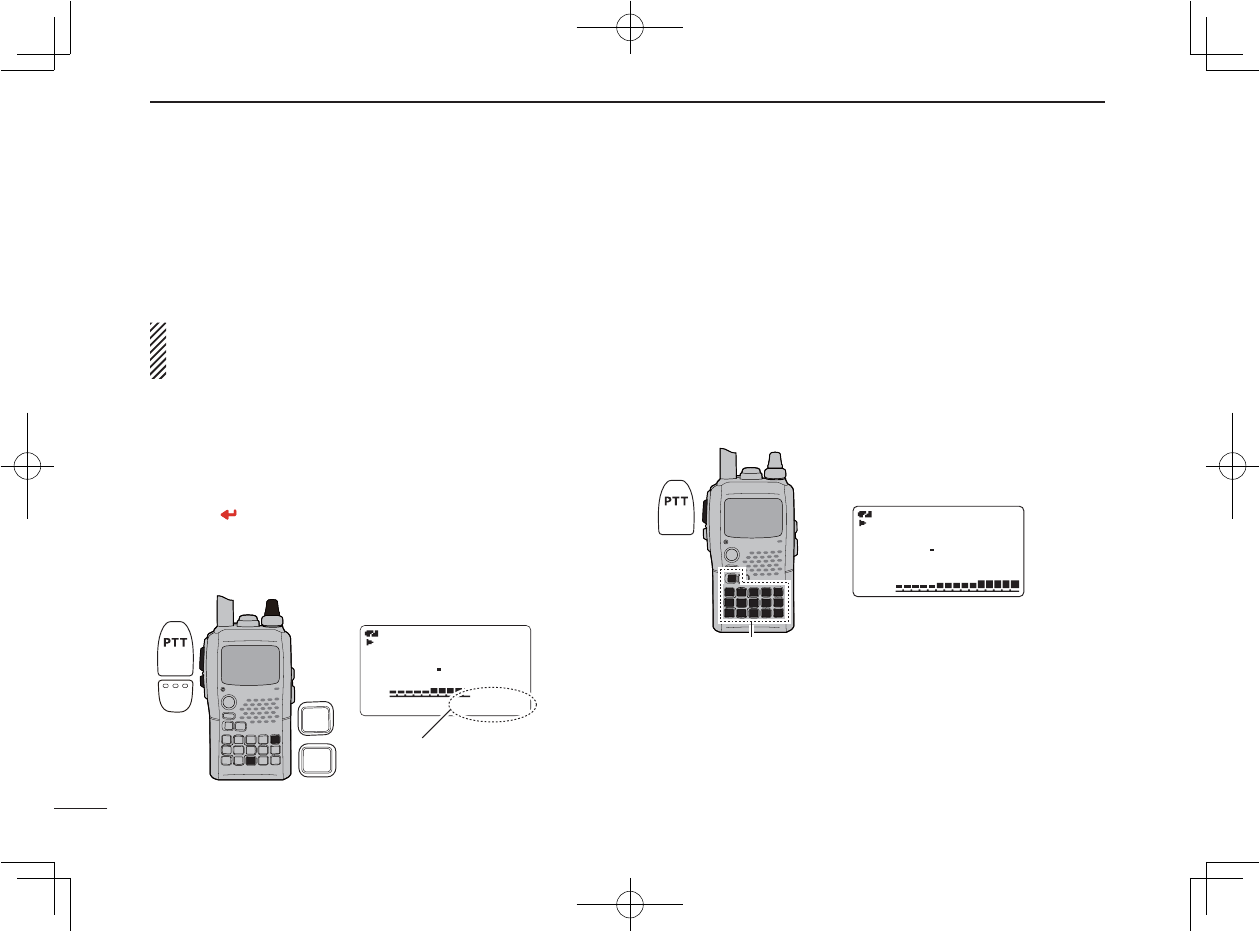
118
12 OTHER FUNCTIONS
New2001
■ Transmitting a DTMF code
D Transmitting from DTMF memory
The selected DTMF code is transmitted at each push of the
[SQL] switch while transmitting.
The transmitting speed at which DTMF memories send
individual DTMF characters can be set in “DTMF SPEED”
menu. (p. 99)
q Set the desired frequency. (p. 18)
w Push and hold [DTMF.M](9) for 1 sec. to enter DTMF
memory.
e Rotate [DIAL]† to select the desired DTMF memory chan-
nel.
r Push [](5) to set the DTMF memory.
t Push [VFO] to exit DTMF memory.
y While pushing [PTT], push [SQL] to transmit the selected
DTMF code.
D Transmitting a DTMF code directly
DTMF code can be transmitted via keypad directly while
transmitting.
q Set the desired frequency. (p. 18)
w While pushing [PTT], push the desired keys to transmit
the DTMF code.
• [0]–[9] input “0”–“9,” [A](VFO) inputs “A,” [B](MR) inputs “B,”
[C](CALL) inputs “C,” [D](BAND) inputs “D,” [#](.) inputs “#” and
[✱](REC) inputs “✱.”
MemoNameMemoName
PRIOPRIO WX EMREMR
DTCSDTCS
FM
A
438500
PSKIPPSKIP
+DUP+DUP
2525
μ
000000
5D28AB45D28AB4
The DTMF code is displayed to
here when transmitting the code.
A
FM
438500
PSKIP
[SQL]
[DIAL]
VFO
MHz
A
9
DTMF
.
M
CS
MemoName
PRIO WX EMR
DTCS
FM
A
438500
PSKIP
+DUP
25
μ
000
5D28AB4
DTMF codes do not appear on
the display when transmitting
codes directly.
A
FMFM
438500
PSKIPSKIP
DTMF code keys
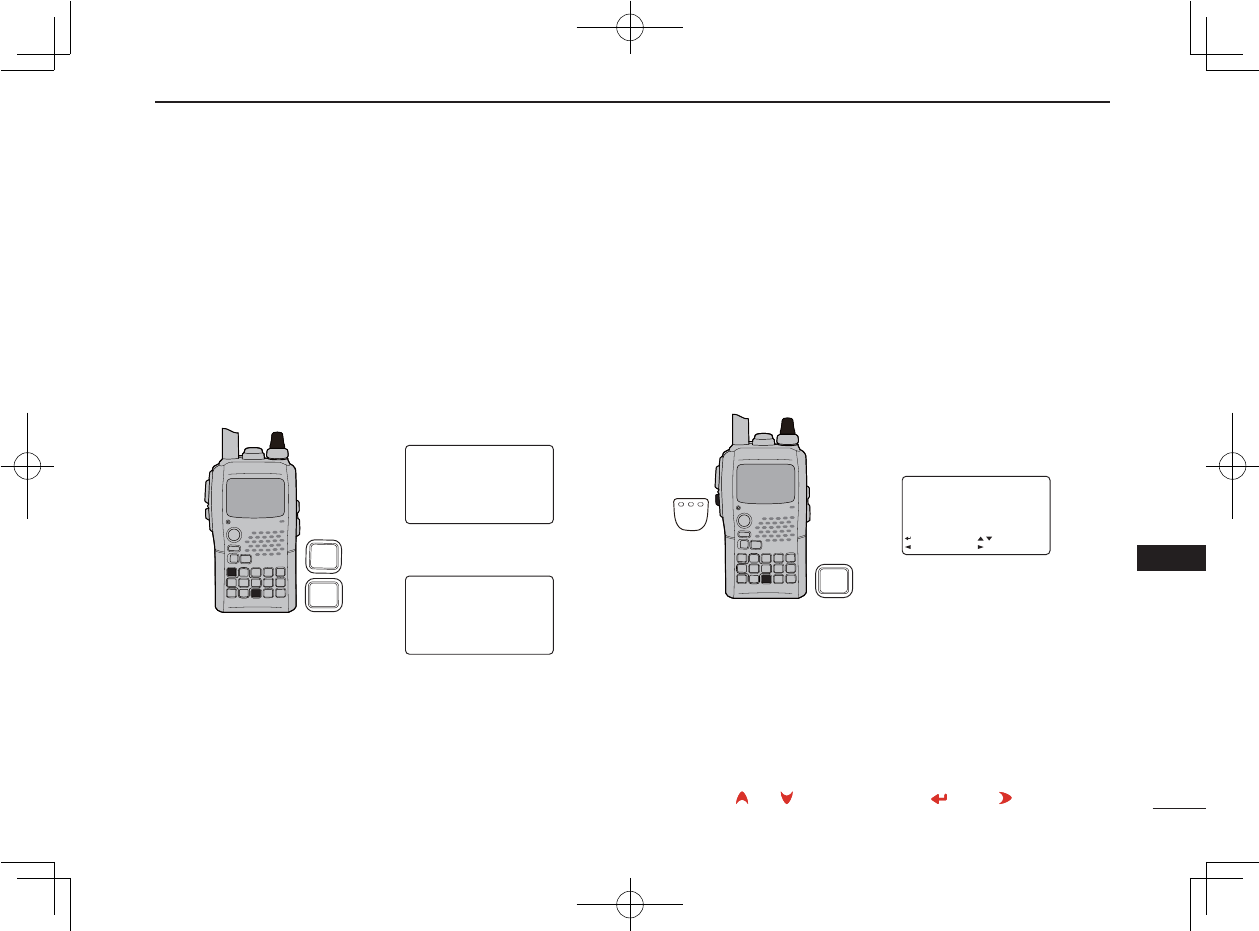
119
12
OTHER FUNCTIONS
1
2
3
4
5
6
7
8
9
10
11
12
13
14
15
16
17
18
19
■ Clearing a DTMF memory
An unwanted DTMF memory can be cleared (erased).
q Push and hold [DTMF.M](9) for 1 sec. to enter DTMF
memory mode.
w Rotate [DIAL]† to select the desired DTMF memory chan-
nel to be cleared.
e Push and hold [CLR](1) for 1 sec. to clear the selected
DTMF memory channel.
■ Confi rming a DTMF memory
A DTMF memory can be confi rmed with a DTMF tone.
q Push and hold [DTMF.M](9) for 1 sec. to enter DTMF
memory mode.
w Rotate [DIAL]† to select the desired DTMF memory chan-
nel.
e Push [SQL] to confi rm the DTMF memory contents.
•
•
When entering DTMF programming
mode.
After clearing the DTMF memory.
Ch01
01234567 01234567
89AB
SQL:BACKSQL:BACK MAIN:CLRMAIN:CLR
DTMF MEMORYDTMF MEMORY
r
Ch01
SQL:BACKSQL:BACK MAIN:CLRMAIN:CLR
DTMF MEMORYDTMF MEMORY
r
Ch01
01234567
89ABC*#0
:SET
:BACK
:SEL
:EDIT
DTMF MEMORY
[DIAL]
1
9
SCOPE
DTMF
.
M
CS
CLR
Push [SQL], then sounds DTMF
codes.
Ch01
01234567
89AB
SQL:BACK MAIN:CLR
DTMF MEMORY
Ch01
SQL:BACK MAIN:CLR
DTMF MEMORY
Ch01
01234567 01234567
89ABC*#0 89ABC*#0
:SET:SET
:BACK:BACK
:SEL:SEL
:EDIT:EDIT
DTMF MEMORYDTMF MEMORY
r
[SQL]
[DIAL]
9
DTMF
.
M
CS
†[DIAL] ↔ [ ](2)/[](8) [ ](5) ↔ [ ](6)
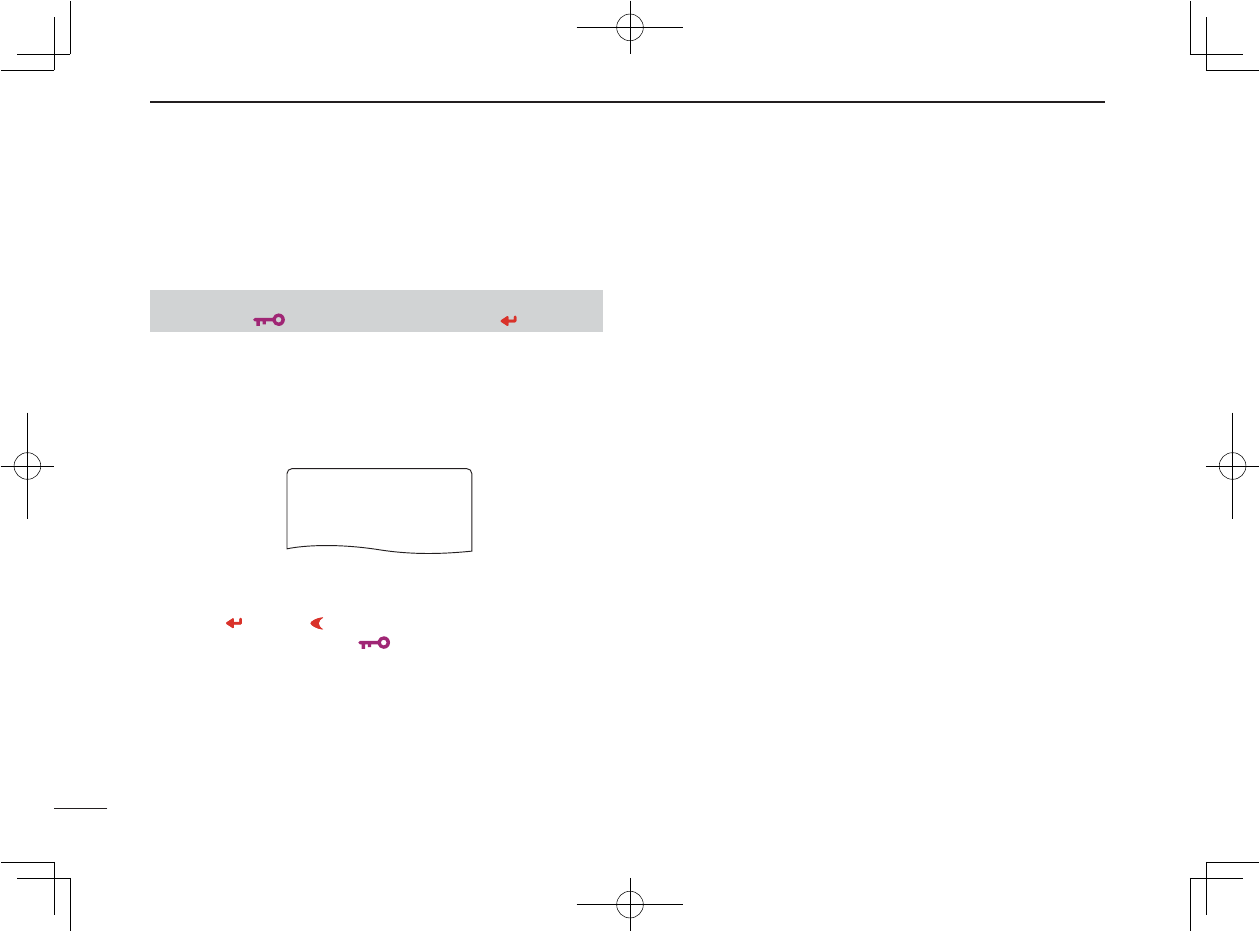
Ne
120
12 OTHER FUNCTIONS
New2001
■ Setting DTMF transfer speed
The DTMF transfer speed can be selected.
q Enter “DTMF SPEED” in DUP/TONE… set mode. (p. 99)
w Rotate [DIAL]† to select DTMF transfer speed as below.
100: Transfer the DTMF data per about 100 msec.
200: Transfer the DTMF data per about 200 msec.
300: Transfer the DTMF data per about 300 msec.
500: Transfer the DTMF data per about 500 msec.
e Push [](5) (or [](4)) to return to DUP/TONE… set
mode, and push [MENU/ ] to return to frequency indi-
cation.
■ Tone frequency and DTCS
code
D Subaudible (repeater) tone
Some repeaters require subaudible tones to be accessed.
Subaudible tones are superimposed over your normal signal
and must be set in advance.
D Tone and DTCS squelches
The tone squelch (CTCSS) or DTCS squelch opens only
when receiving a signal containing a matching subaudible
tone or DTCS code, respectively. You can silently wait for
calls from group members using the same tone or code.
Separate tone frequencies can be set for repeater and tone
squelch/pocket beep operation.
D Pocket beep
These functions use subaudible tones or DTCS codes for
calling and can be used as a “common pager” to inform
you that someone has called while you were away from the
transceiver.
❮MENU screen❯ ➪ ❮DUP/TONE...❯ ➪ ❮DTMF SPEED❯
(Push [MENU/ ]) (Rotate [DIAL]†, then push [ ](5)†.)
DV SET MODE
SCAN
r
DUP/TONE...
***** MENU *****
r
100
200
500
300
DTMF SPEEDDTMF SPEED
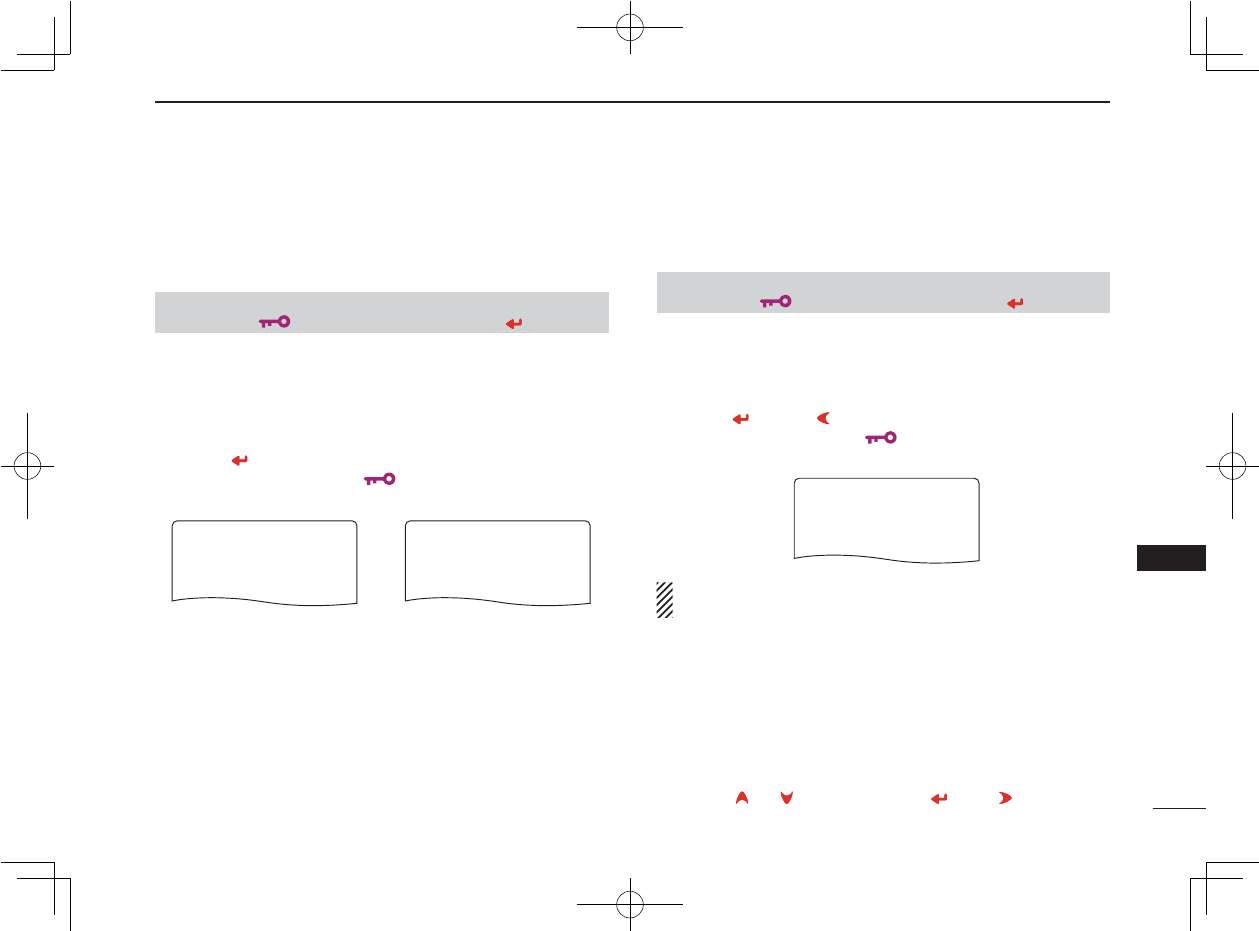
121
12
OTHER FUNCTIONS
New2001
1
2
3
4
5
6
7
8
9
10
11
12
13
14
15
16
17
18
19
D
Setting subaudible tones for repeater or
tone squelch
q Enter “CTCSS TONE (or RPT TONE)” in DUP/TONE…
set mode. (pgs. 97, 98)
w Rotate [DIAL]† to select the desired repeater or CTCSS
tone frequency.
• Each operating band and each memory channel have inde-
pendent settings.
• See page 98 for available tone frequencies for details.
e Push [](5) (or [Ω](4)) to return to DUP/TONE… set
mode, and push [MENU/ ] to return to frequency indi-
cation.
D Setting DTCS code for DTCS squelch or
beep
q Enter “DTCS CODE” in DUP/TONE... set mode. (p. 98)
w Rotate [DIAL]† to select the desired DTCS tone code.
• Each operating band and each memory channel have inde-
pendent settings.
• See page 98 for available DTCS codes for details.
e Push [](5) (or [](4)) to return to DUP/TONE… set
mode, and push [MENU/ ] to return to frequency indi-
cation.
DTCS phase mode can be selected in “DTCS POLAR-
ITY” menu. (p. 99)
❮MENU screen❯ ➪ ❮DUP/TONE...❯ ➪ ❮CTCSS TONE❯
(Push [MENU/ ]) (Rotate [DIAL]†, then push [ ](5)†.)
DV SET MODE
SCAN
r
DUP/TONE...
***** MENU *****
88.588.5
200
500
r
300
CTCSS TONECTCSS TONE
88.5
200
500
r
300300
REPEATER TONEREPEATER TONE
DV SET MODE
SCAN
r
DUP/TONE...
***** MENU *****
023
200
500
r
300
DTCS CODE
❮MENU screen❯ ➪ ❮DUP/TONE...❯ ➪ ❮DTCS TONE❯
(Push [MENU/ ]) (Rotate [DIAL]†, then push [ ](5)†.)
DV SET MODE
SCAN
r
DUP/TONE...
***** MENU *****
88.5
200
500
r
300
CTCSS TONE
88.5
200
500
r
300
REPEATER TONE
DV SET MODE
SCAN
r
DUP/TONE...
***** MENU *****
023
200
500
r
300
DTCS CODEDTCS CODE
†[DIAL] ↔ [ ](2)/[](8) [ ](5) ↔ [ ](6)
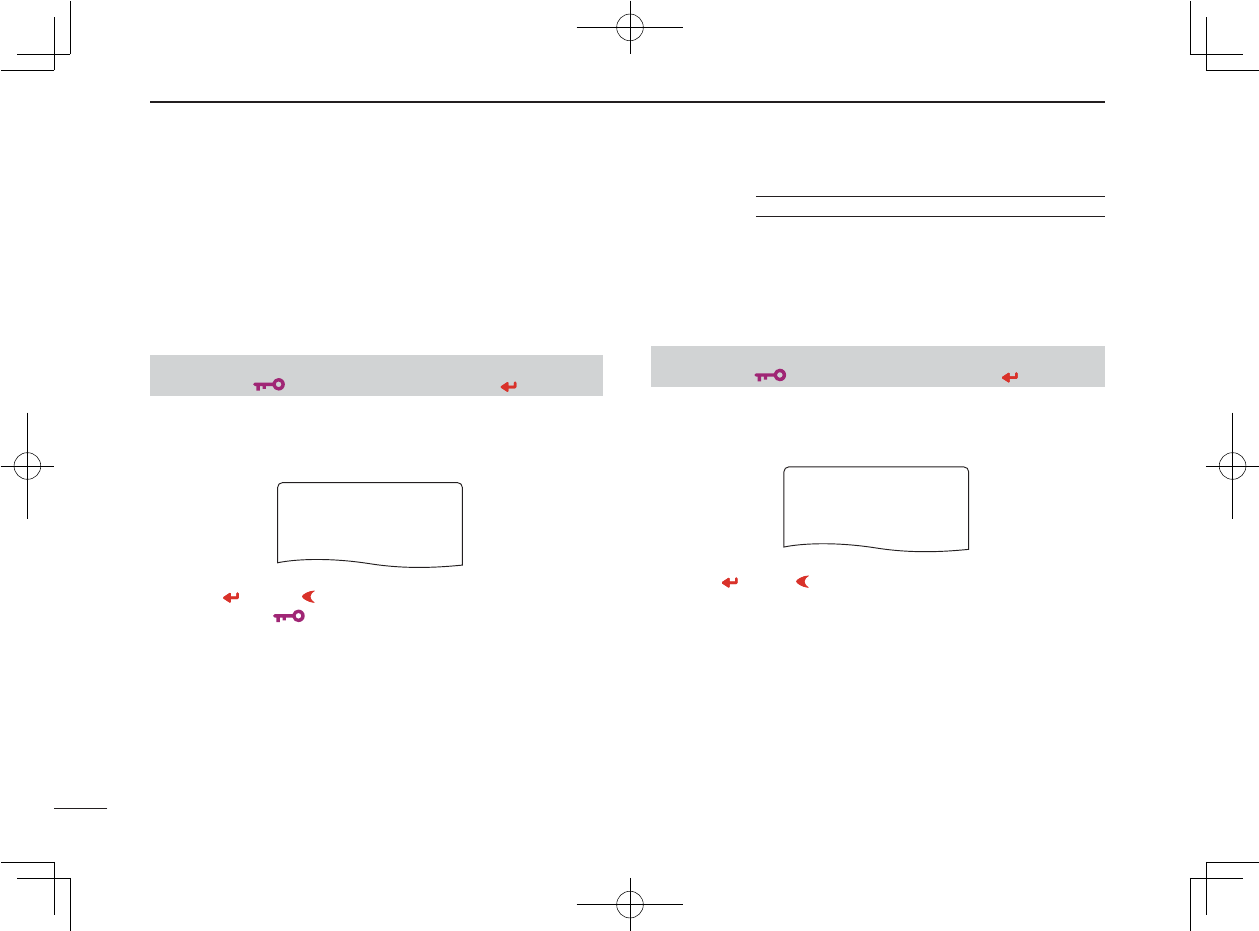
Ne
122
12 OTHER FUNCTIONS
New2001
D
Setting digital code
for digital code squelch
or beep
q Push [MAIN/DUAL] to select B band, then push and hold
[MODE](REC) for 1 sec. several times to select DV mode.
w Enter “DIGITAL CODE” in DV SET MODE. (p. 92)
e Rotate [DIAL]† to select the desired digital code.
• Each operating band and each memory channel have inde-
pendent settings.
r Push [](5) (or [](4)) to return to DV SET MODE, and
push [MENU/ ] to return to frequency indication.
D Setting the YOUR and MY call signs for
digital call sign squelch or beep
q Push [MAIN/DUAL] to select B band, then push and hold
[MODE](REC) for 1 sec. several times to select DV mode.
w Enter “YOUR CALL SIGN” in CALL SIGN set mode. (p. 36)
e Rotate [DIAL]† to select the desired call sign.
• Input the call sign if the desired call sign is not stored in the
transceiver. See p. 36 for detail.
r Push [ ](5) (or [ ](4)) to return to CALL SIGN set mode.
Continue to the next page.
■ Digital code and digital call sign setting
❮MENU screen❯ ➪ ❮DV SET MODE❯ ➪ ❮DIGITAL CODE❯
(Push [MENU/ ]) (Rotate [DIAL]†, then push [ ](5)†.)
❮MENU screen❯ ➪ ❮CALL SIGN❯ ➪ ❮YOUR CALL SIGN❯
(Push [MENU/ ]) (Rotate [DIAL]†, then push [ ](5)†.)
DV VOICE M
SET MODE
r
DV SET MODE
***** MENU *****
00
200
500
r
300
DIGITAL CODEDIGITAL CODE
r
CALL SIGN
RX CALL S
MESSAGE/POS
***** MENU *****
r
U01
ABCDEF
500
r
300
YOUR CALL SIGN
r
M01
GHIJKL
500
r
300
MY CALL SIGN
DV VOICE M
SET MODE
r
DV SET MODE
***** MENU *****
00
200
500
r
300
DIGITAL CODE
r
CALL SIGN
RX CALL S
MESSAGE/POS
***** MENU *****
r
U01
ABCDEF
500
r
300
YOUR CALL SIGNYOUR CALL SIGN
r
M01
GHIJKL
500
r
300
MY CALL SIGN
The optional UT-121 is required for the IC-92A
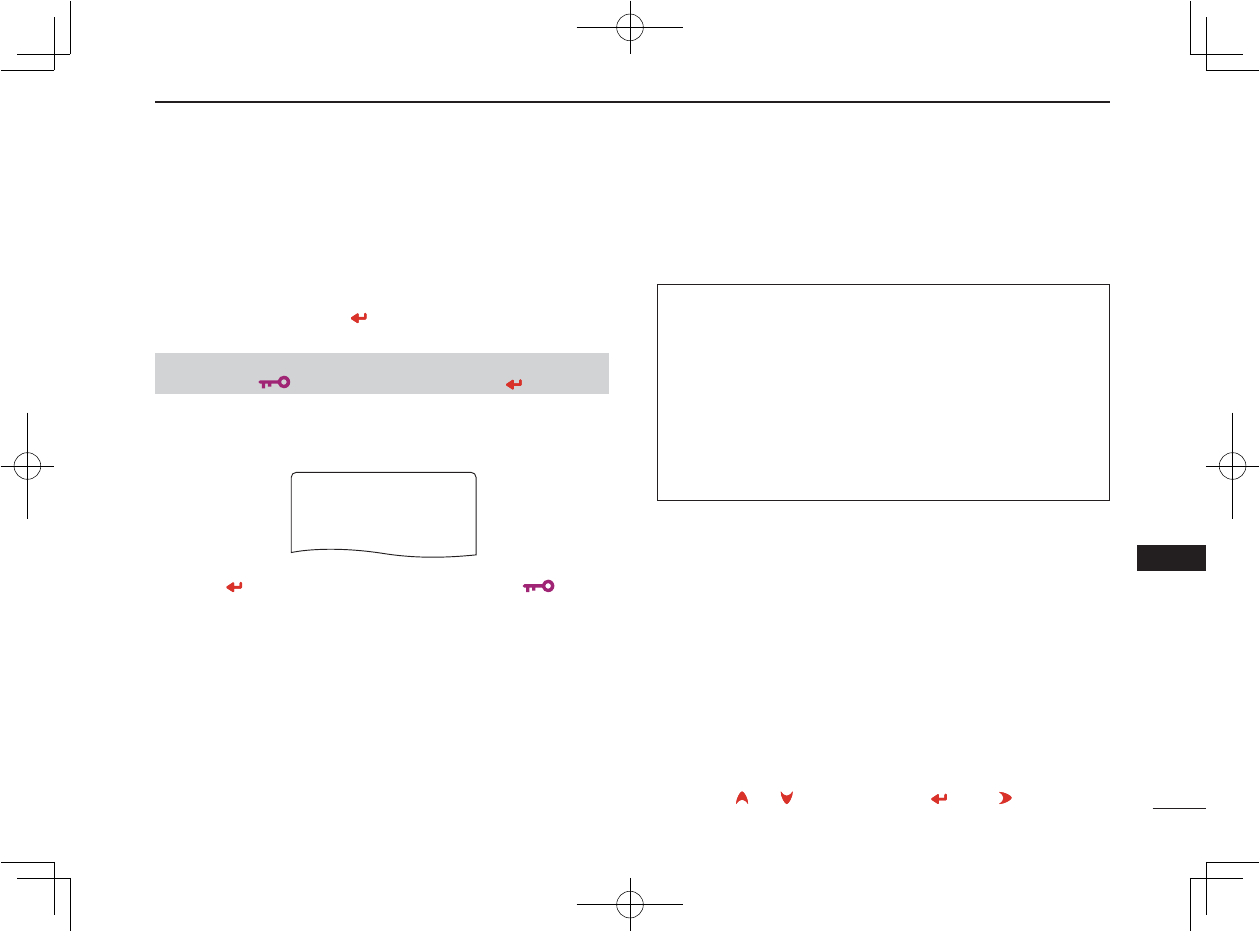
123
12
OTHER FUNCTIONS
New2001
1
2
3
4
5
6
7
8
9
10
11
12
13
14
15
16
17
18
19
t Rotate [DIAL]† to select “MY CALL SIGN” in CALL SIGN
set mode, then push [](5)† to enter “MY CALL SIGN”
setting.
y Rotate [DIAL]† to select the desired call sign.
• Input the call sign if the desired call sign is not stored in the
transceiver. See pgs. 34 and 35 for detail.
u Push [ ](5) to set call sign and push [MENU/ ] to re-
turn to frequency indication.
❮MENU screen❯ ➪ ❮CALL SIGN❯ ➪ ❮MY CALL SIGN❯
(Push [MENU/ ]) (Rotate [DIAL]†, then push [ ](5)†.)
DV VOICE M
SET MODE
r
DV SET MODE
***** MENU *****
00
200
500
r
300
DIGITAL CODE
r
CALL SIGN
RX CALL S
MESSAGE/POS
***** MENU *****
r
U01
ABCDEF
500
r
300
YOUR CALL SIGN
r
M01
GHIJKL
500
r
300
MY CALL SIGNMY CALL SIGN
CAUTION!: Use digital code squelch when operating with
more than 3 stations. Because the digital call sign squelch
function recognizes “MY CALL SIGN,” the digital call sign
squelch function can be used when operating with only
one station.
NOTE:
• The tone/DTCS code squelch opens sometimes when
other stations communicate with adjacent tone frequency
or DTCS code.
†[DIAL] ↔ [ ](2)/[](8) [ ](5) ↔ [ ](6)
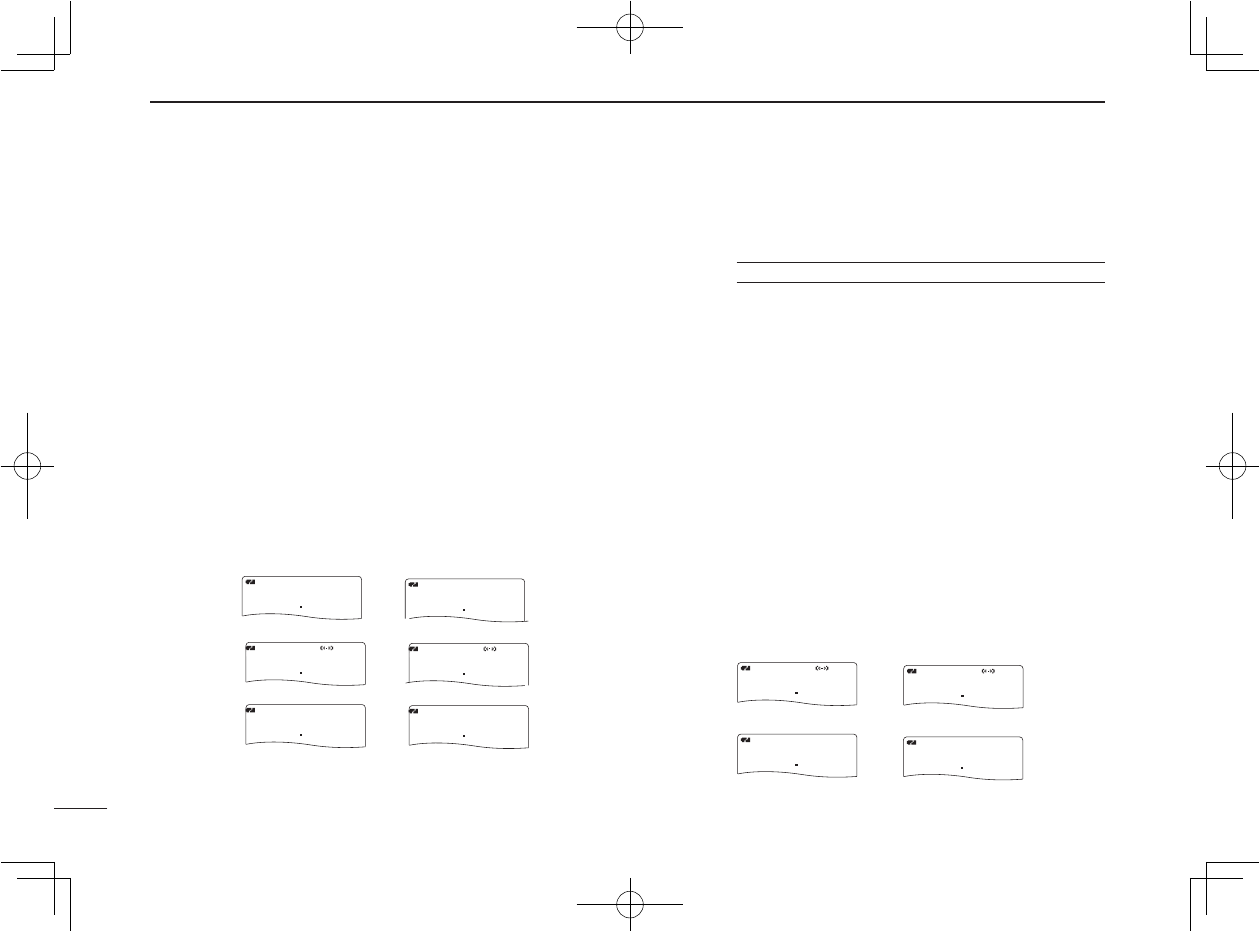
Ne
124
12 OTHER FUNCTIONS
New2001
■ Tone/DTCS squelch
q Set the desired operating frequency, CTCSS tone and
DTCS code.
w Push and hold [TONE](7) for 1 sec. several times to acti-
vate the tone or DTCS squelch. (TONE, TSQL or DTCS)
• Subaudible tone encoder “TONE,” tone squelch “TSQL,”
pocket beep “TSQLS,” DTCS squelch “DTCS,” DTCS beep
“DTCSS” and no tone operation are activated in order.
• Rotating [DIAL] while pushing [TONE](7) also selects the tone
functions.
e Operate the transceiver in the normal way.
r When the received signal includes a matching tone/code,
the squelch opens and the signal can be heard.
• When the received signal’s tone/code does not match, tone/
DTCS squelch does not open, however, the S-indicator shows
signal strength.
• To open the squelch manually, push and hold [SQL].
■ Digital code/digital call sign
squelch
q Set the desired operating frequency on DV mode, Digital
code and MY CALL SIGN.
w Push and hold [DSQ](7) for 1 sec. several times to acti-
vate the digital code or digital call sign squelch. (DSQL or
CSQL)
• Digital call sign squelch “DSQL,” Digital call sign beep
“DSQLS”, Digital code squelch “CSQL,” Digital code beep
“CSQLS” and no tone operation are activated in order.
• Rotating [DIAL] while pushing [DSQ](7) also selects the tone
functions.
e Operate the transceiver in the normal way.
r When the received signal includes a matching call sign/
code, the squelch opens and the signal can be heard.
• When the received signal’s call sign/code does not match, dig-
ital call sign/digital code squelch does not open, however, the
S-indicator shows signal strength.
• To open the squelch manually, push and hold [SQL].
B
MemoNameMemoName
PRIOPRIO WXWX EMREMR
DTCSDTCS
FMFM
145300145300
PSKIPPSKIP
+DUP+DUP
2525
B
MemoNameMemoName
PRIOPRIO WXWX EMREMR
TONETONE
FMFM
145300145300
PSKIPPSKIP
+DUP+DUP
2525
B
MemoNameMemoName
PRIOPRIO WXWX EMREMR
TSQLTSQL
FMFM
145300145300
PSKIPPSKIP
+DUP+DUP
2525
B
MemoNameMemoName
PRIOPRIO WXWX EMREMR
DTCSDTCS
FMFM
145300145300
PSKIPPSKIP
+DUP+DUP
2525
B
MemoName
PRIOWXEMR
TSQL
FM
438500
PSKIP
+DUP
25
B
MemoName
PRIO WX EMR
DTCS
FM
438500
PSKIP
+DUP
25
B
MemoNameMemoName
PRIOPRIO WXWX EMREMR
DTCSDTCS
FMFM
145300145300
PSKIPPSKIP
+DUP+DUP
2525
B
MemoNameMemoName
PRIOPRIO WXWX EMREMR
TSQLTSQL
FMFM
145300145300
PSKIPPSKIP
+DUP+DUP
2525
B
MemoName
PRIO WX EMR
DSQL
DV
145300
PSKIP
+DUP
25
B
MemoName
PRIO WX EMR
CSQL
DV
145300
PSKIP
+DUP
25
B
MemoName
PRIO WX EMR
DSQL
DV
145300
PSKIP
+DUP
25
B
MemoName
PRIO WX EMR
CSQL
DV
145300
PSKIP
+DUP
25
B
MemoName
PRIO WX EMR
DSQL
DV
438500
PSKIP
+DUP
25
B
MemoName
PRIO WX EMR
CSQL
DV
438500
PSKIP
+DUP
25
No tone operation
Subaudible tone encoder
Tone squelch
Pocket beep DTCS beep
DTCS squelch
The optional UT-121 is required for the IC-92A
B
MemoName
PRIO WX EMR
DTCS
FM
145300
PSKIP
+DUP
25
B
MemoName
PRIOWXEMR
TONE
FM
145300
PSKIP
+DUP
25
B
MemoName
PRIOWXEMR
TSQL
FM
145300
PSKIP
+DUP
25
B
MemoName
PRIOWXEMR
DTCS
FM
145300
PSKIP
+DUP
25
B
MemoName
PRIOWXEMR
TSQL
FM
438500
PSKIP
+DUP
25
B
MemoName
PRIOWXEMR
DTCS
FM
438500
PSKIP
+DUP
25
B
MemoName
PRIOWXEMR
DTCS
FM
145300
PSKIP
+DUP
25
B
MemoName
PRIOWXEMR
TSQL
FM
145300
PSKIP
+DUP
25
B
MemoNameMemoName
PRIOPRIO WXWX EMREMR
DSQLDSQL
DVDV
145300145300
PSKIPPSKIP
+DUP+DUP
2525
B
MemoNameMemoName
PRIOPRIO WXWX EMREMR
CSQLCSQL
DVDV
145300145300
PSKIPPSKIP
+DUP+DUP
2525
B
MemoNameMemoName
PRIOPRIO WXWX EMREMR
DSQLDSQL
DVDV
145300145300
PSKIPPSKIP
+DUP+DUP
2525
B
MemoNameMemoName
PRIOPRIO WXWX EMREMR
CSQLCSQL
DVDV
145300145300
PSKIPPSKIP
+DUP+DUP
2525
B
MemoName
PRIOWXEMR
DSQL
DV
438500
PSKIP
+DUP
25
B
MemoName
PRIO WX EMR
CSQL
DV
438500
PSKIP
+DUP
25
Digital call sign squelch
Digital call sign pocket beep Digital code pocket beep
Digital code squelch
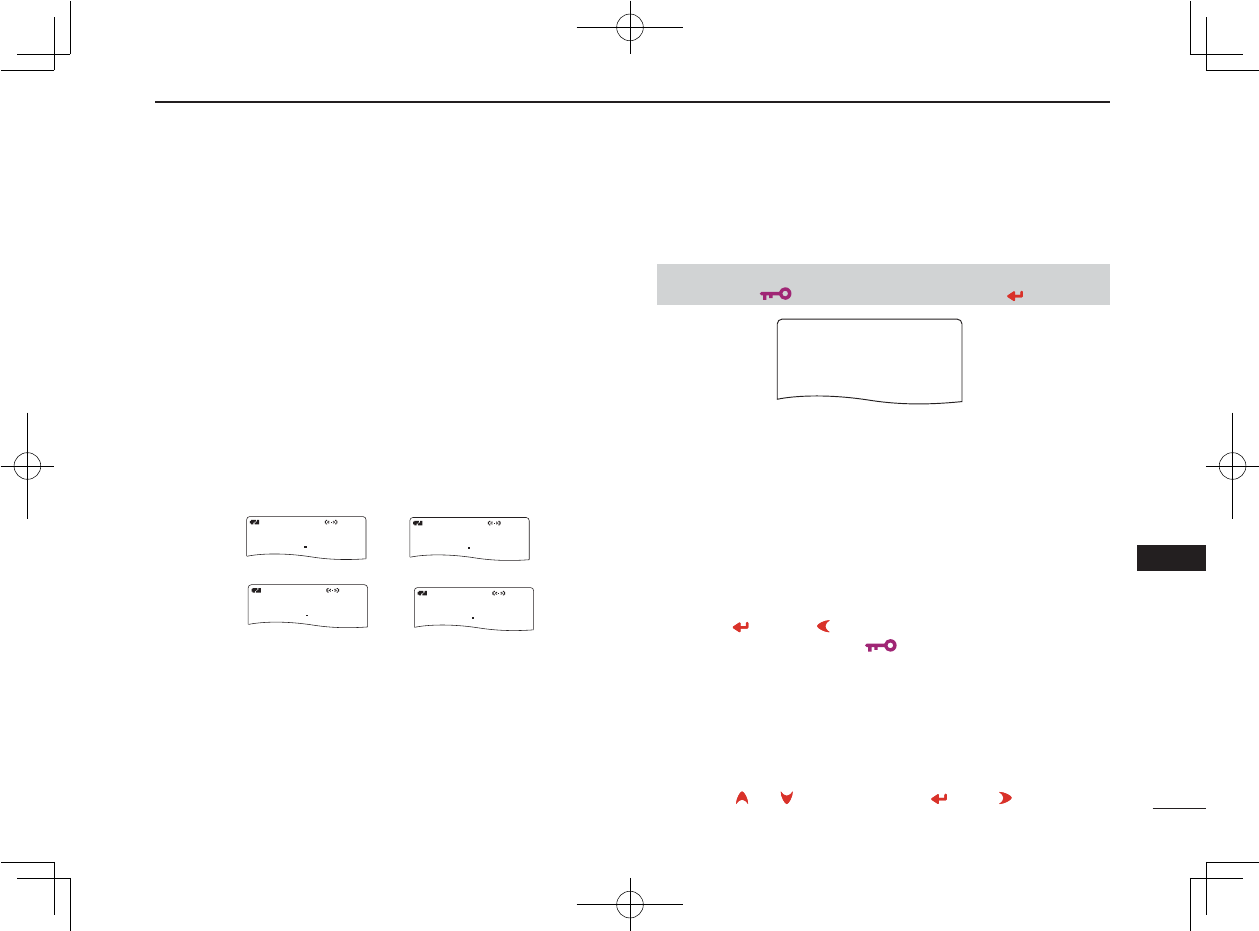
125
12
OTHER FUNCTIONS
New2001
1
2
3
4
5
6
7
8
9
10
11
12
13
14
15
16
17
18
19
■ Pocket beep function
q Set the desired operating frequency.
w Set the desired CTCSS tone, DTCS code, Digital call sign
or Digital code.
e Push and hold [TONE](7)/[DSQ](7) for 1 sec. several
times to activate the pocket beep, DTCS beep, Digital
call sign beep or Digital code beep. (“TSQLS,” “DTCS
S,” “DSQLS” or “CSQLS”)
• Rotating [DIAL] while pushing [TONE](7)/[DSQ](7) also selects
the tone functions.
r When a signal with the correct tone, code, digital call sign
or digital code is received, the transceiver emits beep
tones for 30 sec. and blinks “S.”
t Push [PTT] to answer or push [SQL] to stop the beeps
and blinking.
■ DTCS polarity setting
q Enter “DTCS P” in DUP/TONE... set mode. (p. 99)
w Rotate [DIAL]† to select the desired DTCS polarity mode.
• BOTH N: Normal phase is used for both TX and RX.
(Default)
• TN-RR: Normal phase is used for TX; Reverse
phase for RX.
• TR-RN: Reverse phase is used for TX; Normal
phase for RX.
• BOTH R: Reverse phase is used for both TX and
RX.
e Push [](5) (or [](4)) to return to DUP/TONE… set
mode, and push [MENU/ ] to return to frequency indi-
cation.
B
MemoName
PRIO WX EMR
DTCS
FM
145300
PSKIP
+DUP
25
B
MemoName
PRIOWXEMR
TONE
FM
145300
PSKIP
+DUP
25
B
MemoName
PRIOWXEMR
TSQL
FM
145300
PSKIP
+DUP
25
B
MemoName
PRIO WX EMR
DTCS
FM
145300
PSKIP
+DUP
25
B
MemoNameMemoName
PRIOPRIO WXWX EMREMR
TSQLTSQL
FMFM
438500
PSKIPPSKIP
+DUP+DUP
2525
B
MemoNameMemoName
PRIOPRIO WXWX EMREMR
DTCSDTCS
FMFM
438500
PSKIPPSKIP
+DUP+DUP
2525
B
MemoName
PRIO WX EMR
DTCS
FM
145300
PSKIP
+DUP
25
B
MemoName
PRIOWXEMR
TSQL
FM
145300
PSKIP
+DUP
25
B
MemoName
PRIO WX EMR
DSQL
DV
145300
PSKIP
+DUP
25
B
MemoName
PRIO WX EMR
CSQL
DV
145300
PSKIP
+DUP
25
B
MemoName
PRIO WX EMR
DSQL
DV
145300
PSKIP
+DUP
25
B
MemoName
PRIO WX EMR
CSQL
DV
145300
PSKIP
+DUP
25
B
MemoNameMemoName
PRIOPRIO WXWX EMREMR
DSQLDSQL
DVDV
43438500
PSKIPPSKIP
+DUP+DUP
2525
B
MemoNameMemoName
PRIOPRIO WXWX EMREMR
CSQLCSQL
DVDV
438500
PSKIPPSKIP
+DUP+DUP
2525
Digital call sign pocket beep Digital code pocket beep
Pocket beep DTCS beep
❮MENU screen❯ ➪ ❮DUP/TONE...❯ ➪ ❮DTCS P❯
(Push [MENU/ ]) (Rotate [DIAL]†, then push [ ](5)†.)
r
r
RPT TONE
CTCSS TONE
CTCSS TONE
r
DTCS CODE
DUP/TONE...
DUP/TONE...
r
DTCS P
DTCS P
†[DIAL] ↔ [ ](2)/[](8) [ ](5) ↔ [ ](6)
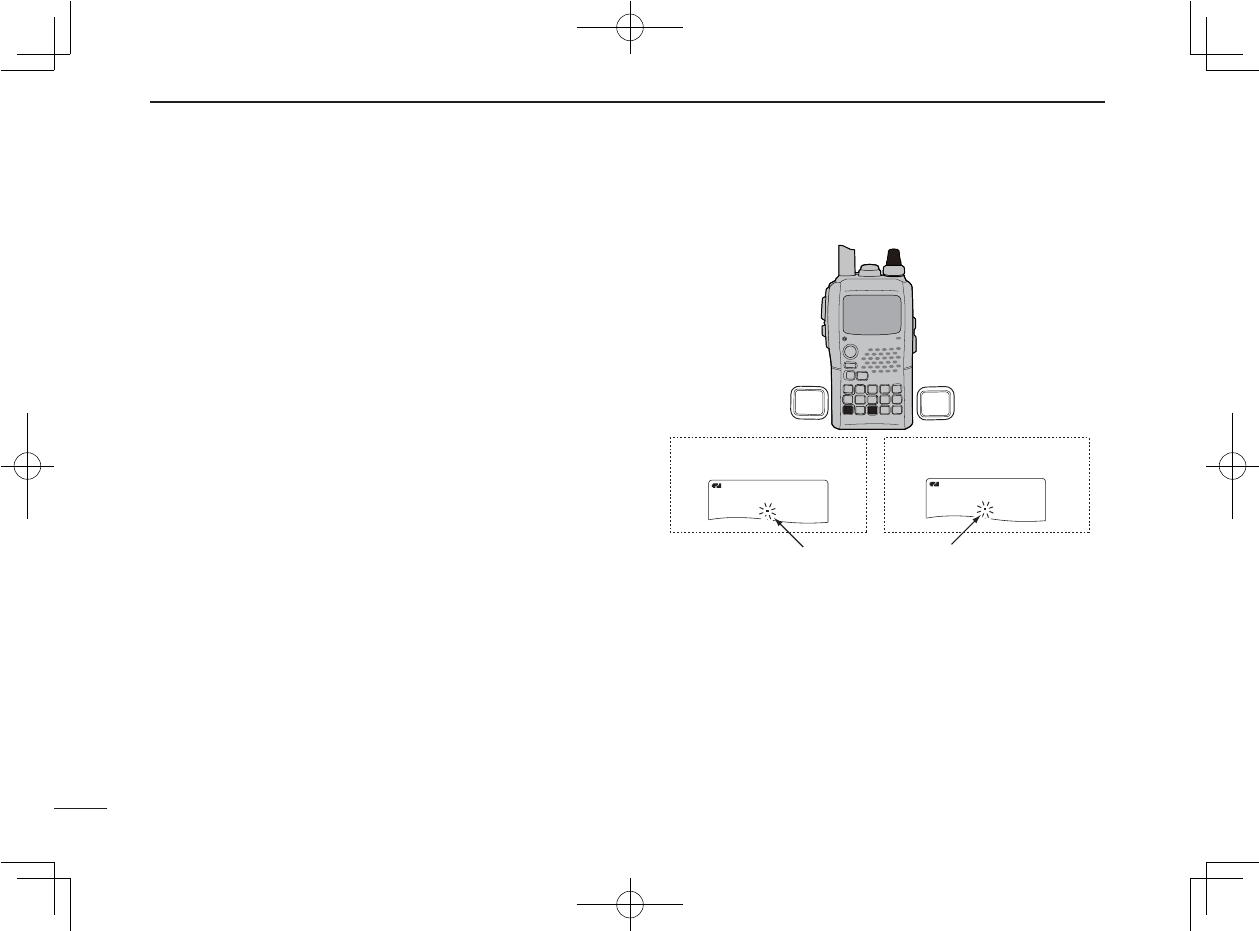
Ne
126
12 OTHER FUNCTIONS
New2001
■ Tone scan
The transceiver can detect the subaudible tone frequency
and DTCS code in a received signal. By monitoring a signal
that is being transmitted on a repeater input frequency, you
can determine the tone frequency required to access the re-
peater.
q Set the desired frequency or memory channel to be
checked for a tone frequency or DTCS code.
w Push and hold [TONE](7) for 1 sec. several times to ac-
tivate the repeater tone, tone squelch or DTCS squelch.
(TONE, TSQL or DTCS)
• Rotating [DIAL] while pushing and holding [TONE](7) also se-
lects the tone functions.
e Push and hold [T.SCAN](.) for 1 sec. to start the tone
scan.
• To change the scanning direction, rotate [DIAL].
r When the tone frequency or DTCS code is decoded, the
set mode contents are programmed with the frequency or
code.
• The tone scan pauses for the set period in scan pause timer
(p. 96) when a tone frequency or DTCS code is detected.
• The decoded tone frequency is used for the repeater tone fre-
quency when the tone squelch is OFF.
• The decoded tone frequency is used for the tone squelch fre-
quency (CTCSS TONE) when the tone squelch is ON.
• The decoded DTCS code is used for the DTCS code when the
DTCS squelch is ON.
t Push [VFO] to stop the scan.
• If the scan is cancelled before the transceiver detects the tone
or code, the set mode contents are not changed.
• The detected tone is temporary operation only. The stored tone
setting in memory or call channel won’t be changed.
A
MemoName
MemoName
PRIO
PRIO
WX
WX
EMR
EMR
DTCS
DTCS
FM
FM
1713
1713
PSKIP
PSKIP
+DUP
+DUP
25
25
A
MemoName
MemoName
PRIO
PRIO
WX
WX
EMR
EMR
DTCS
DTCS
DV
DV
662
662
PSKIP
PSKIP
+DUP
+DUP
25
25
Tone scan for tone squelch/
repeater tone.
Tone scan for DTCS squelch.
The decimal point is blinking while
tone scanning.
.
T.SCAN
7
TONE
DSQ
CD
#
[DIAL]
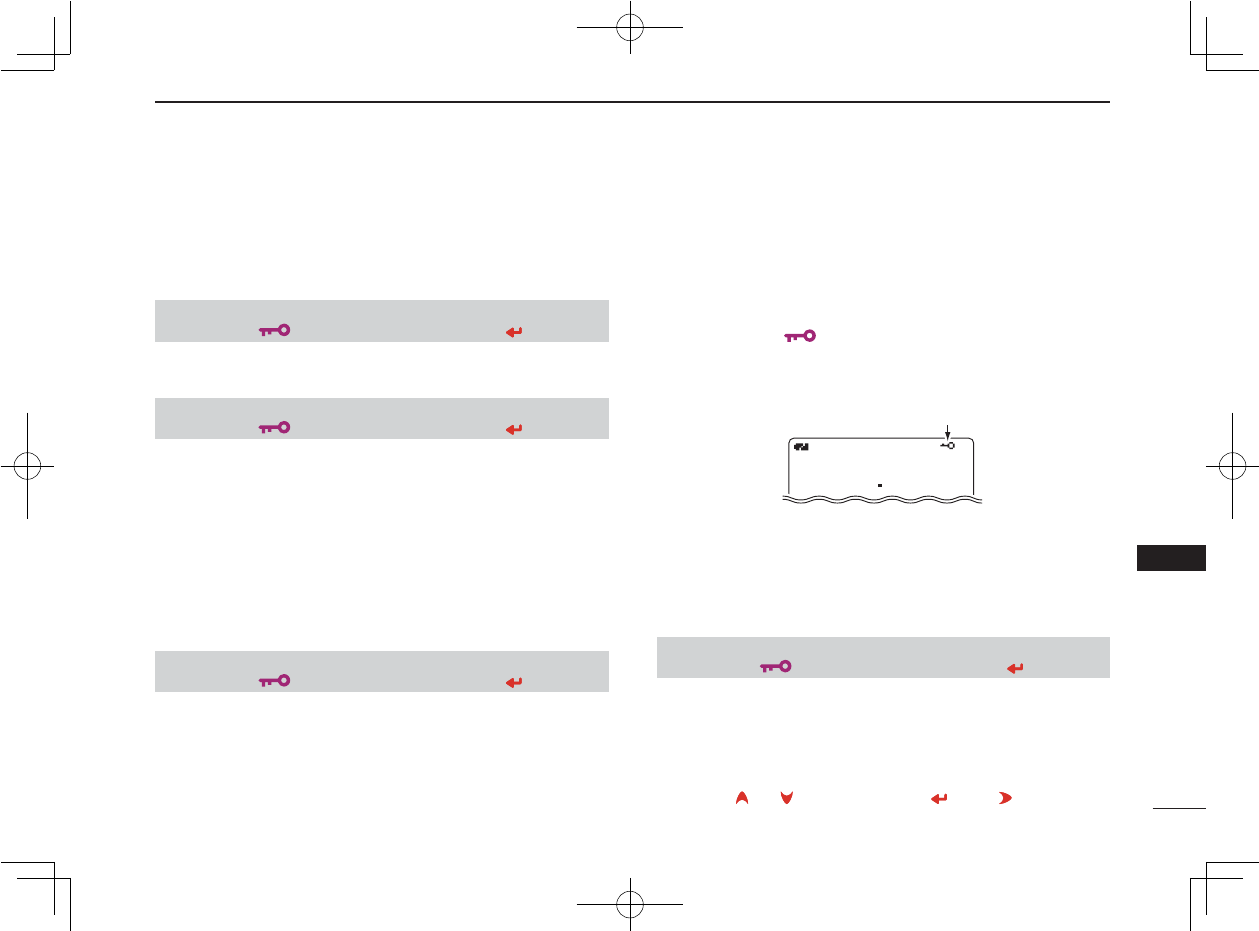
127
12
OTHER FUNCTIONS
New2001
1
2
3
4
5
6
7
8
9
10
11
12
13
14
15
16
17
18
19
■ Beep tones
You can select to have confirmation beeps sound at the
push of a switch. The output level can be adjusted within 39
levels with “BEEP LEVEL” in sounds set mode. (p. 102)
You can select silent operation by turning beep tones OFF
with “KEY-TOUCH BEEP” in sounds set mode. (p. 102)
■ Dial speed acceleration
The dial speed acceleration automatically speeds up the
tuning dial speed when rotating [DIAL] rapidly.
This function can be turned ON and OFF with “DIAL SPEED”
in menu screen operation. (p. 89)
■ Key lock effect
D Lock function
The lock function prevents accidental frequency changes
and accidental function access.
➥ Push [MENU/ ] for 1 sec. to toggle the lock function
ON and OFF.
• [PWR], [VOL], [SQL] and [PTT] can still be accessed while the
lock function is ON. (default)
D Key lock type
While the lock function is ON, [PWR], [VOL], [SQL] and
[PTT] can still be accessed. Accessible switches can be set
to one of 4 groups with “LOCK” in set mode. (p. 90)
• “NORMAL” : [PWR], [VOL], [SQL] and [PTT] are accessible.
• “NO SQL” : [PWR], [SQL] and [PTT] are accessible.
• “NO VOL” : [PWR], [VOL] and [PTT] are accessible.
• “ALL” : [PWR] and [PTT] are accessible.
❮MENU screen❯ ➪ ❮SOUNDS❯ ➪ ❮BEEP LEVEL❯
(Push [MENU/ ]) (Rotate [DIAL]†, then push [ ](5)†.)
❮MENU screen❯ ➪ ❮SOUNDS❯ ➪ ❮KEY-TOUCH BEEP❯
(Push [MENU/ ]) (Rotate [DIAL]†, then push [ ](5)†.)
❮MENU screen❯ ➪ ❮SET MODE❯ ➪ ❮DIAL SPEED❯
(Push [MENU/ ]) (Rotate [DIAL]†, then push [ ](5)†.)
A
FM
FM
439540
PSKI
PSKIP
Appears.
❮MENU screen❯ ➪ ❮SET MODE❯ ➪ ❮LOCK❯
(Push [MENU/ ]) (Rotate [DIAL]†, then push [ ](5)†.)
†[DIAL] ↔ [ ](2)/[](8) [ ](5) ↔ [ ](6)
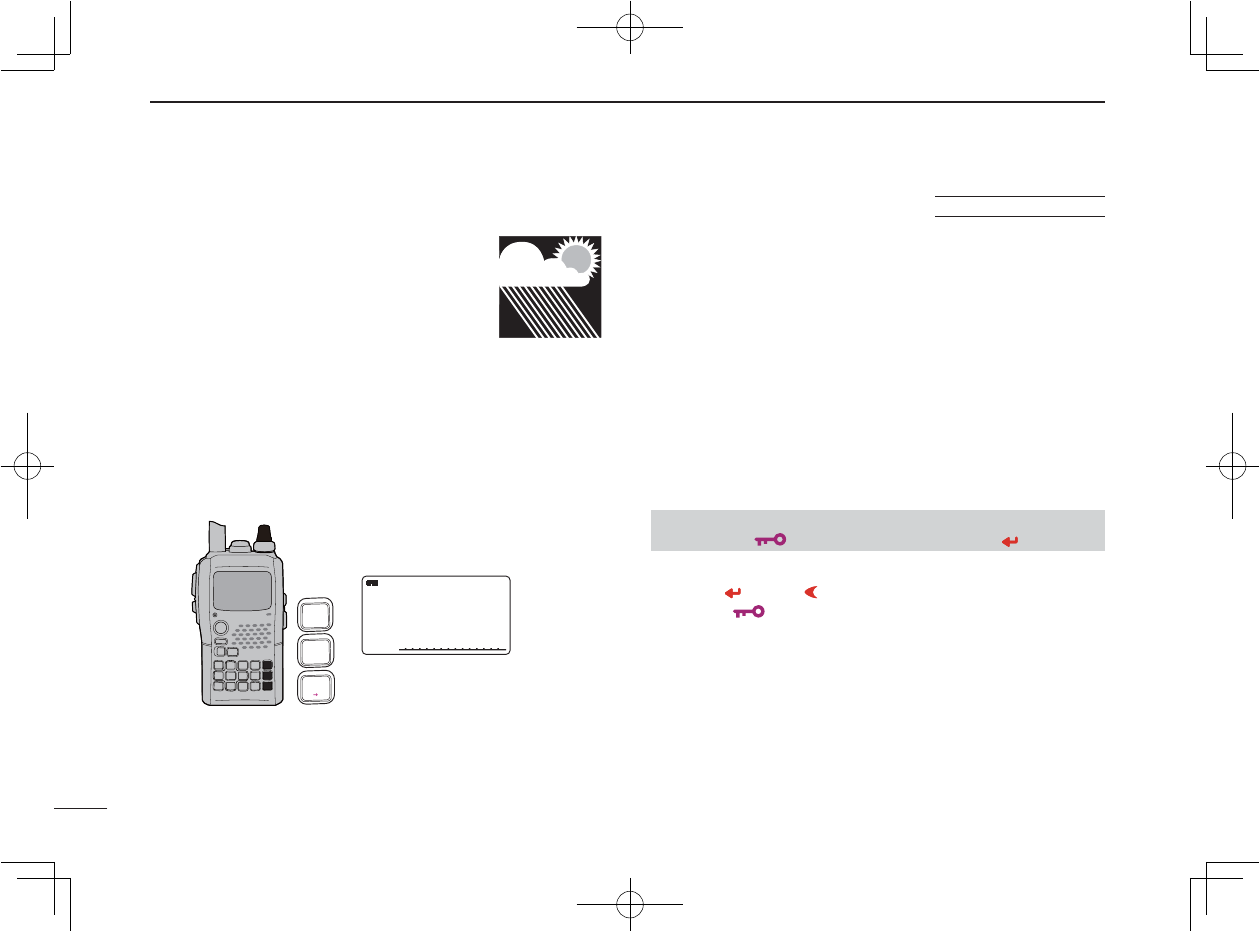
Ne
128
12 OTHER FUNCTIONS
New2001
■ Weather channel operation
There are 10 weather channels for moni-
toring weather channels from the NOAA
(National Oceanographic and Atmospheric
Administration) broadcasts.
D Weather channel selection
q Push [CALL] several times to select weather channel
mode.
• “WX” and the weather channel number appear.
w Rotate [DIAL] to select the desired weather channel.
e Push [VFO] or [MR] to return to the previous frequency
or memory channel.
D Weather alert function
NOAA broadcast stations transmit weather alert tones be-
fore important weather announcements. When the weather
alert function is turned ON, the selected weather channel
is monitored every 5 sec. for the announcement. When the
alert signal is detected, the “ALT” and the WX channel are
displayed alternately and sounds a beep tone until the trans-
ceiver is operated. The previously selected (used) weather
channel is checked periodically during standby or while
scanning.
q Select the desired weather channel.
w Enter “WEATHER ALERT” in set mode. (p. 90)
e Rotate [DIAL]† to select “ON” or “OFF.”
r Push [](5) (or [](4)) to return to set mode, and push
[MENU/ ] to return to the weather channel indication.
t Set the desired stand-by condition.
• Select VFO, memory or call channel.
• Scan or priority watch operation can also be selected.
Weather channel indication.
A
WX
1
WX
A
WX
1
WX
A
WX
1
ALT
MR
S.MW
B
VFO
MHz
A
CALL
RX
CS
C
[DIAL]
U.S.A. version only
❮MENU screen❯ ➪ ❮SET MODE❯ ➪ ❮WEATHER ALERT❯
(Push [MENU/ ]) (Rotate [DIAL]†, then push [ ](5)†.)
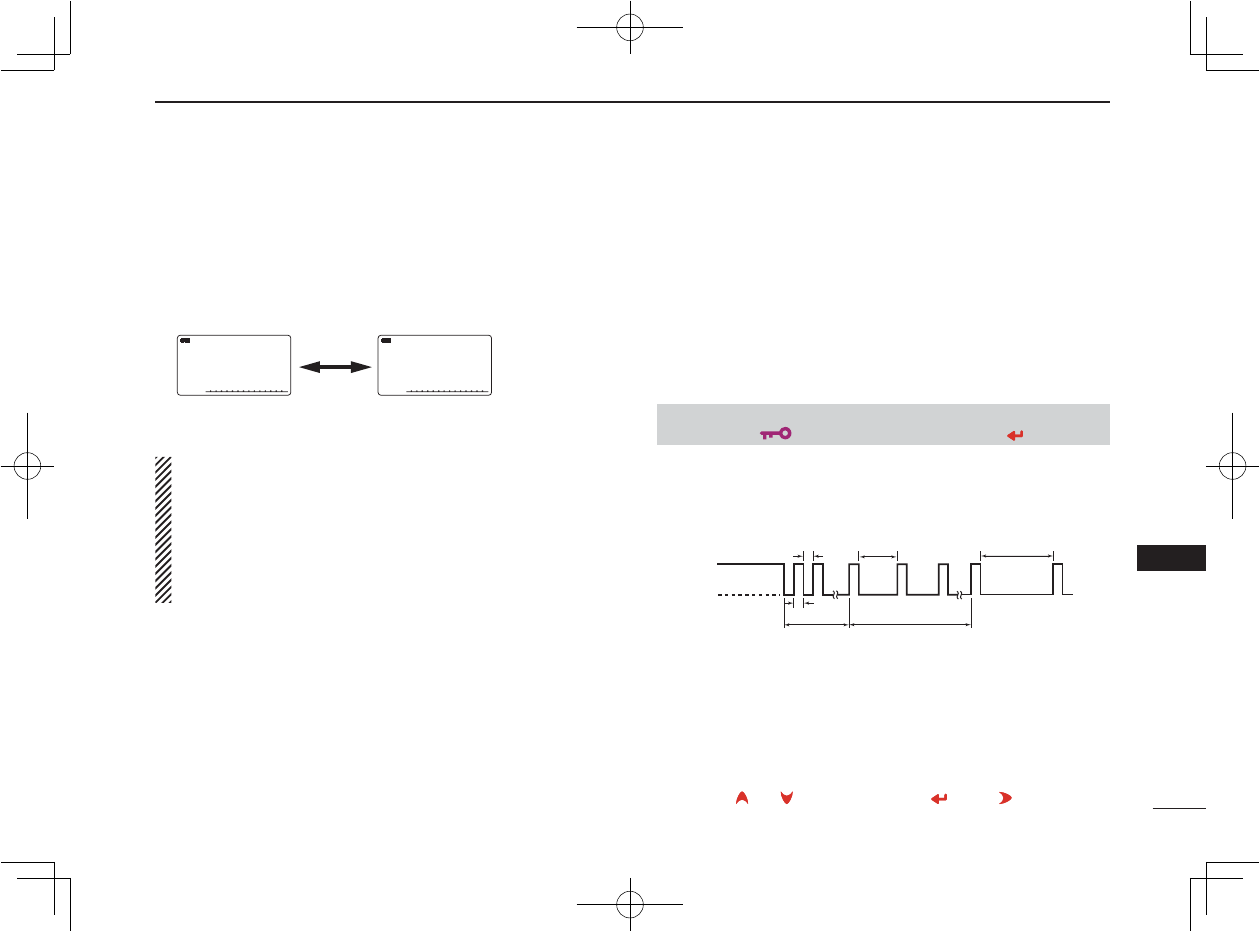
129
12
OTHER FUNCTIONS
New2001
1
2
3
4
5
6
7
8
9
10
11
12
13
14
15
16
17
18
19
y When the alert is detected, a beep sounds and the follow-
ing indication will be displayed.
u Turn the weather alert function OFF in set mode.
NOTE: While receiving a signal (on a frequency other
than the weather alert ON frequency), the receiving signal
or audio will be interrupted momentarily every 5 sec. (ap-
prox.) in the case that the alert function is turned ON. This
symptom is caused by the WX alert function. To cancel
these symptoms, set the weather alert item OFF in set
mode.
■ Power save
The power save function reduces the current drain to con-
serve battery power.
The power save duty cycle, the ratio of receive circuit on
to receive circuit off during standby, can be set to auto-
matic (default), 1 : 1 (150 msec. : 150msec.), 1 : 4 (150 msec. :
600msec.), 1 : 8 (150 msec. : 1200msec.) or OFF with “POWER
SAVE” in set mode. (p. 88)
• “AUTO” selects “1:1” duty ratio when receiving no signal for 5 sec.,
then “1:4” 60 sec. after that.
The ratio becomes “1:8” when no sig-
nal is received for another 60 sec.
A
WX
1
WX
A
WX
1
WXWX
A
WXWX
1
ALTALT
Shows above indications alternately
❮MENU screen❯ ➪ ❮SET MODE❯ ➪ ❮POWER SAVE❯
(Push [MENU/ ]) (Rotate [DIAL]†, then push [ ](5)†.)
150 msec.
150 msec.
60 sec. 60 sec.
600 msec. 1200 msec.
No signal
5 sec.
Circuit ON
Circuit OFF
†[DIAL] ↔ [ ](2)/[](8) [ ](5) ↔ [ ](6)
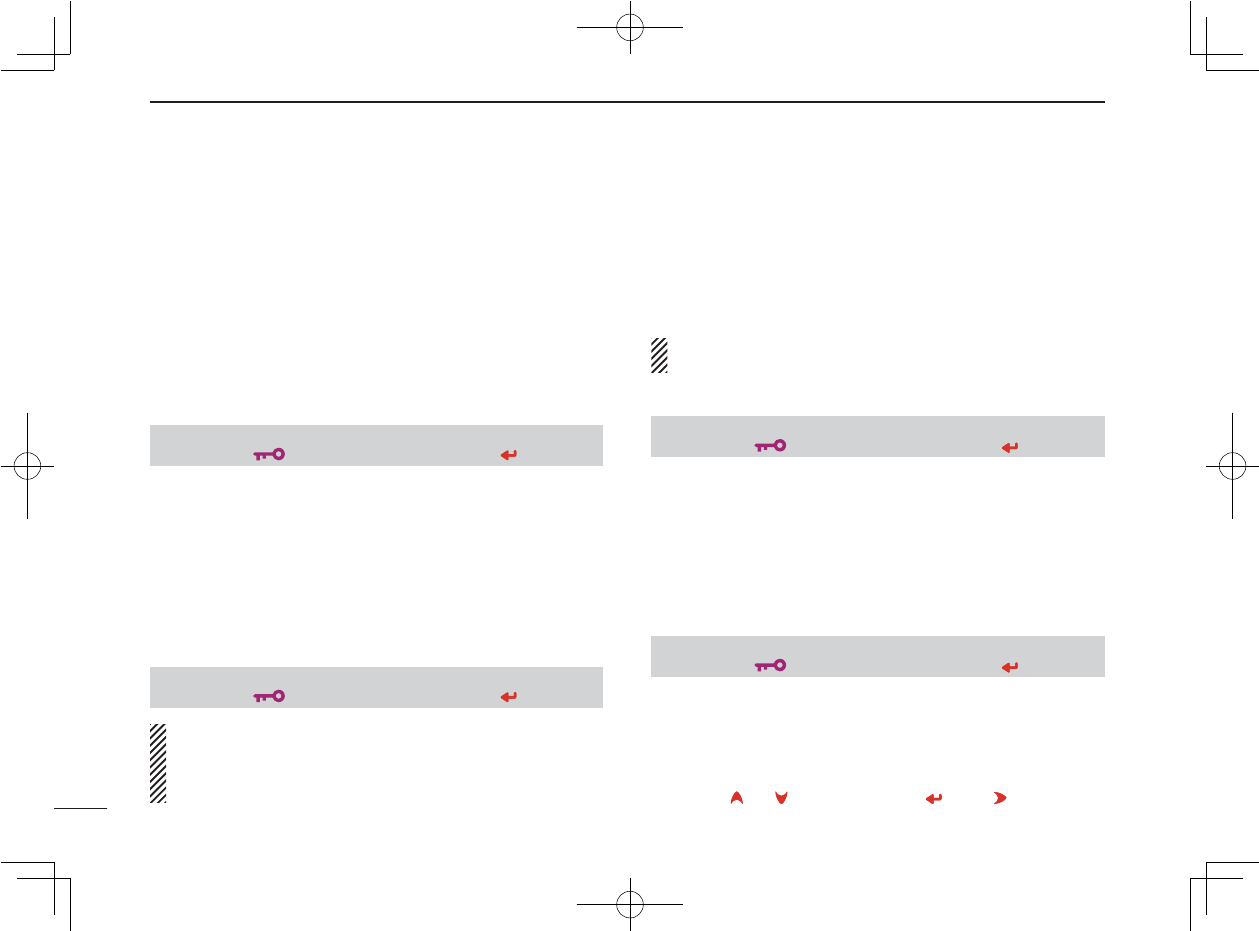
Ne
130
12 OTHER FUNCTIONS
New2001
■ Auto power OFF
The transceiver can be set to automatically turn OFF after a
specifi ed period with a beep when no switch is pushed.
120 min., 90 min., 60 min., 30 min. and OFF can be speci-
fied. The specified period is retained even when the trans-
ceiver is turned OFF by the auto power-off function. To
cancel the function, select “OFF” in the auto power-off item
in set mode.
This can be selected with “AP OFF” in set mode. (p. 88)
■ Auto power ON
The transceiver can be set to automatically turn ON after a
specifi ed period. The timer can be selected within 30 min. to
24 hrs. in 30 min. steps.
This can be selected with “AP ON” in set mode. (p. 90)
When operating with battery pack or case and the battery
is exhausted, auto power-on does not function.
A slight current still flows in the circuits during standby
condition of the auto power-on function.
■ Time-out timer
To prevent accidental prolonged transmission, etc., the
transceiver has a time-out timer. This timer cuts a transmis-
sion OFF after 1, 3, 5 or 10 min. of continuous transmission.
This timer can be cancelled (default).
Approx. 10 sec. before the time-out timer is activated, the
transceiver emits a beep tone as a warning.
This can be selected with “TOT” in set mode. (p. 91)
■ PTT lock
To prevent accidental transmission, etc., the transceiver has
a PTT lock function.
This can be selected with “PTT LOCK” in set mode. (p. 91)
❮MENU screen❯ ➪ ❮SET MODE❯ ➪ ❮AP OFF❯
(Push [MENU/ ]) (Rotate [DIAL]†, then push [ ](5)†.)
❮MENU screen❯ ➪ ❮SET MODE❯ ➪ ❮AP ON❯
(Push [MENU/ ]) (Rotate [DIAL]†, then push [ ](5)†.)
❮MENU screen❯ ➪ ❮SET MODE❯ ➪ ❮TOT❯
(Push [MENU/ ]) (Rotate [DIAL]†, then push [ ](5)†.)
❮MENU screen❯ ➪ ❮SET MODE❯ ➪ ❮PTT LOCK❯
(Push [MENU/ ]) (Rotate [DIAL]†, then push [ ](5)†.)
†[DIAL] ↔ [ ](2)/[](8) [ ](5) ↔ [ ](6)
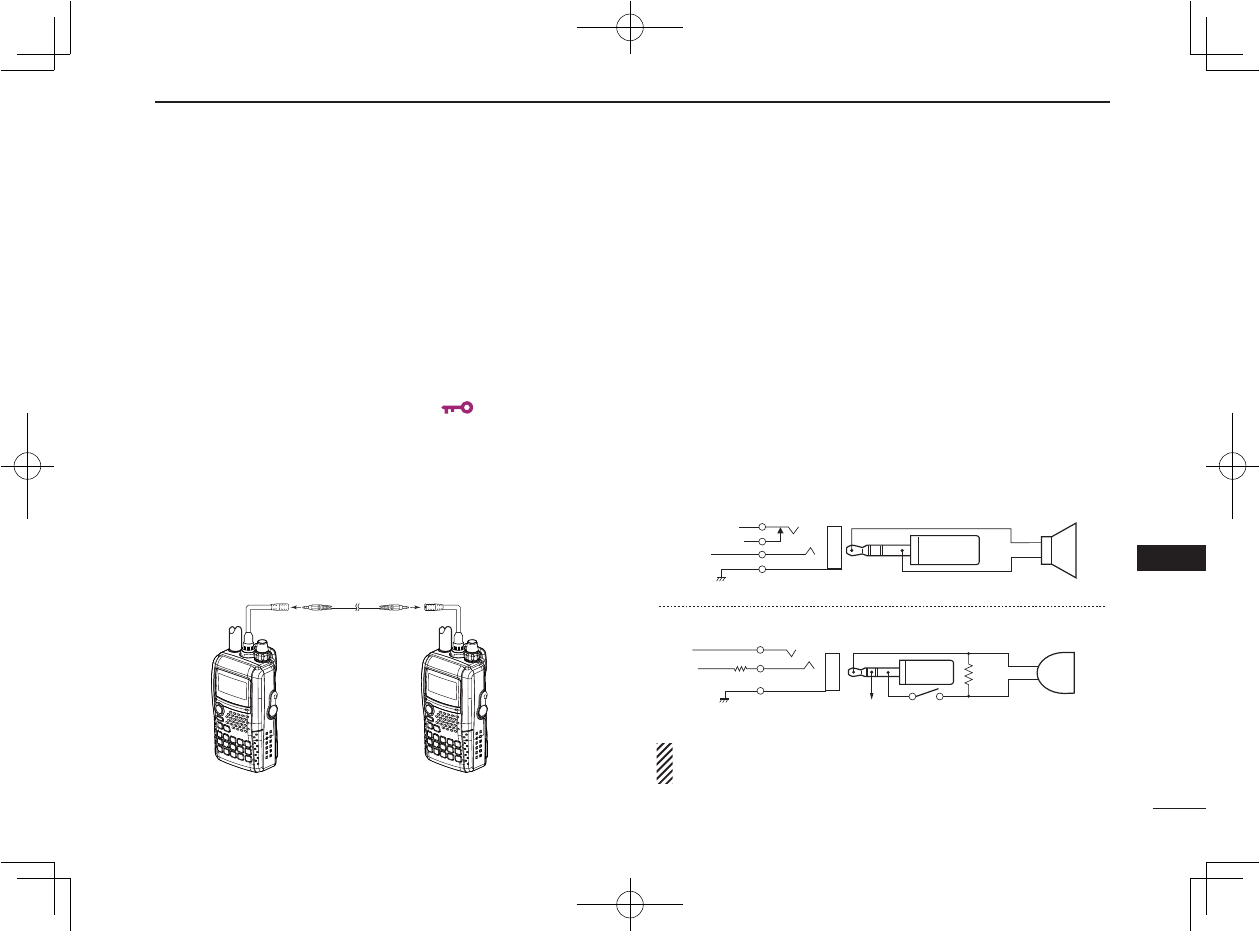
131
12
OTHER FUNCTIONS
New2001
1
2
3
4
5
6
7
8
9
10
11
12
13
14
15
16
17
18
19
■ Cloning function
The IC-92A/92AD has transceiver-to-transceiver data clon-
ing capability. This function is useful when you want to copy
all of the programmed contents from one IC-92A/92AD to
another.
• An optional OPC-474 CLONING CABLE is required.
q Turn the transceiver’s power OFF, then connect an op-
tional OPC-474 between both [SP] jacks.
w While pushing [MR] and [MENU/ ], push and hold
[PWR] for 1 sec. to enter cloning mode.
• “CLONE M” appears.
e Push [PTT] on the “master” transceiver.
• “CLONE OUT M” appears and the bar meter shows that cloning
is taking place.
• After the cloning is completed, the display returns to “CLONE
M.”
r Push and hold [PWR] for 1 sec. to turn power OFF.
The optional RS-92 REMOTE CONTROL SOFTWARE is also
available to clone/edit contents with a PC (for Microsoft®
Windows® 98/98SE/ME/2000XP) and using ICF format fi les.
Microsoft® and Windows® are registered trademarks of Microsoft Corporation
in the U.S.A. and other countries.
■ [DATA/MIC/SP] jacks
To connect external equipment such as speaker, micro-
phone, TNC, etc. refer to the diagram below.
The center terminal of [MIC] outputs 3.3 V DC via 330
resistor.
OPC-1751 OPC-1751
OPC-474
to the [SP] jack to the [SP] jack
External
speaker
the [SP] jack
SP
SP
GND
3.5 (d) mm
plug
the [MIC] jack
33 k
330
MIC
MIC
GND
External
microphone
2.5 (d) mm
plug
PTT
3.3 V (See below)
Impedance 8
Impedance 2 k
MIC
3.0 V
MIC GND
INTERNAL SP
SP (AF OUT)
CLONE
SP GND
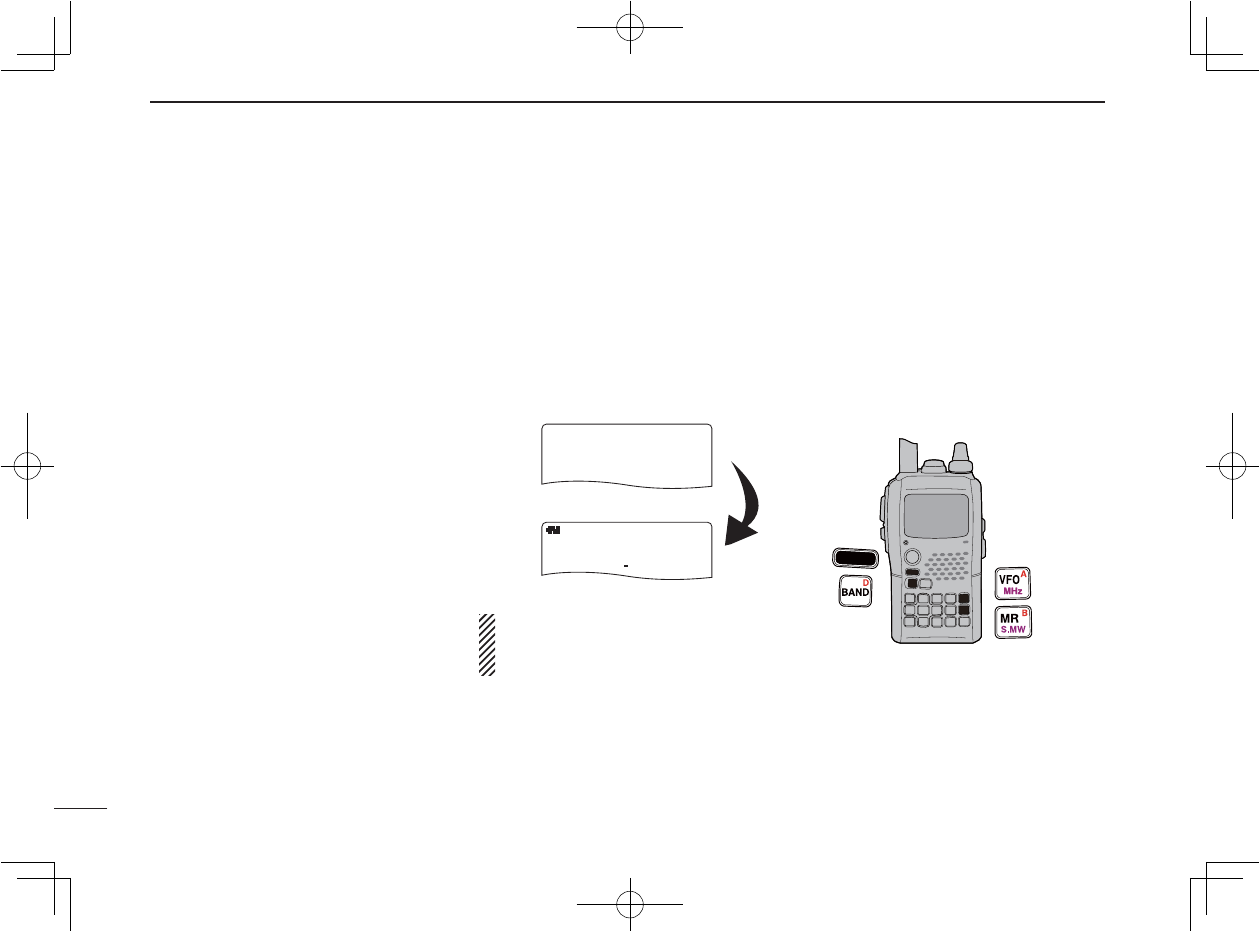
132
12 OTHER FUNCTIONS
New2001
■ Resetting
The function display may occasionally
display erroneous information (e.g.
when first applying power). This may
be caused externally by static electric-
ity or by other factors.
If this problem occurs, turn power OFF.
After waiting a few seconds, turn power
ON again. If the problem persists, per-
form either or both procedures below.
• All reset
Reset the CPU before operating the
transceiver for the first time, or if the
internal CPU malfunctions, to clear and
return all programmed contents to their
default settings.
• Partial reset
If you want to initialize the operat-
ing conditions (VFO frequency, VFO
settings, set mode contents) without
clearing the memory contents, a partial
reset function is available for the trans-
ceiver.
D All reset
q Push and hold [PWR] for 1 sec. to
turn power OFF.
w While pushing and holding [VFO],
[MR] and [BAND], then turn power
ON to reset the CPU.
• “ALL RESET” appears when resetting
the CPU (See the illustration below).
CAUTION: Resetting the CPU
returns all programmed contents to
their default settings.
D Partial reset
q Push and hold [PWR] for 1 sec. to
turn power OFF.
w While pushing and holding [VFO],
then turn power ON to partially reset
the transceiver.
[NOTE]: No message appears on the
display after the partial reset is done.
ALL RESETALL RESET
PRIO WX EMREMR
DTCS
FM
B
A
146010
+DUP
2525
PRIO WX EMR
DTCS
FM
B
A
145000
+DUP
25
PRIO WX EMR
DTCS
FM
B
A
438550
+DUP
25
ALL RESET
PRIO WX EMR
DTCS
FM
B
A
146010
+DUP
25
PRIO WX EMR
DTCS
FM
B
A
145000
+DUP
25
PRIO WX EMR
DTCS
FM
B
A
438550
+DUP
25
MR
S.MW
B
VFO
MHz
A
BAND
D
PWR
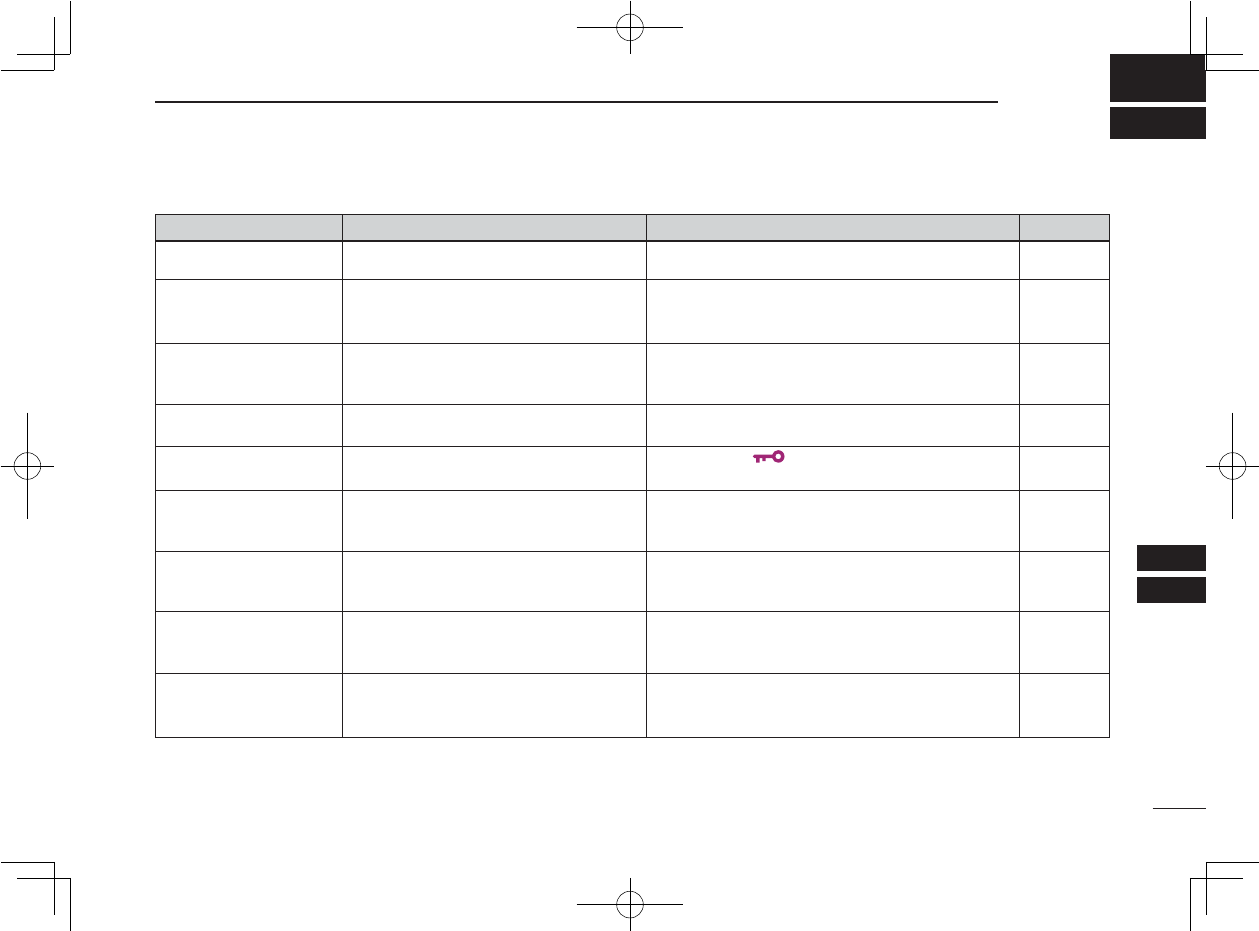
133
13
TROUBLESHOOTING
1
2
3
4
5
6
7
8
9
10
11
12
13
14
15
16
17
18
19
PROBLEM
No power comes ON.
No sound comes from the
speaker.
Transmitting is impossible.
No contact possible with
another station.
Frequency can not be set.
Program scan function
can not start.
Memory scan function
can not start.
The displayed frequency
is erroneous.
Can not charge the bat-
tery with BC-139 (LED
blinks orange).
If your transceiver seems to be malfunctioning, please check the following points before sending it to a service center.
POSSIBLE CAUSE
• The batteries are exhausted.
• The battery polarity is reversed.
• Volume level is too low.
• Different tone is selected with tone/DTCS
squelch.
• The batteries are exhausted.
• A frequency outside of the 144/440 MHz
amateur bands is set.
• Different tone is selected with tone/DTCS
squelch.
• The lock function is activated.
• Memory mode or call channel is selected.
• Memory mode or call channel is selected.
• Same frequencies are programmed both
“✱A” and “✱B” of PROGRAM-CH.
• VFO mode or call channel is selected.
• The programmed memory channel is only
one.
• The CPU malfunctioned.
• External factors caused a fault.
• Turn the transceiver’s power ON.
SOLUTION
• Replace the batteries or charge the battery pack.
• Check the battery polarity.
• Rotate [VOL] to suitable level.
• Check the tone using tone/DTCS scan.
• Replace the batteries or charge the battery pack.
• Reset the frequency within 144/440 MHz amateur
bands.
• Check the tone/DTCS using tone scan.
• Push [MENU/ ] for 1 sec. to cancel the function.
• Push [VFO] to set VFO mode.
• Push [VFO] to set VFO mode.
• Programming different frequencies in “✱A” and “✱B”
respectively.
• Push [MR] to set memory mode.
• Program more than 2 memory channels.
• Reset the transceiver.
• Remove and re-attach the battery pack or battery
case.
• Turn the transceiver’s power OFF, or insert only the
battery pack into the BC-139 to charge it.
REF.
pgs. 1, 10–12
p. 12
p. 20
p. 110
pgs. 1, 10–12
p. 24
p. 112
p. 25
p. 15
p. 15
p. 74
p. 15
p. 66
p. 118
p. 1
pgs. 11 ,20
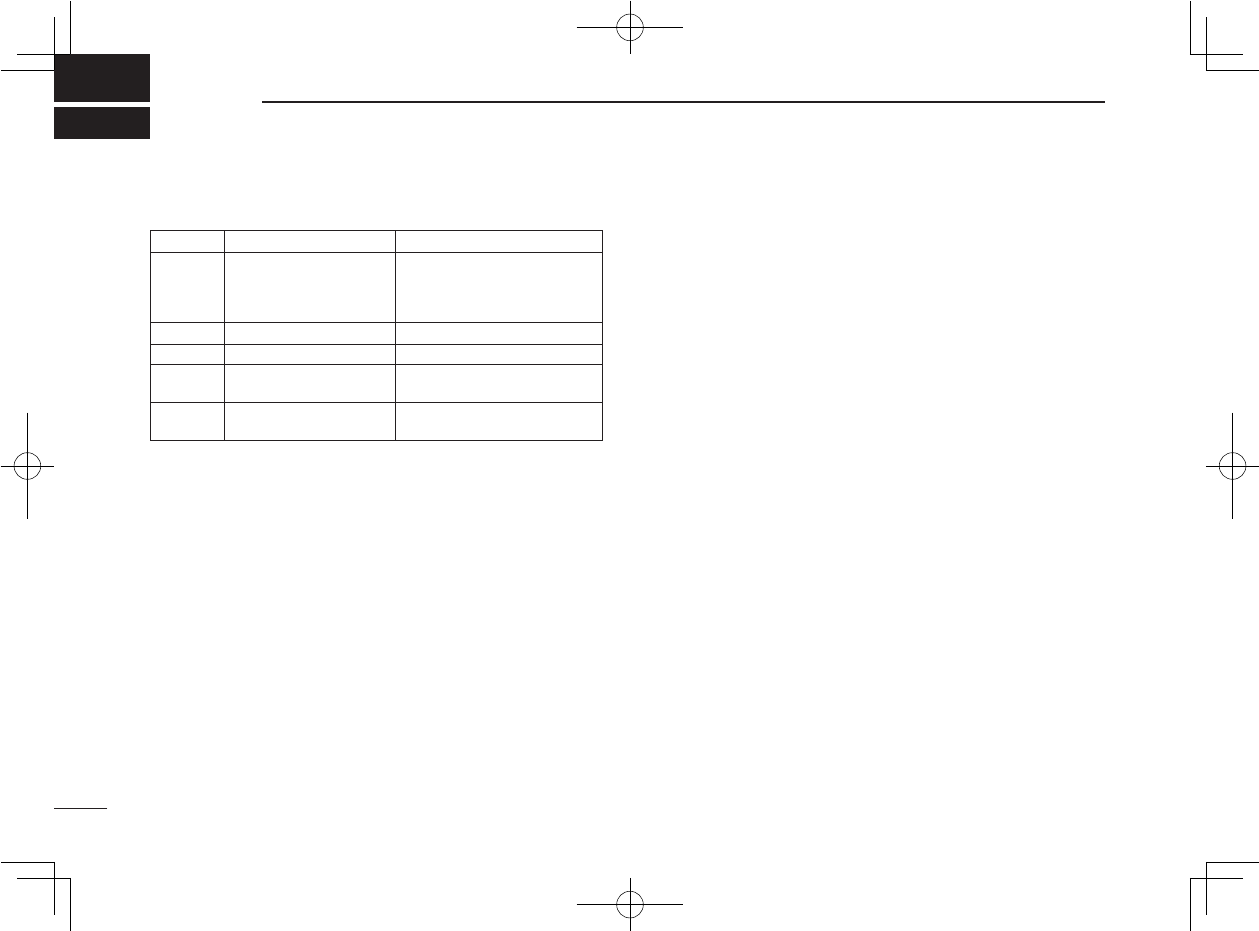
Ne
134
New2001
SPECIFICATIONS
14
D General
• Frequency coverage : (unit: MHz)
*
1Guaranteed 440–450 MHz only, *2Guaranteed 144–148 MHz only,
*
3Guaranteed 430–440 MHz only
• Mode : FM, AM (Rx only), WFM (Rx only), DV†
• No. of memory channels : 1304
(incl. 100 scan edges and 4 call channels)
• Usable temp. range : –20°C to +60°C; –4°F to +140°F
• Tuning steps : 5‡, 6.25‡, 8.33‡, 9‡, 10, 12.5, 15, 20,
25, 30, 50, 100, 125 and 200 kHz
• Frequency stability : ±2.5 ppm (–20°C to +60°C; –4°F to +140°
F)
• Power supply : 10.0–16.0 V DC for external DC power,
or specifi ed Icom’s battery pack
• Digital transmission speed : 4.8 kbps†
• Voice coding speed : 2.4 kbps†
• Current drain (at 7.4 V DC) :
Tx High 144 MHz 2.1 A typical
430/440 MHz 2.2 A typical
Tx Low 0.8 A (approx.)
Rx max. power 340 mA typical (dualwatch; FM/DV†)
standby 170 mA typical (dualwatch; FM/DV†)
• Antenna connector : SMA (50 )
• Dimensions : 58.4(W)u103(H)u34.2(D) mm;
(projections not included) 2
9⁄32(W)u41⁄16(H)u111⁄32(D) in
• Weight (approx.) : 300 g; 10.6 oz (with antenna and BP-217)
• Data connector : 3-conductor 2.5 (d) mm; (1⁄10˝)
D Transmitter
• Modulation system :
FM Variable reactance freq. modulation
DV
(Digital)† GMSK reactance freq. modulation
• Output power (at 7.4 V DC) : High 5.0 W, Low 0.5 W (approx.)
• Max. frequency deviation : ±5.0 kHz (FM wide: approx.)
±2.5 kHz (FM narrow: approx.)
• Spurious emissions : Less than –60 dB
• Ext. mic. connector : 3-conductor 2.5 (d) mm; (1⁄10˝)/2 k
Version
U.S.A.
Taiwan
Korean
Australian
Export
A band
Tx: 144–148, 420–450*1
Rx: 0.495–823.995*1, *2,
849–868.995, 894–
999.990
144–146, 430–432
144–146, 430–440
Tx: 144–148, 420–450*3
Rx: 0.495–999.990*2, *3
Tx: 137–174*2, 400–470*3
Rx: 0.495–999.990*2, *3
B band
Tx: 144–148, 420–450*1
Rx:
118–174*
2
, 350–470*
1
144–146, 430–432
144–146, 430–440
Tx: 144–148, 420–450*3
Rx:
118–174*
2
, 350–470*
3
Tx:
137–174*
2
, 400–470*
3
Rx:
118–174*
2
, 350–470*
3
†Available for the IC-92AD or when UT-121 is installed into the IC-92A.
‡Selectable depending on the operating frequency band.
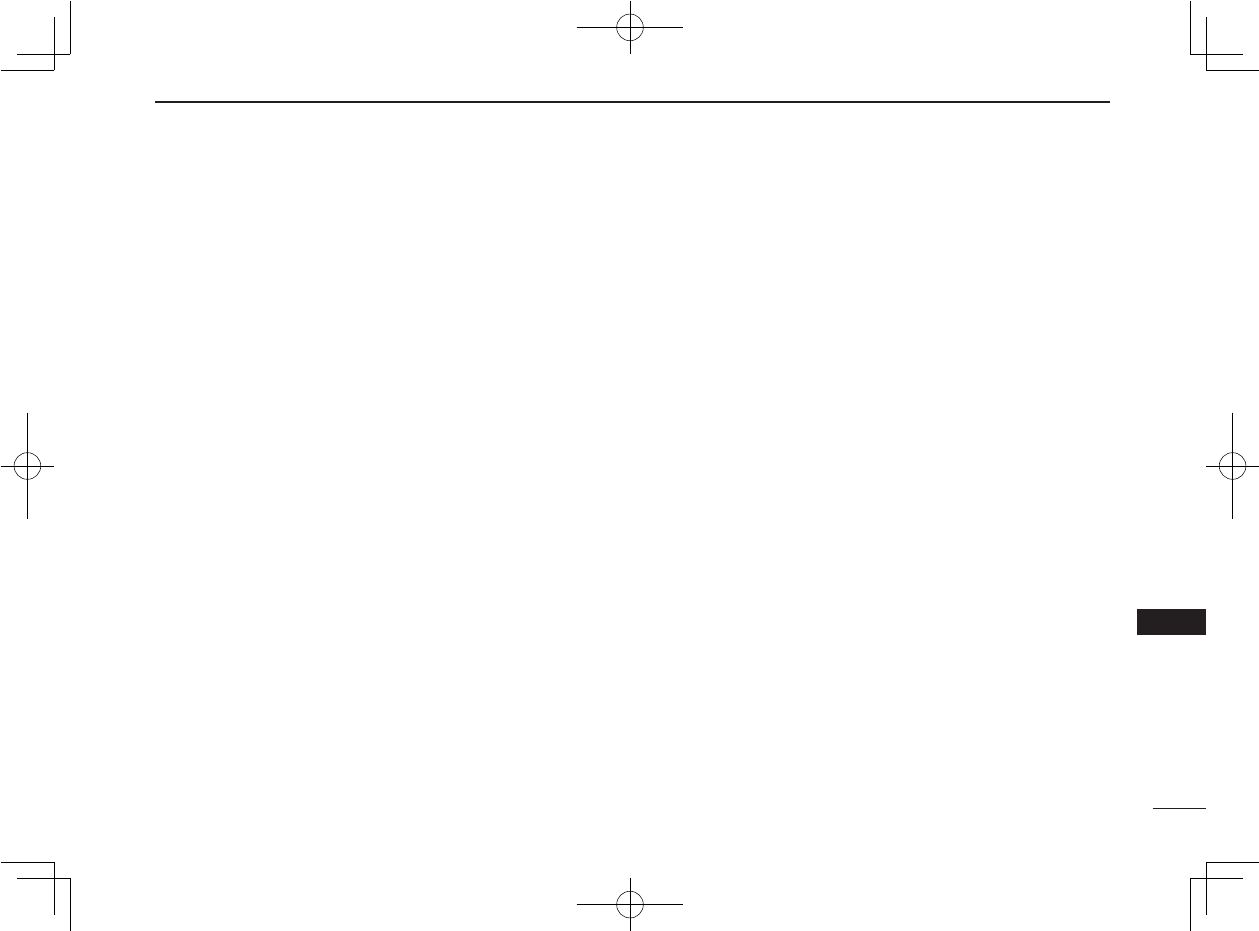
135
14
SPECIFICATIONS
New2001
1
2
3
4
5
6
7
8
9
10
11
12
13
14
15
16
17
18
19
D Receiver
• Receive system :
FM/AM Double-conversion superheterodyne
WFM Triple-conversion superheterodyne
• Intermediate frequencies :
1st A band 61.65 MHz/59.25 MHz (WFM)
B band 46.35 MHz
2nd 450 kHz/13.35 MHz (WFM)
3rd 1.95 MHz (WFM only)
• Sensitivity (except spurious points):
AM
(1 kHz/30% Mod.; 10 dB S/N)
0.495–4.995 MHz 1.3 μV typ.
5.000–29.995 MHz 0.56 μV typ.
118.000–137.000 MHz 0.5 μV typ.
222.000–246.995 MHz 0.79 μV typ.
247.000–329.995 MHz 1 μV typ.
FM
(1 kHz/3.5 kHz Dev.; 12 dB SINAD)
VHF (Amateur band only) 0.14 μV typ.
UHF (Amateur band only) 0.16 μV typ.
1.625–29.995 MHz 0.4 μV typ.
30.000–117.995 MHz 0.25 μV typ.
118.000–173.995 MHz 0.18 μV typ.
174.000–349.995 MHz 0.32 μV typ.
350.000–469.995 MHz 0.22 μV typ.
470.000–599.995 MHz 0.32 μV typ.
600.000–999.990 MHz 0.56 μV typ.
WFM
(1 kHz/52.5 kHz Dev.; 12 dB SINAD)
76.000–108.000 MHz 1 μV typ.
175.000–221.995 MHz 1.8 μV typ.
470.000–770.000 MHz 2.5 μV typ.
DV
(digital/PN9 4.8 kbps; BER 1%)†
Amateur bands 0.22 μV typ.
• Selectivity :
FM
(Wide), AM More than 50 dB
FM
(Narrow), DV† More than 45 dB
WFM More than 300 kHz/–3 dB
Less than 700 kHz/–20 dB
• Spurious and image rejection ratio:
VHF More than 60 dB
UHF More than 50 dB
(Intermediate freq.; More than 60 dB)
• Audio output power : More than 200 mW at 10% distortion
(at 7.4 V DC) with an 8 load
• Ext. speaker connector : 3-conductor 3.5(d) mm; (1⁄8˝)/8
†Available for the IC-92AD or when UT-121 is installed into the IC-92A.
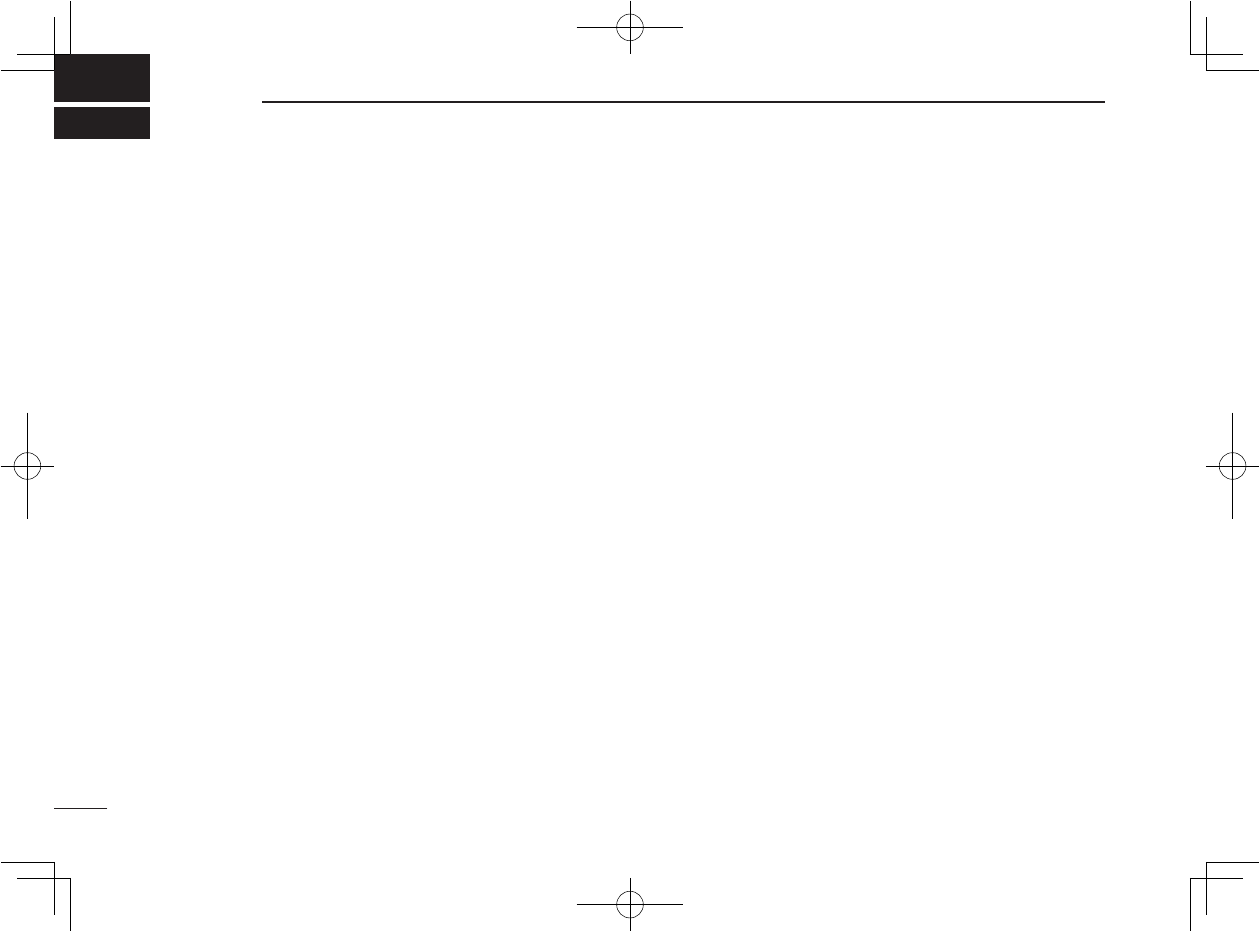
Ne
136
New2001
OPTIONS
15
• UT-121 DIGITAL UNIT
Provides DV mode operation for IC-92A. Already installed
into the IC-92AD.
• RS-92 REMOTE CONTROL SOFTWARE
Allows you to operate the transceiver, as well as the easy
memory management from the connected PC for Micro-
soft® Windows® 98/98SE/ME/2000/XP with an RS-232C
(COM) port. In addition, low-speed data communication is
enabled with this software for DV mode operation. A data
communication cable, OPC-1529R, is supplied with the
software.
• BC-139 DESKTOP CHARGER
Rapidly charges BP-217 Li-ion battery pack in 2.5 hrs.
• BP-216 BATTERY CASE
Battery case for R6 (AA) u 2 alkaline batteries.
• BP-217 LI-ION BATTERY PA C K
7.4 V/1300 mAh Lithium Ion battery pack. Battery life: 5 hrs.
(approx.; VHF, FM, high power, Tx : Rx : Standby = 1:1:8)
• HM-75A REMOTE CONTROL MICROPHONE
Allows you to remotely select operating channels, etc.
• HM-131 SPEAKER-MICROPHONE
For operation while conveniently hanging the transceiver
from your belt, etc.
• HM-128/HM-153 EARPHONE-MICROPHONE
Ideal for hands-free operation by clipping the microphone
with the PTT switch to your lapel or breast pocket.
• HM-175 waterproof WATERPROOF SPEAKER-MICROPHONE
Allows you to operate in rainly condition.
• HM-175GPS GPS WATERPROOF SPEAKER-MICROPHONE
Allows you to operate in rainly condition and GPS antenna
is included.
• HS-85 HEADSET WITH VOX/PTT UNIT
Hands-free headset with VOX control box.
• CP-12L
CIGARETTE
LIGHTER
CABLE
WITH
NOISE
FILTER
• CP-19R
CIGARETTE
LIGHTER
CABLE
WITH
DC
-
DC
CONVERTER
Allows you to operate the transceiver through a 12 V ciga-
rette lighter socket, and also charge the attached battery
pack (during stand-by only) regularly.
CP-19R: A built-in DC-DC converter outputs 11 V DC.
• OPC-254L DC POWER CABLE
For operation and charging via an external power supply.
• OPC-474 CLONING CABLE
Used for handheld-to-handheld cloning.
• OPC-1529R DATA COMMUNICATION CABLE
Allows you to GPS operation in DV mode operation.
• SP-13 EARPHONE
Provides clear receive audio in noisy environments.
• LC-163 CARRYING CASE
Helps protect the transceiver from scratches, etc.
• AD-92SMA ANTENNA CONNECTOR ADAPTER
Allows you to connect an external antenna with a BNC con-
nector.
Microsoft® and Windows® are registered trademarks of Microsoft
Corporation in the U.S.A. and other countries.
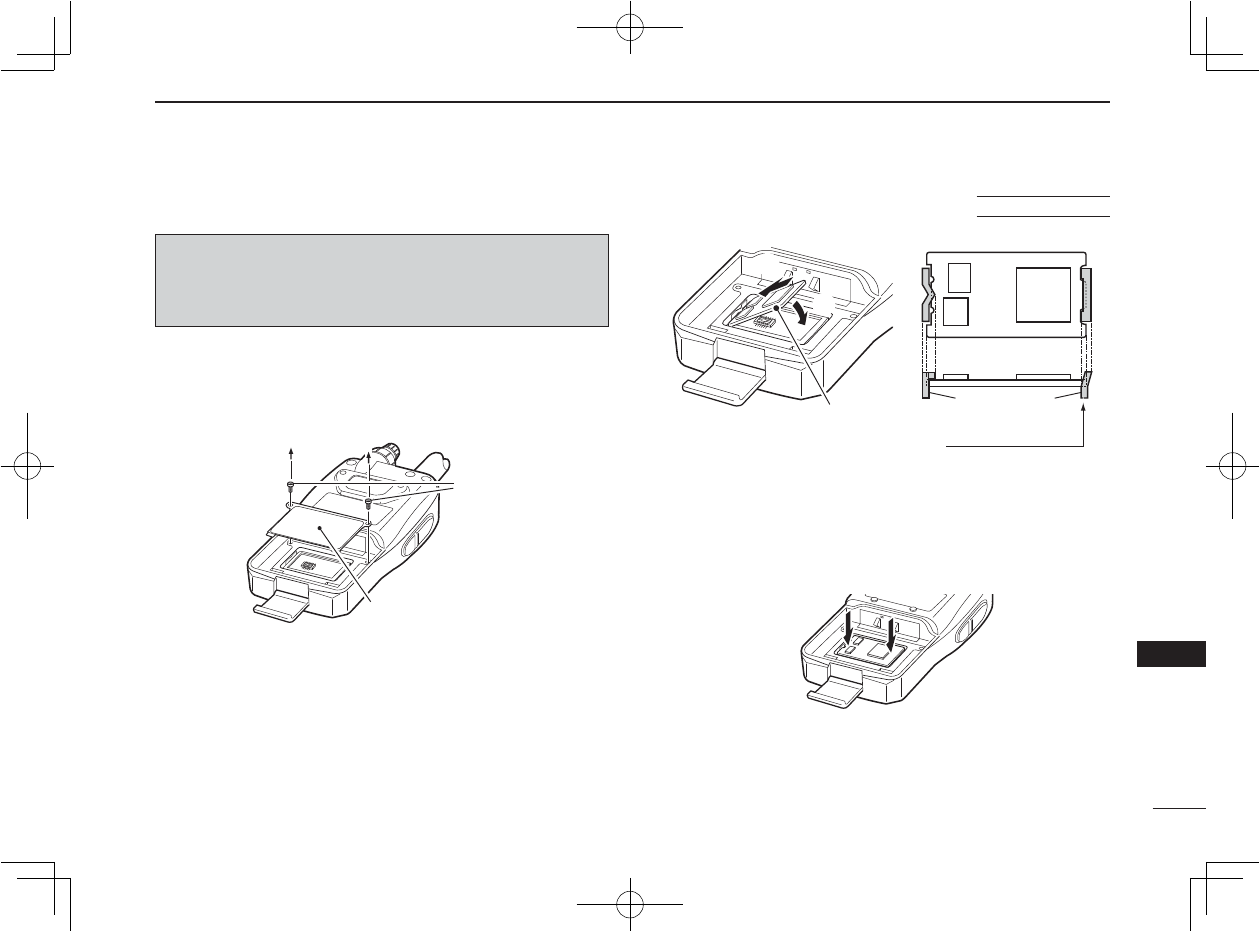
137
15
OPTIONS
New2001
1
2
3
4
5
6
7
8
9
10
11
12
13
14
15
16
17
18
19
The optional UT-121 is installed inside the unit holder which
is located under the battery pack/case’s space.
Install the optional UT-121 as following procedures.
q Unscrew 2 screws to remove the unit cover.
w Insert the UT-121’s fi xed part to the unit holder (q), then
take down it to the unit holder (w) as the right illustration.
e Check the UT-121 position where is located under the
transceiver’s chassis.
r Push both edges of the UT-121 to install it into the trans-
ceiver, then confi rm to install it completely.
t Screw 2 screws to assemble the unit cover.
■ Optional UT-121 installation
RECOMMENDATION:
Critical technique is necessary for the UT-121 instal-
lation, therefore, we recommend you to install it at
your dealer or service center.
2 screws
Unit cover
q
w
UT-121
UT-121
• Upper view
• Side view
• Check it clicks when the optional UT-121 is installed.
• Check the optional UT-121 is locked to the unit installer guide.
Unit installer guide
IC-92A only
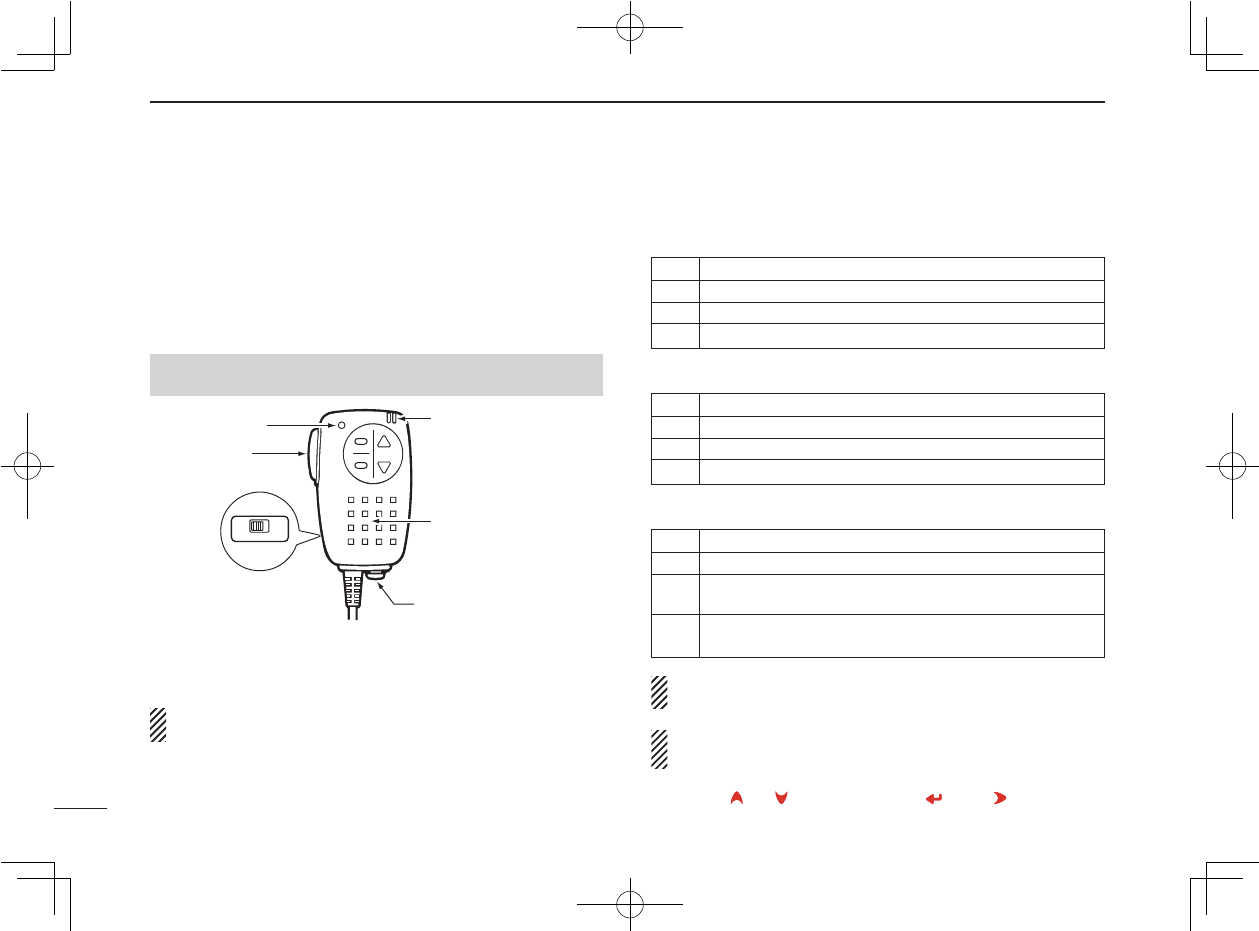
The optional HM-75A allows you to remotely select operat-
ing frequencies, memory channels, etc.
Remote control functions can be selected from 3 settings.
These can be selected with “MIC SIMPLE MODE” in set
mode. (p. 90)
The HM-75A has a lock switch on the backside to prevent
accidental frequency changes, etc.
Be sure to turn power OFF when plugging the HM-75A to
the [DATA/MIC/SP] jack.
• NORM-1: (default)
• NORM-2:
• SIMPLE:
VFO mode cannot be selected via the microphone when
SIMPLE mode is selected.
SIMPLE mode can select only 3 channels and is useful
for group operations during touring, etc.
138
15 OPTIONS
New2001
■ Optional HM-75A REMOTE CONTROL MICROPHONE
[A] Selects band.
[B] Toggles VFO mode and memory mode.
[Y] Frequency or memory channel “UP”.
[Z] Frequency or memory channel “DOWN”.
[A] Toggles the monitor function.
[B] Toggles VFO mode and memory mode.
[Y] Frequency or memory channel “UP”.
[Z] Frequency or memory channel “DOWN”.
[A] Toggles the monitor function.
[B] Selects call channel C0.
[Y] • Selects memory channel 000 in memory mode.
• Volume “UP” while operating the monitor function.
[Z] • Selects memory channel 001 in memory mode.
• Volume “DOWN” while operating the monitor function.
❮MENU screen❯ ➪ ❮SET MODE❯ ➪ ❮MIC SIMPLE MODE❯
(Push [MENU/LOCK]) (Rotate [DIAL]†, then push [ï](5)†.)
A
OFF ON
LOCK
B
PTT switch
Transmit LED
Earphone jack
Microphone
Speaker
†[DIAL] ↔ [ ](2)/[](8) [ ](5) ↔ [ ](6)
Ne
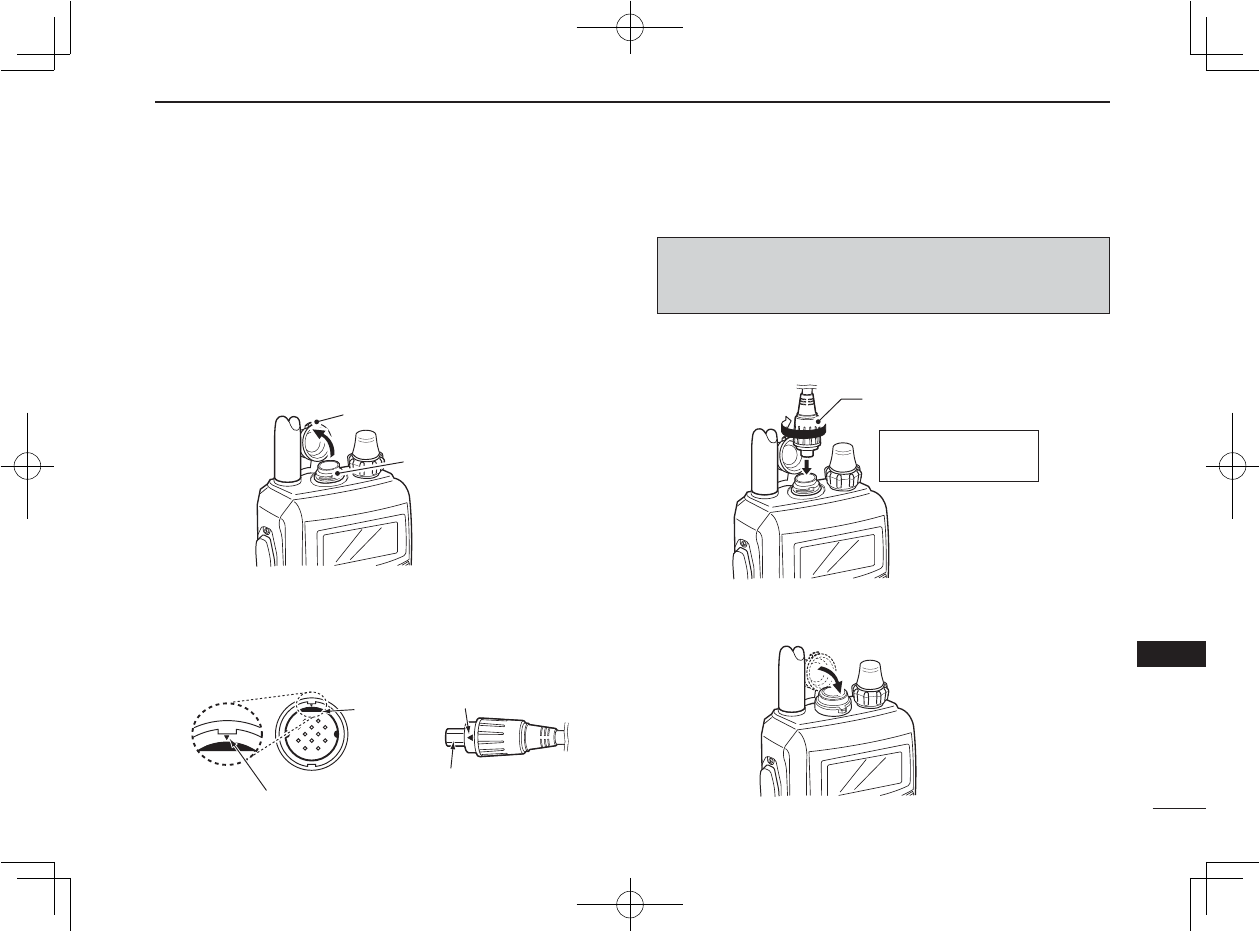
139
15
OPTIONS
New2001
1
2
3
4
5
6
7
8
9
10
11
12
13
14
15
16
17
18
19
When connecting the optional HM-174 WATERPROOF
SPEAKER-MICROPHONE, HM-175GPS GPS WATERPROOF
SPEAKER-MICROPHONE or PC-1799 DATA COMMUNICATION
CABLE, OPC-1797 CONNECTION CABLE to the [DATA/SP/MIC]
jack, follow the procedure below.
• Connecting to the [DATA/SP/MIC] jack
q Remove the rubber cap. from the [DATA/SP/MIC] jack.
w Set the connector's fl at face and the [DATA/SP/MIC] jack's
flat face to same direction, (Verifing square mark) then
insert it tighten.
e Rotate fix screw clockwise tighten to fix the connected
cable.
• Disconnecting from the [DATA/SP/MIC] jack
q Rotate fix screw counter-clockwise to loose the con-
nected cable.
w Disconnect the cable from the [DATA/SP/MIC] jack.
e Put the rubber cap tighten to the [DATA/SP/MIC] jack..
■ Connecting to the [DATA/SP/MIC] jack
CAUTION!:
Turn power OFF the transceiver before connecting/
disconnecting cable to/from the [DATA/SP/MIC] jack..
Rubber cap
[DATA/SP/MIC] jack
[DATA/SP/MIC] jack (Upside view)
Flat face
Triangular mark
Connector (Side view)
Flat face
Triangular mark
Rotate the fix screw tighten.
No Sound from the inside
speaker when connecting
OPC-1797.
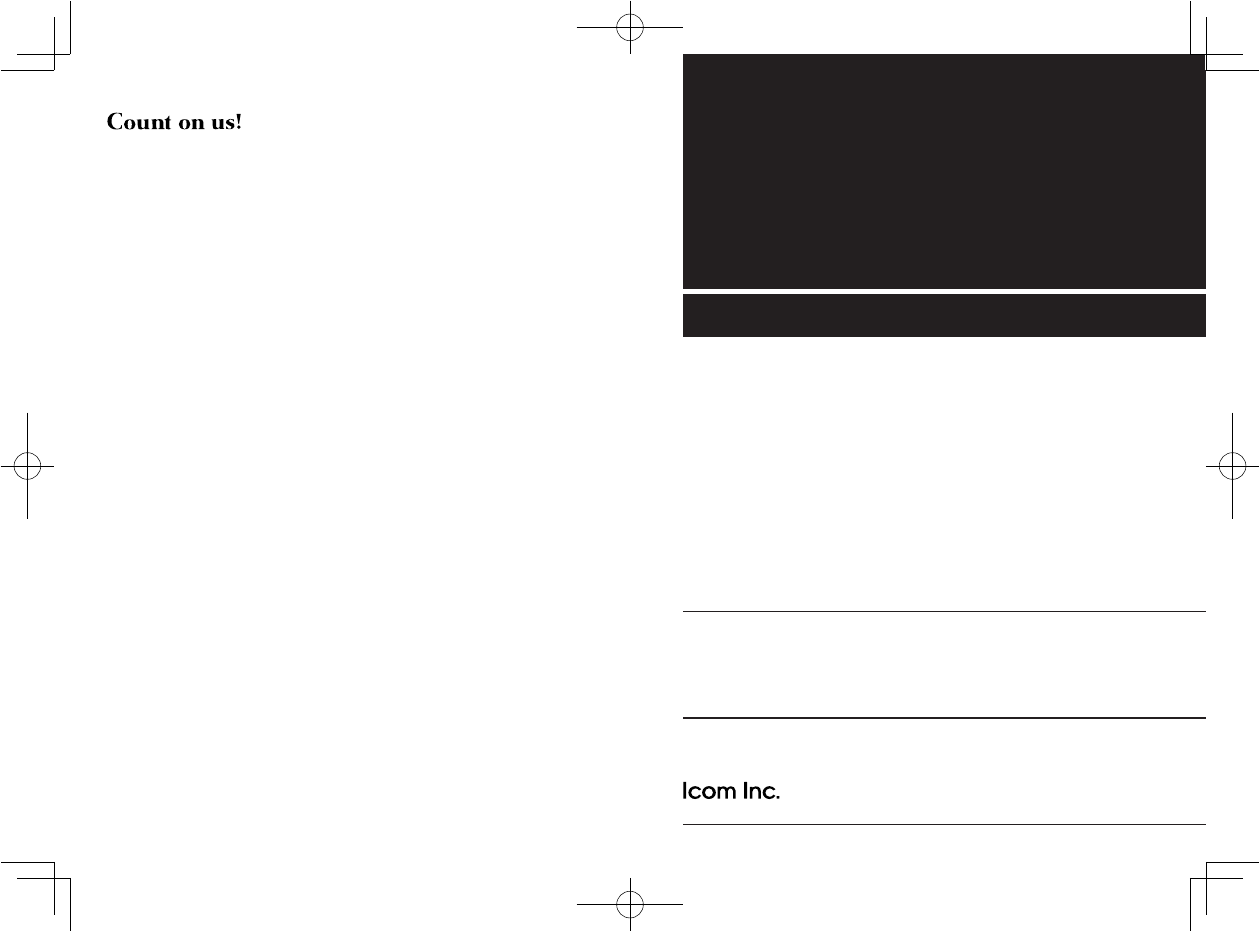
1-1-32 Kamiminami, Hirano-ku, Osaka 547-0003, Japan
New2001
A-6616H-1EX
Printed in Japan
© 2007 Icom Inc.
Printed on recycled paper with soy ink.